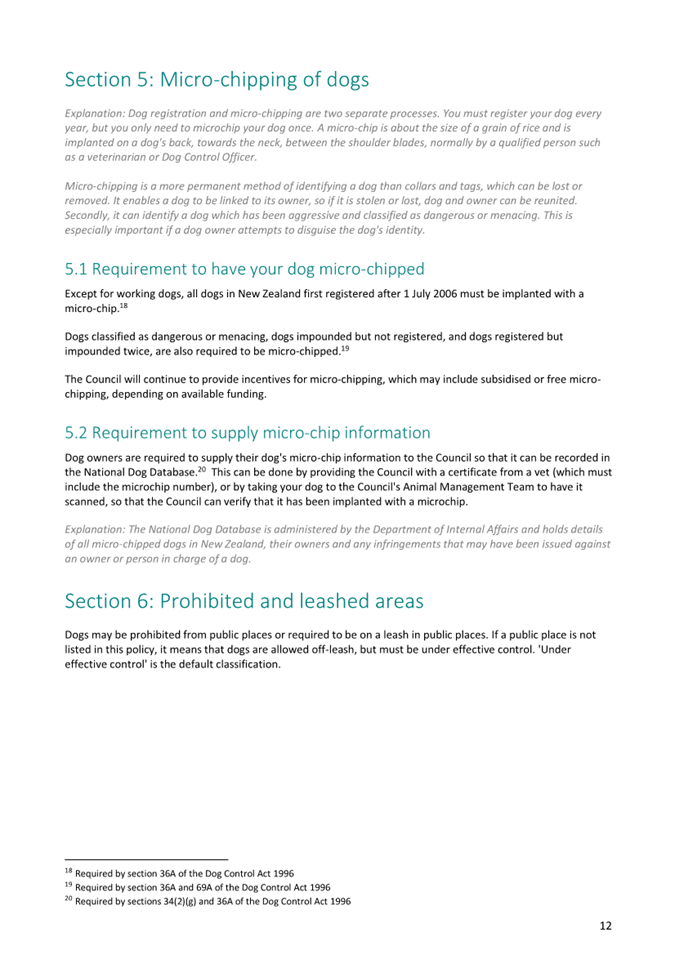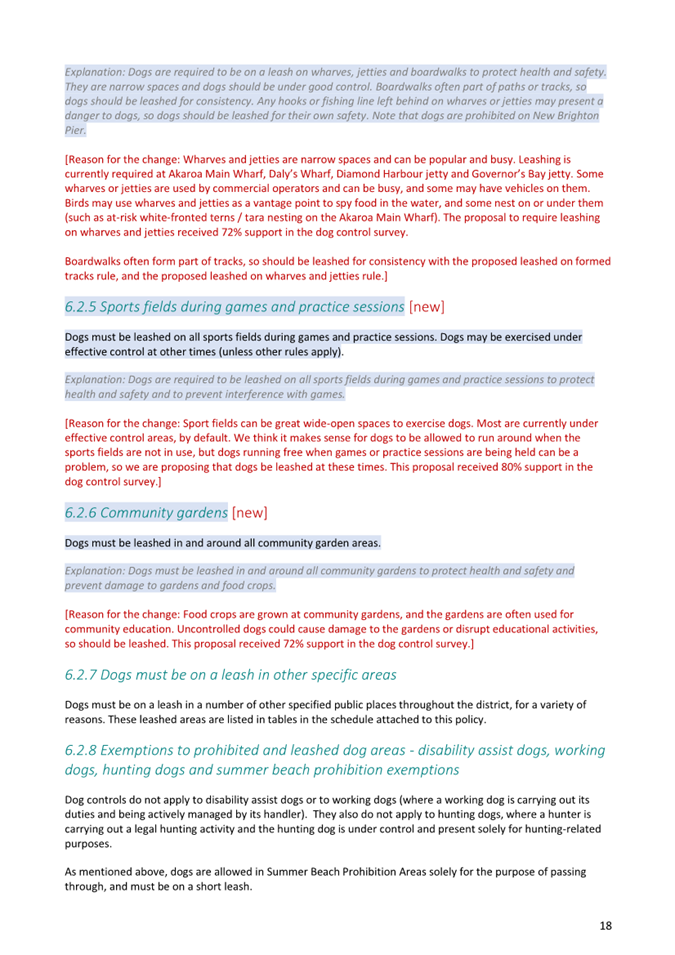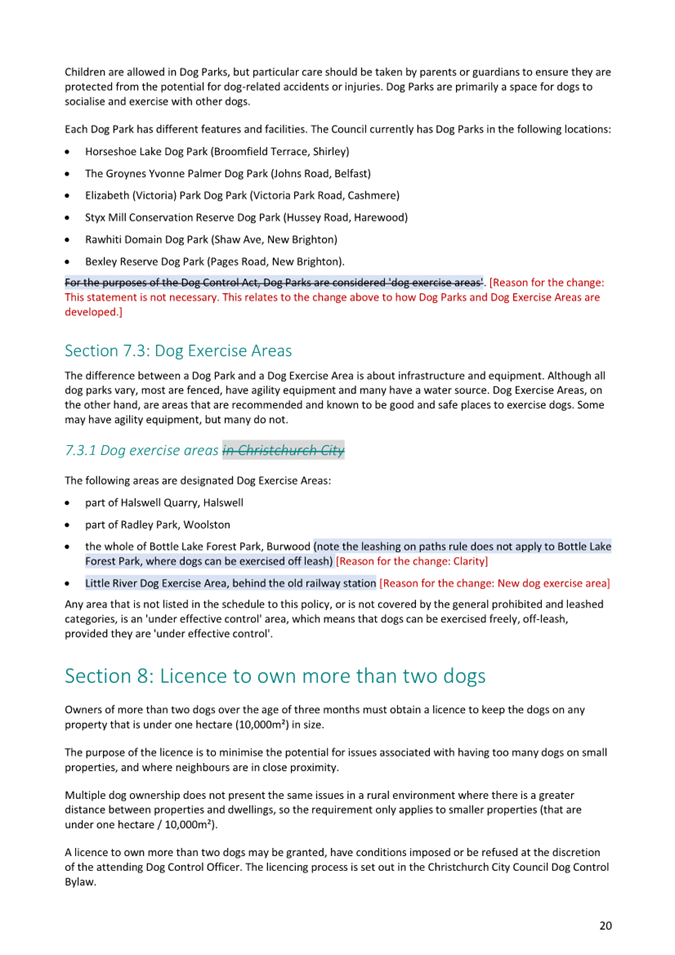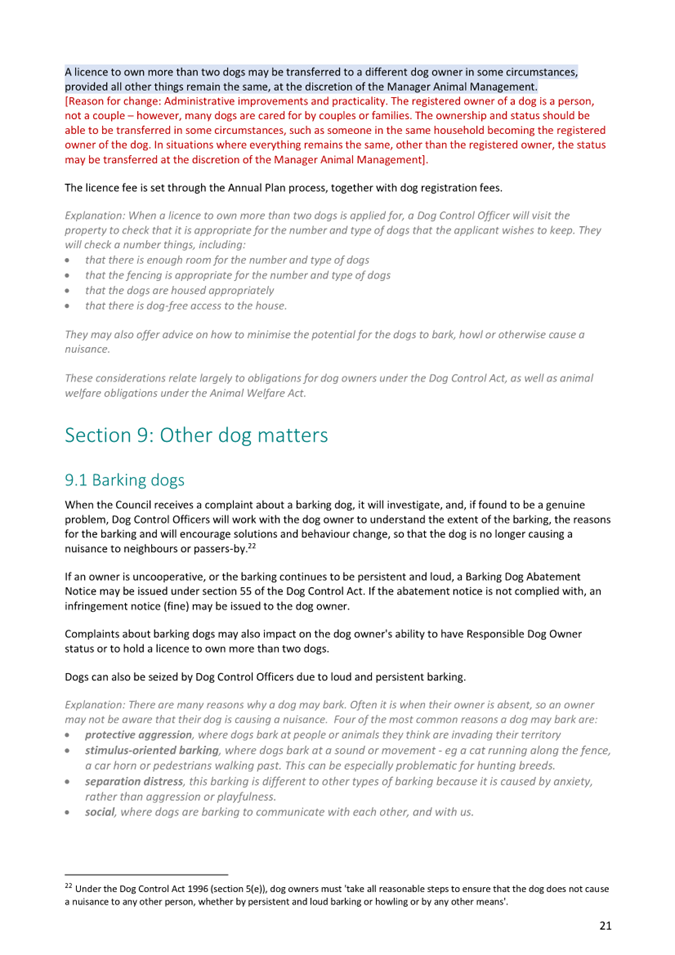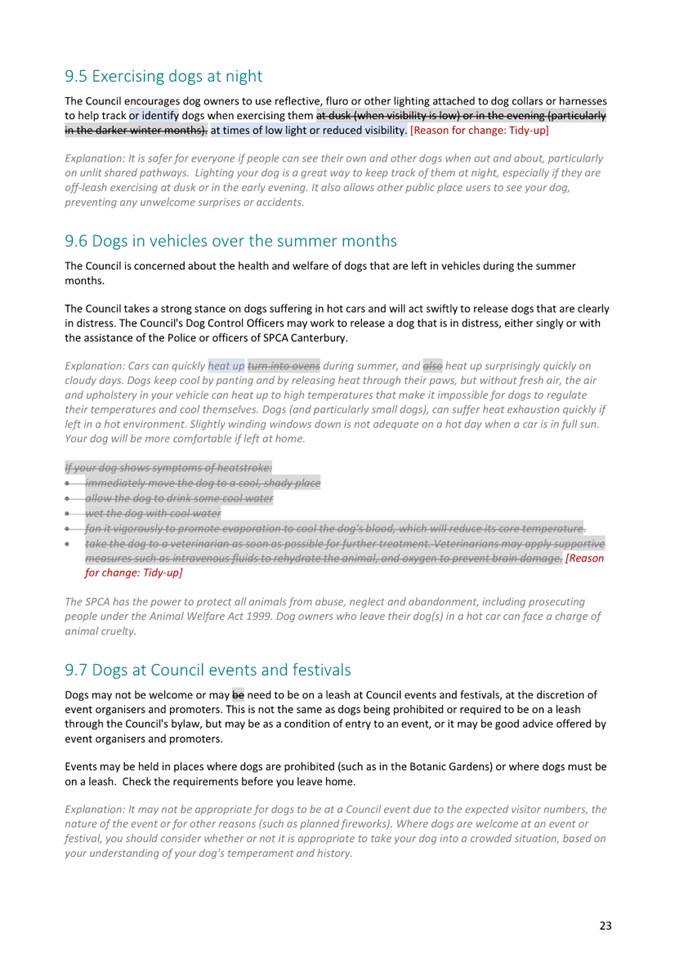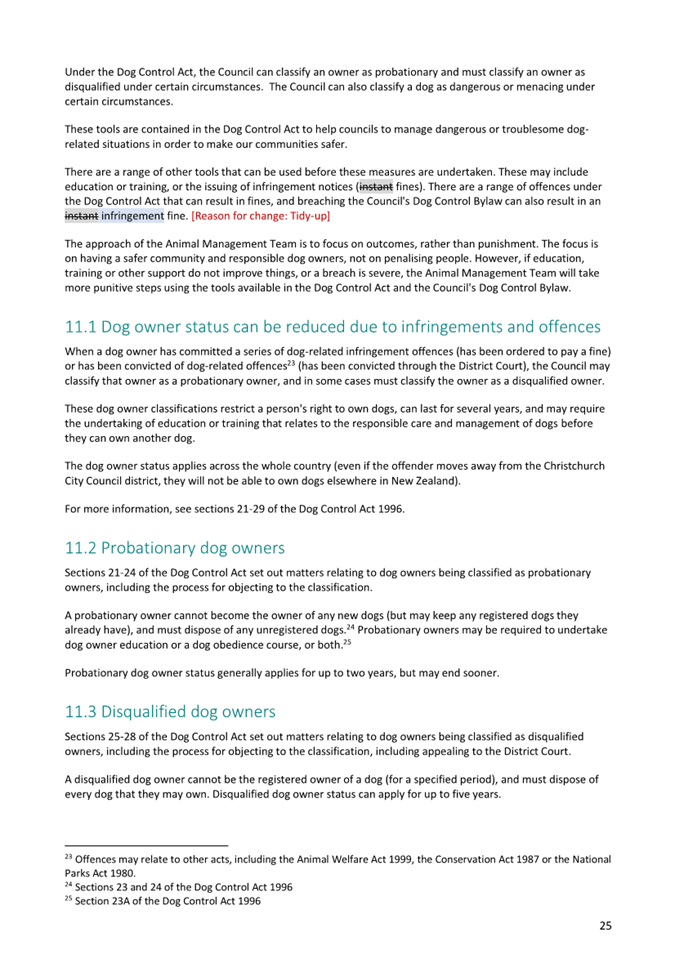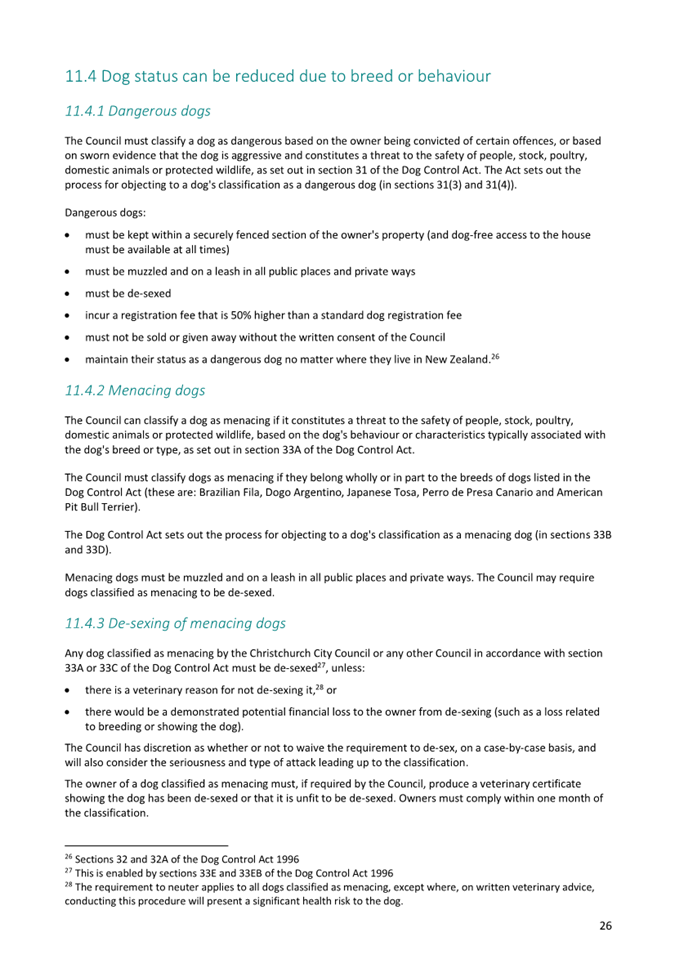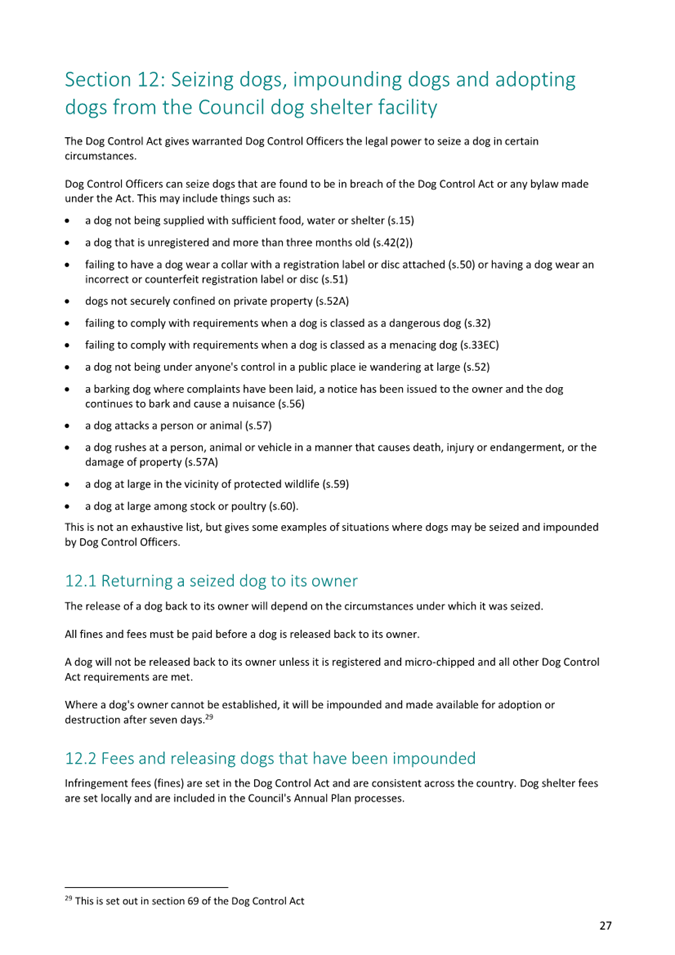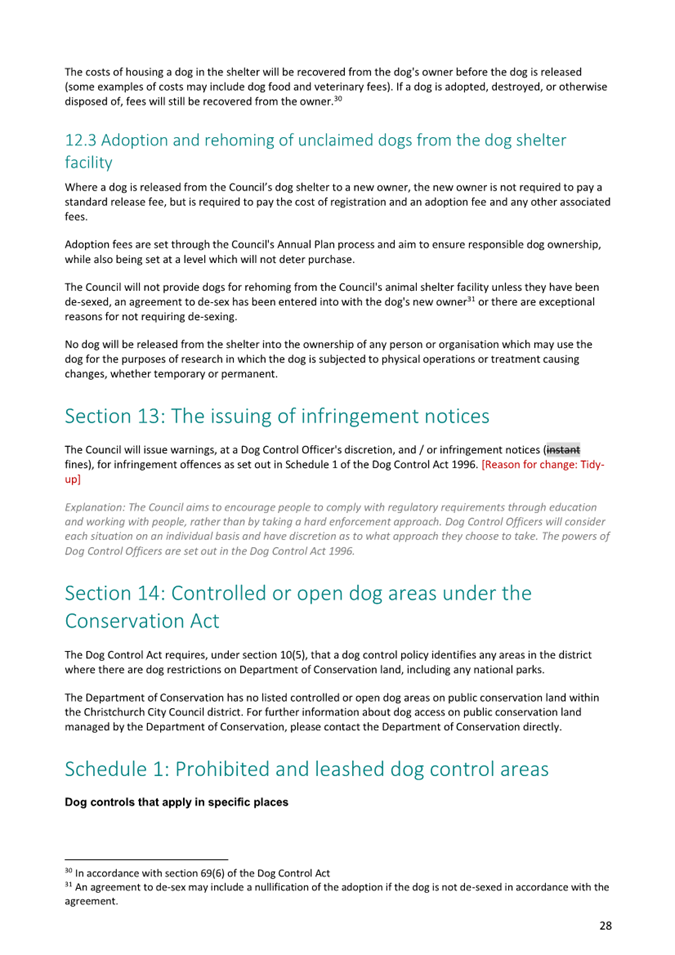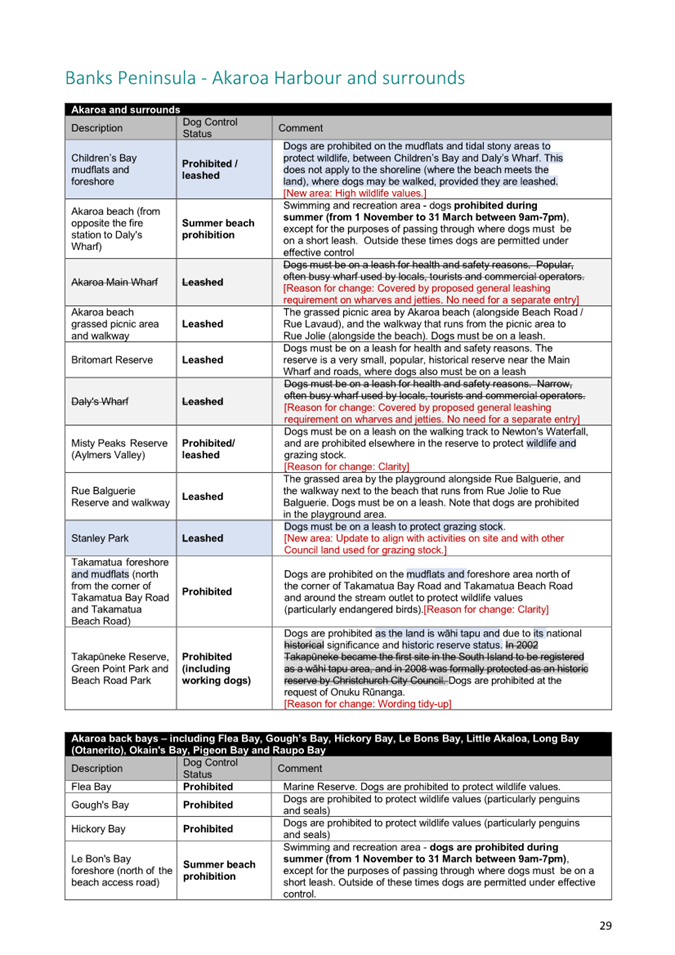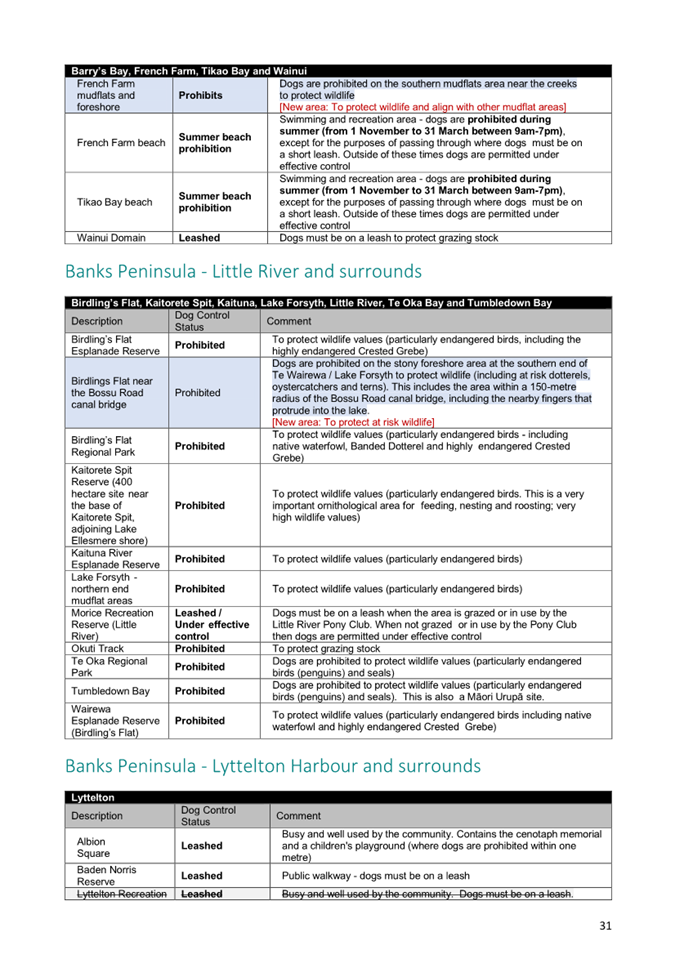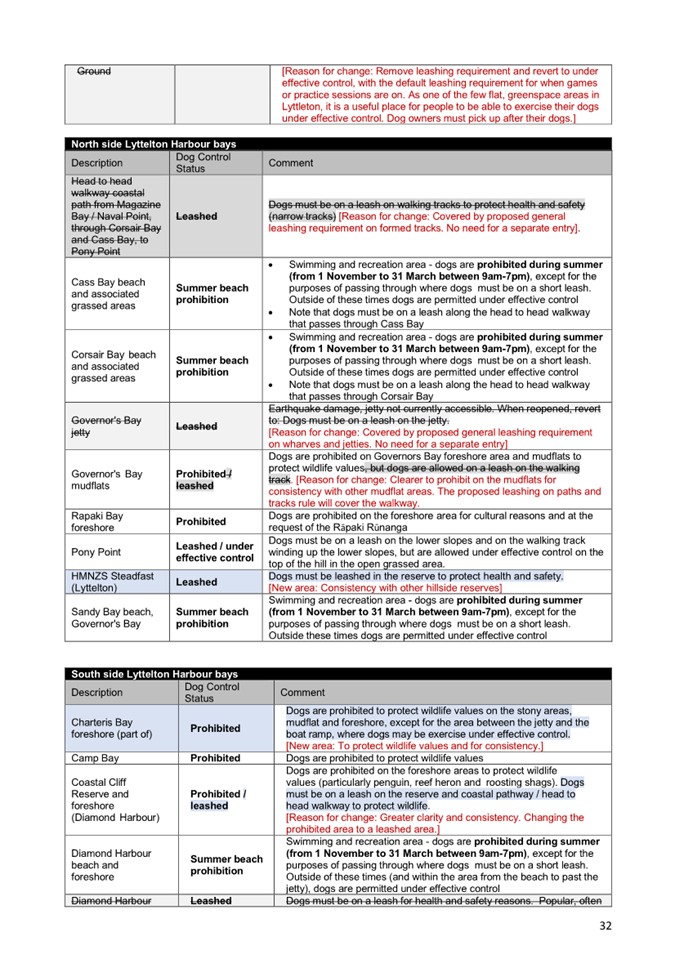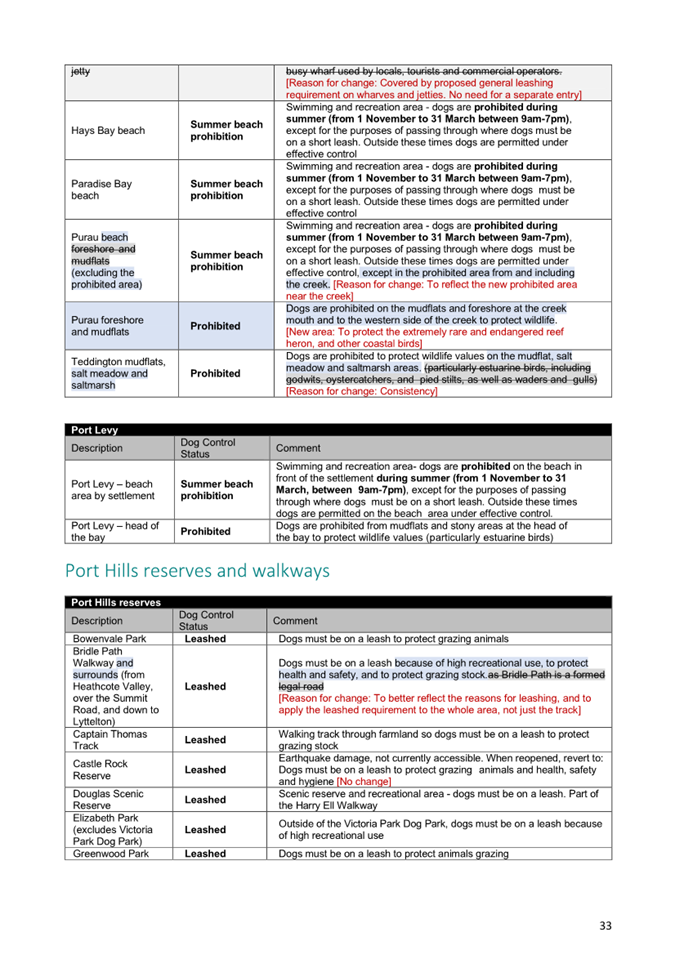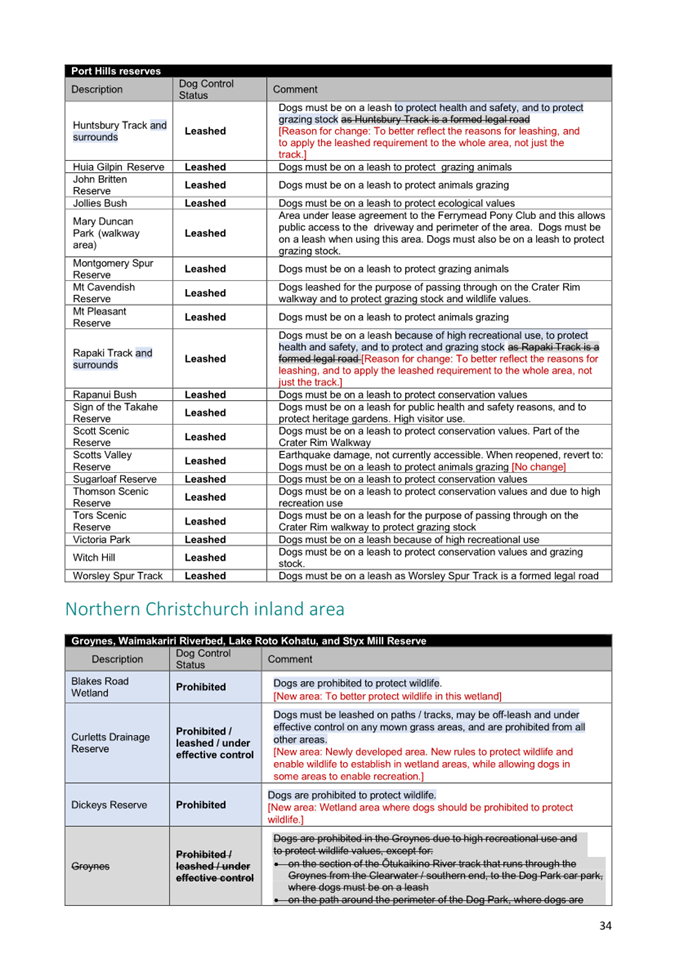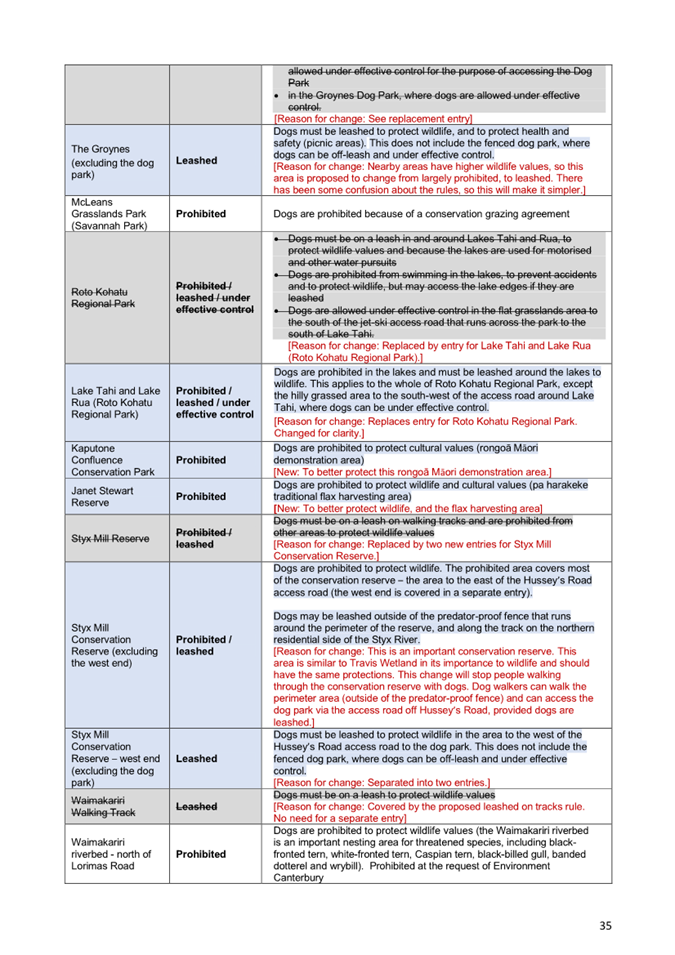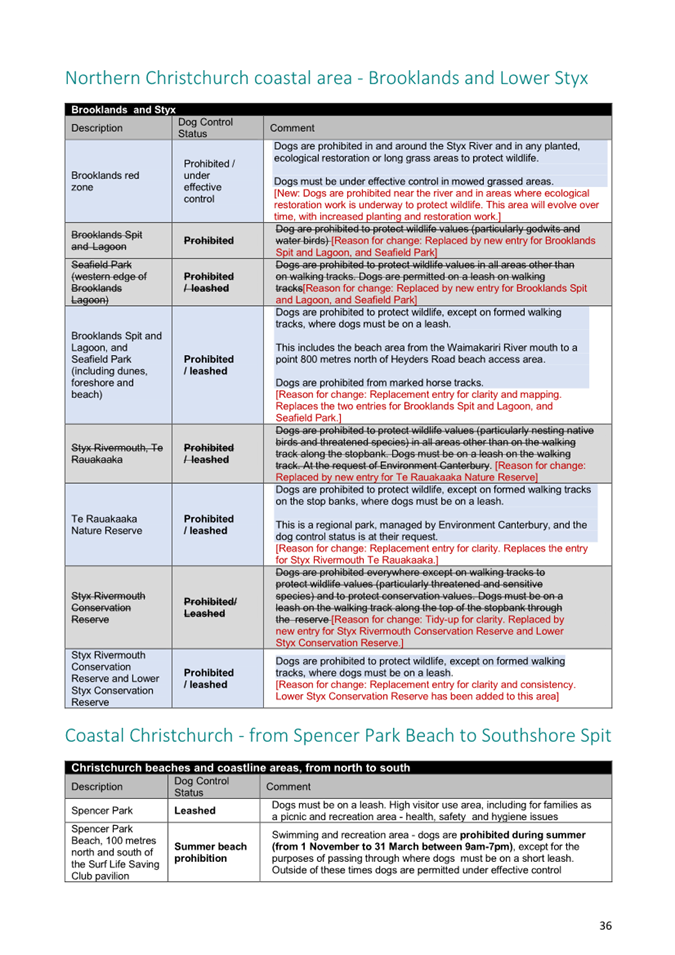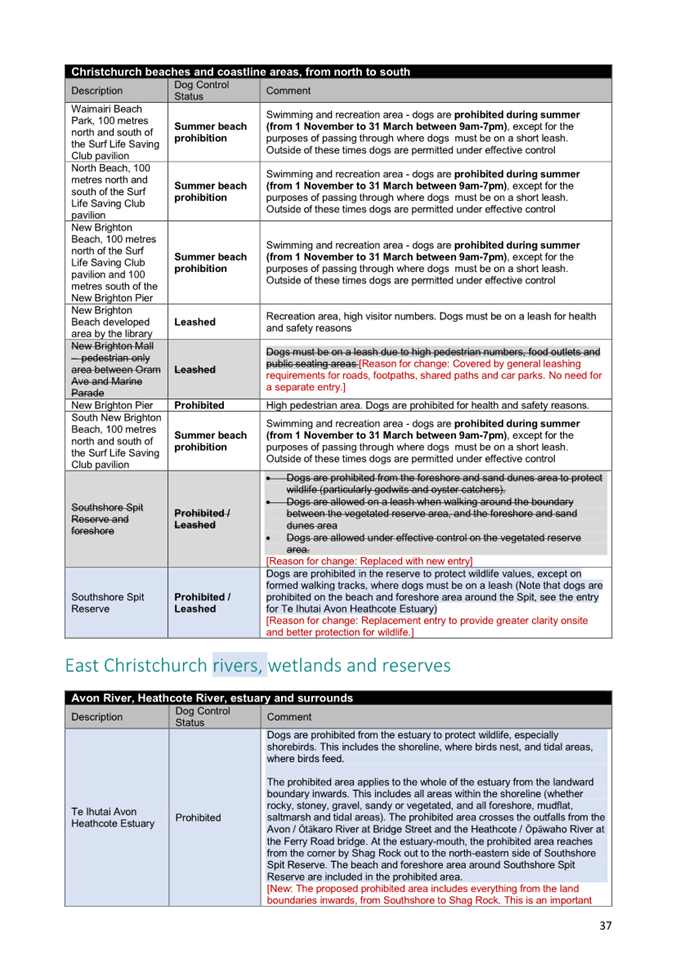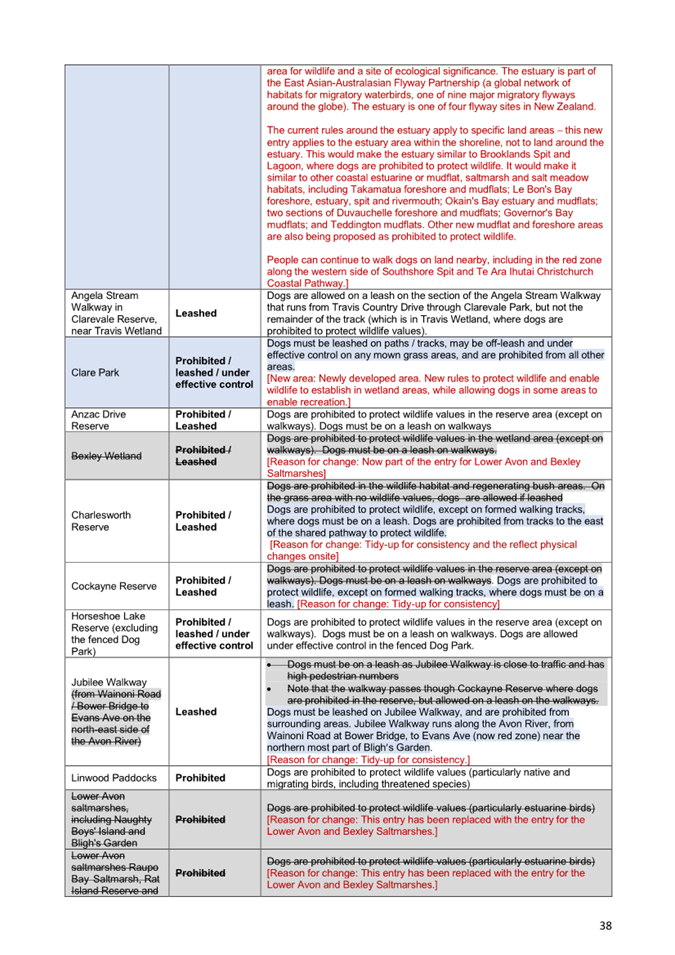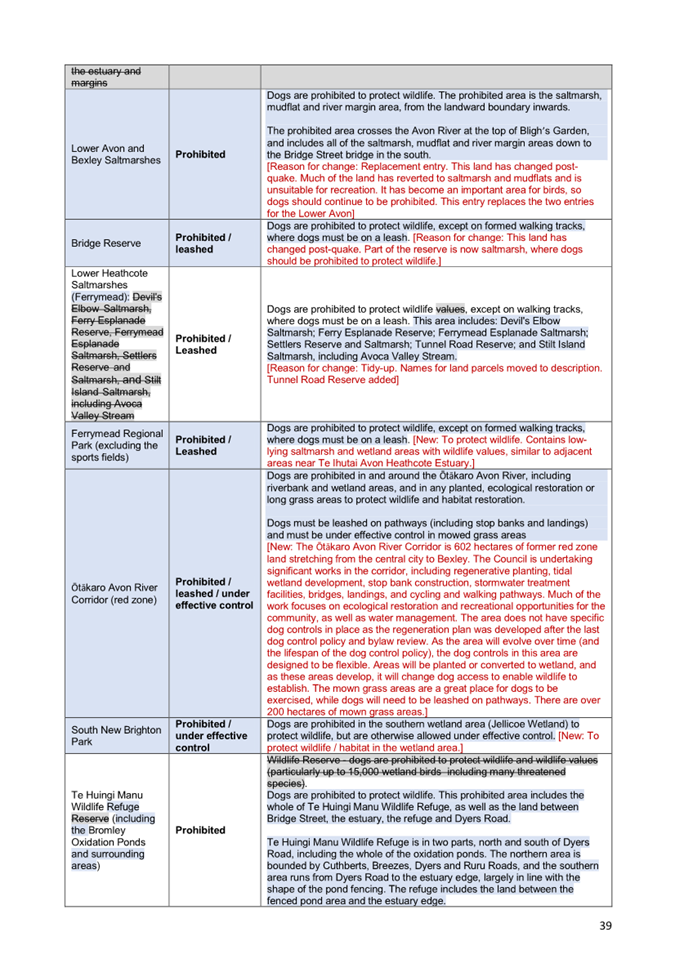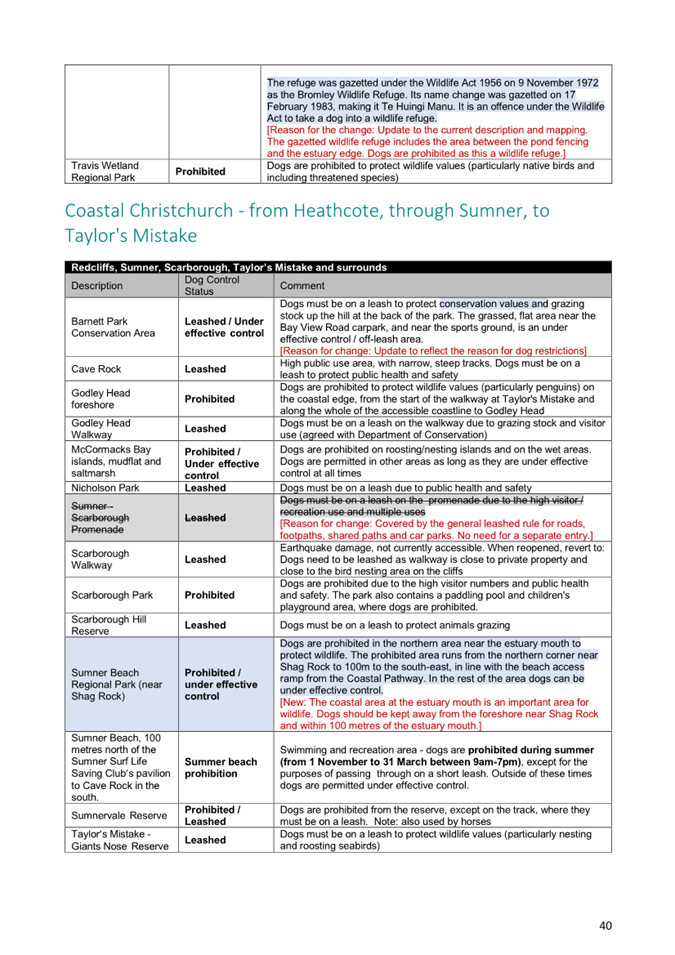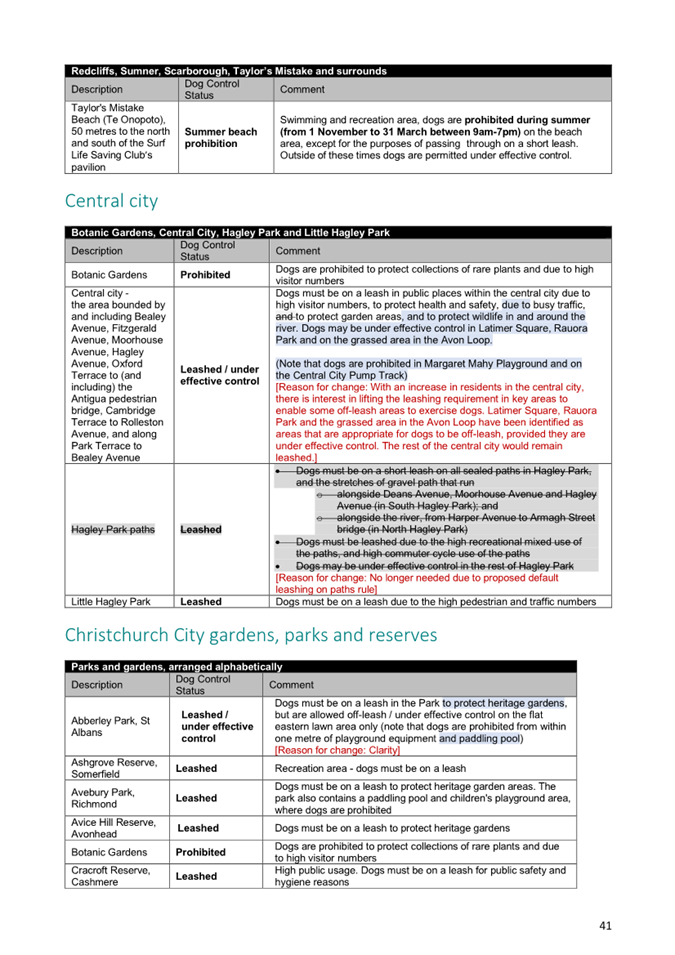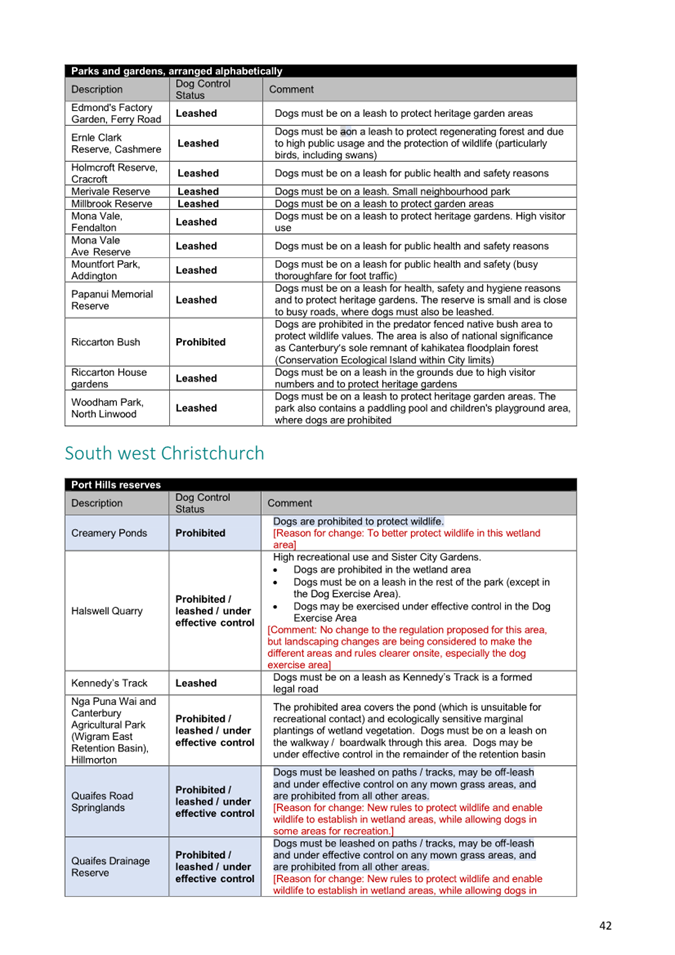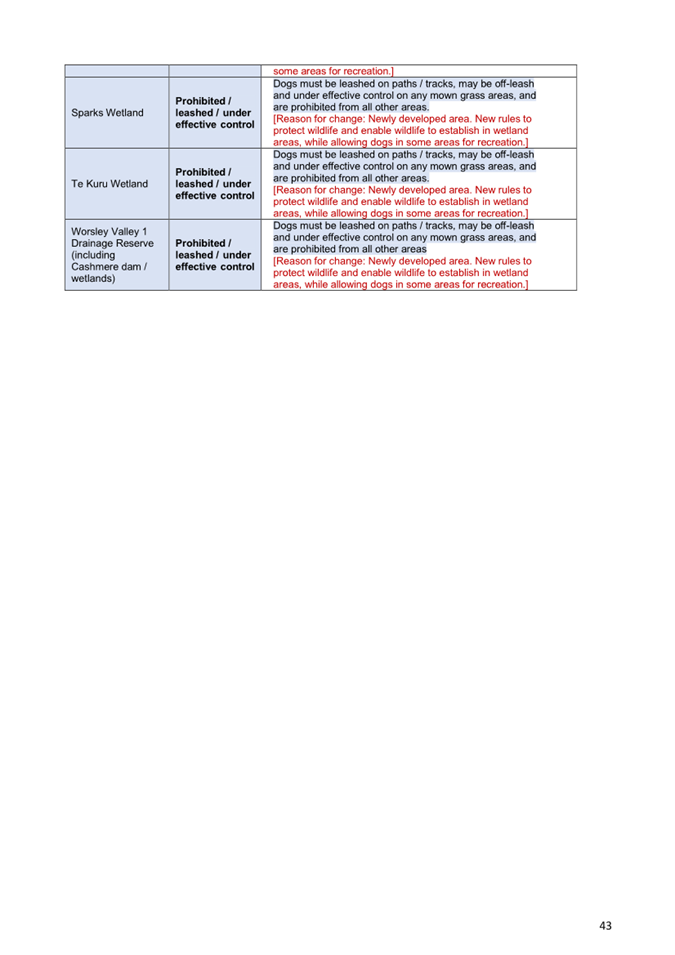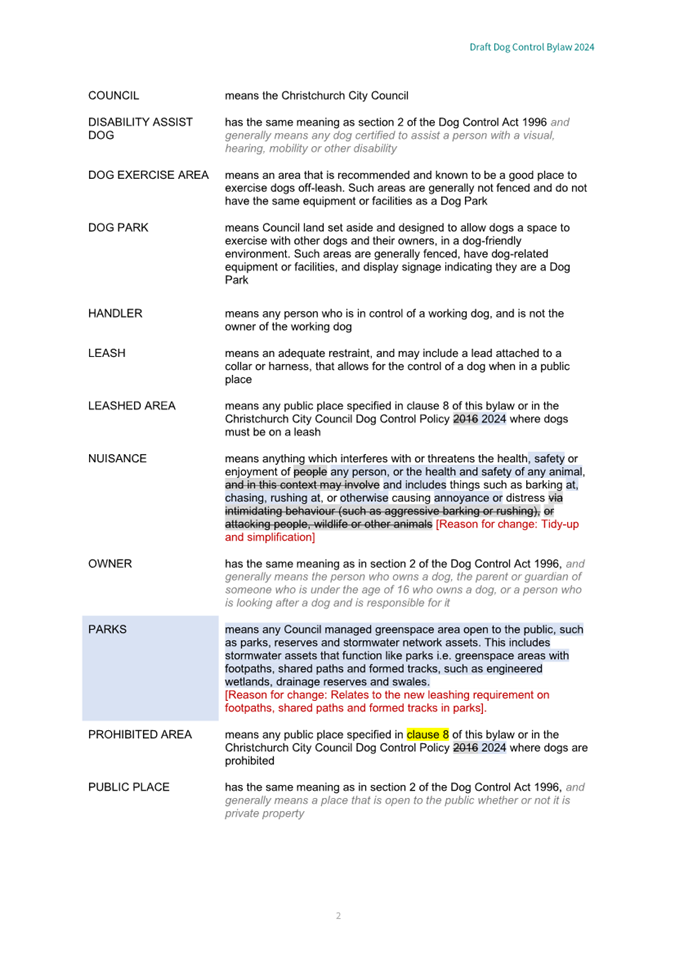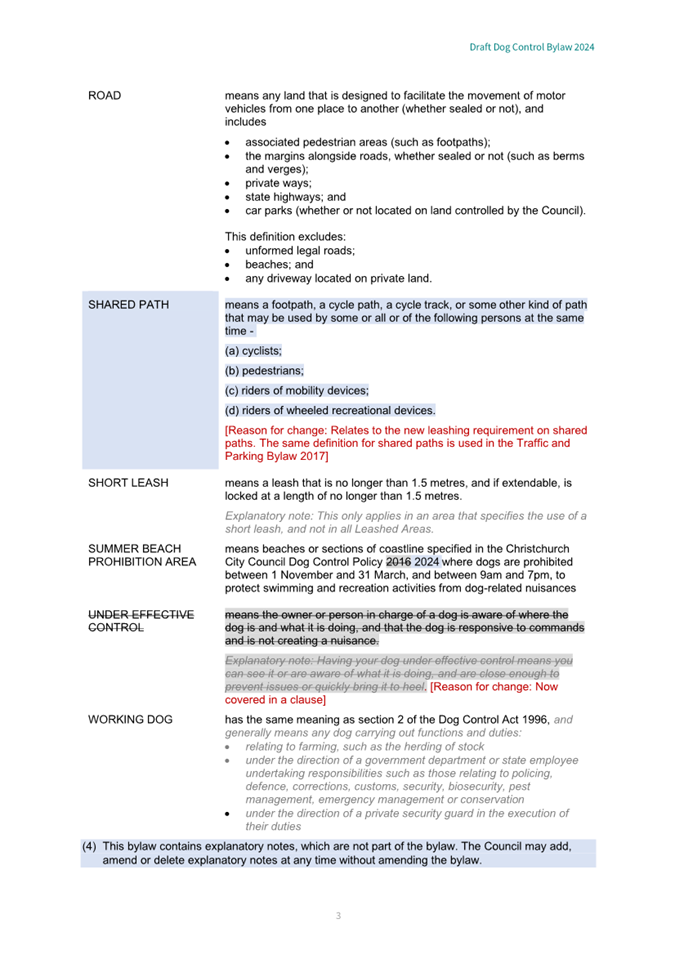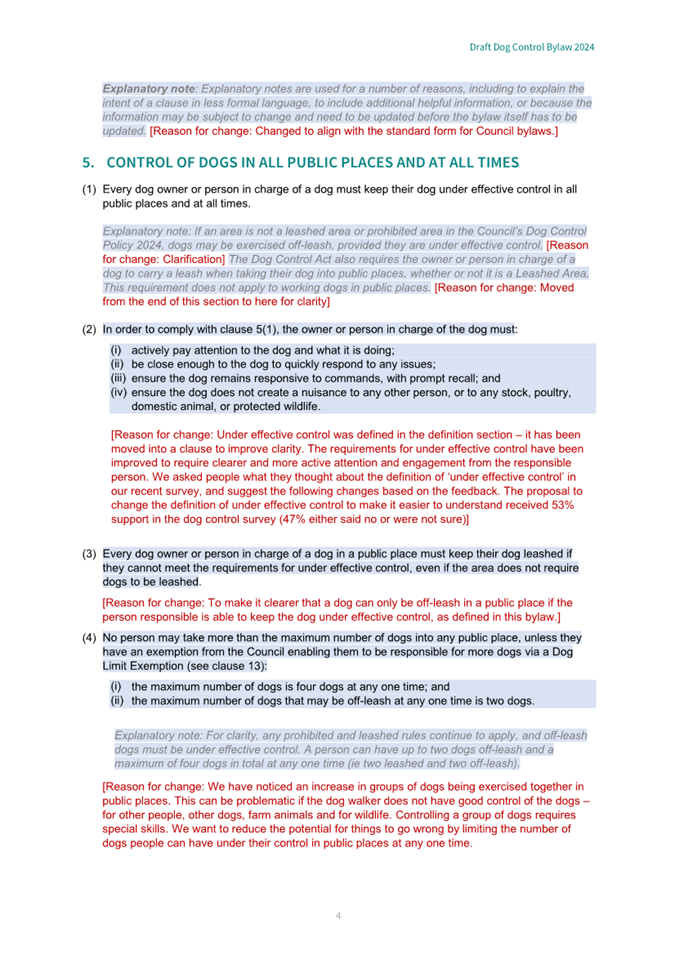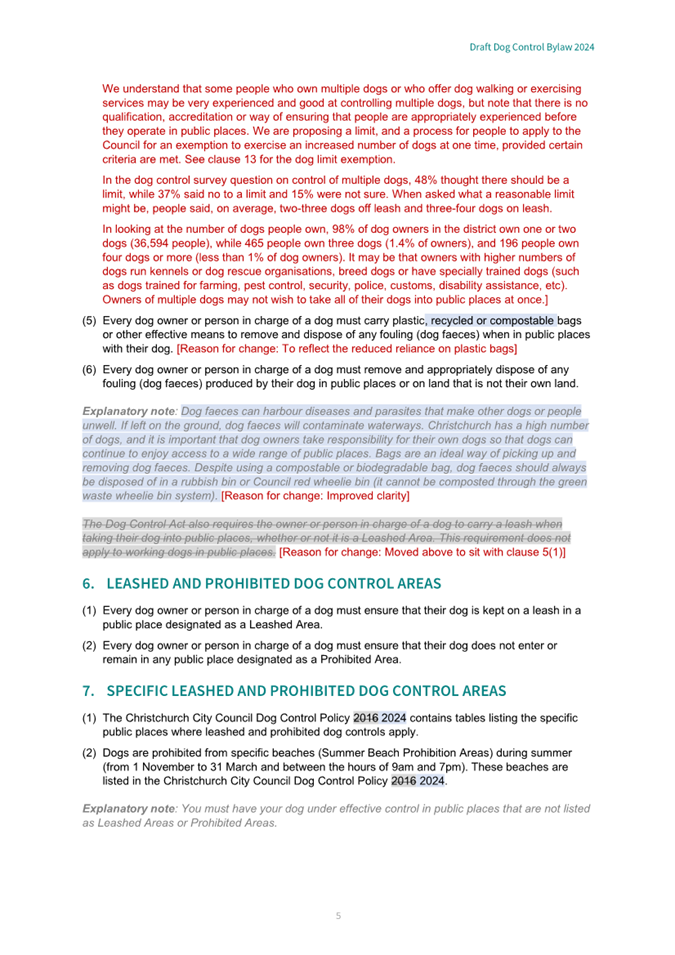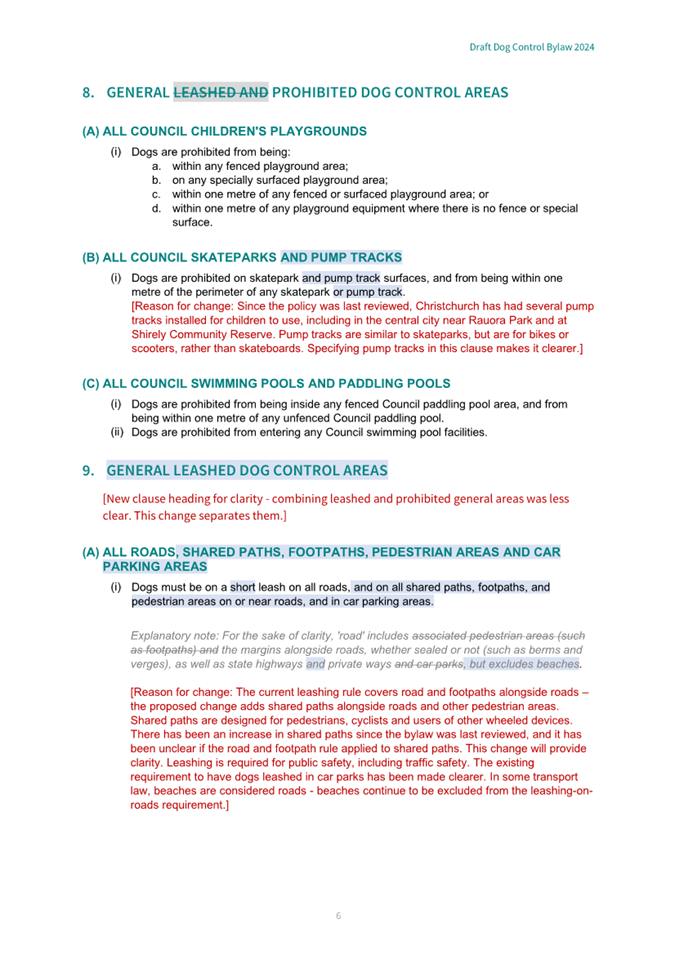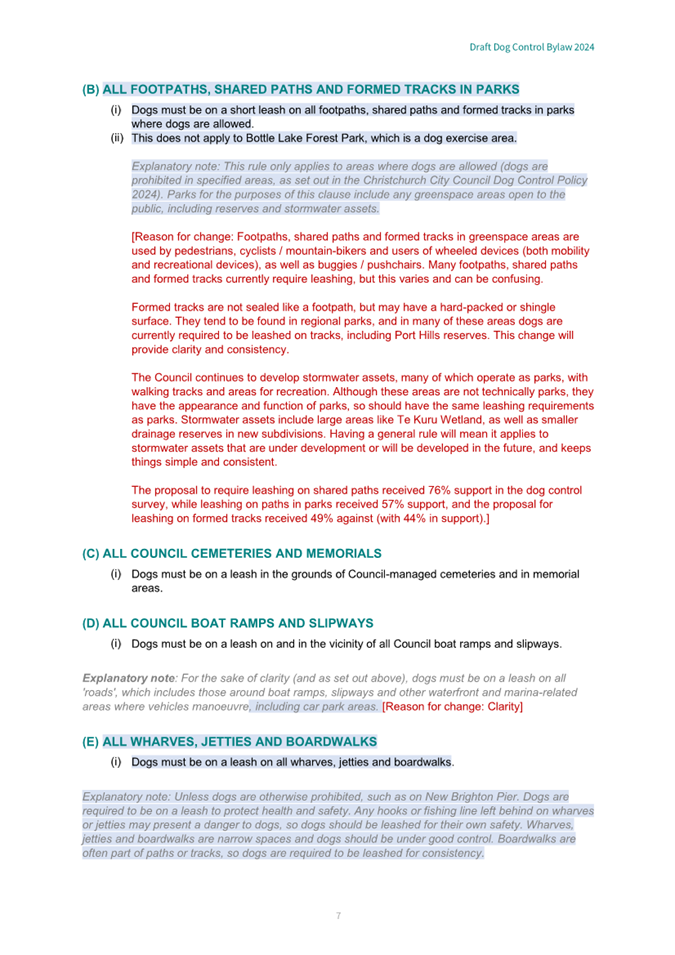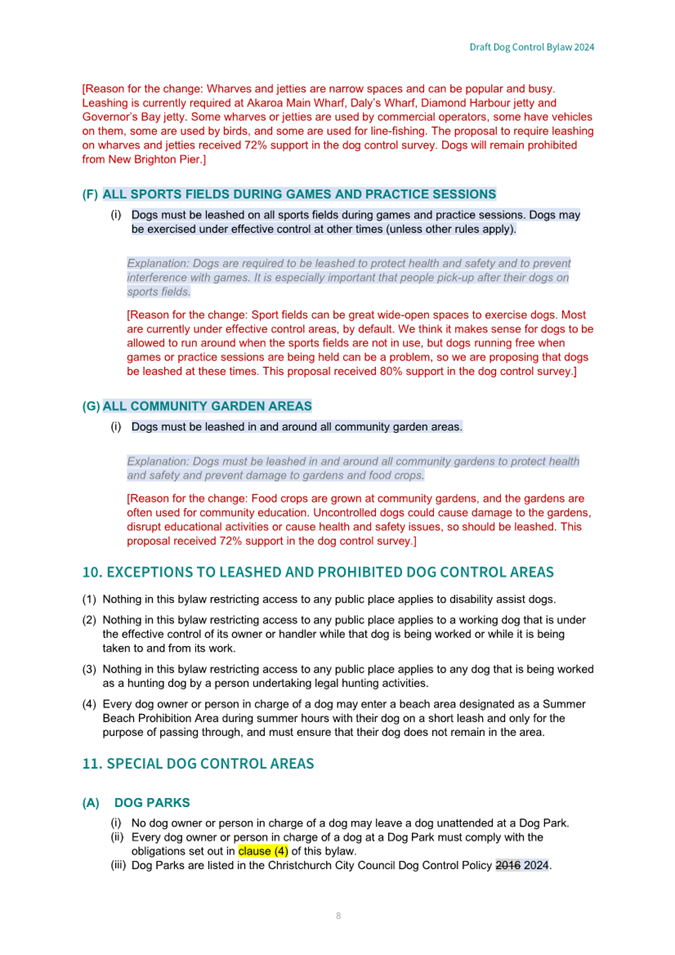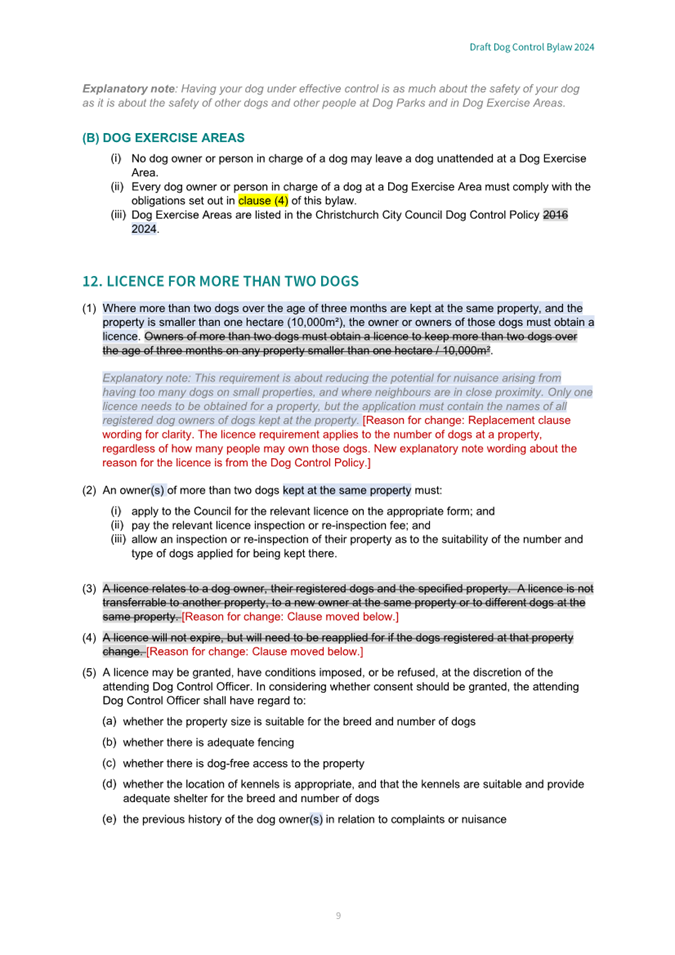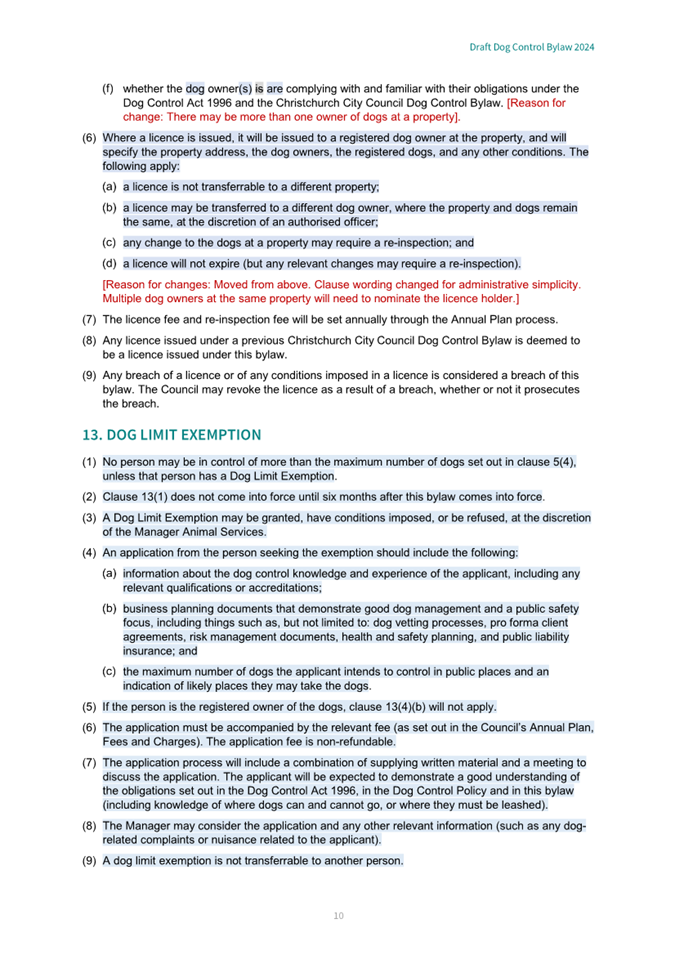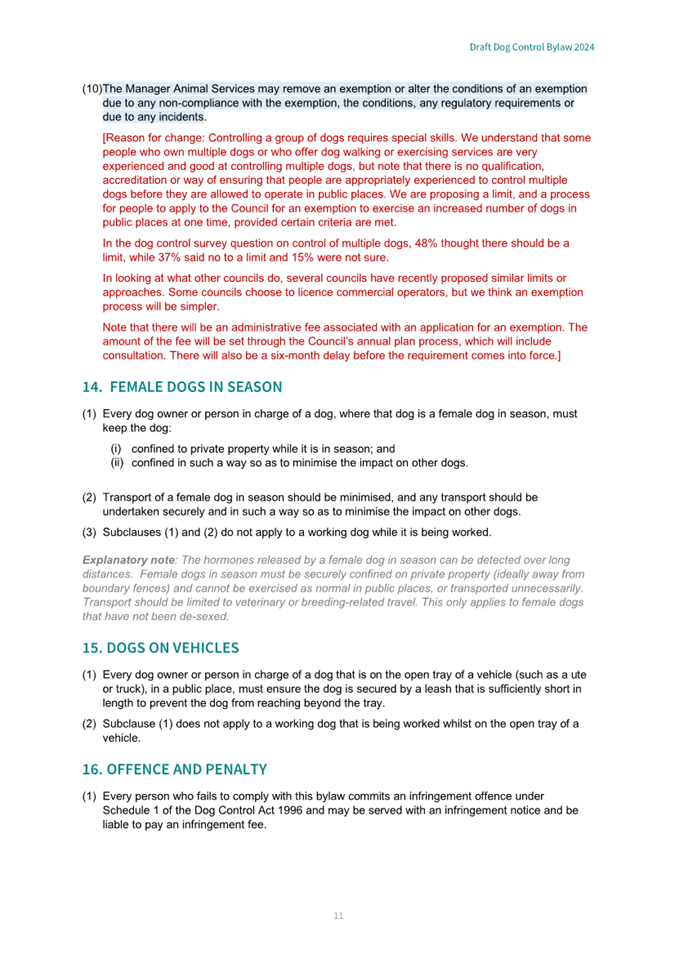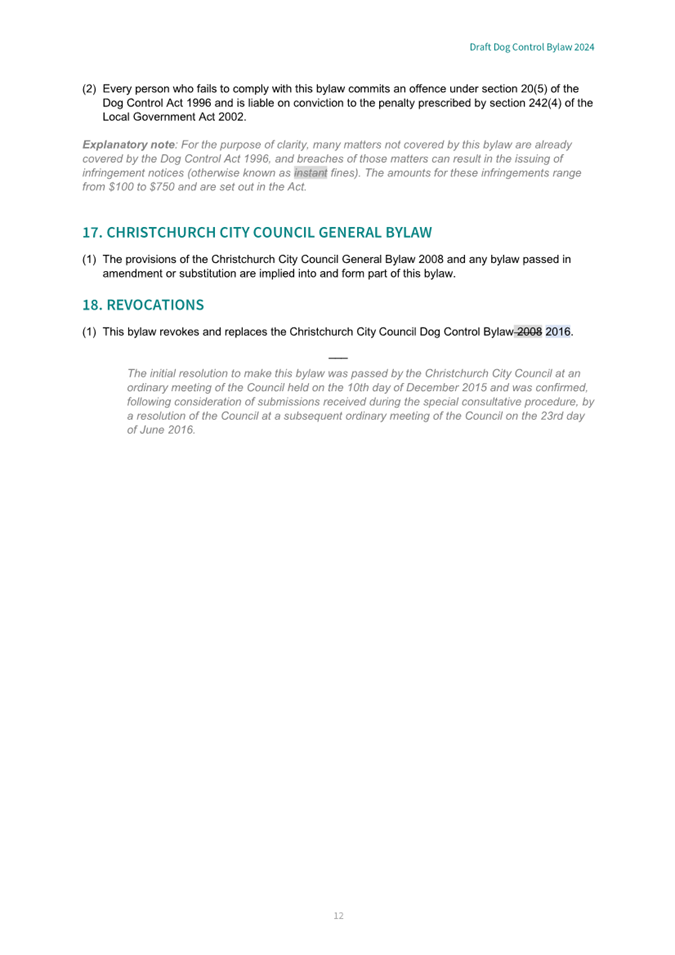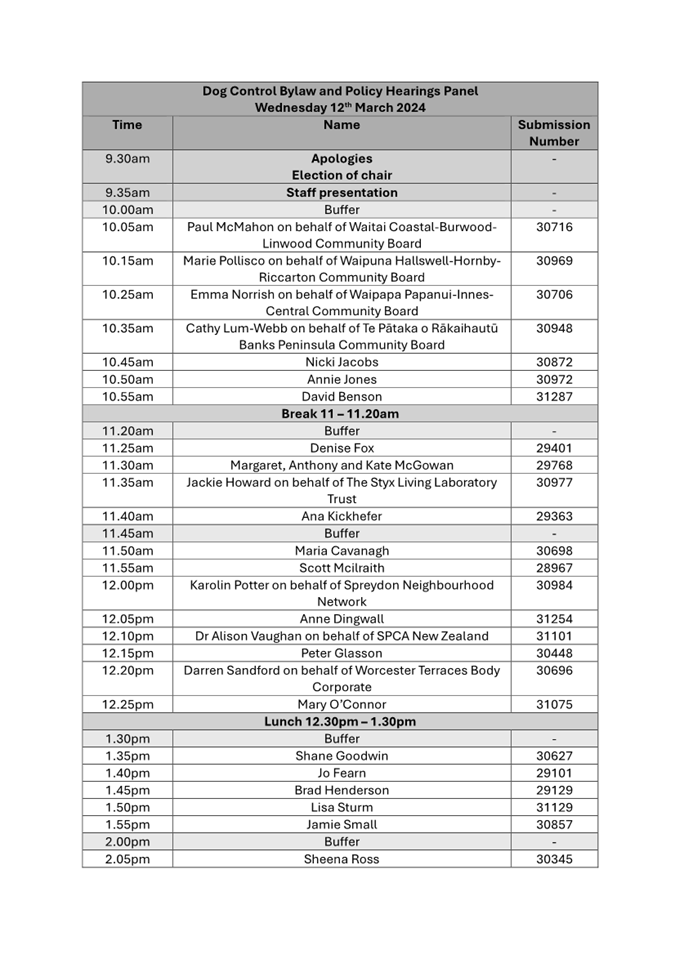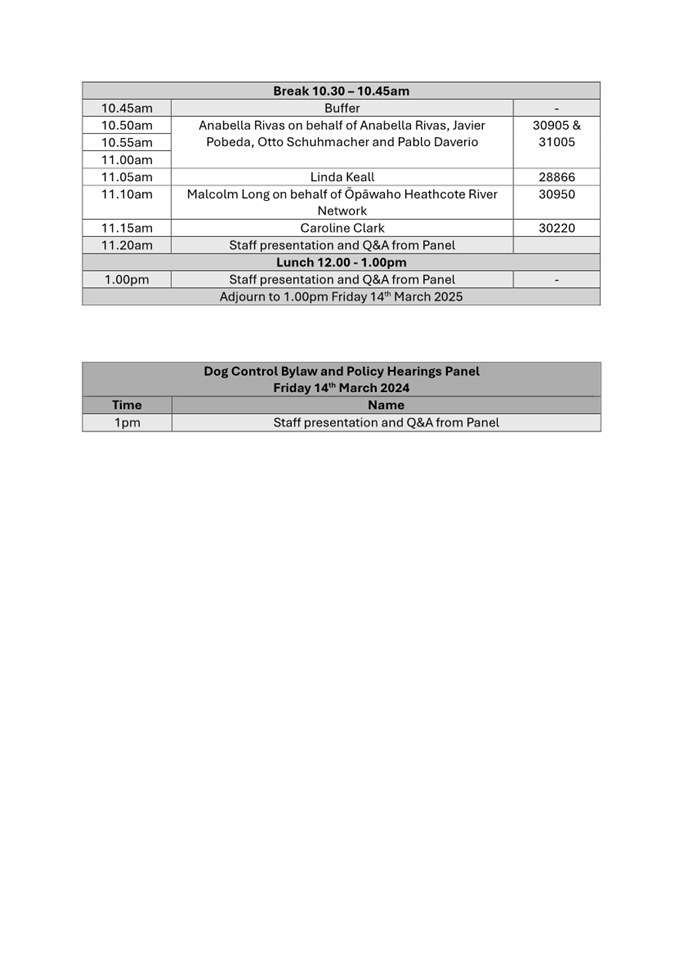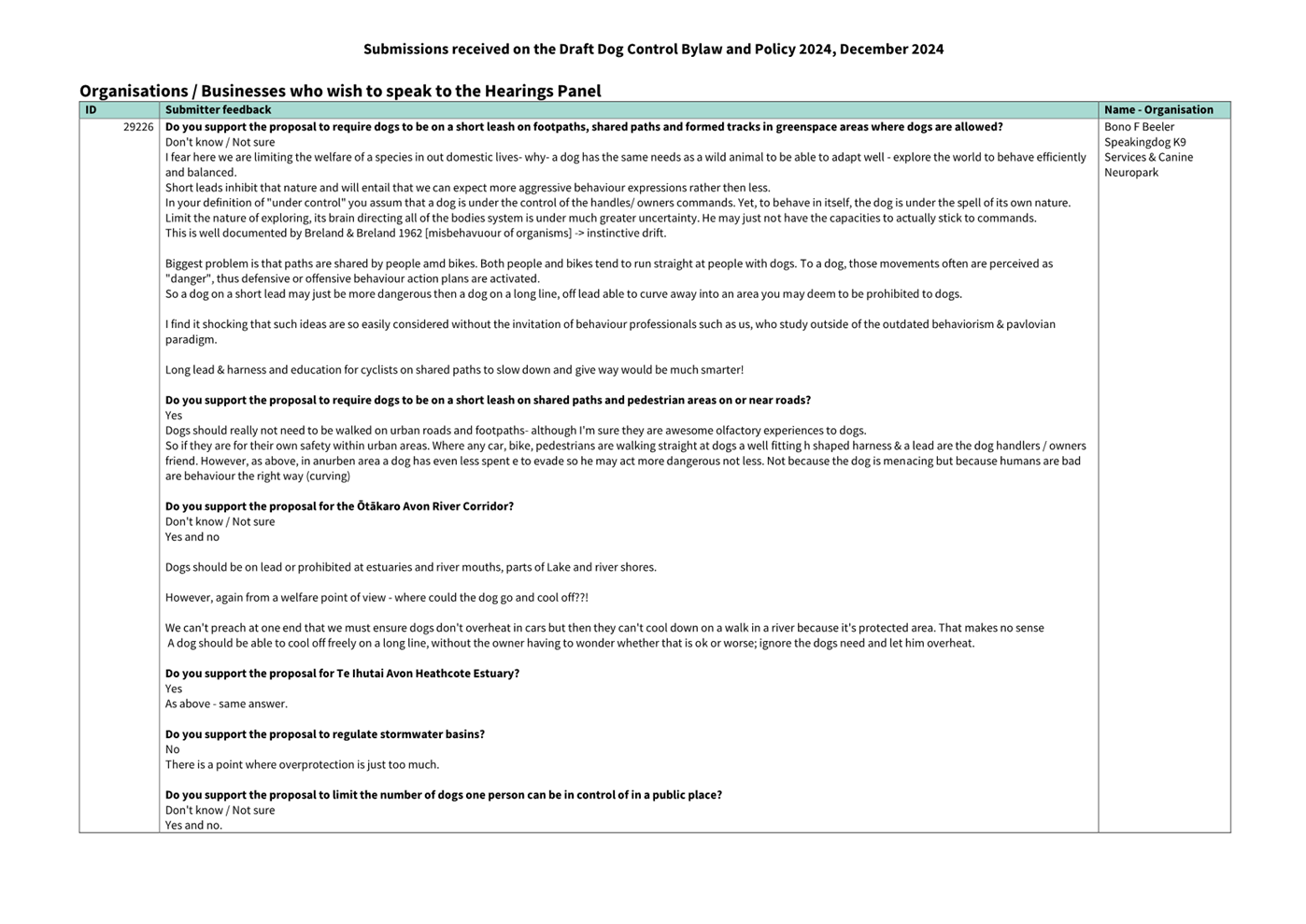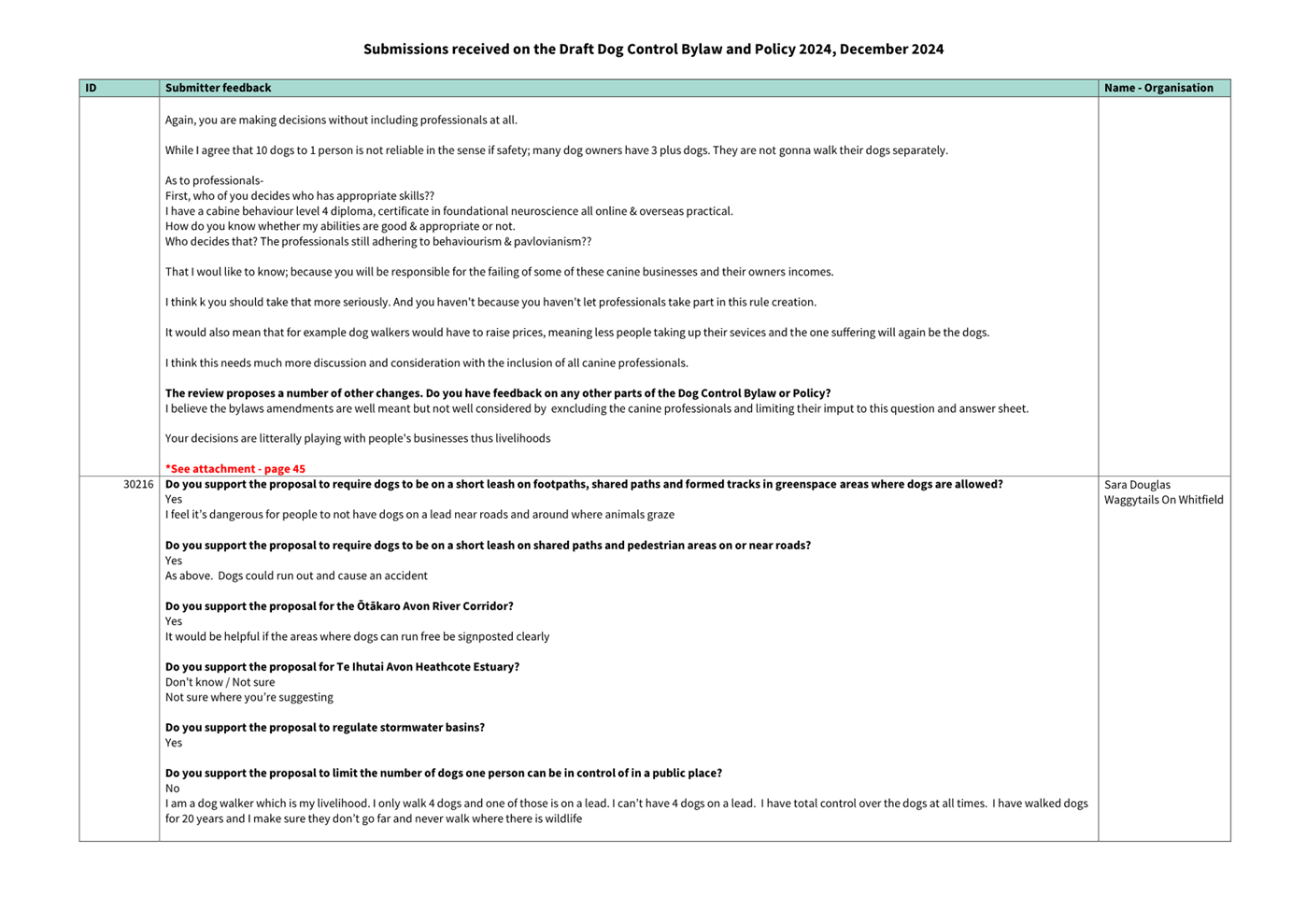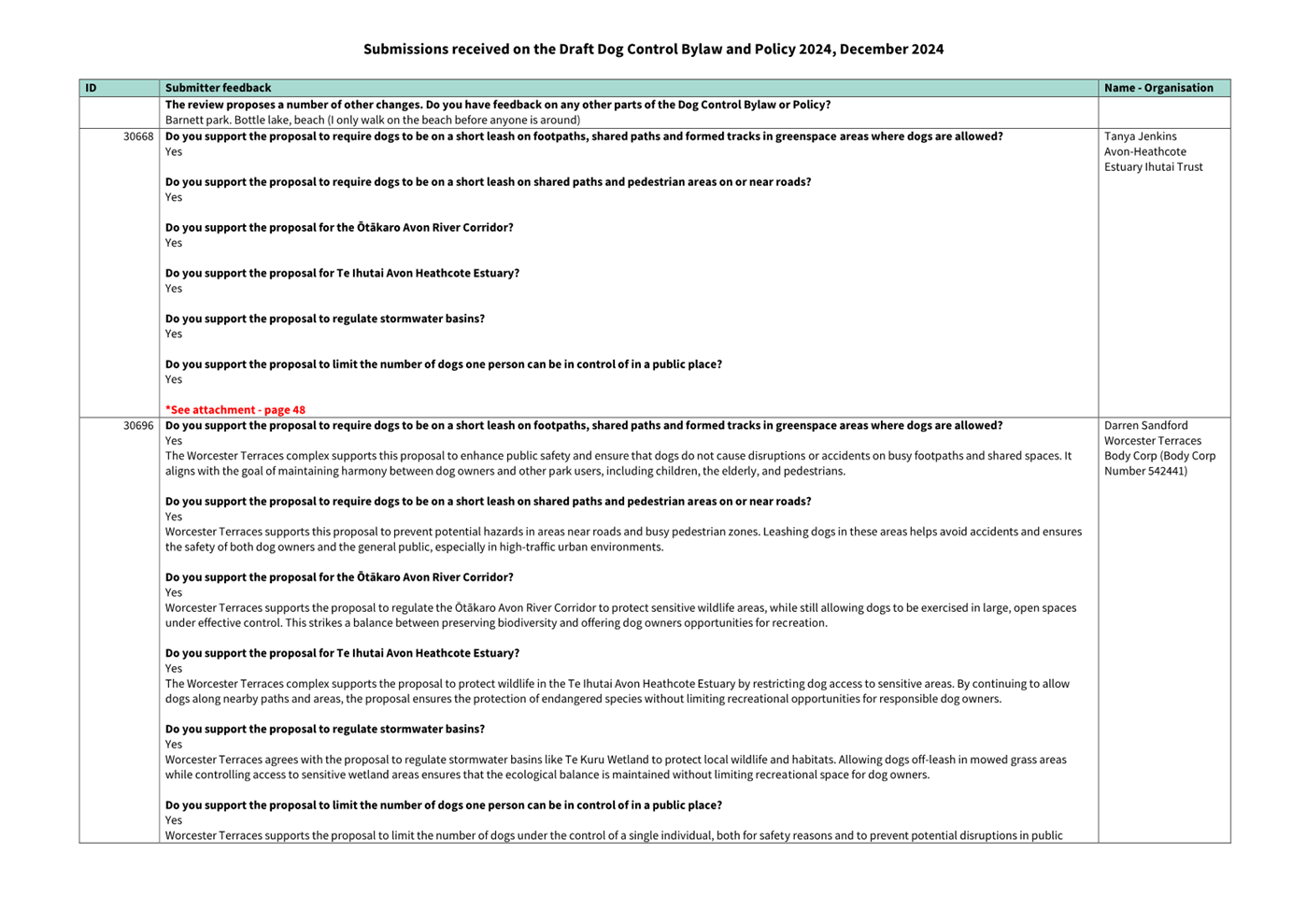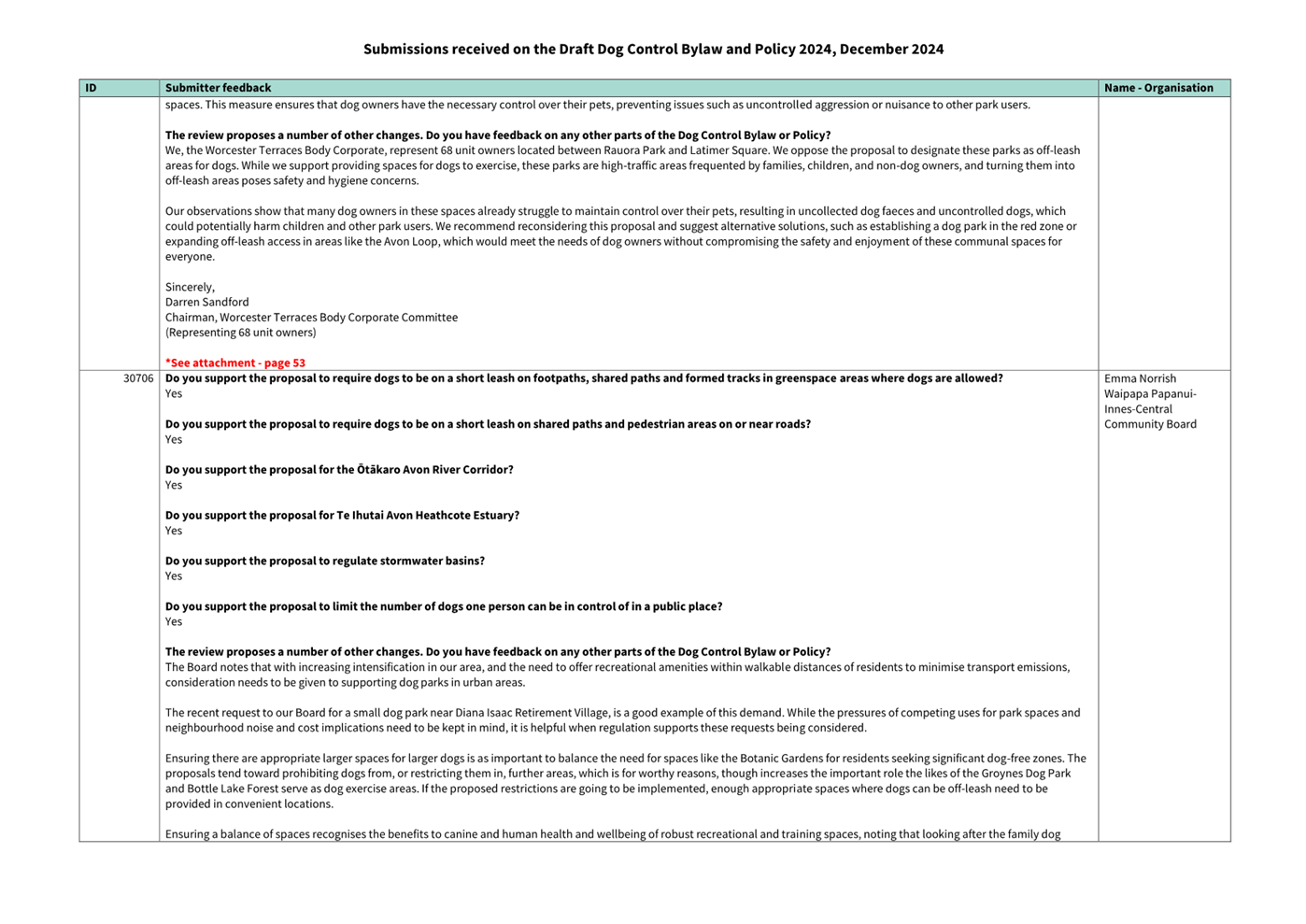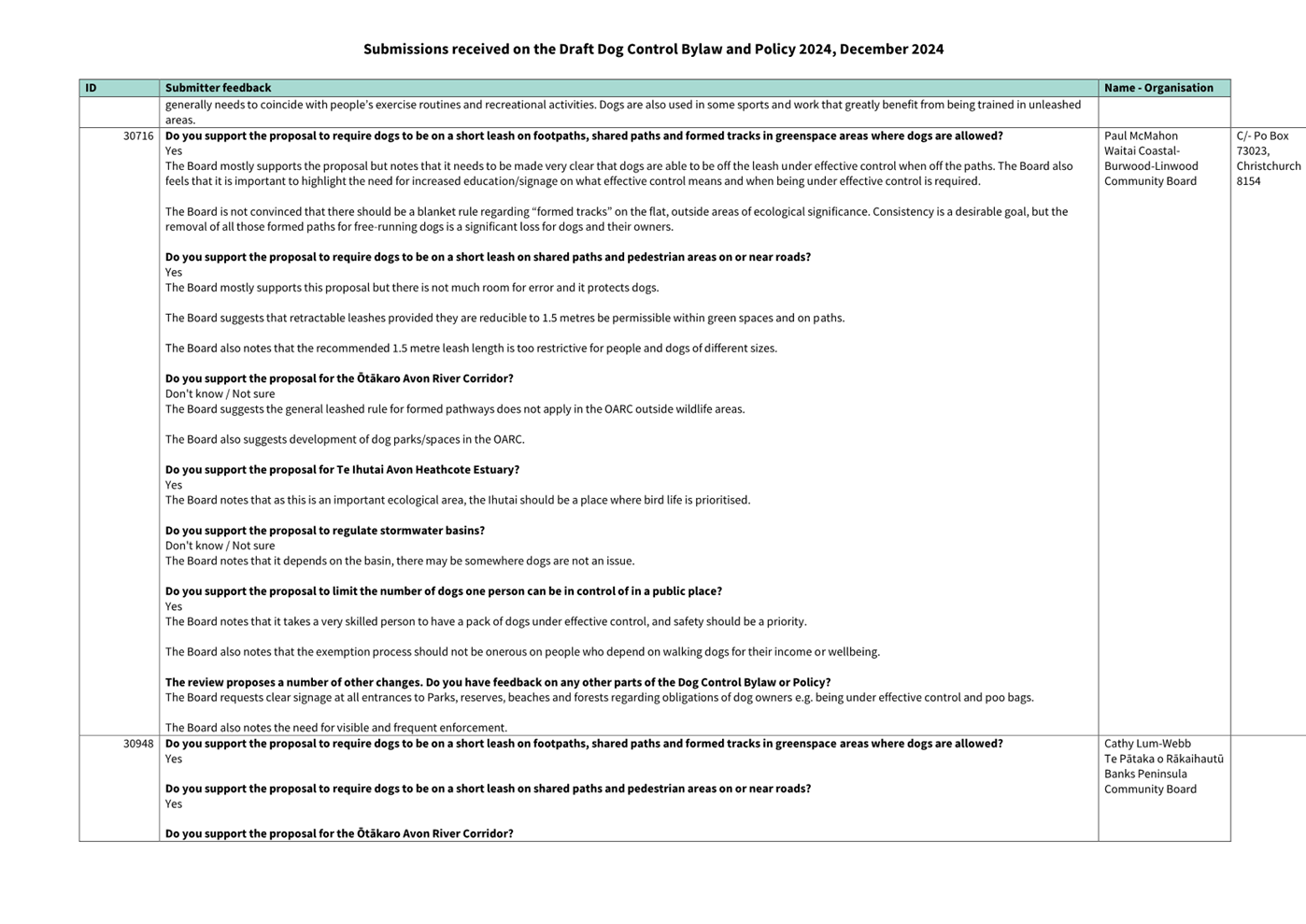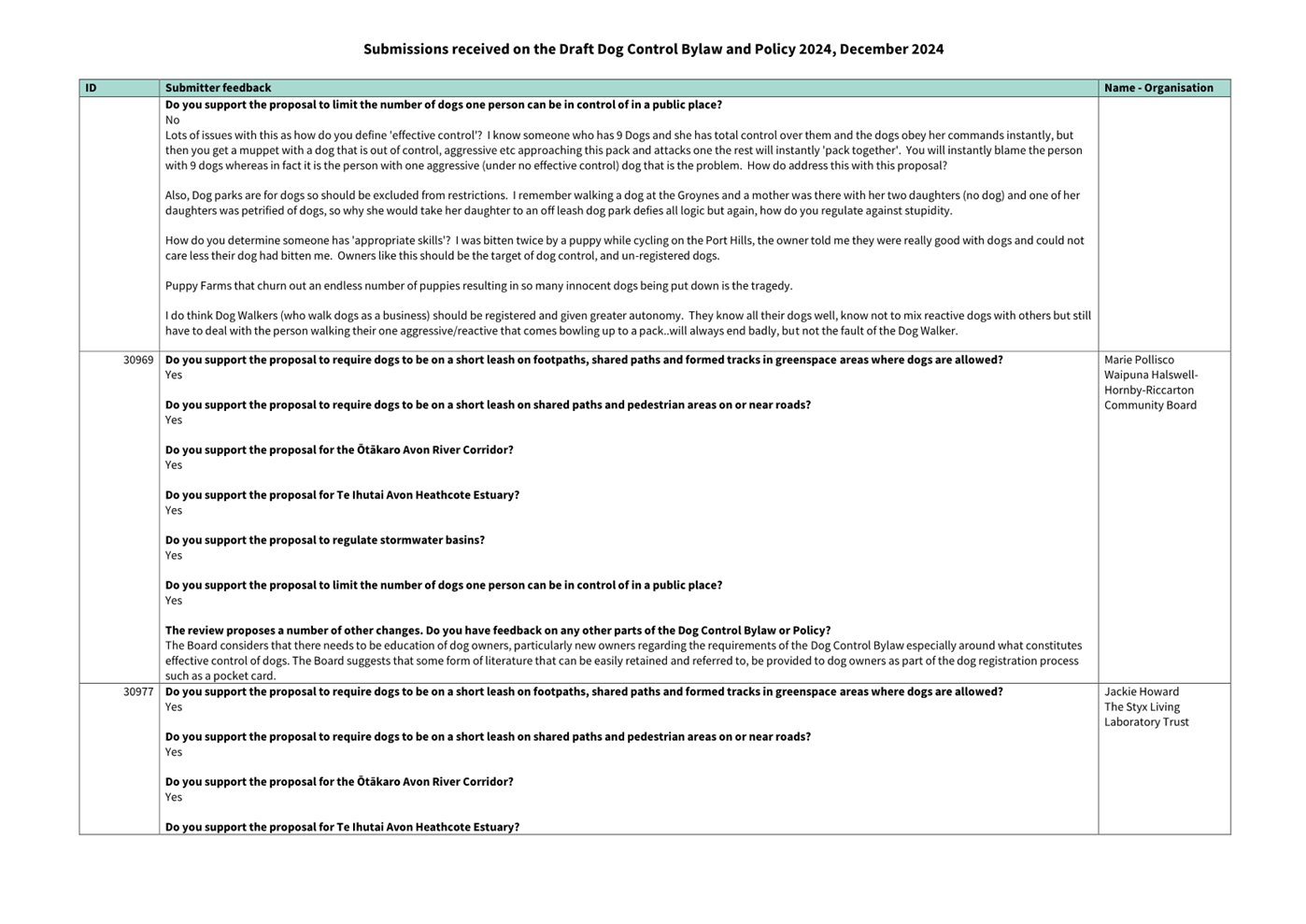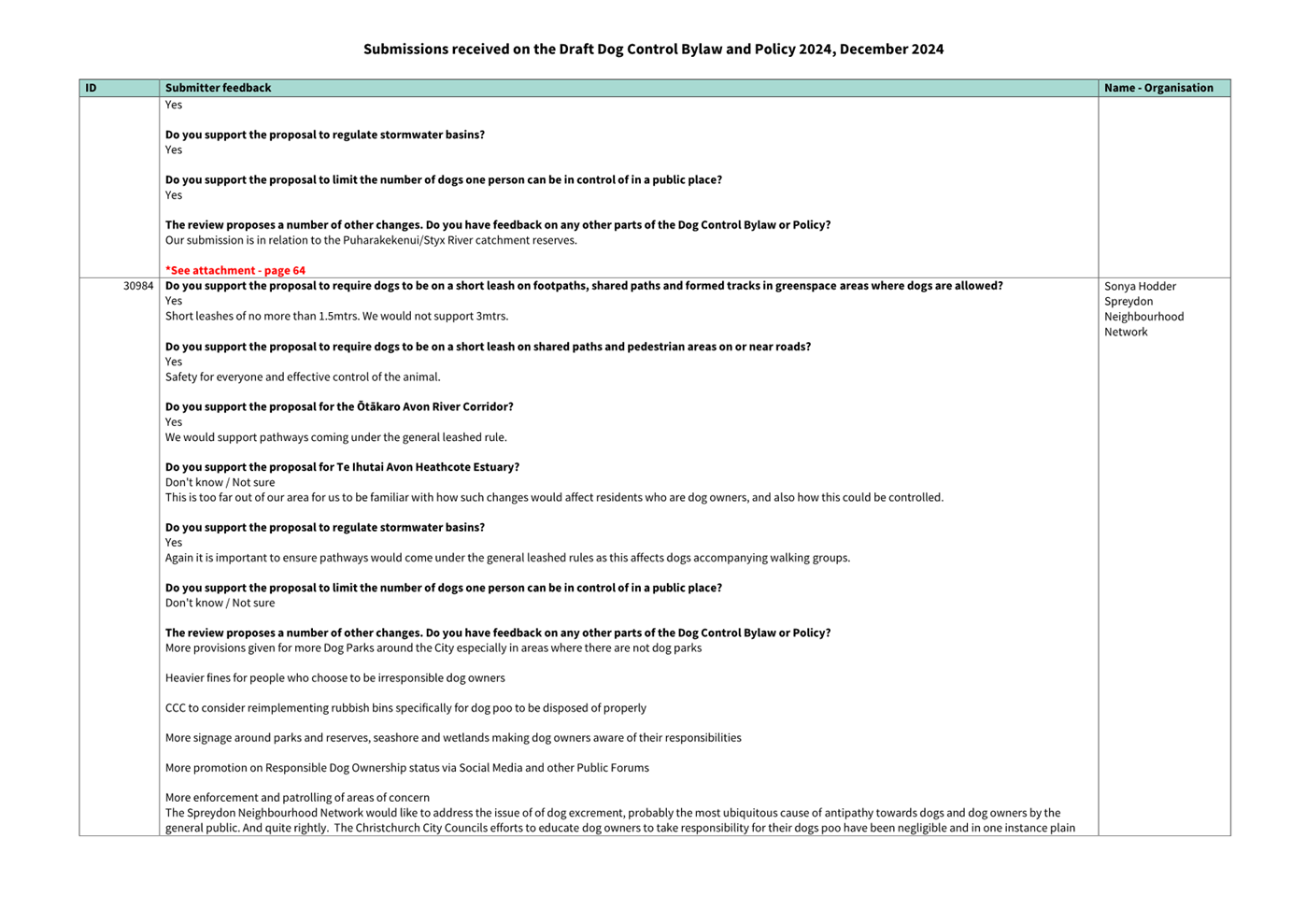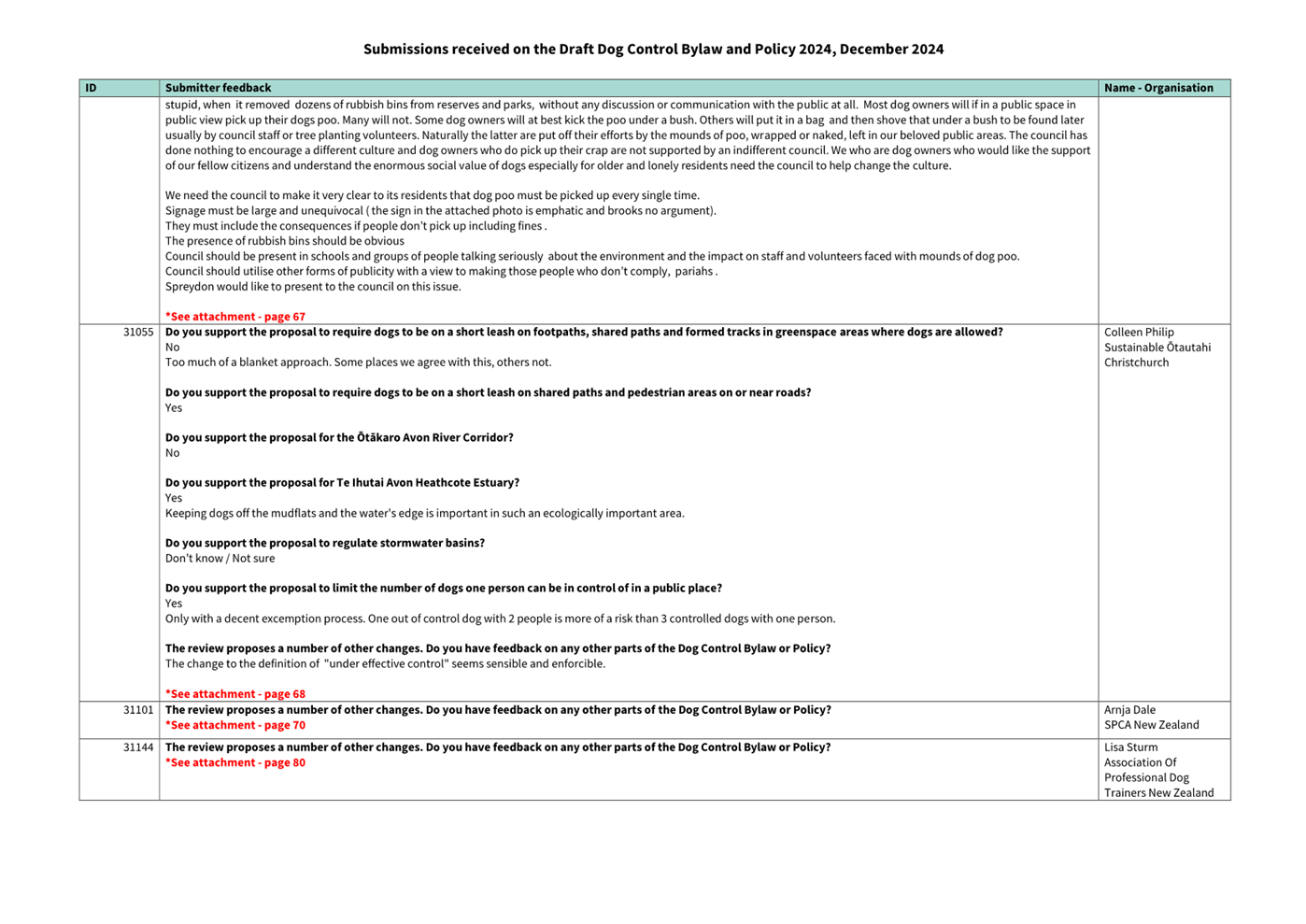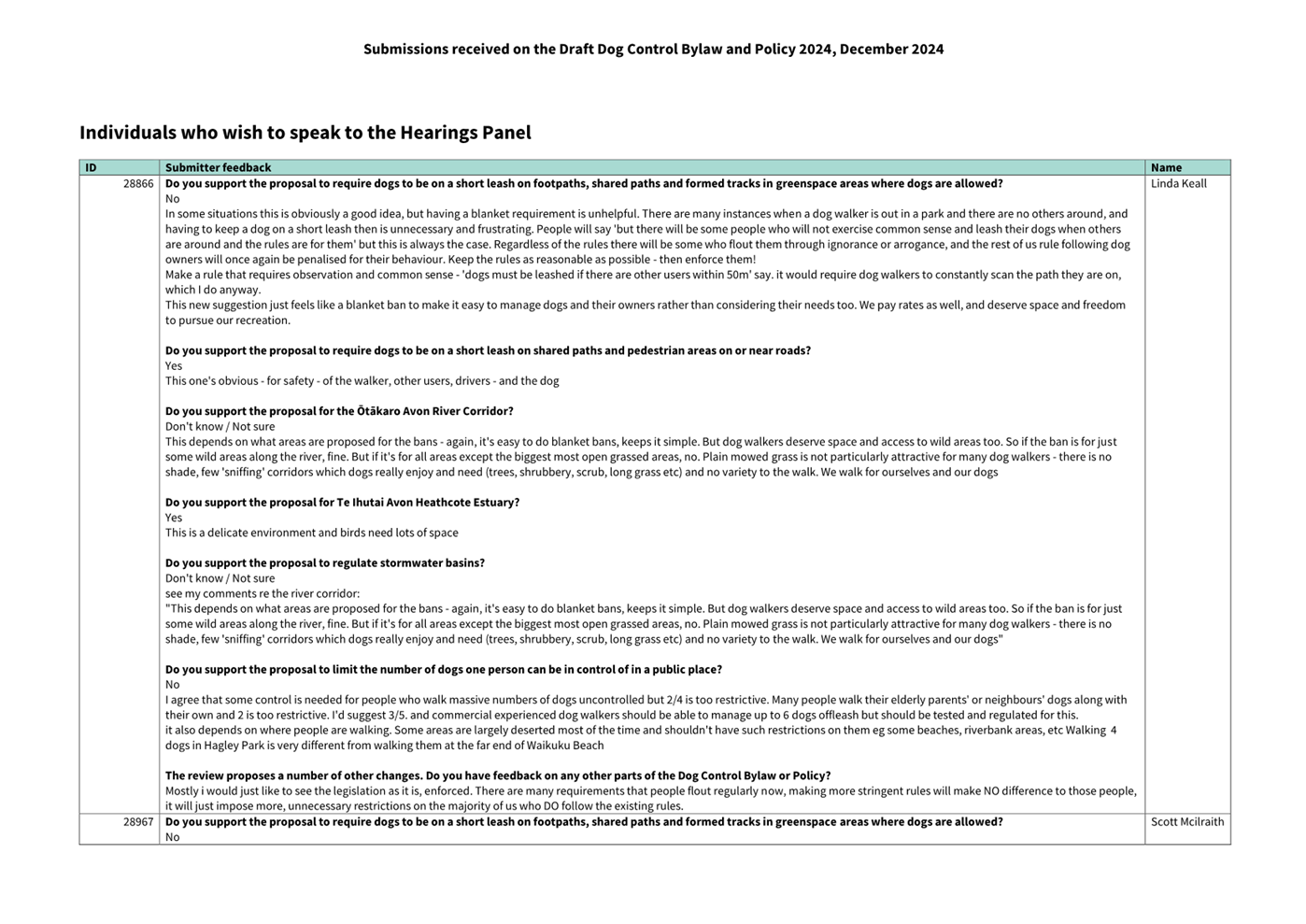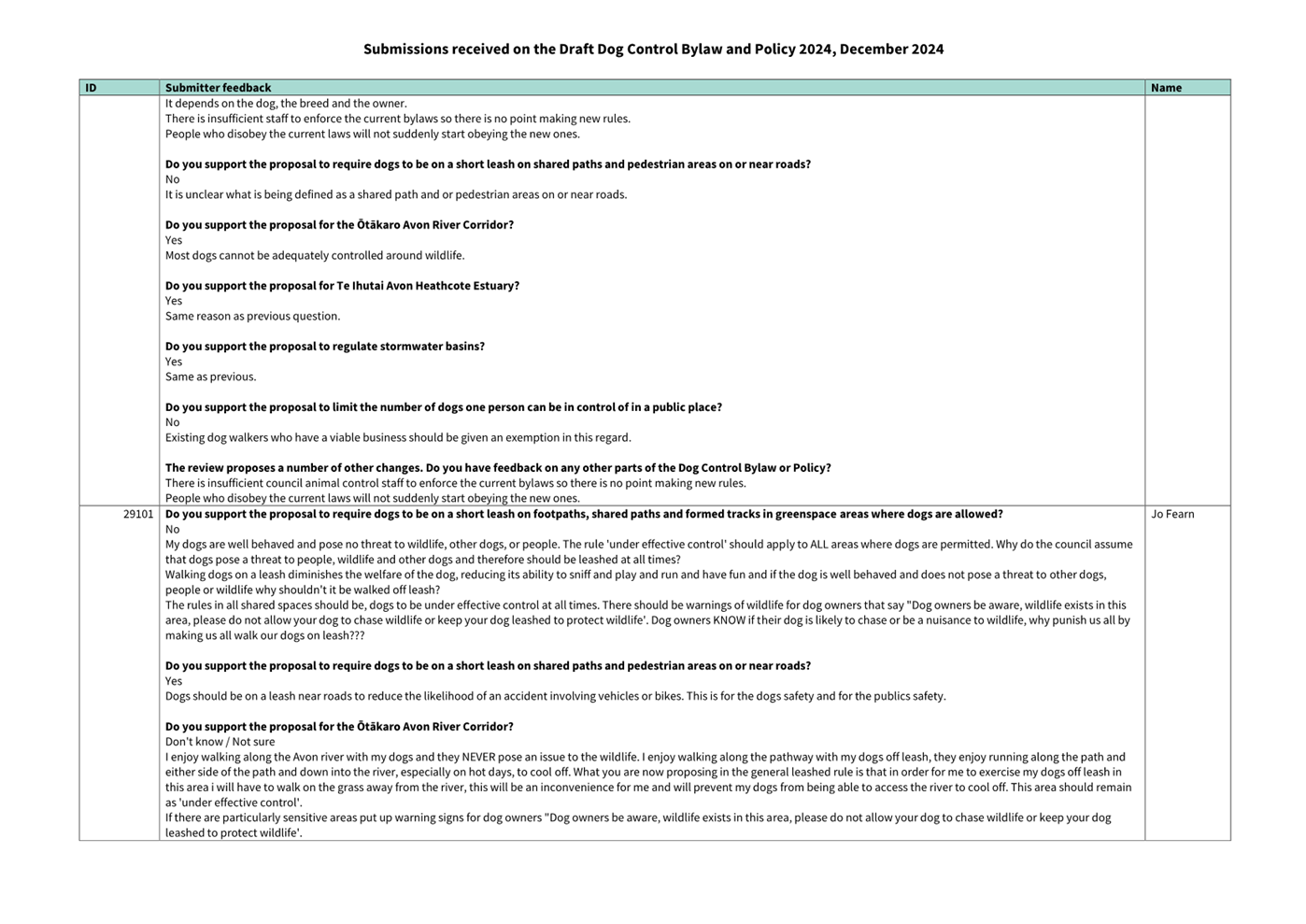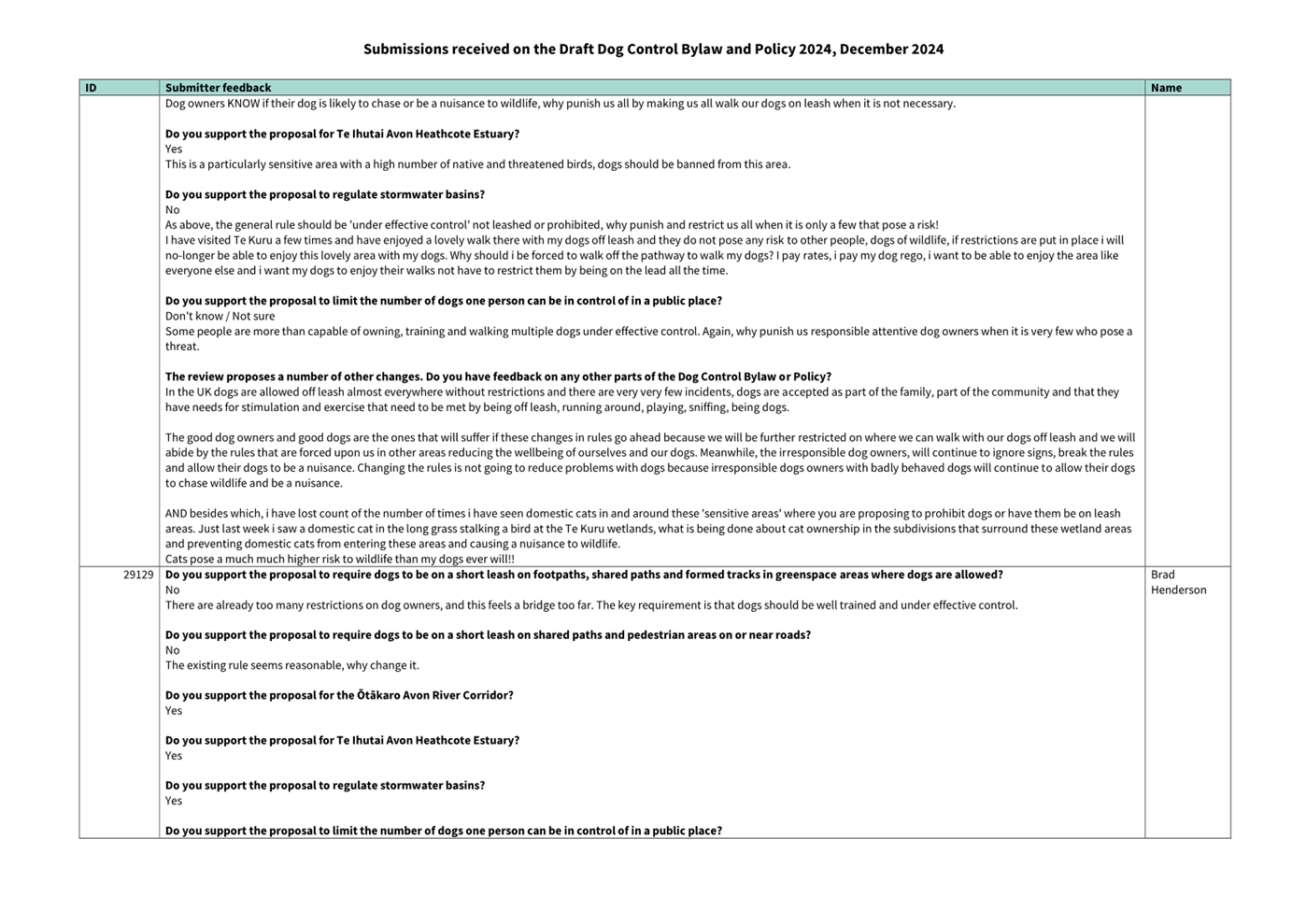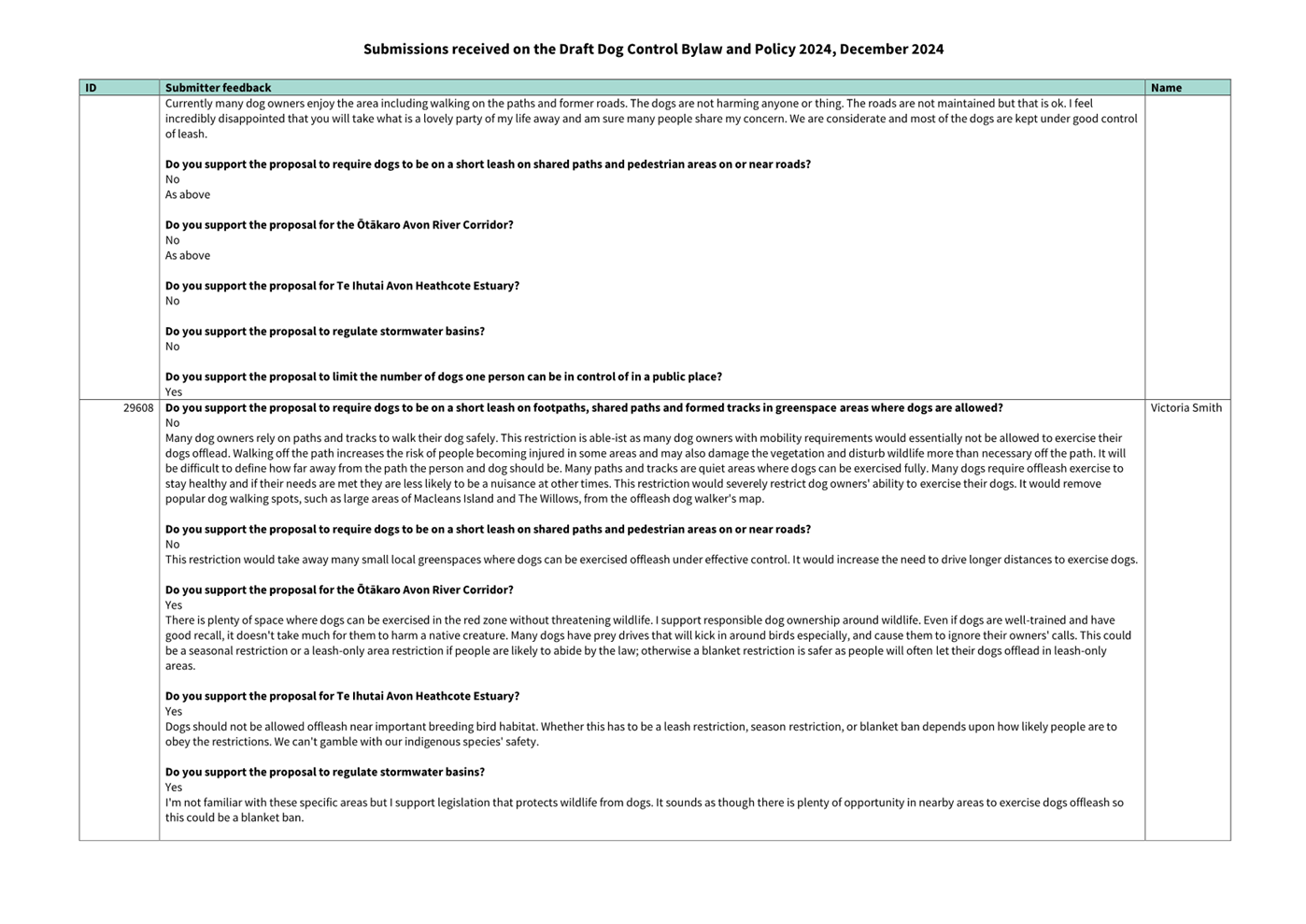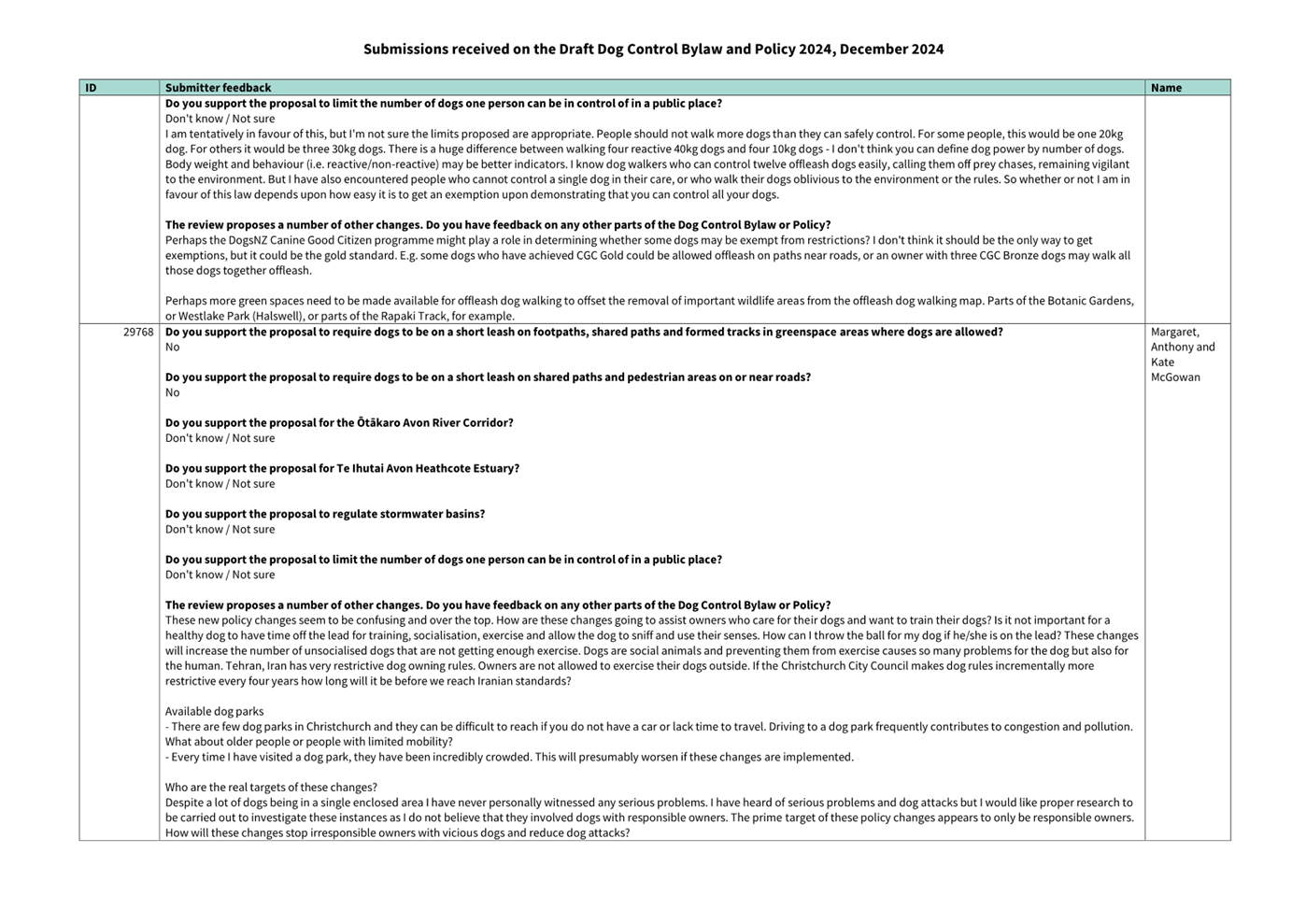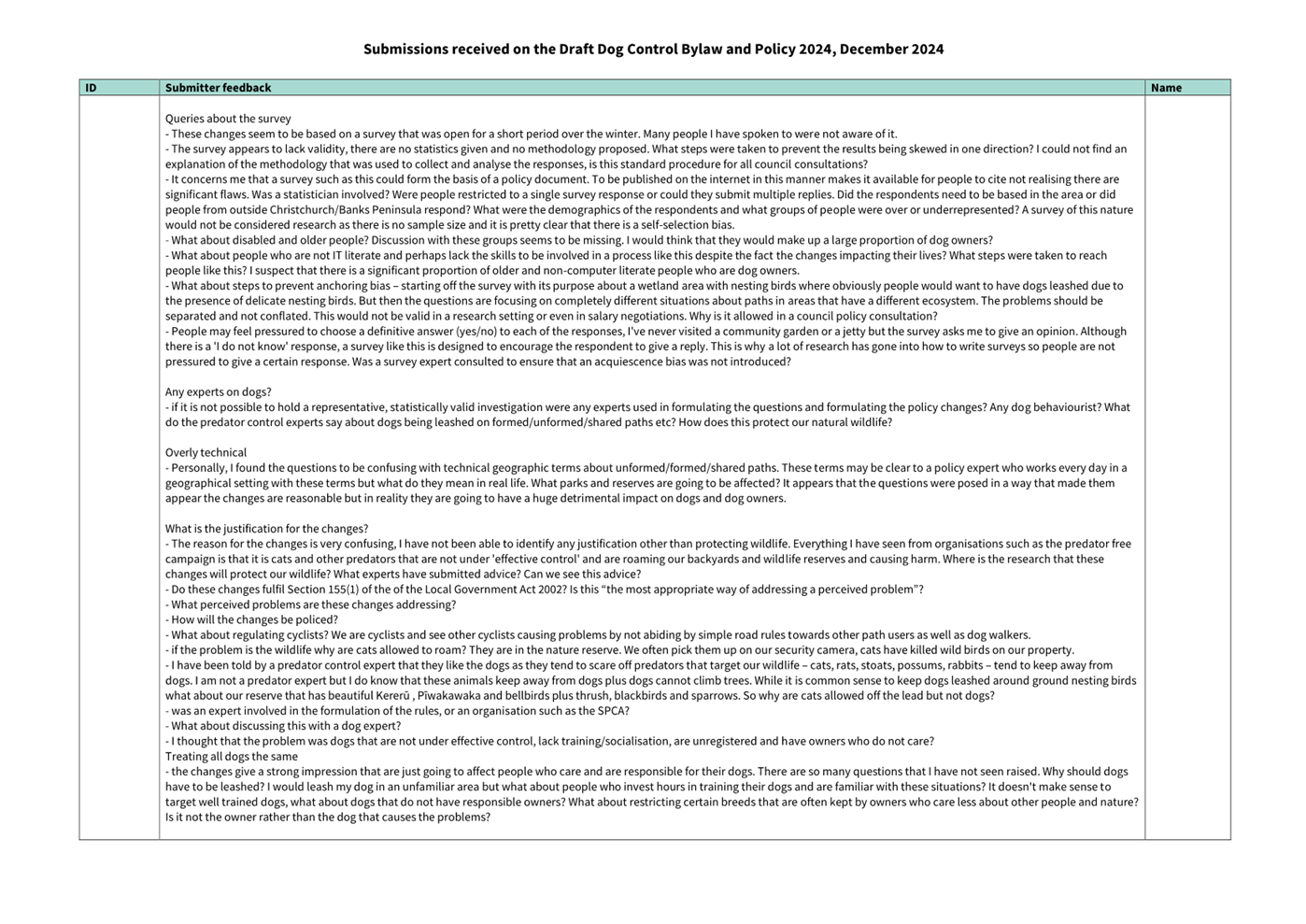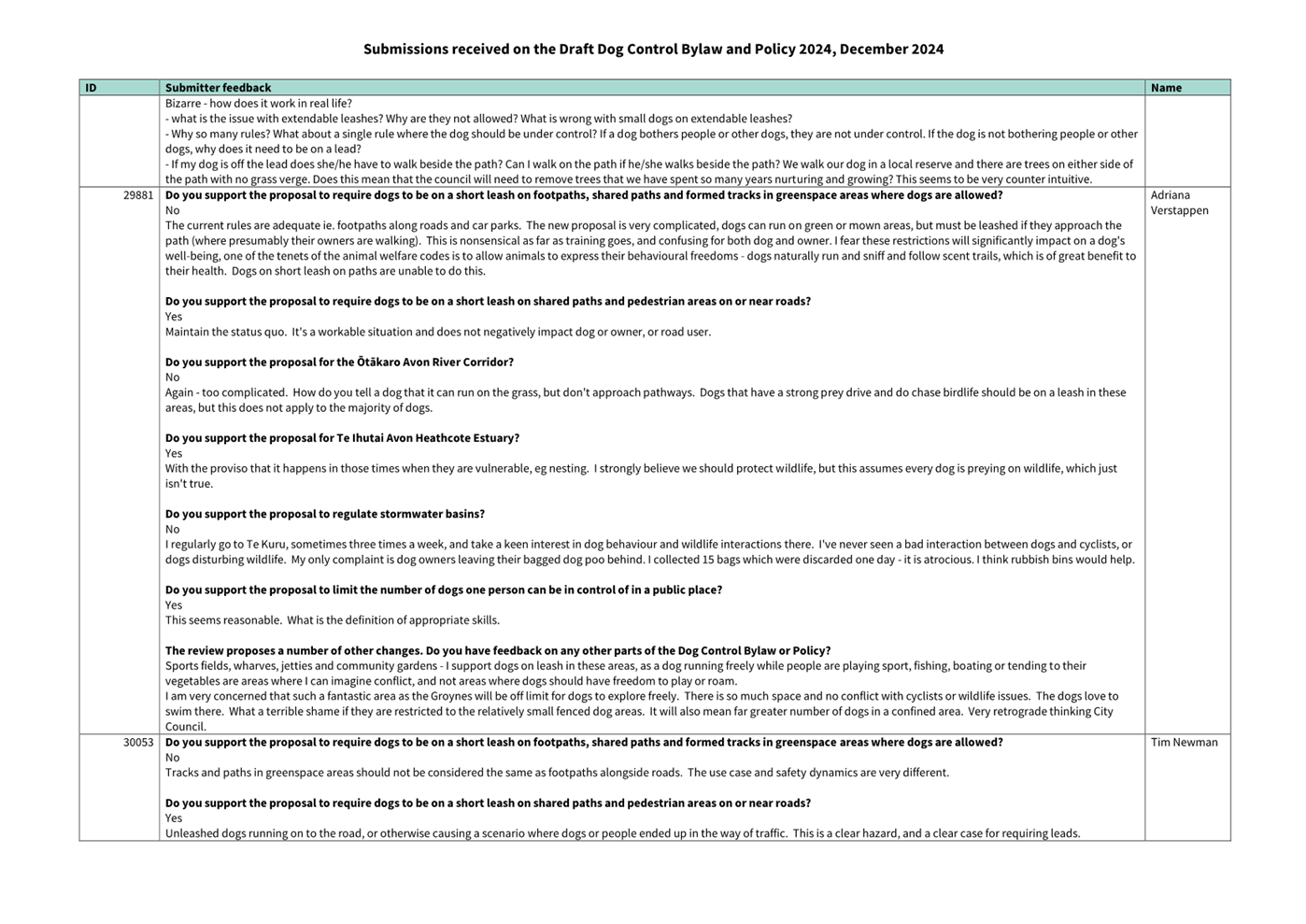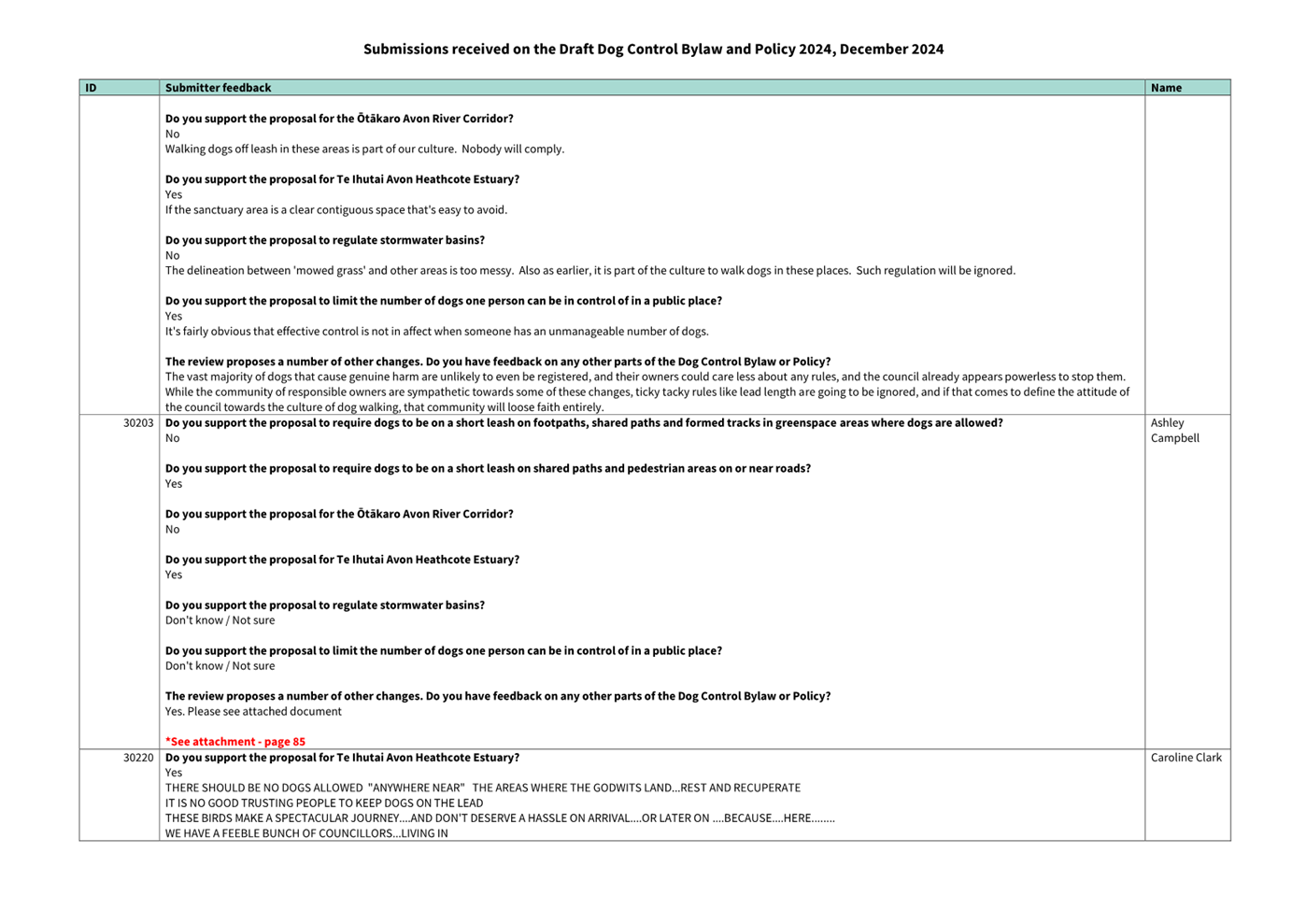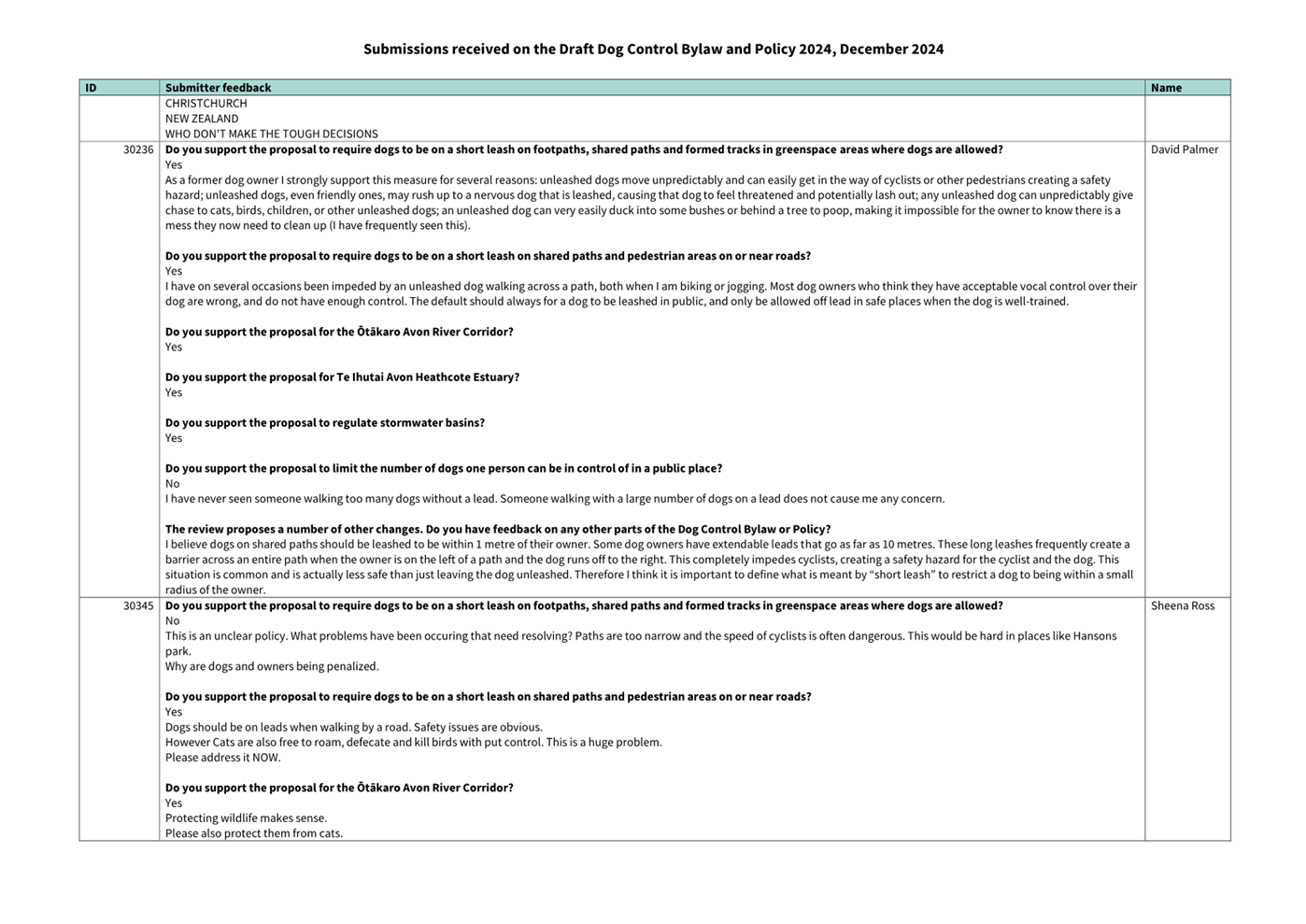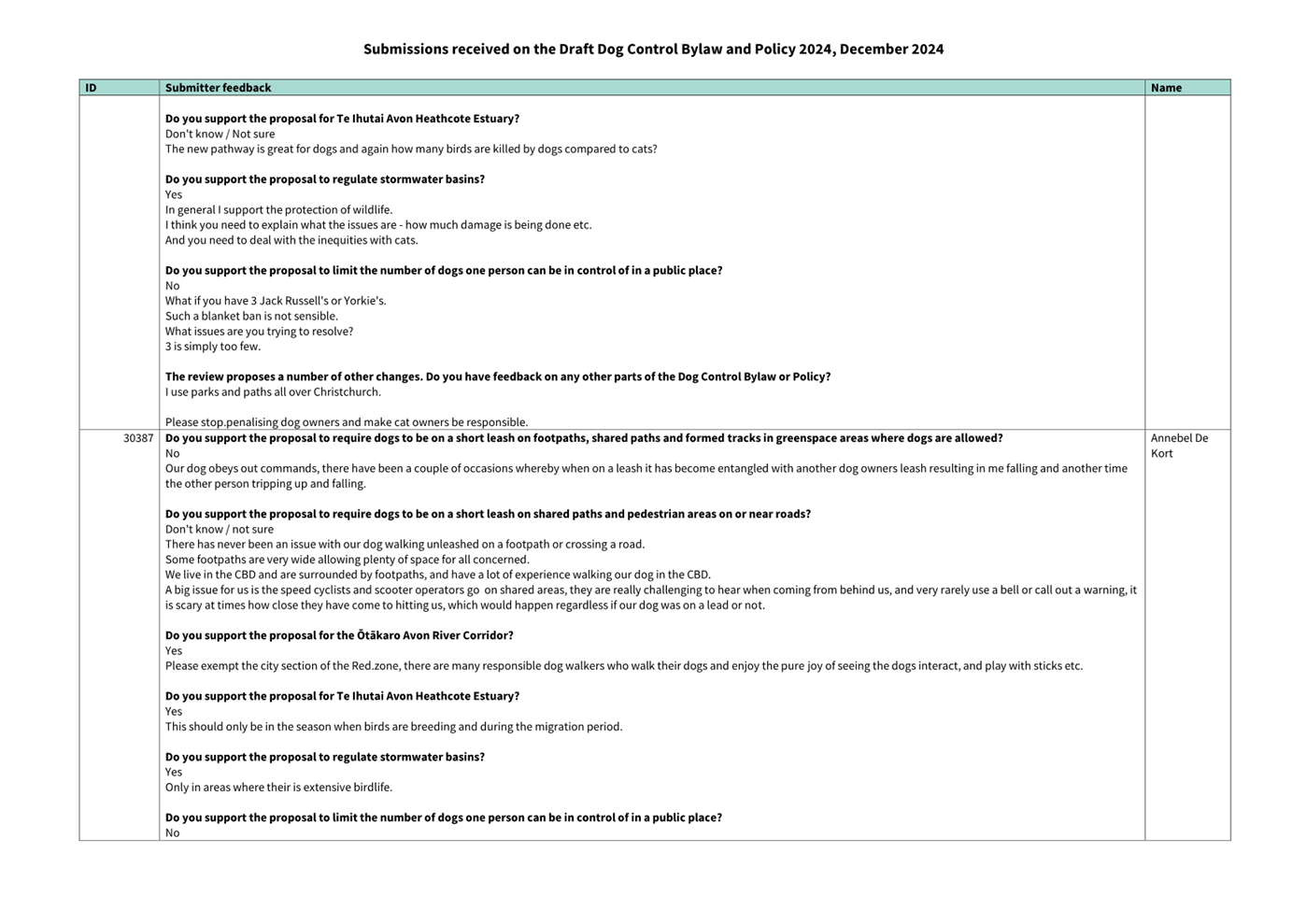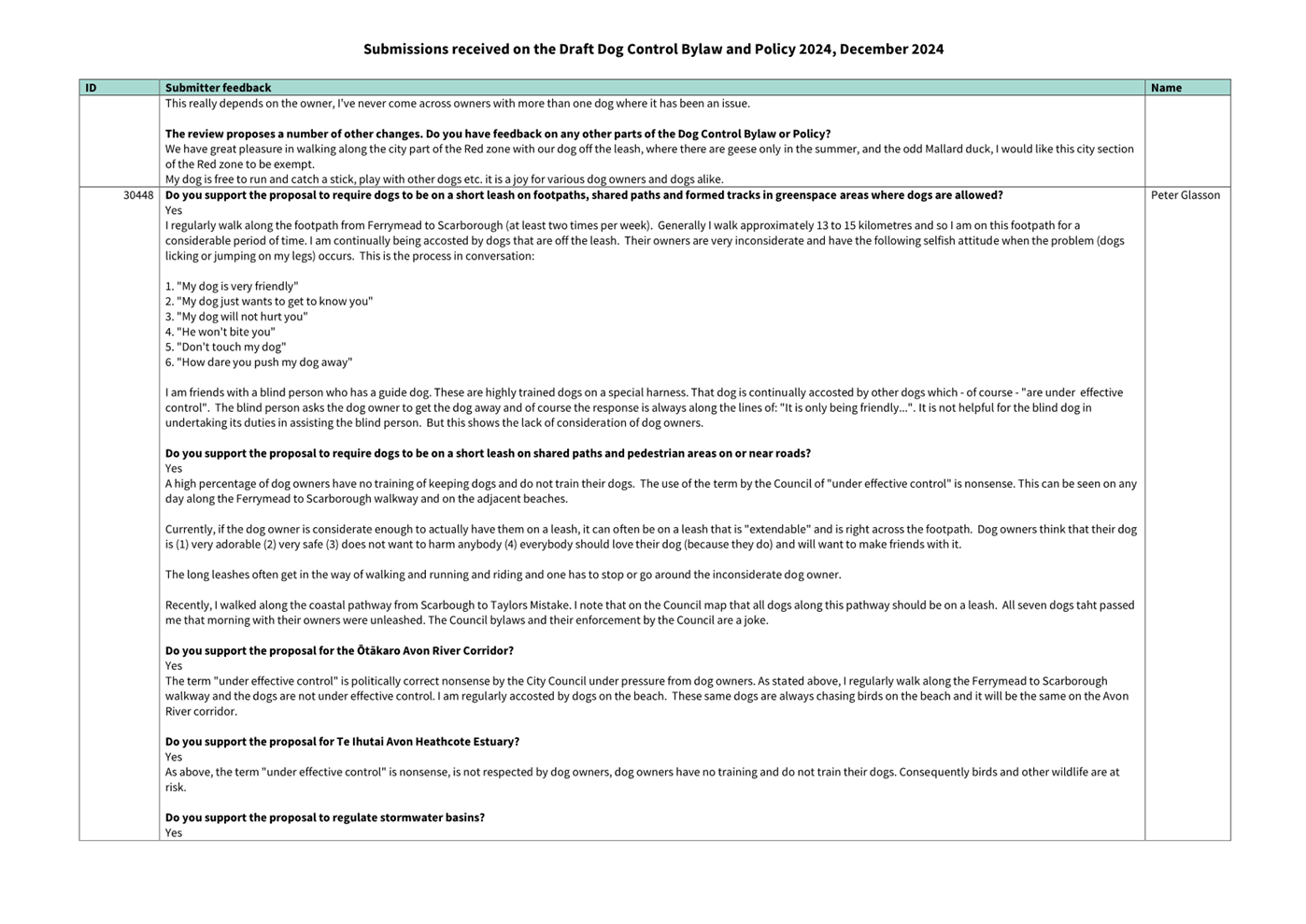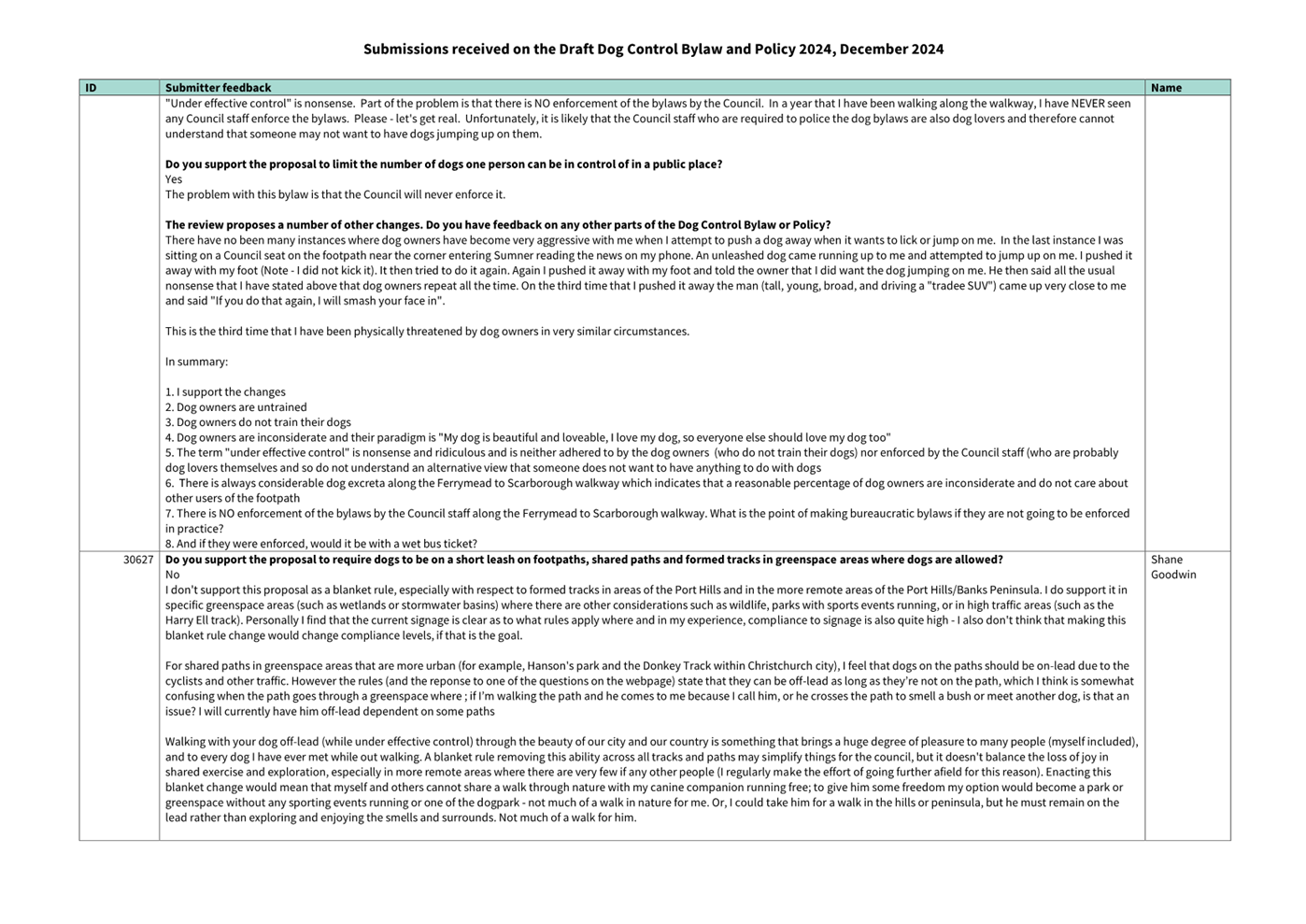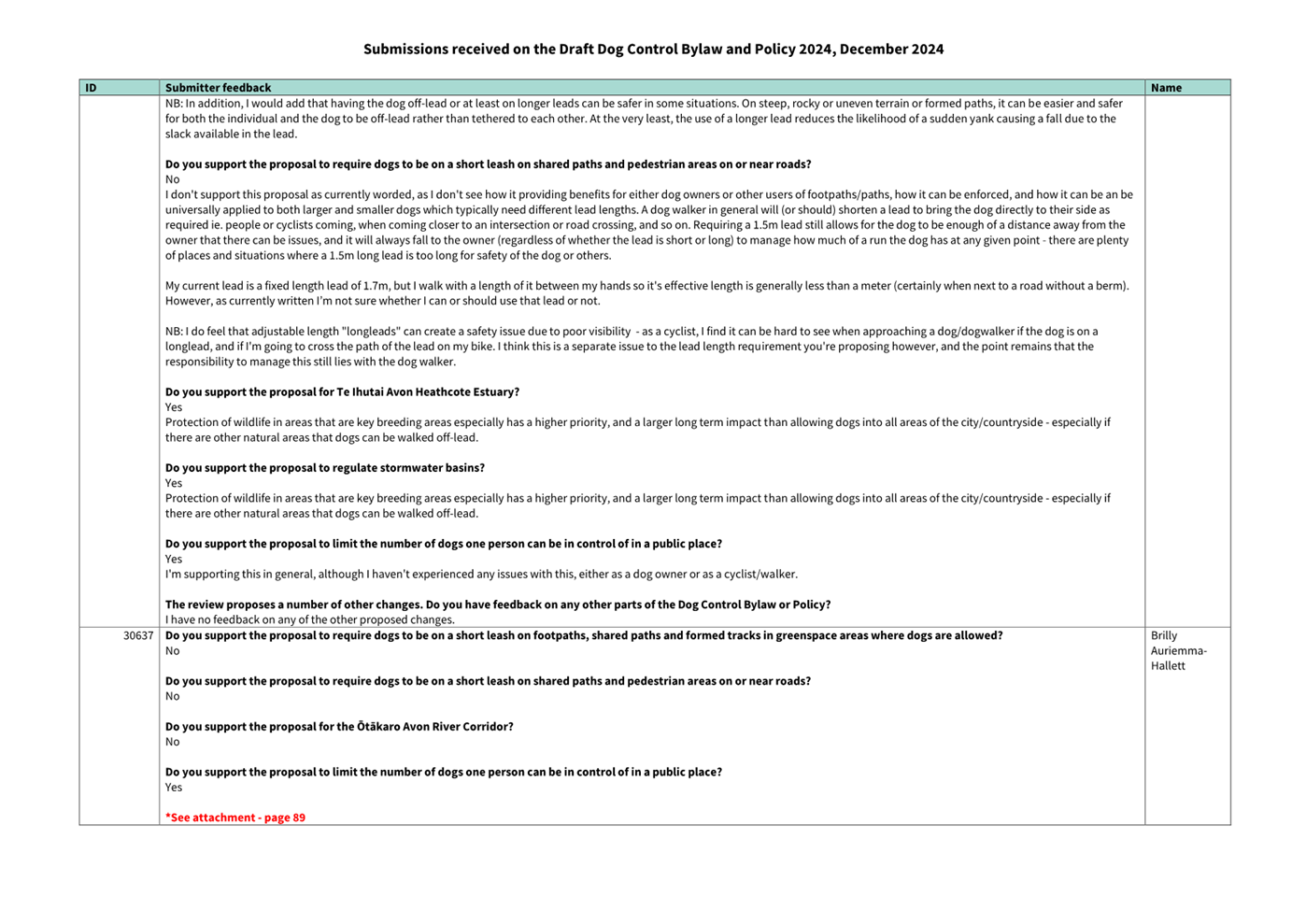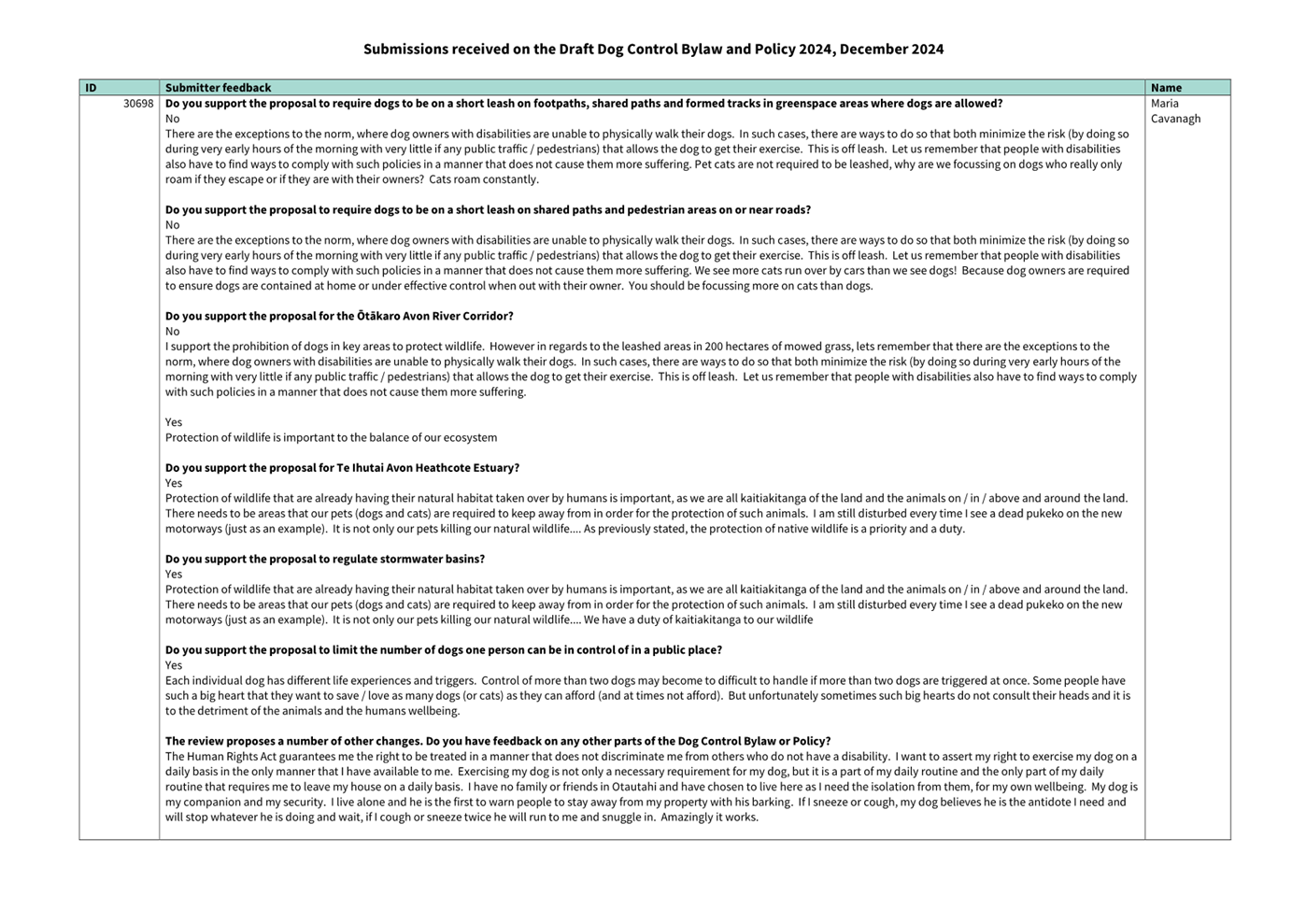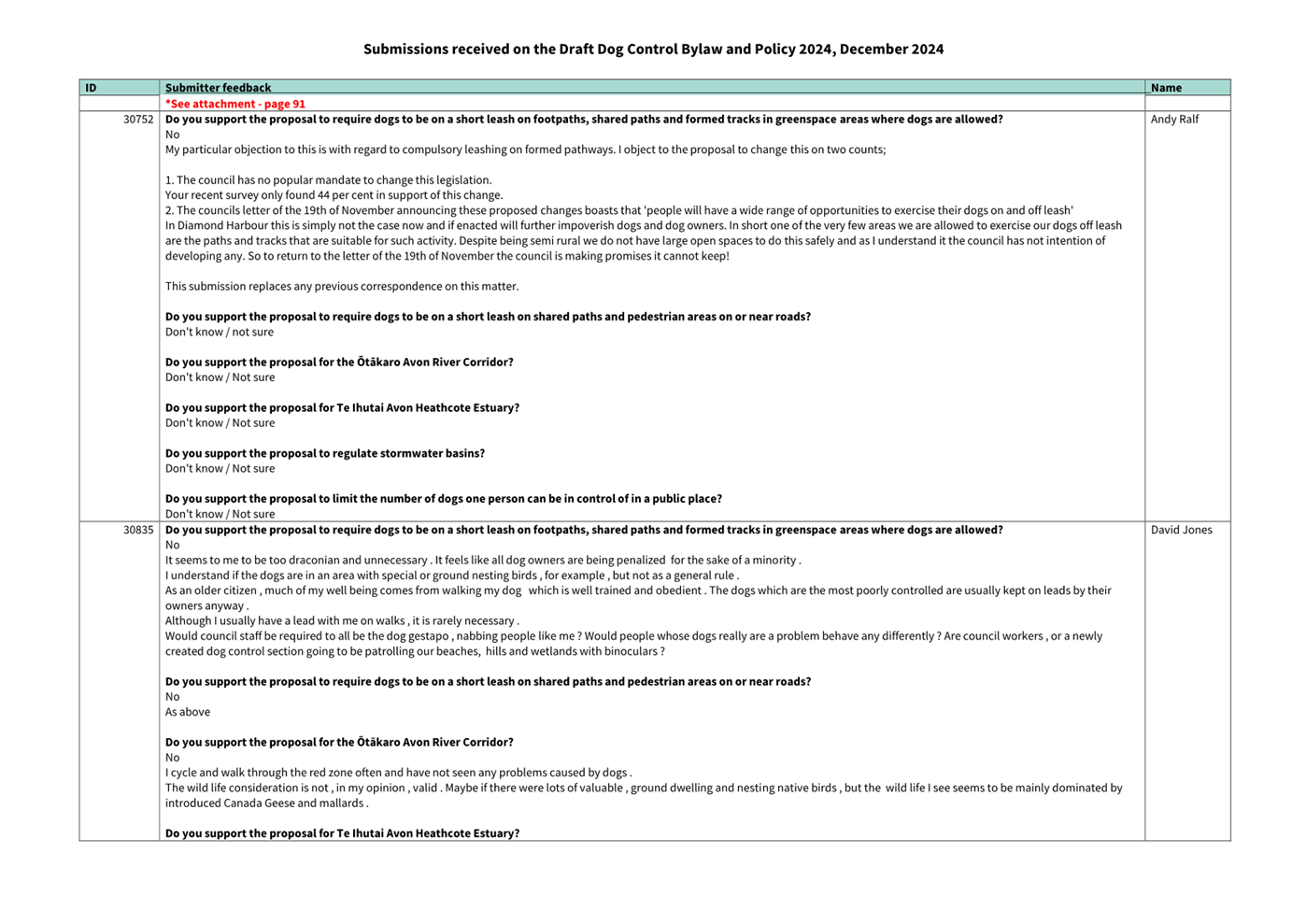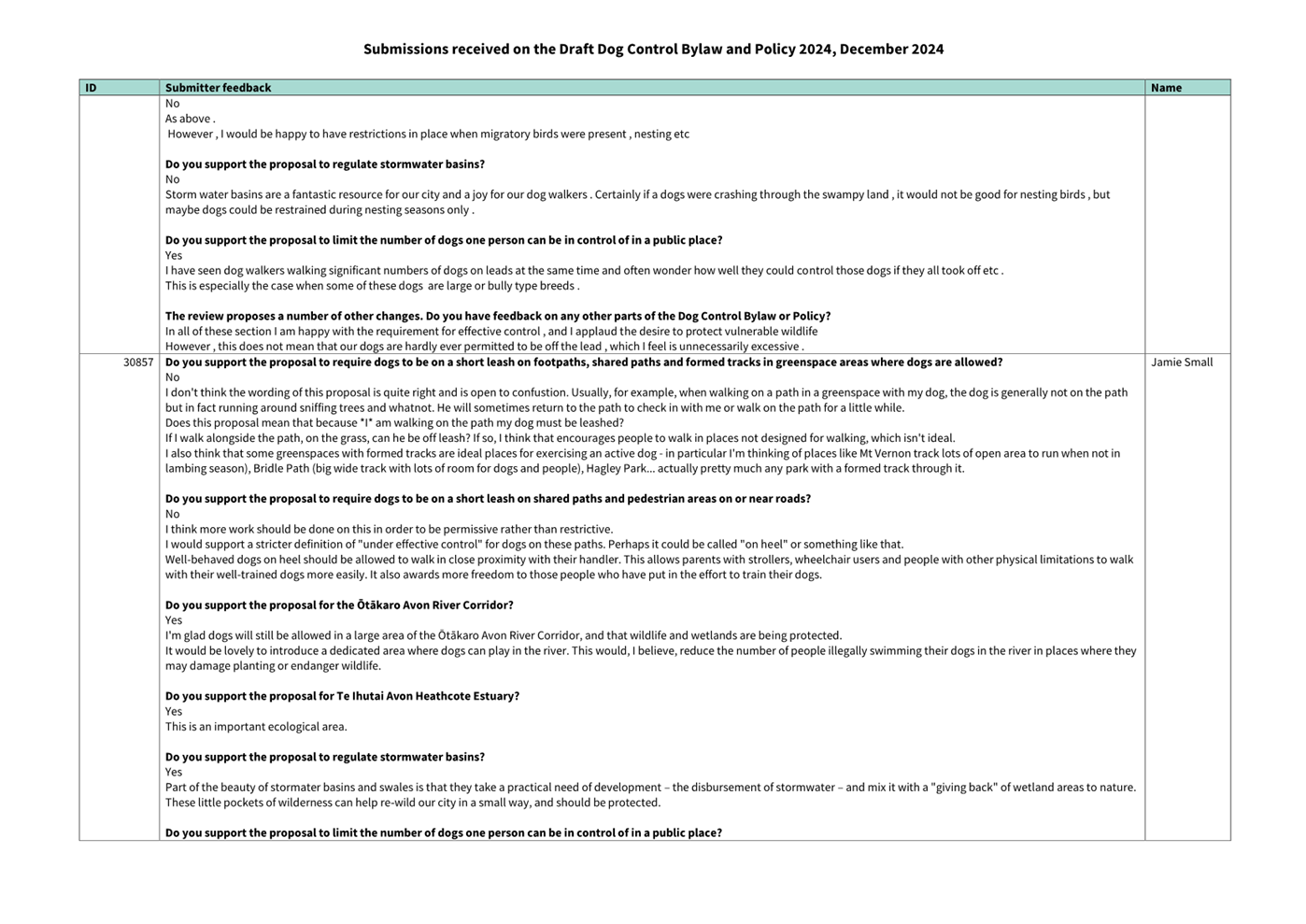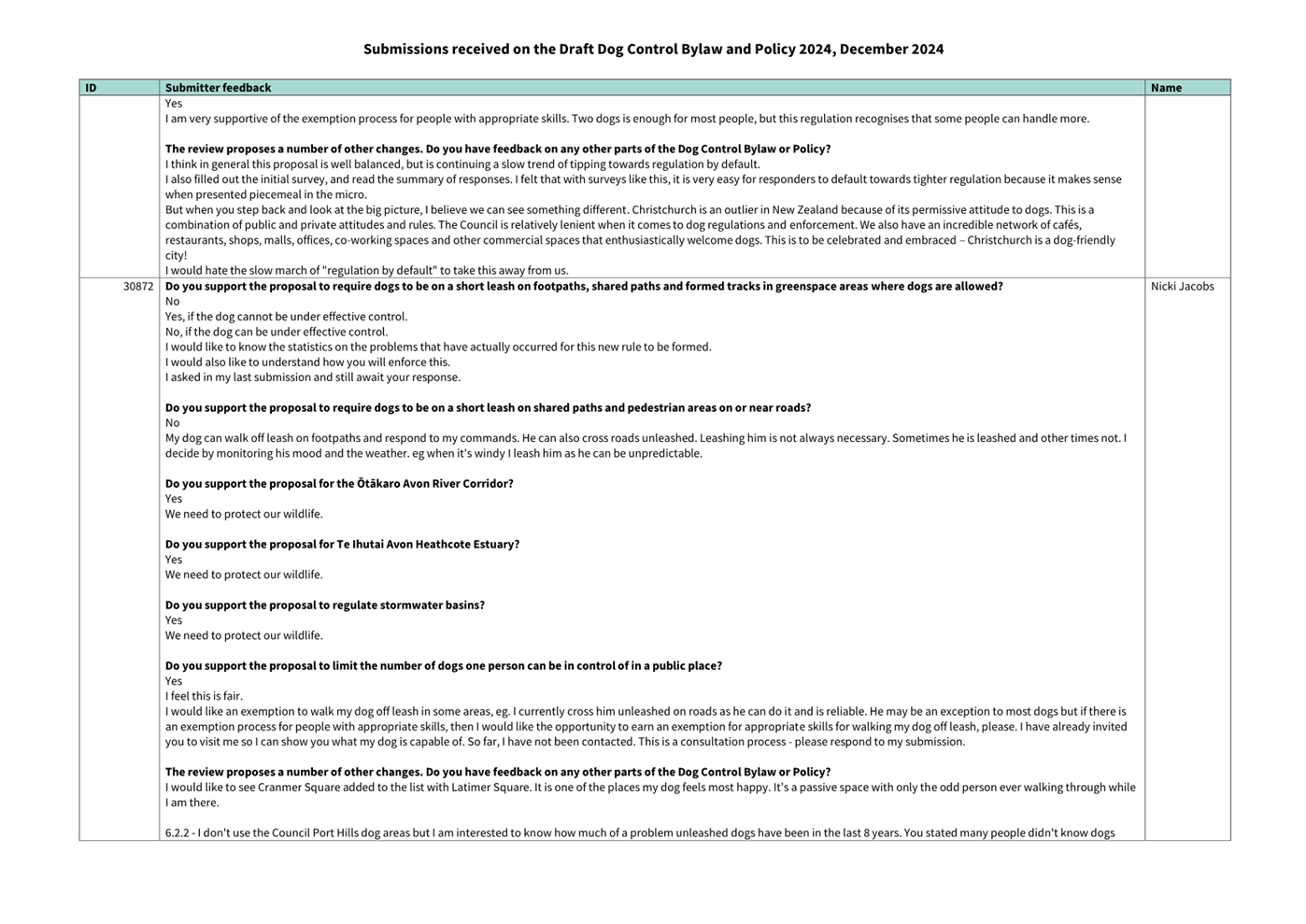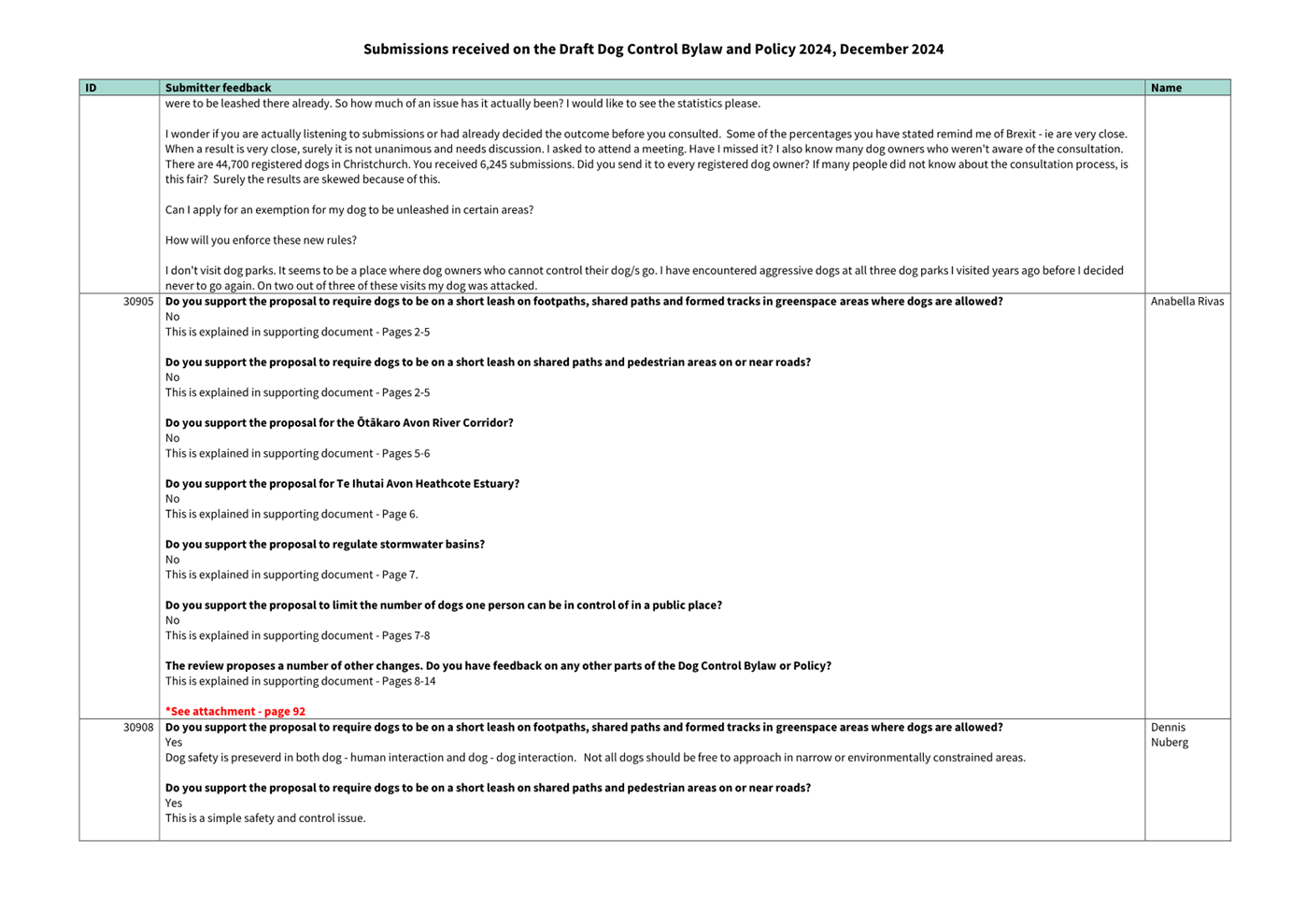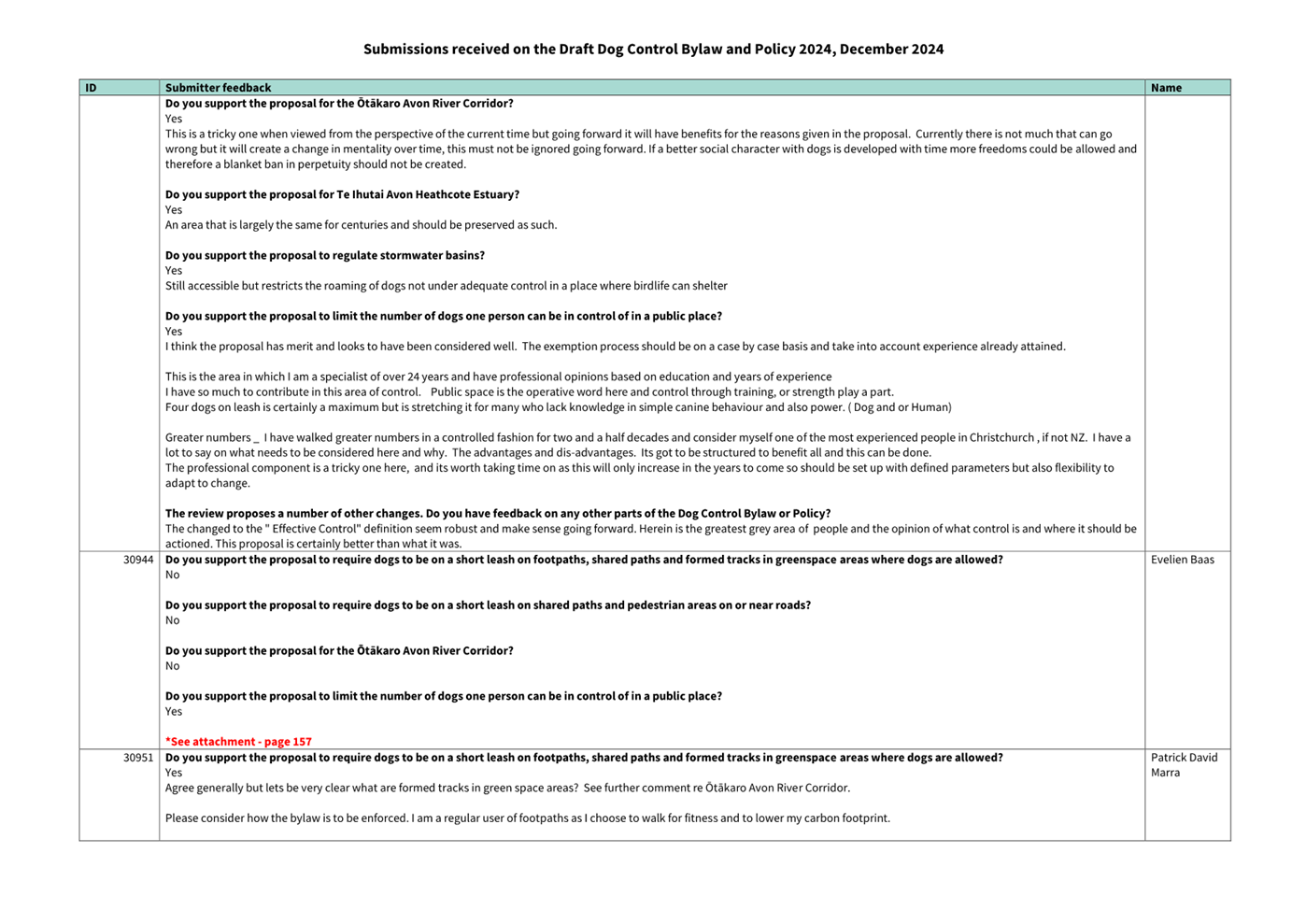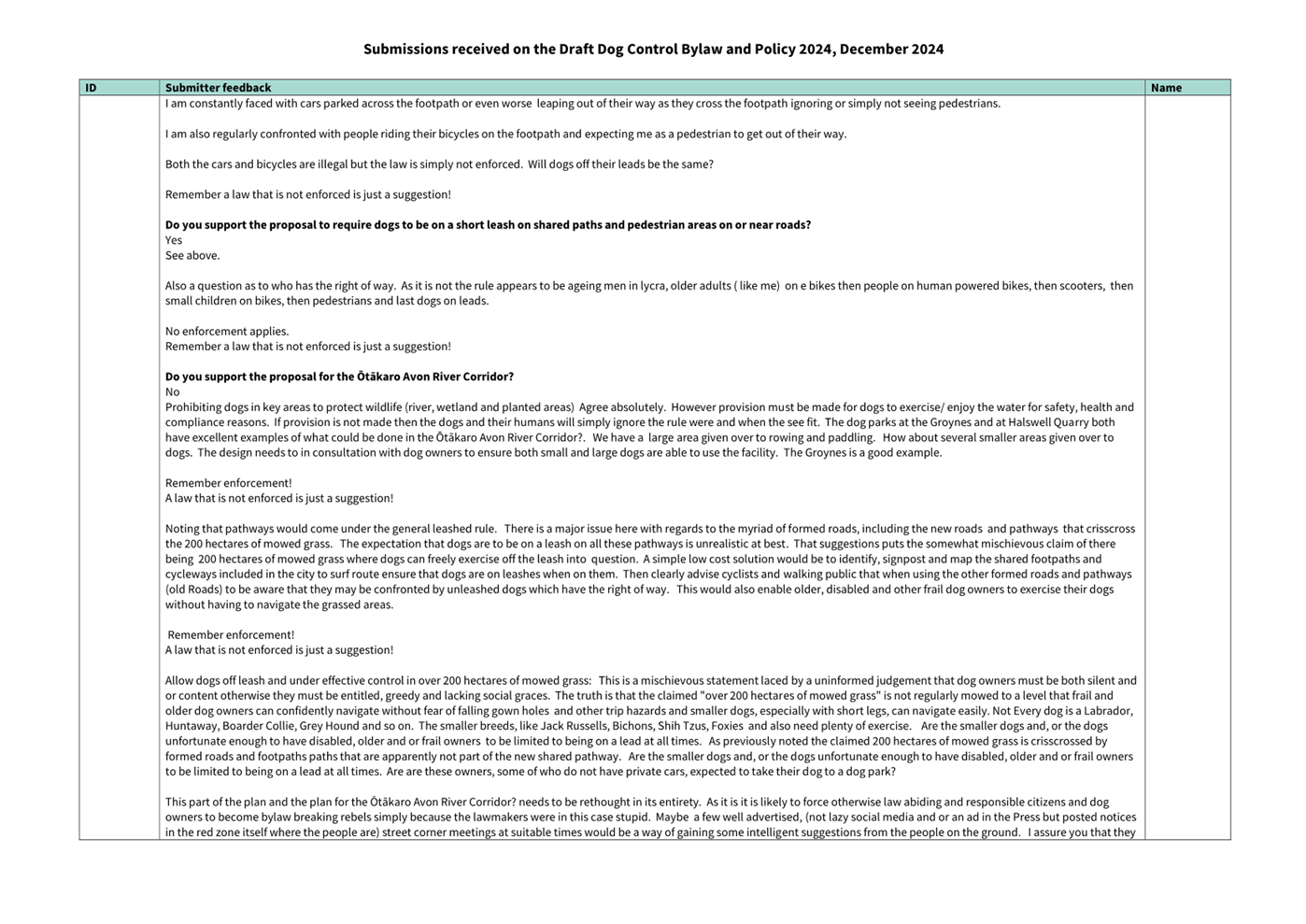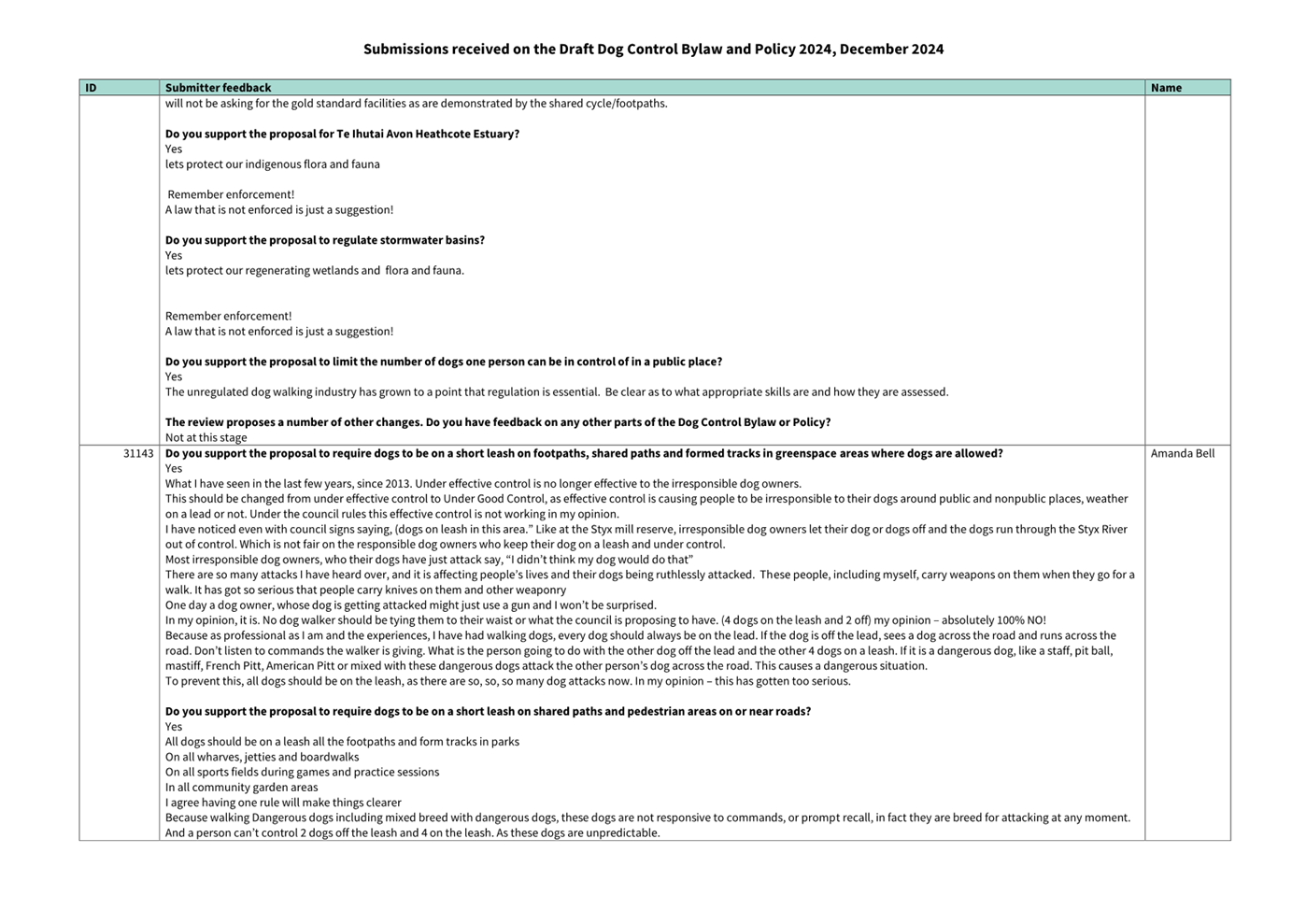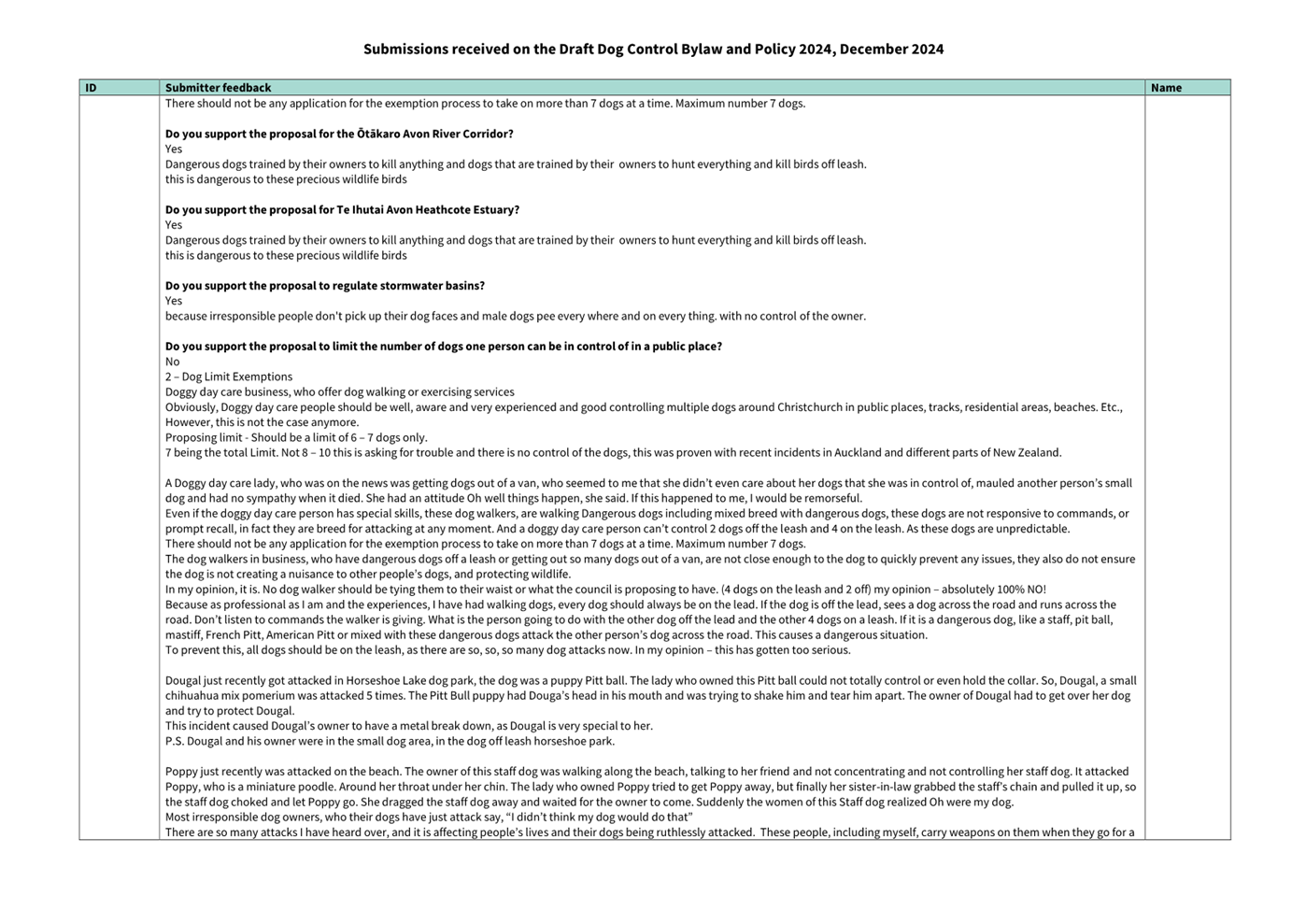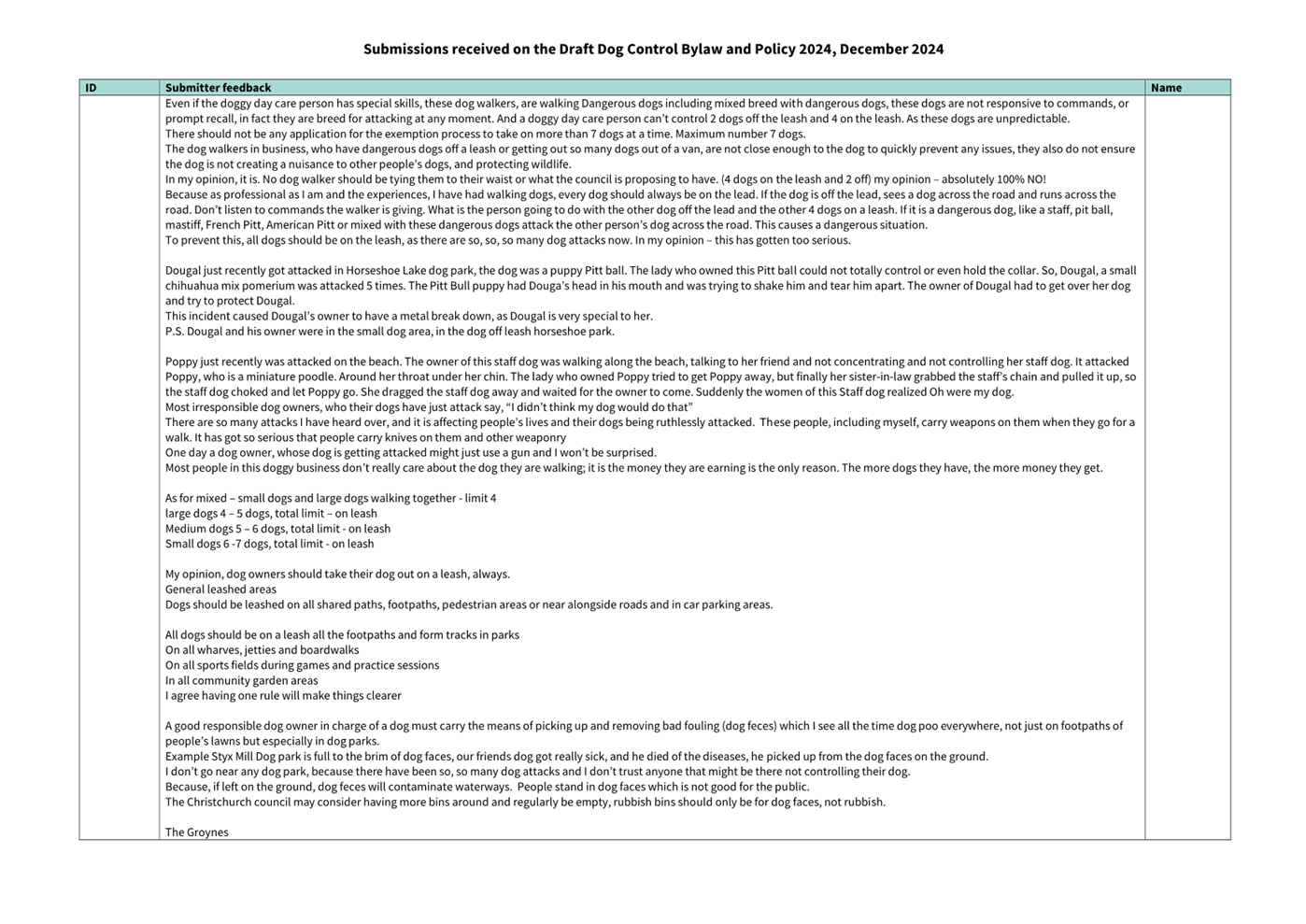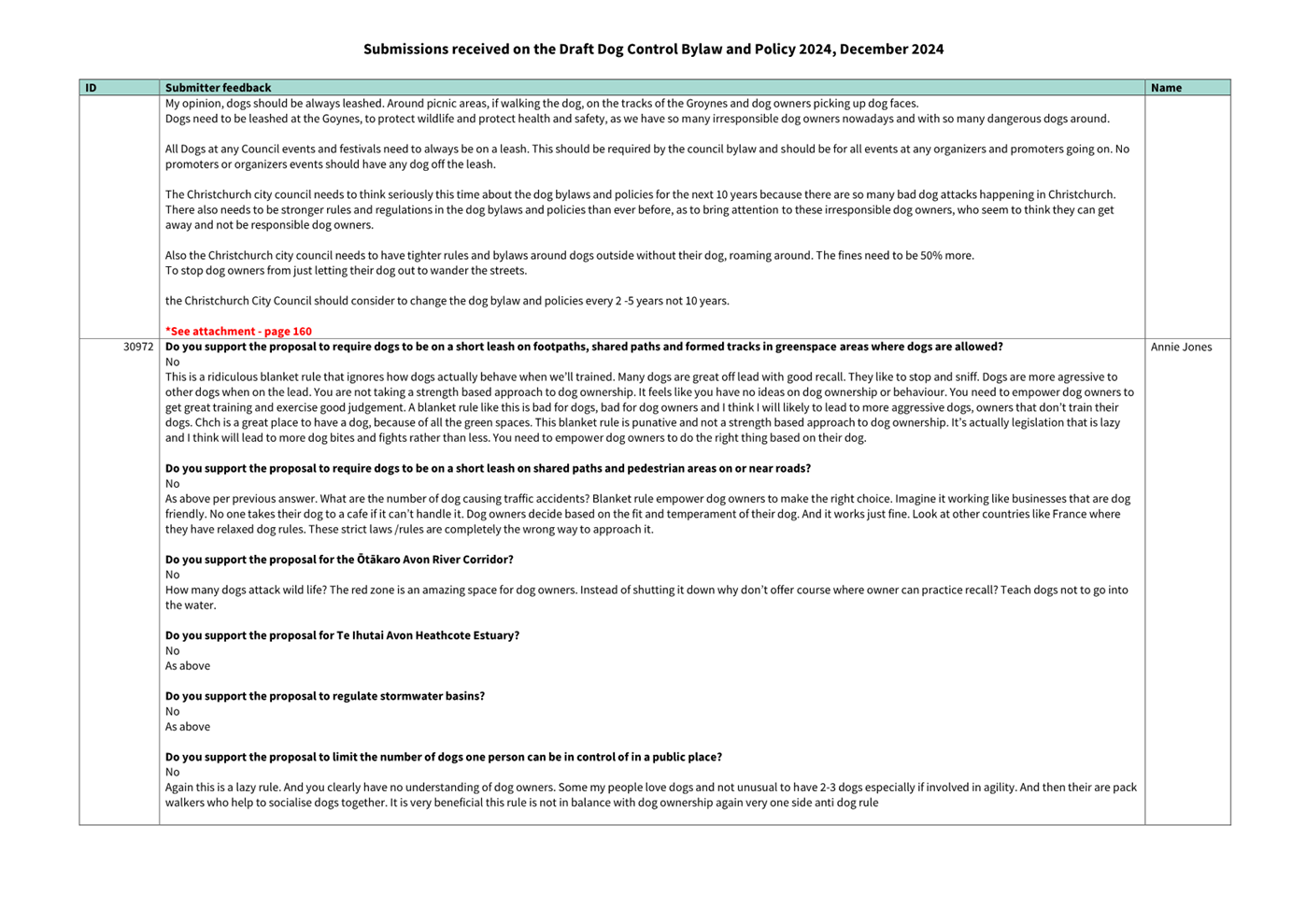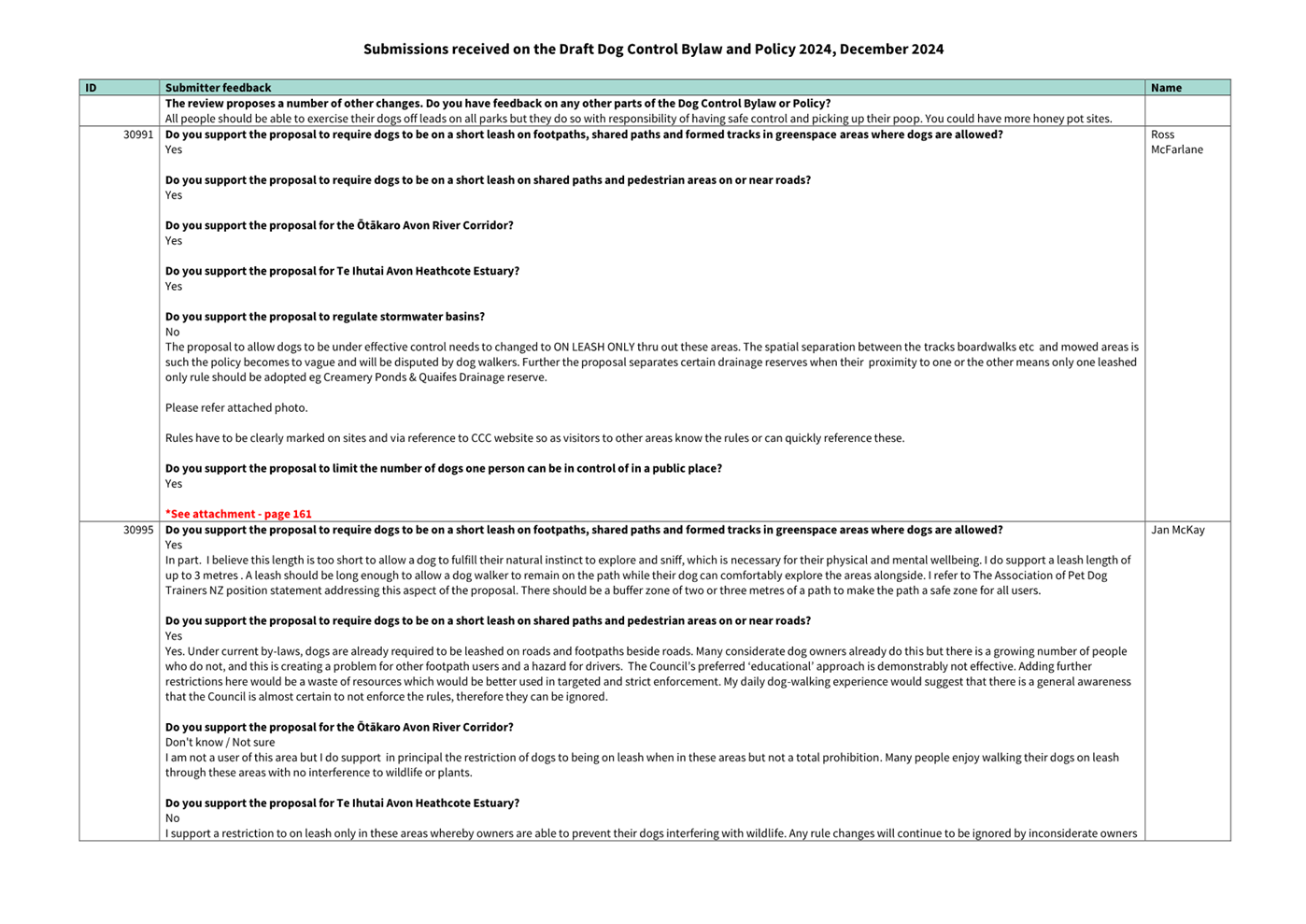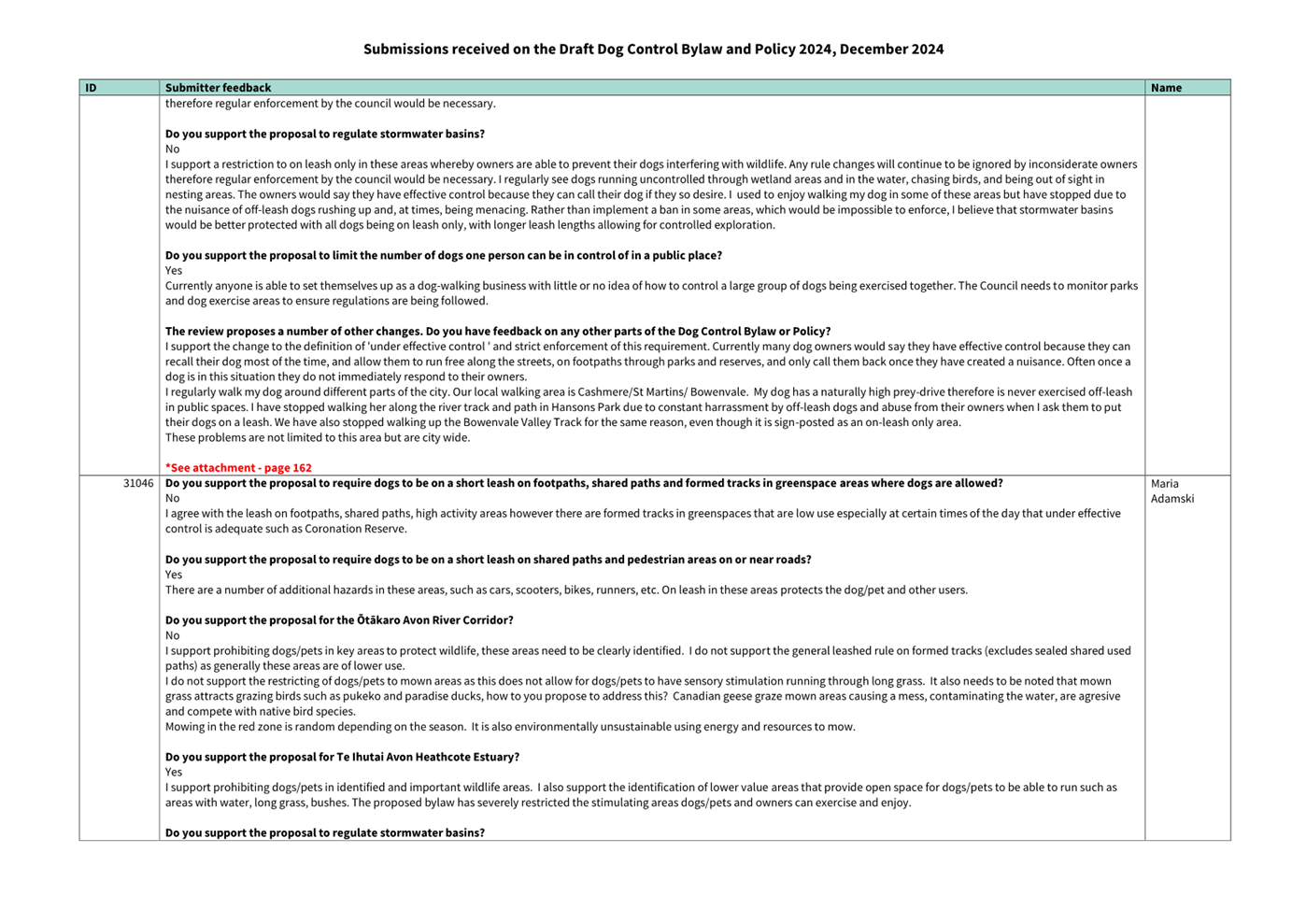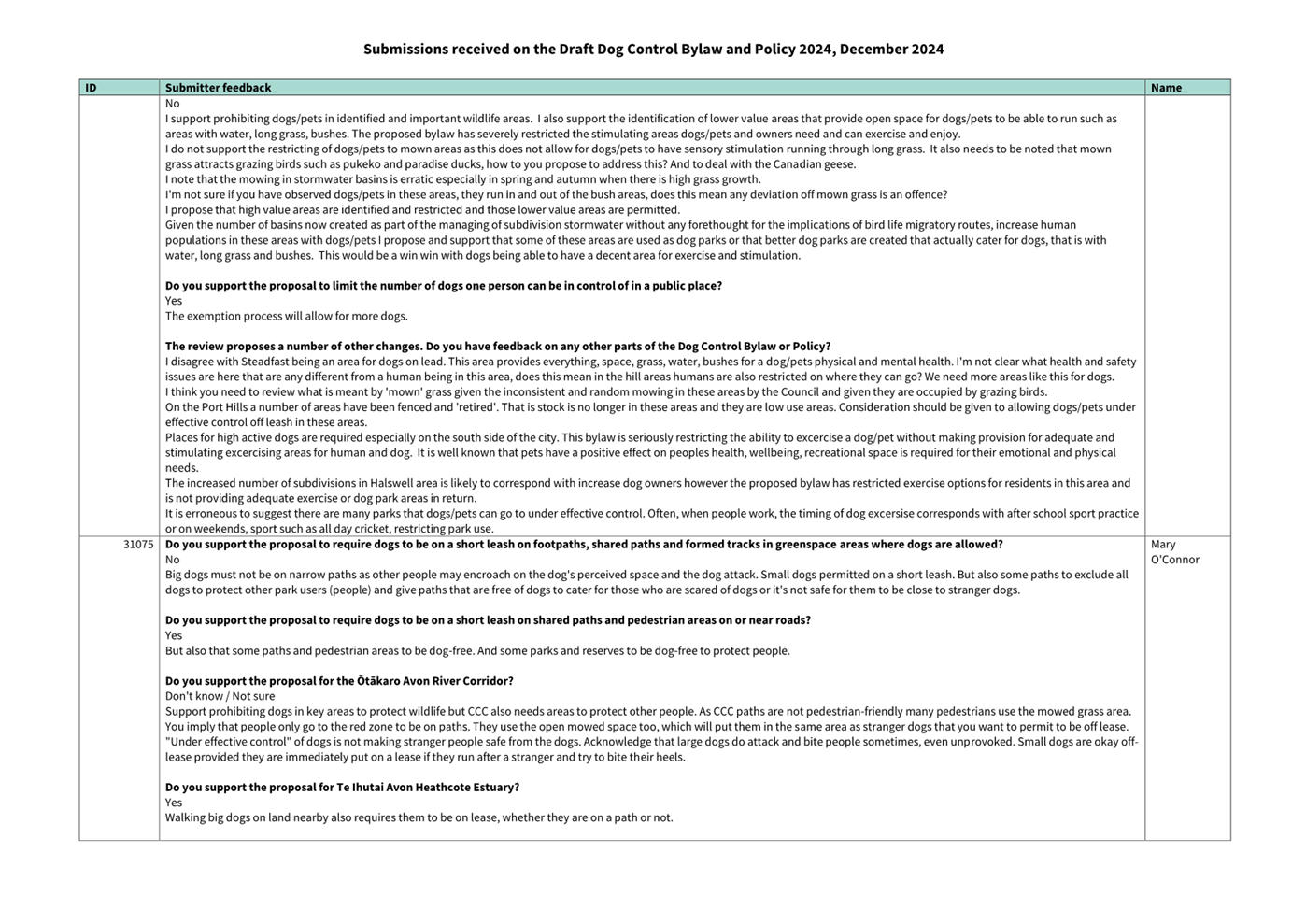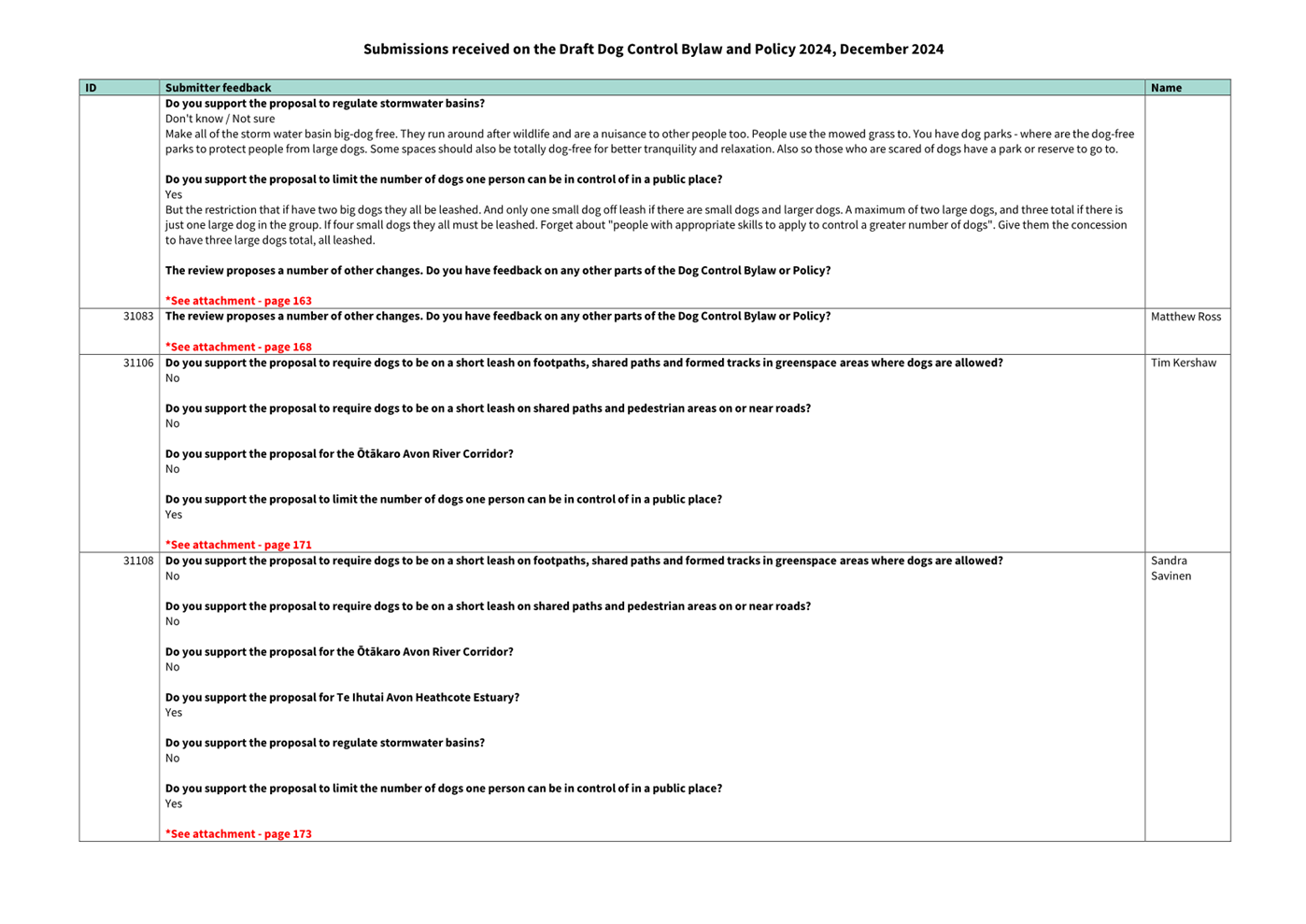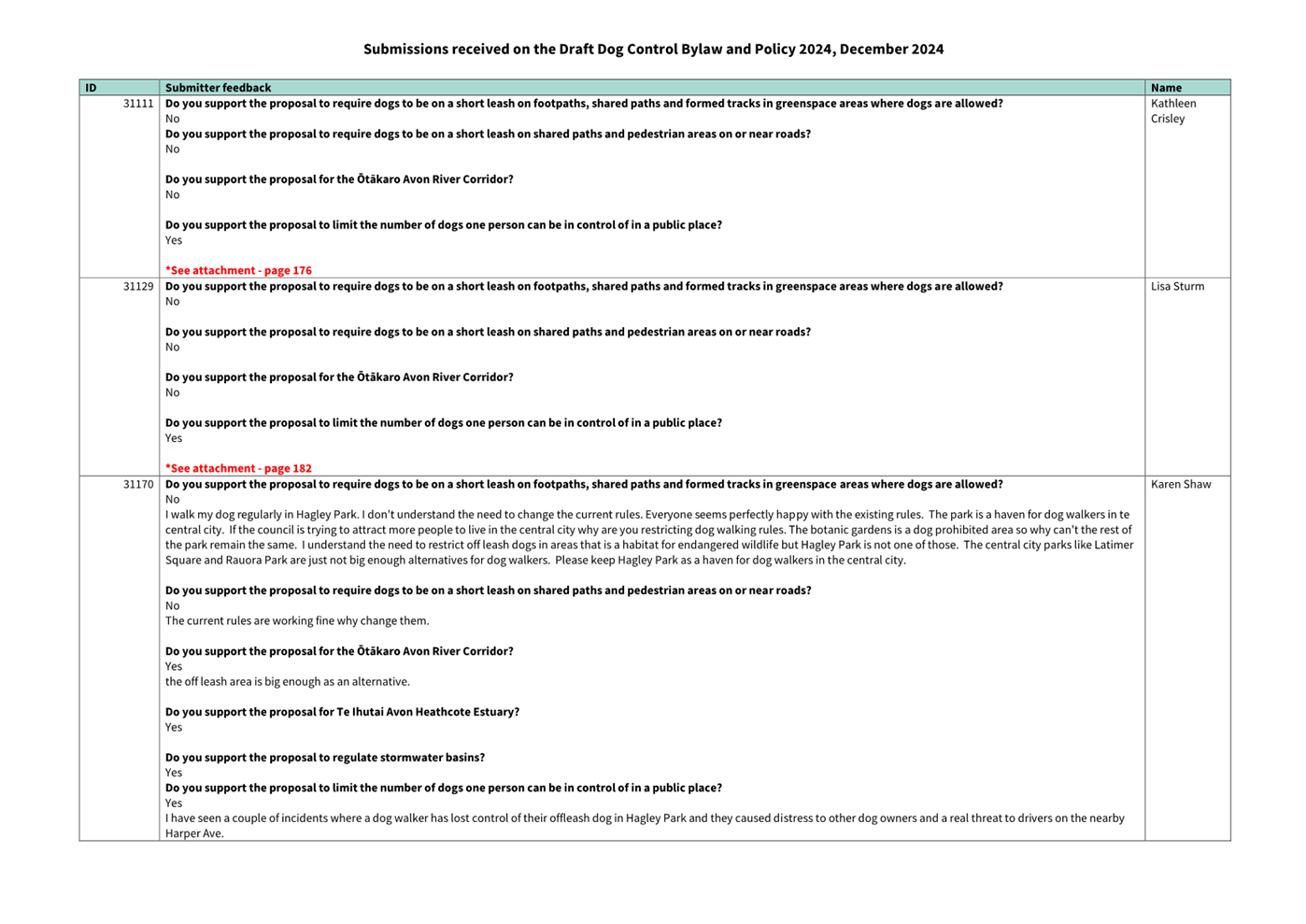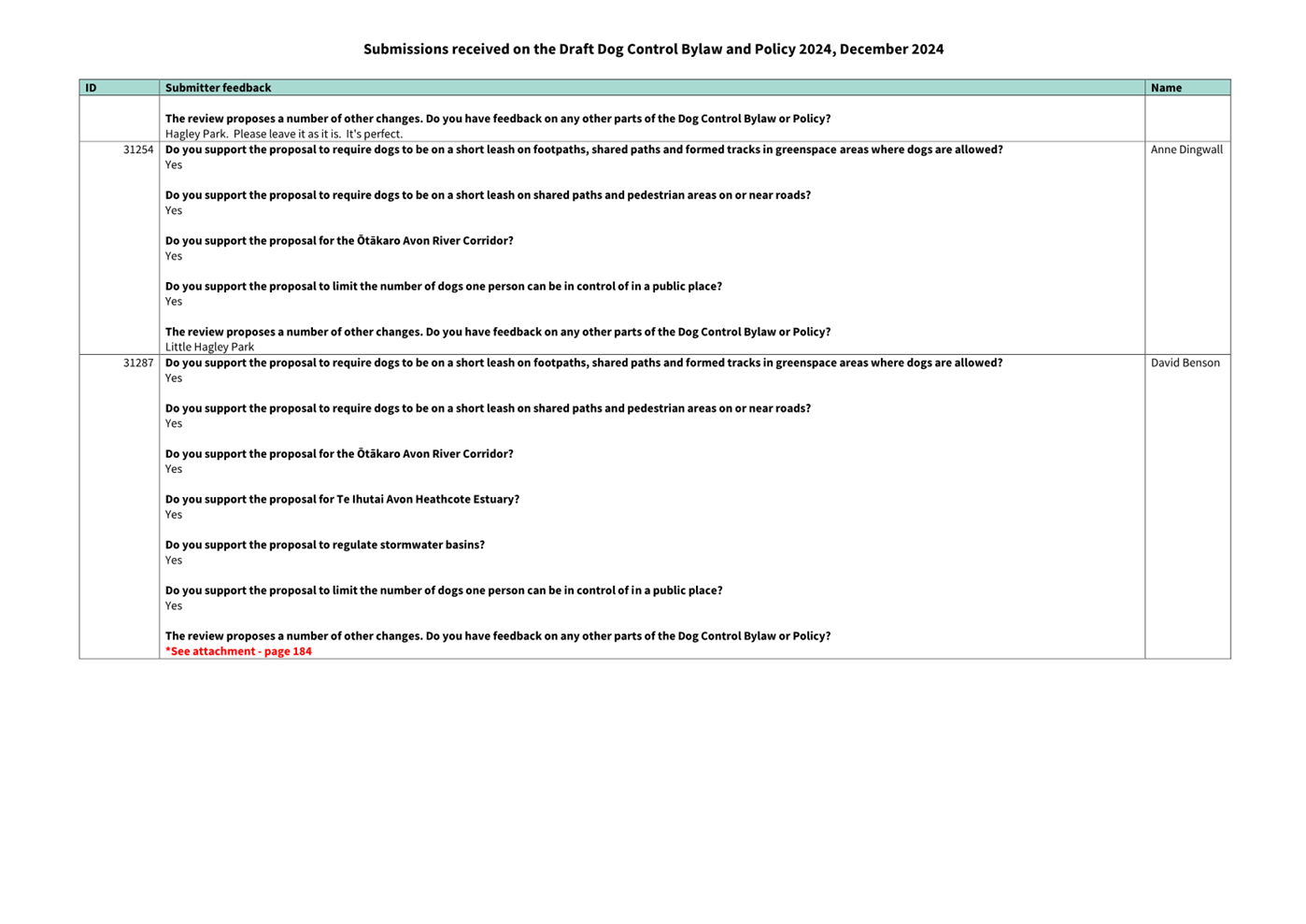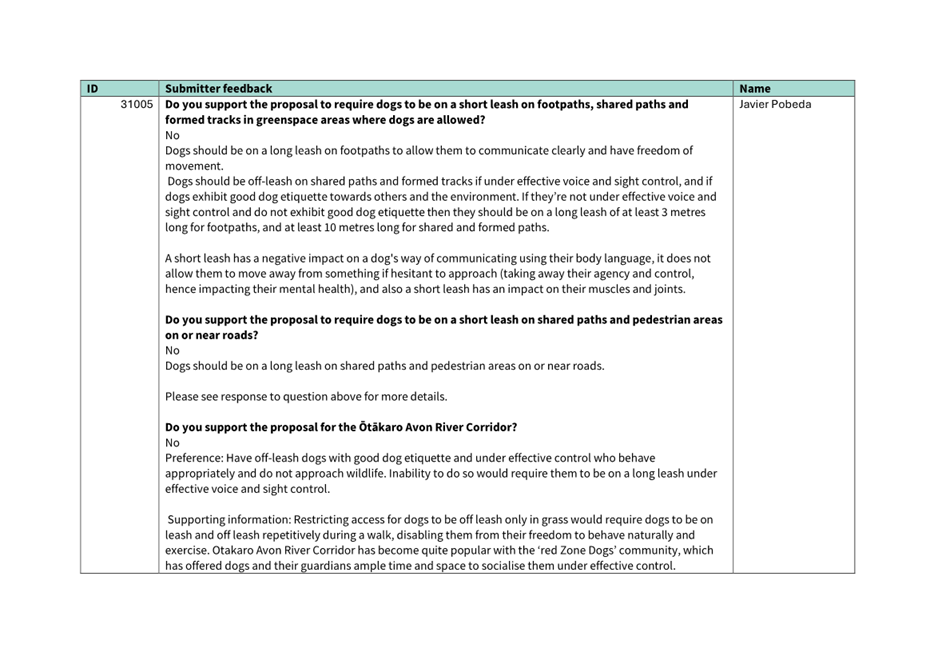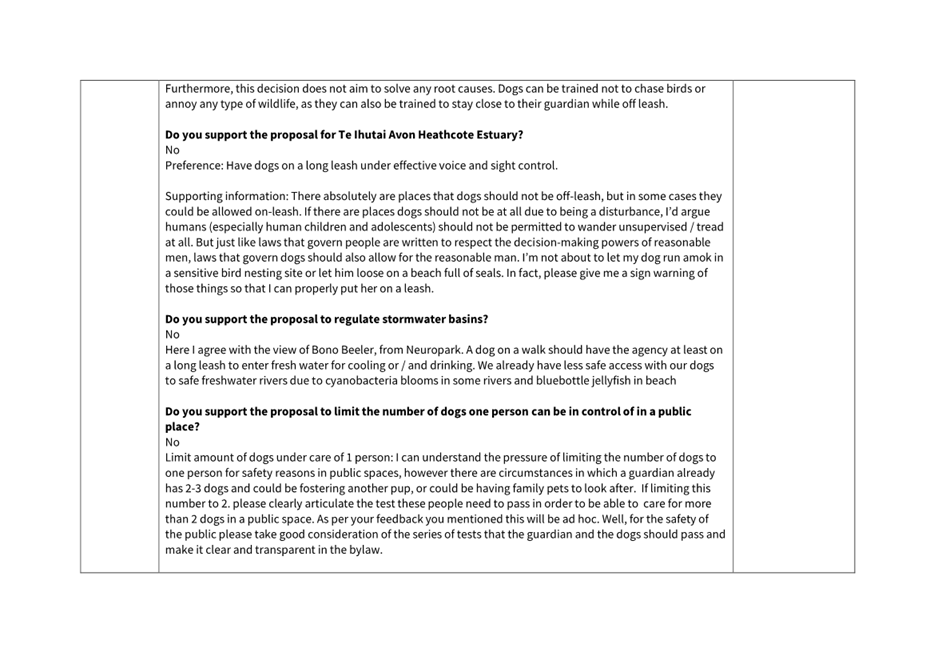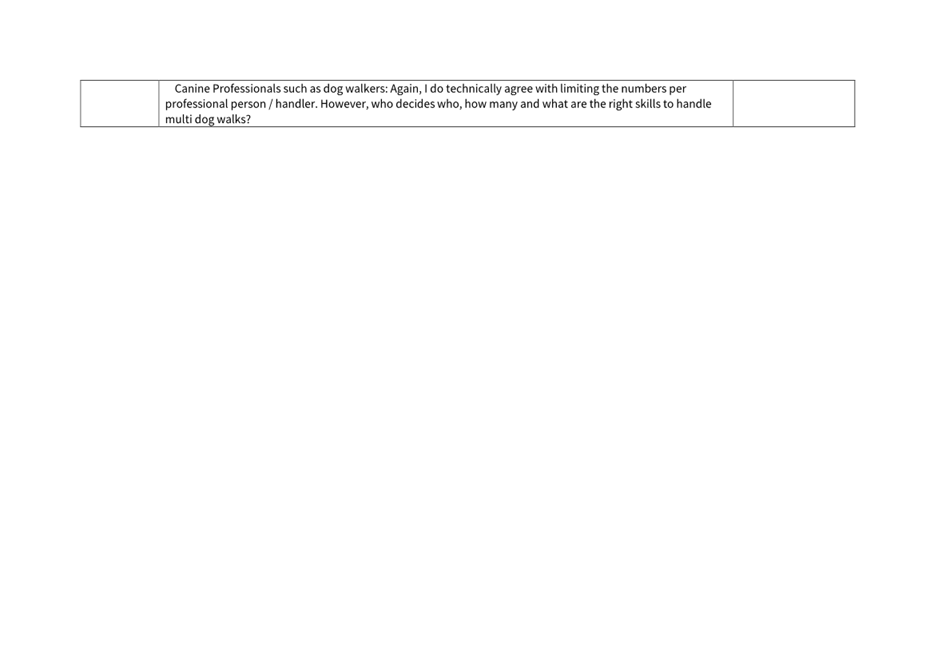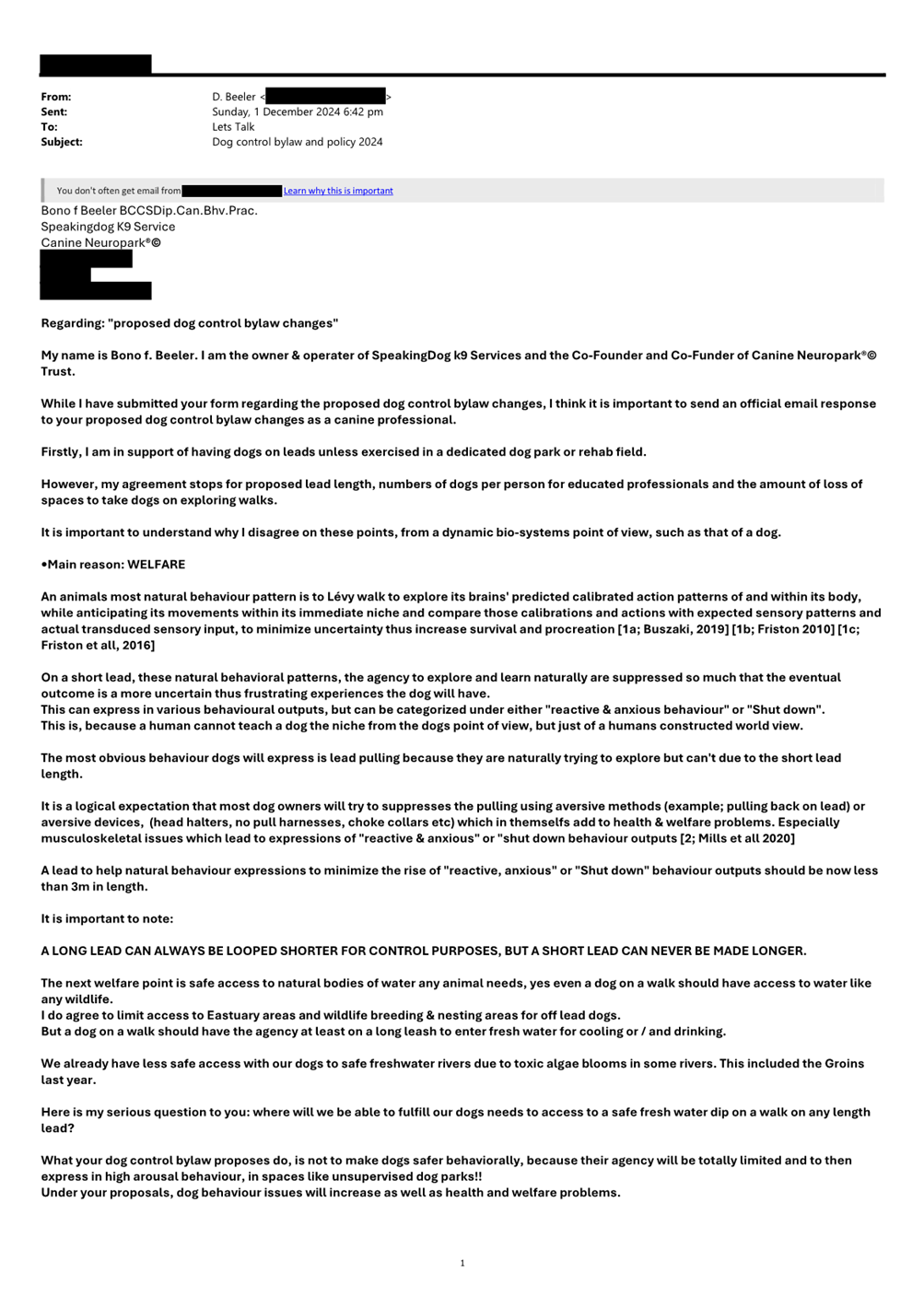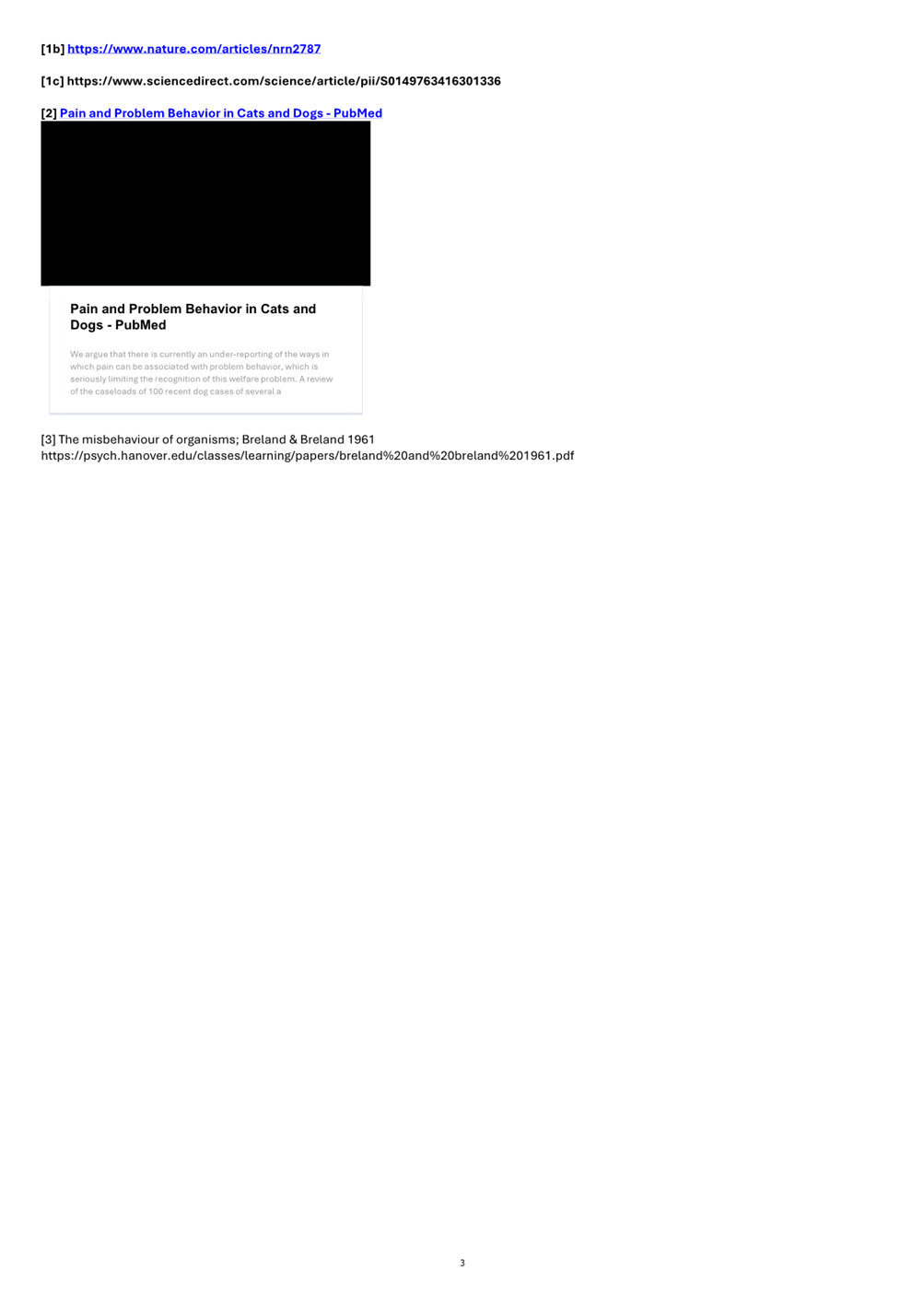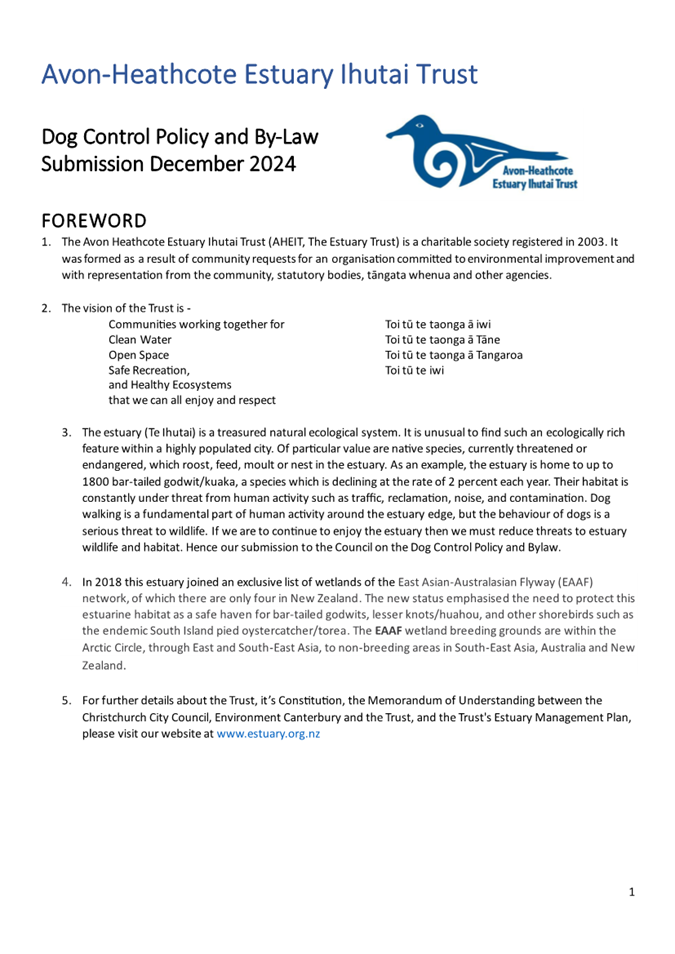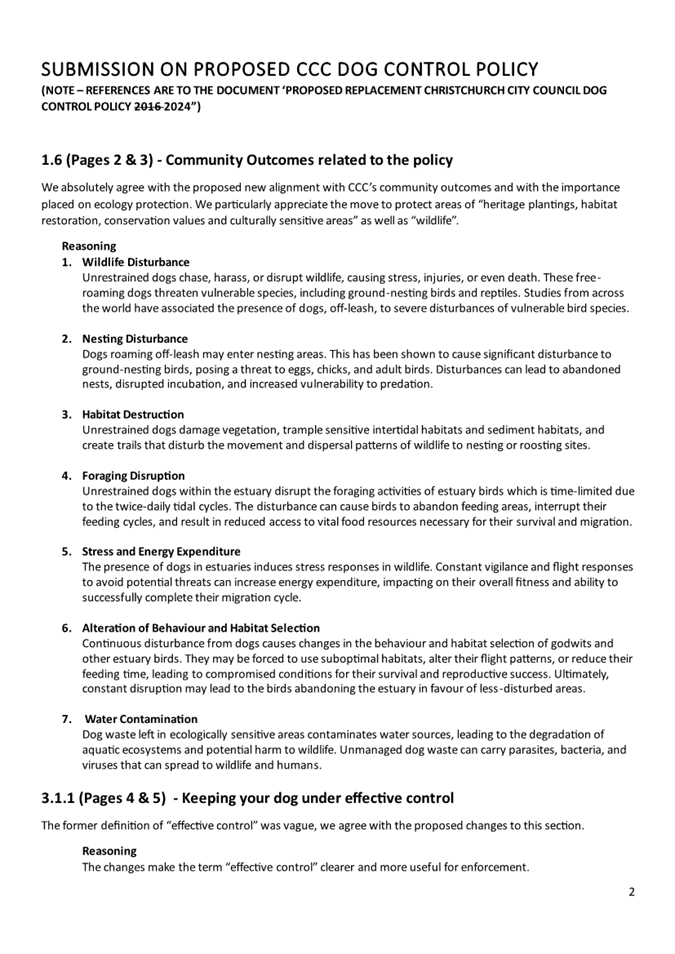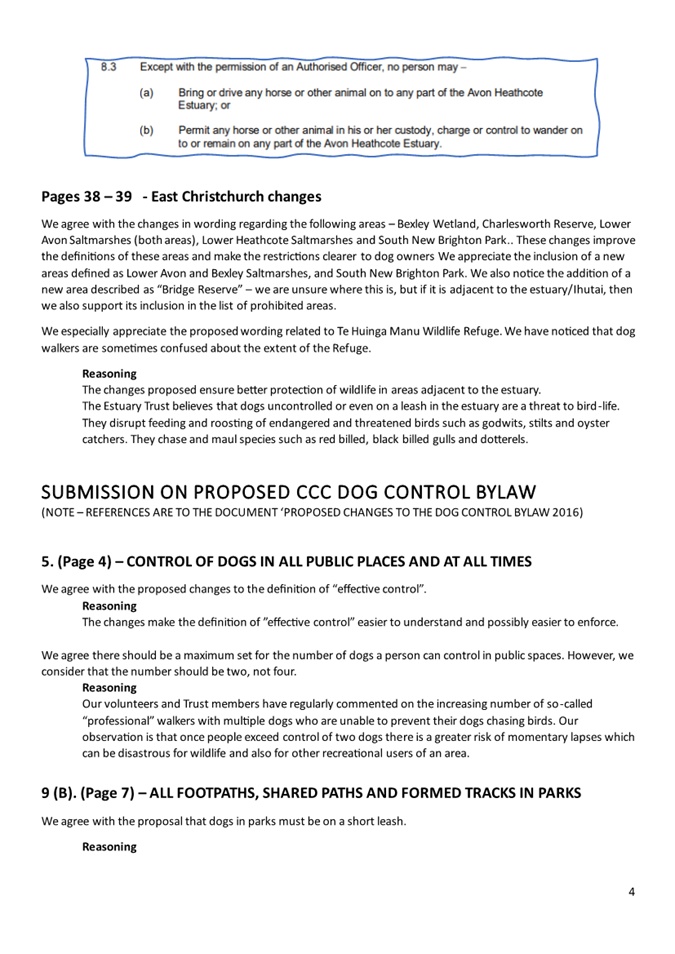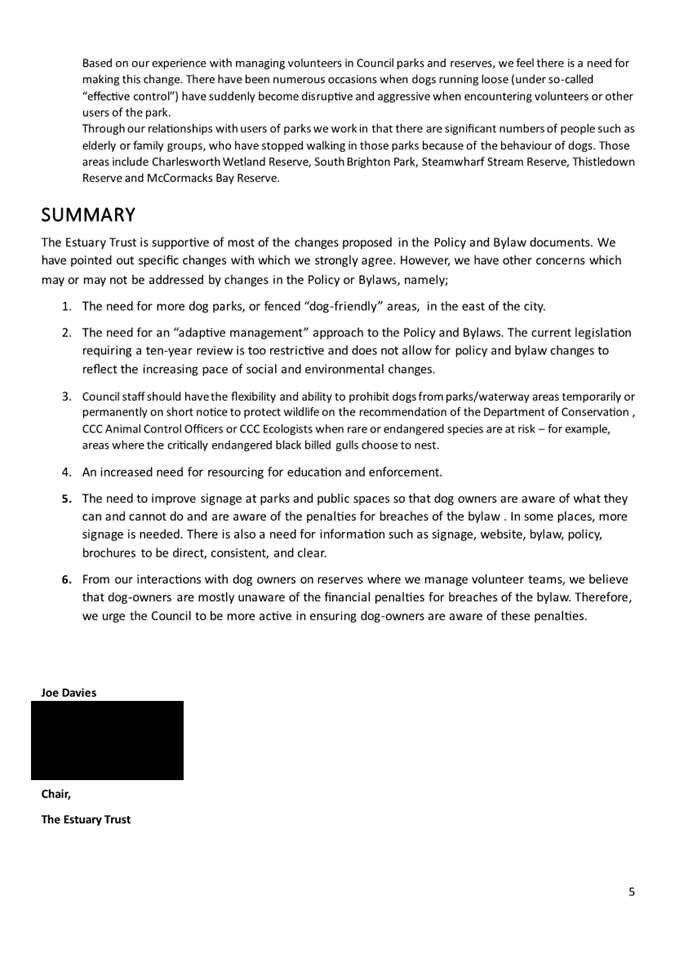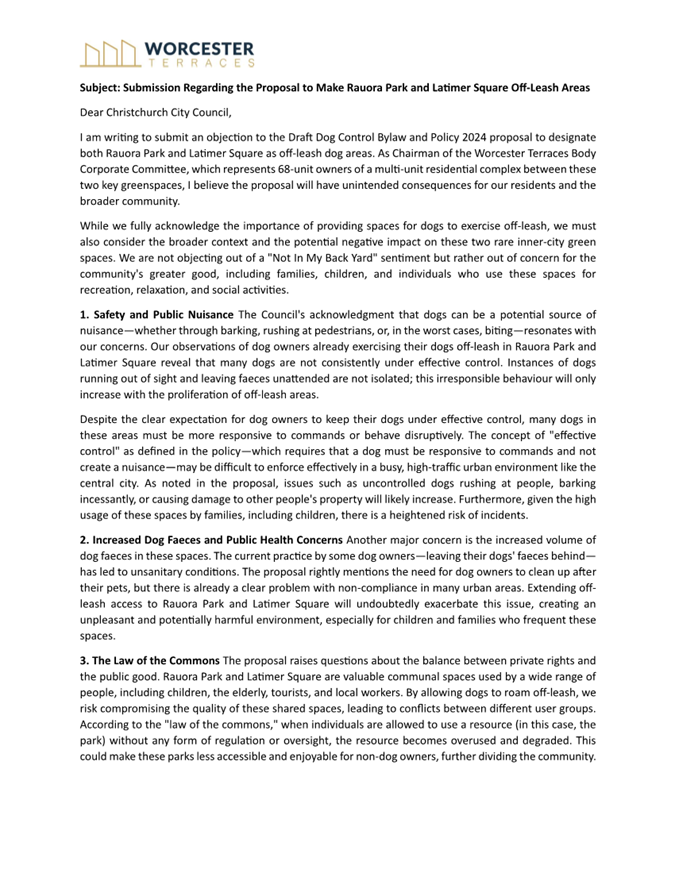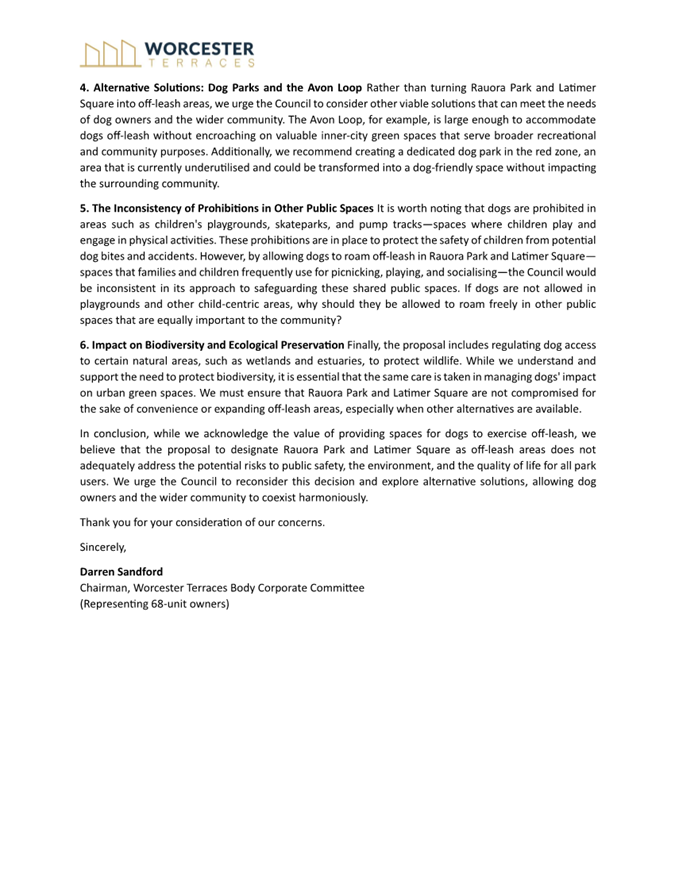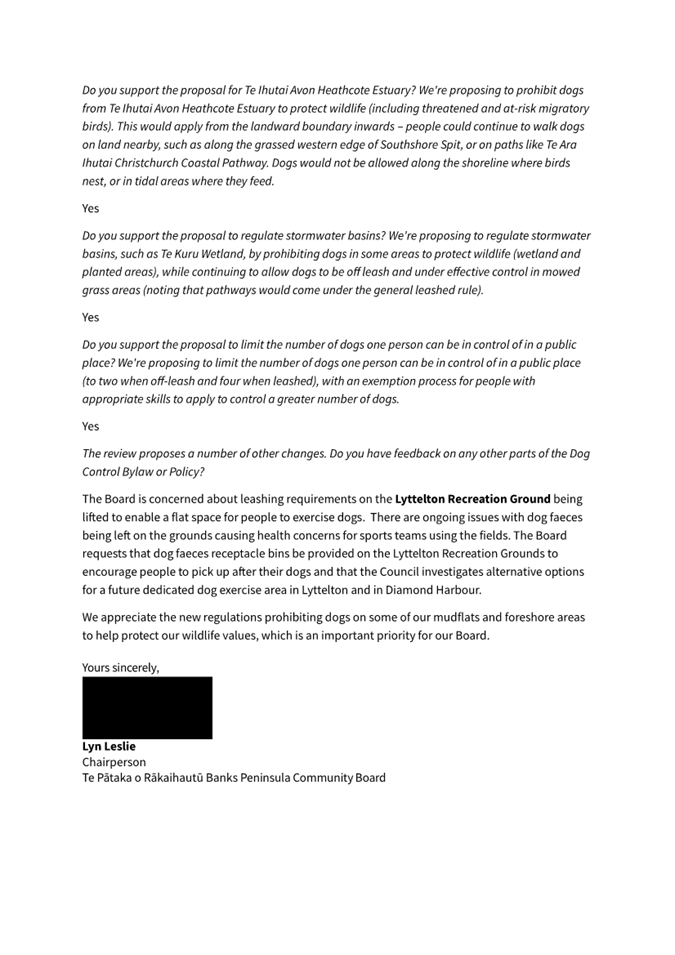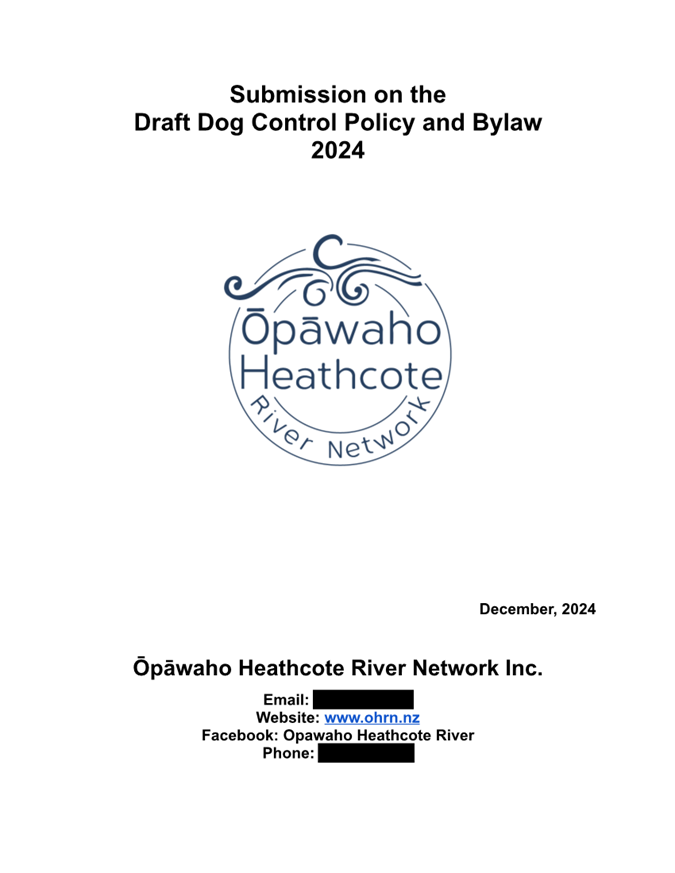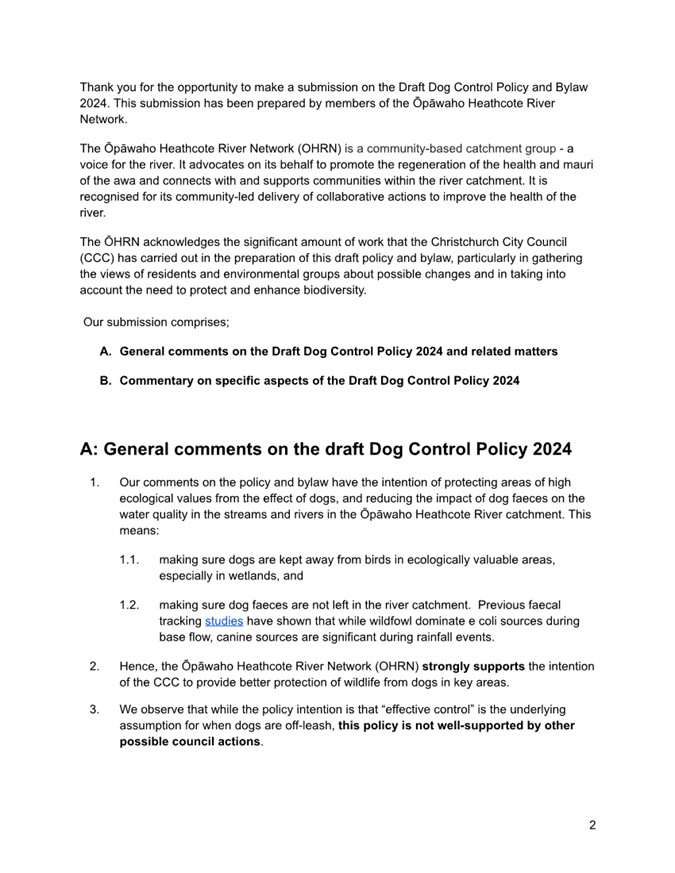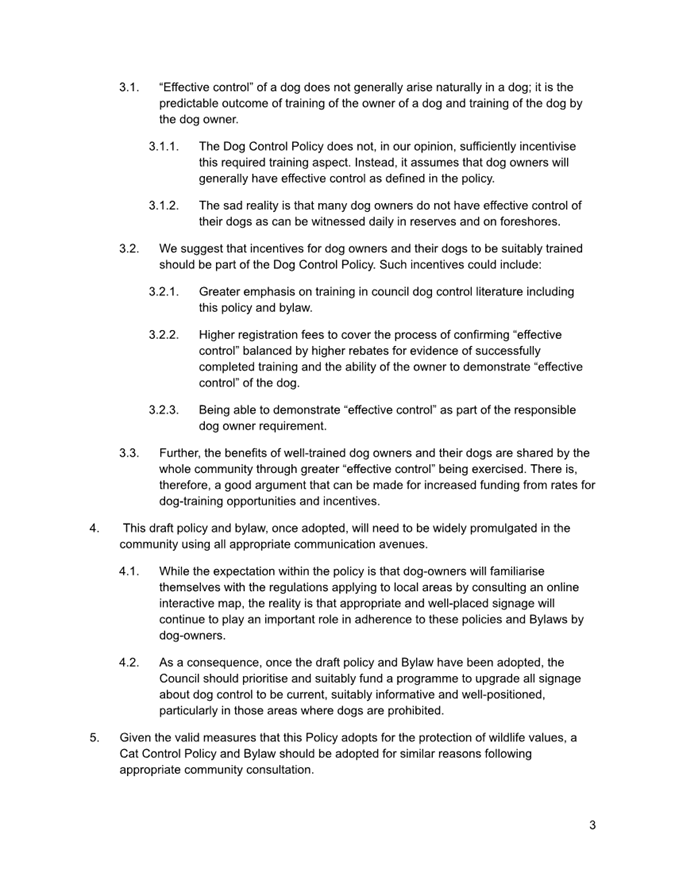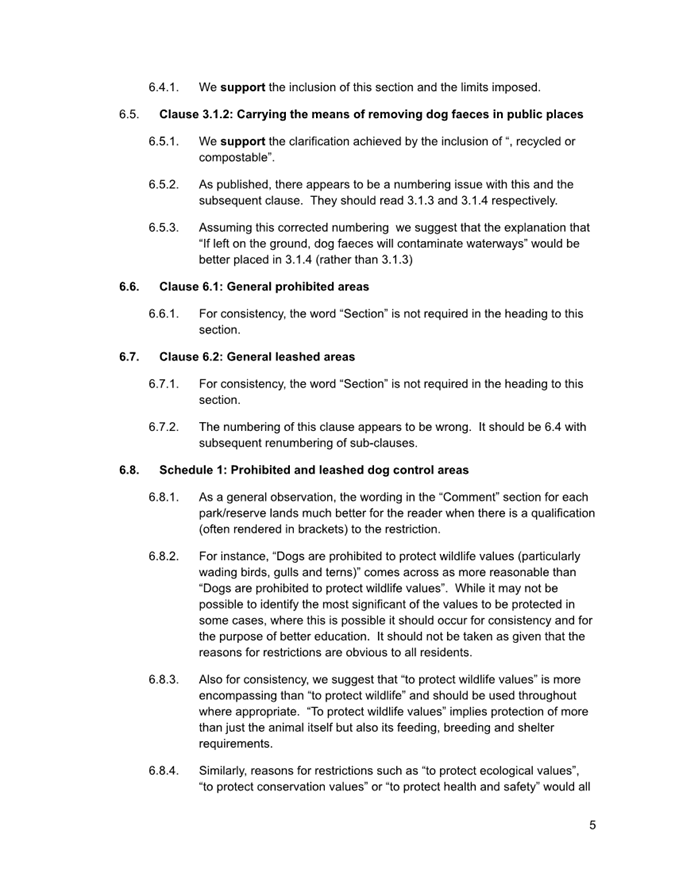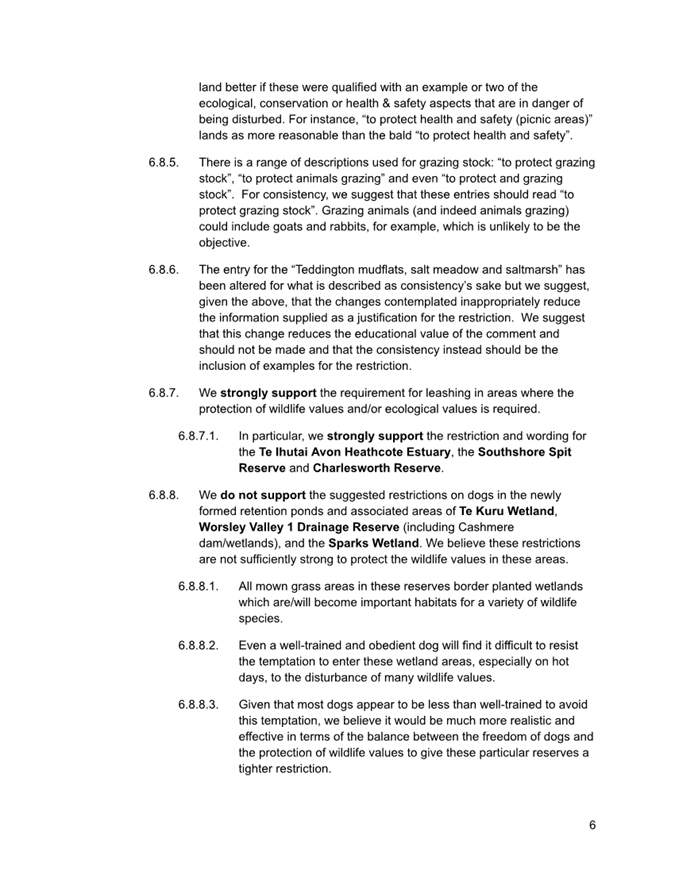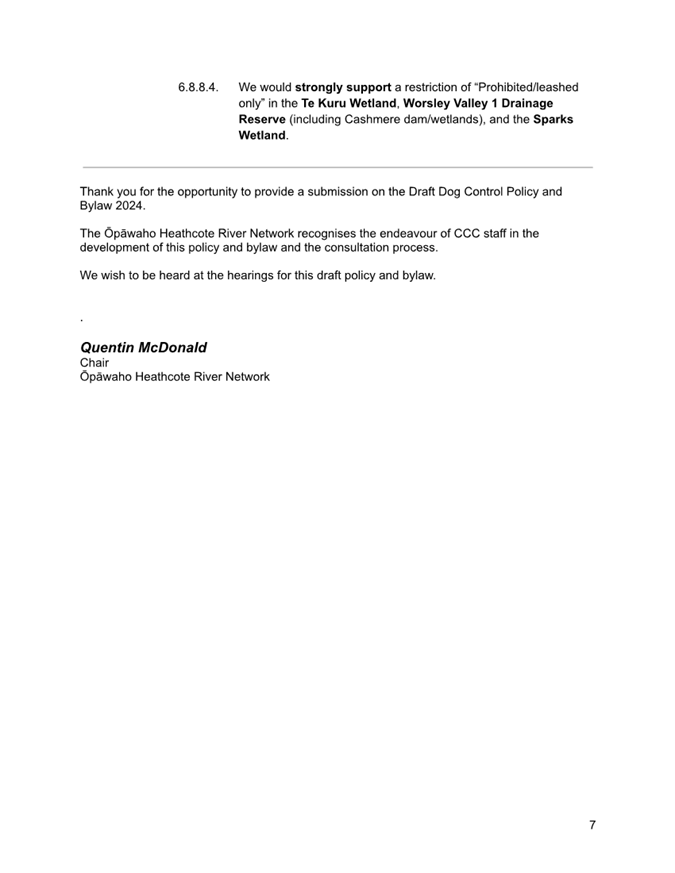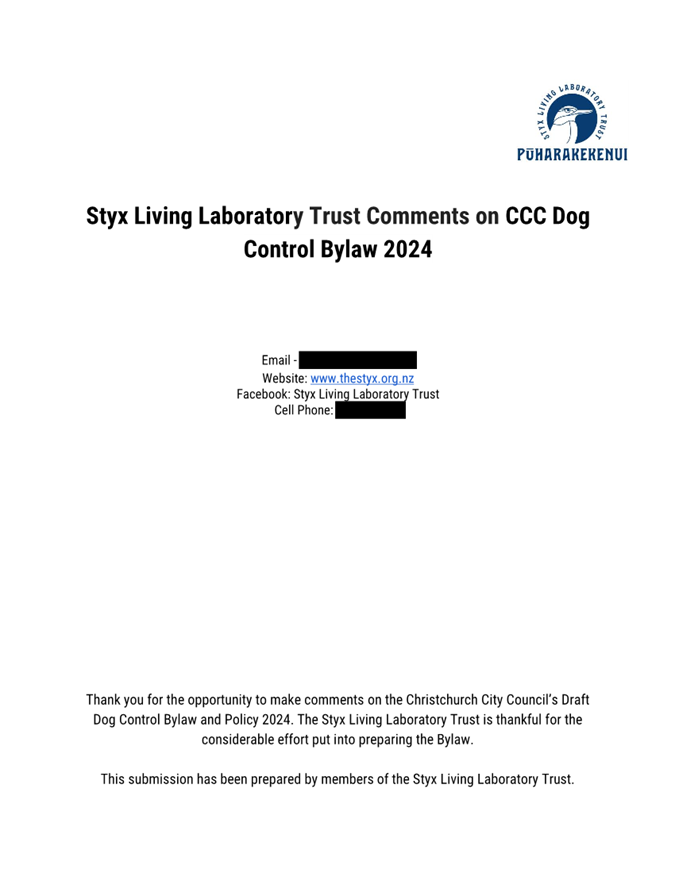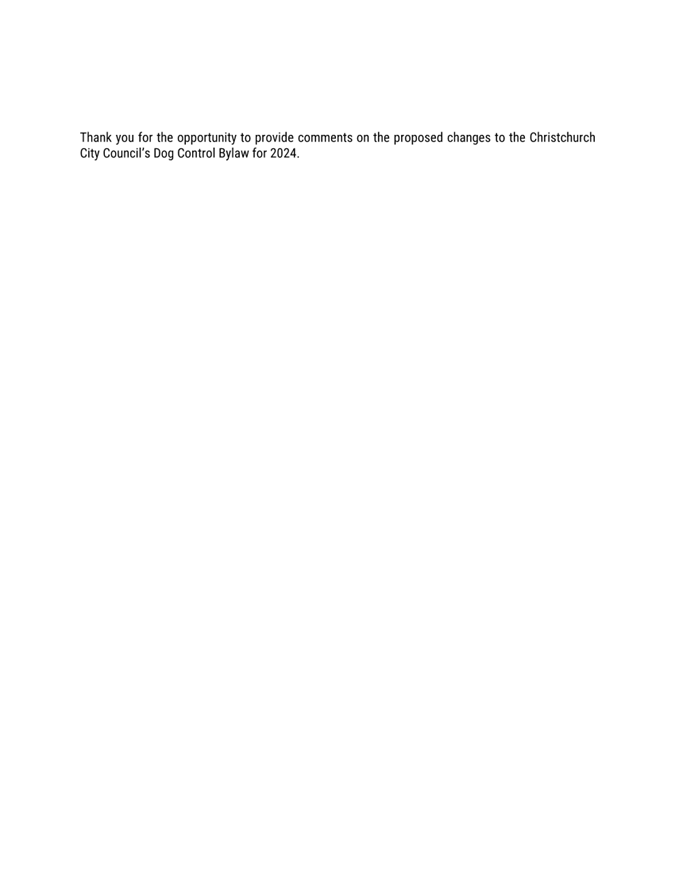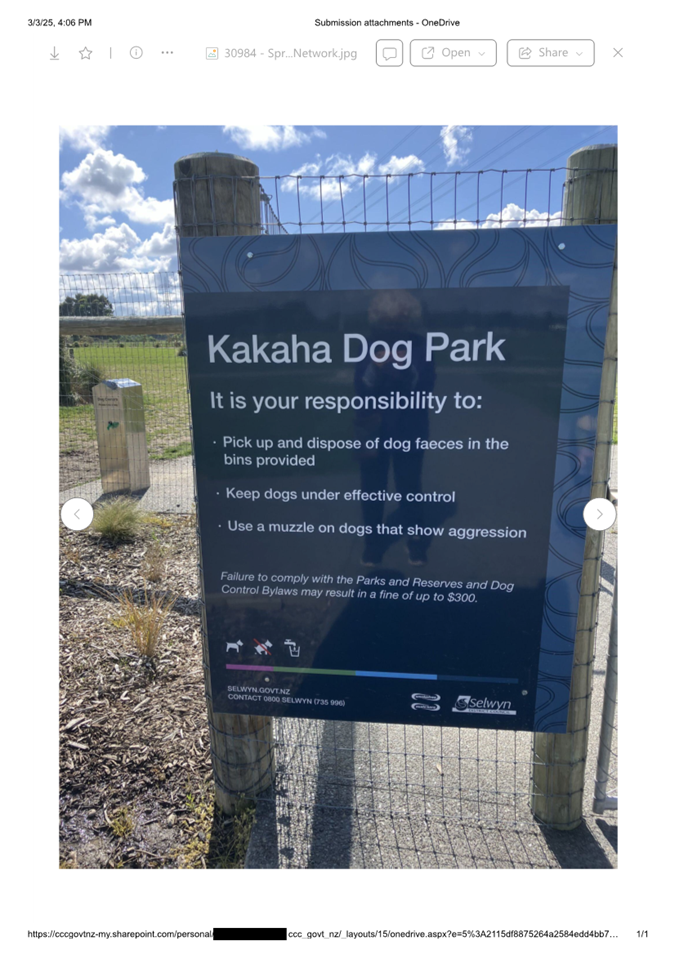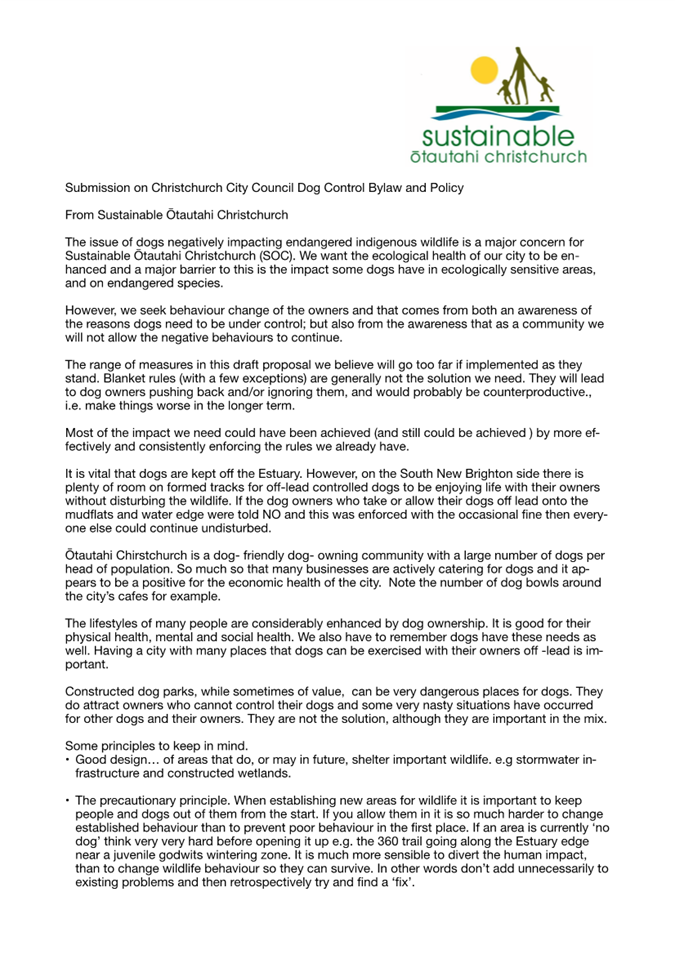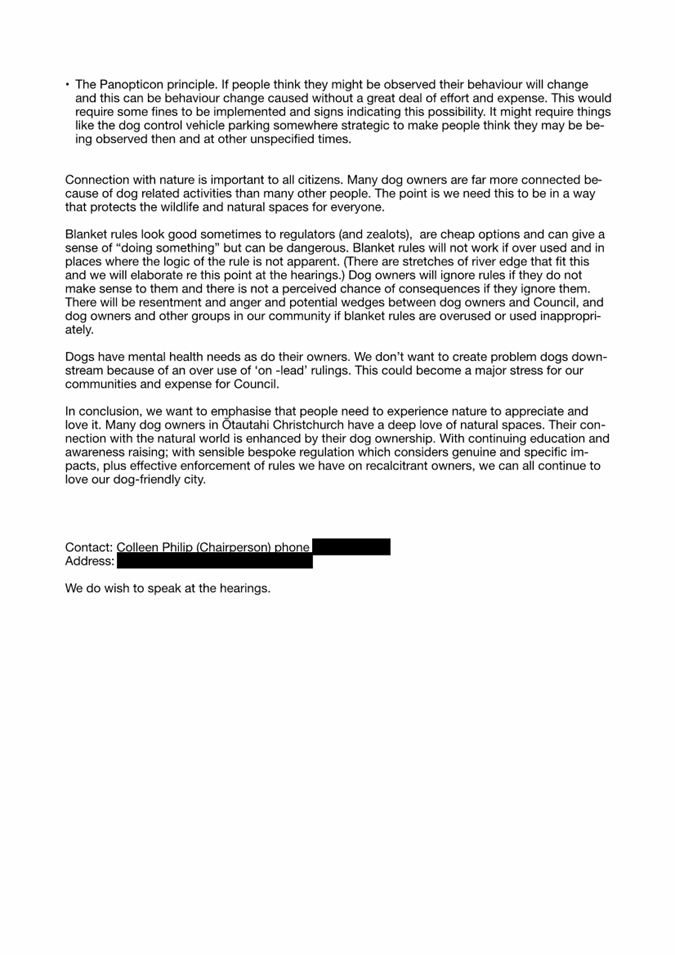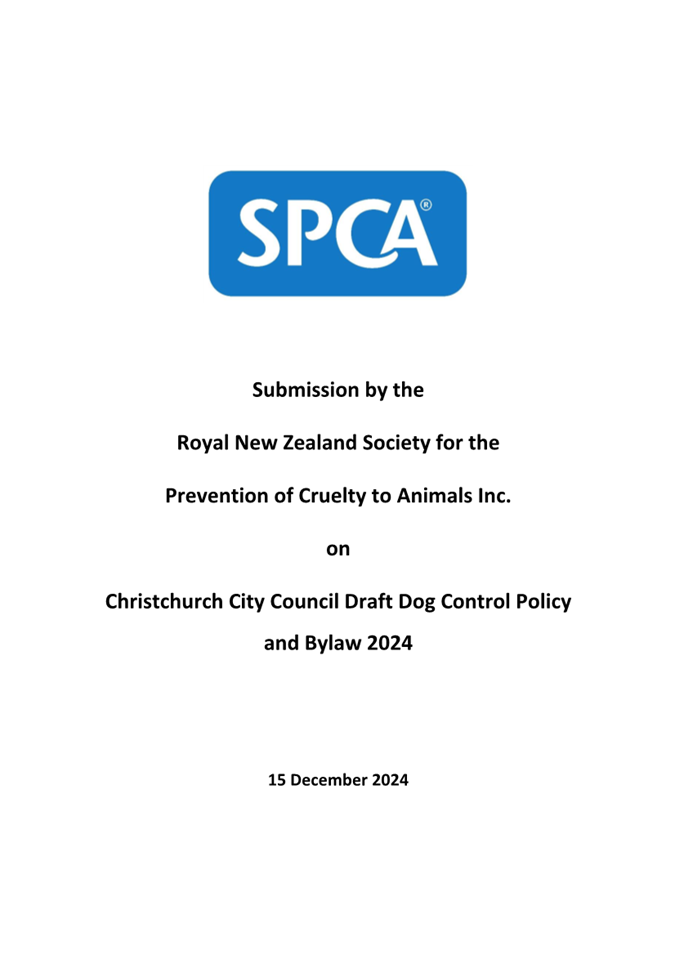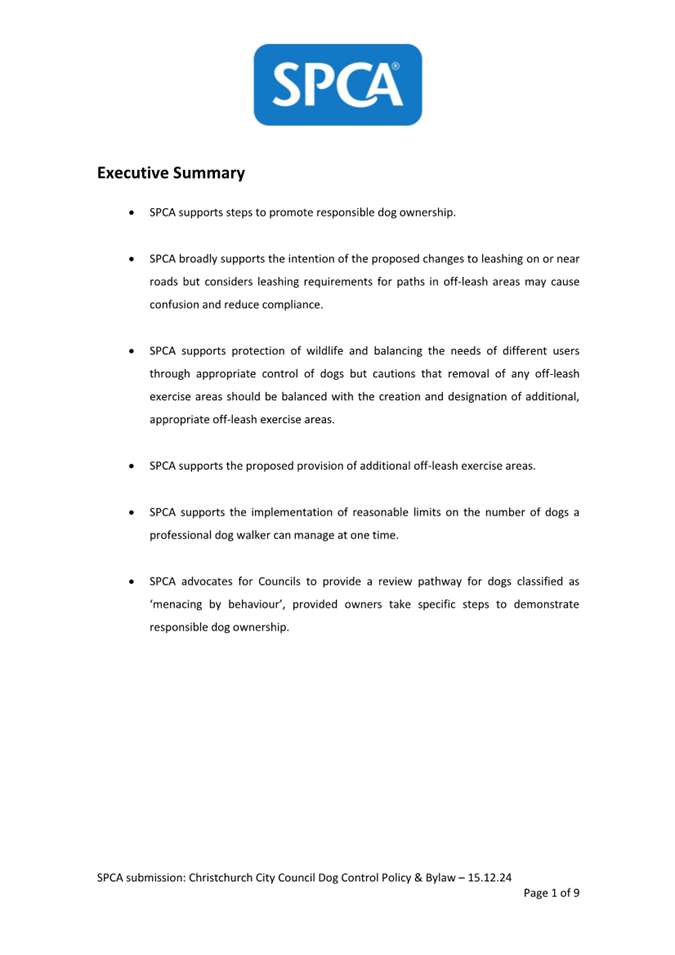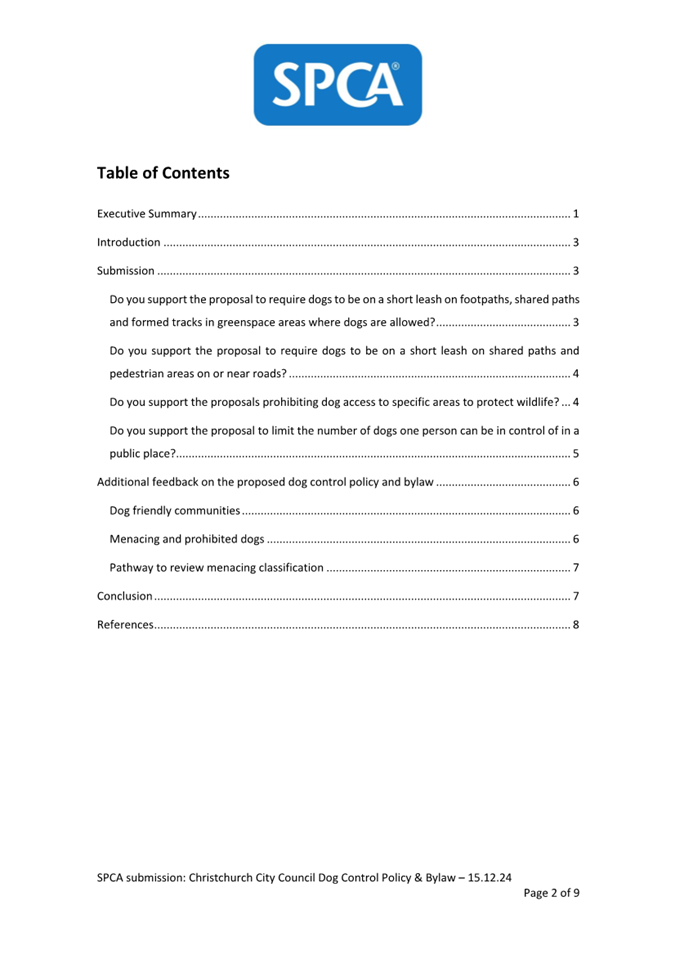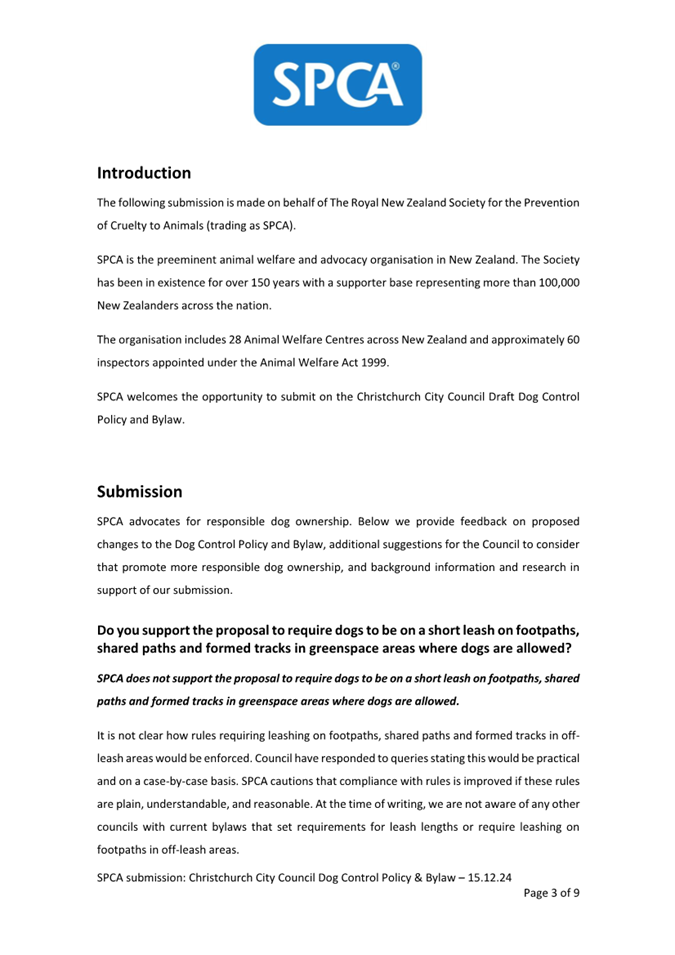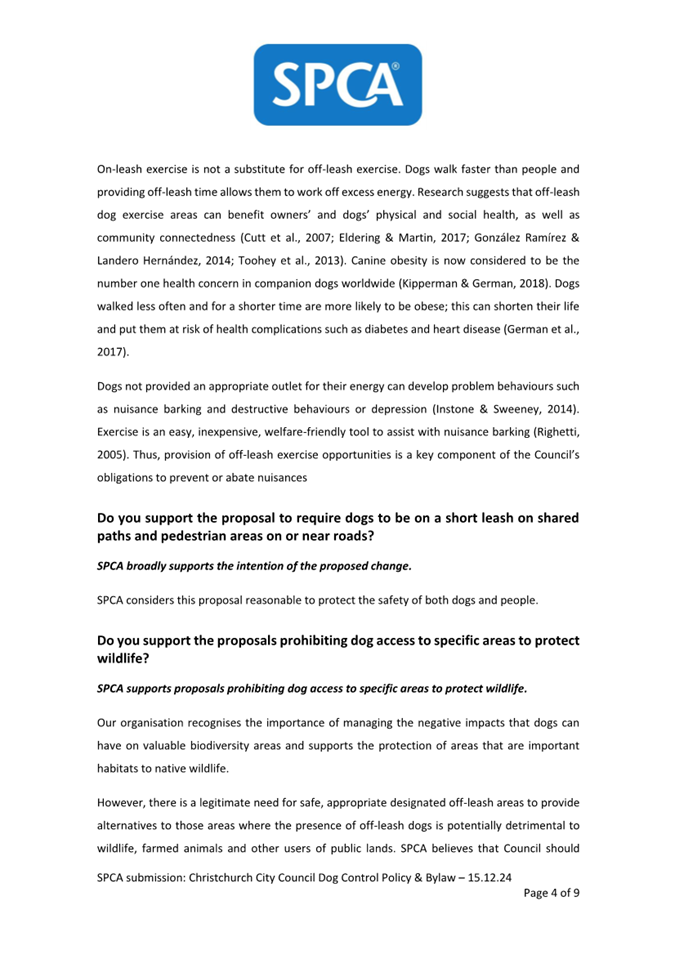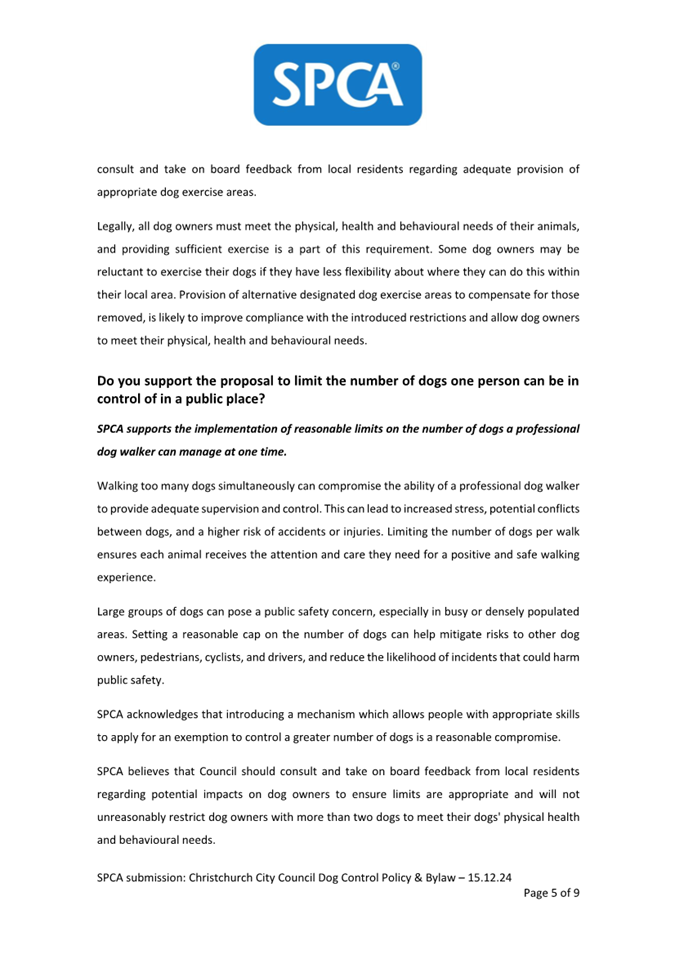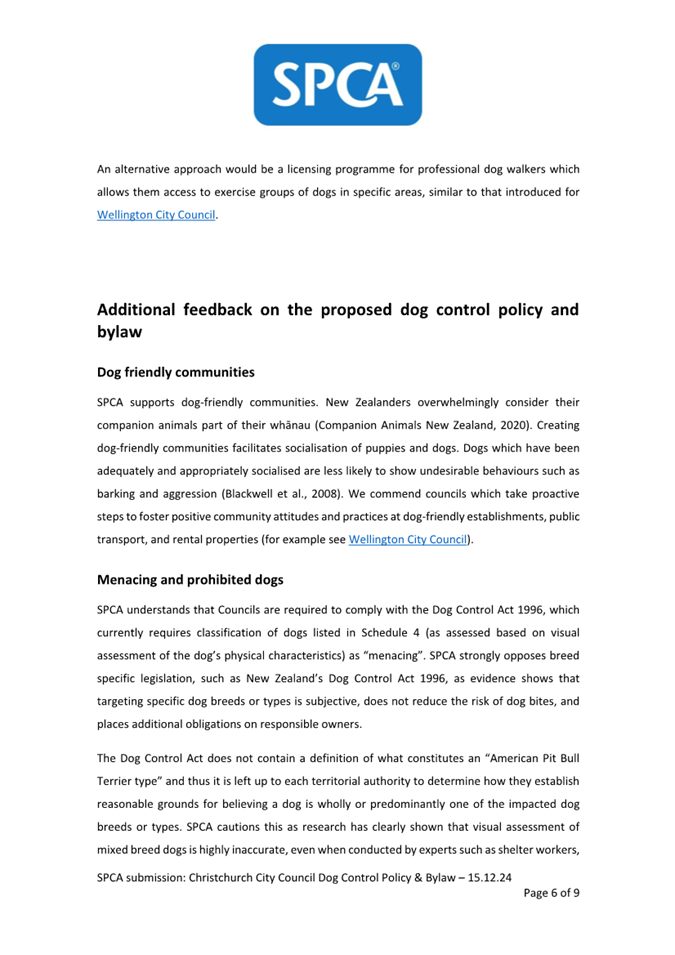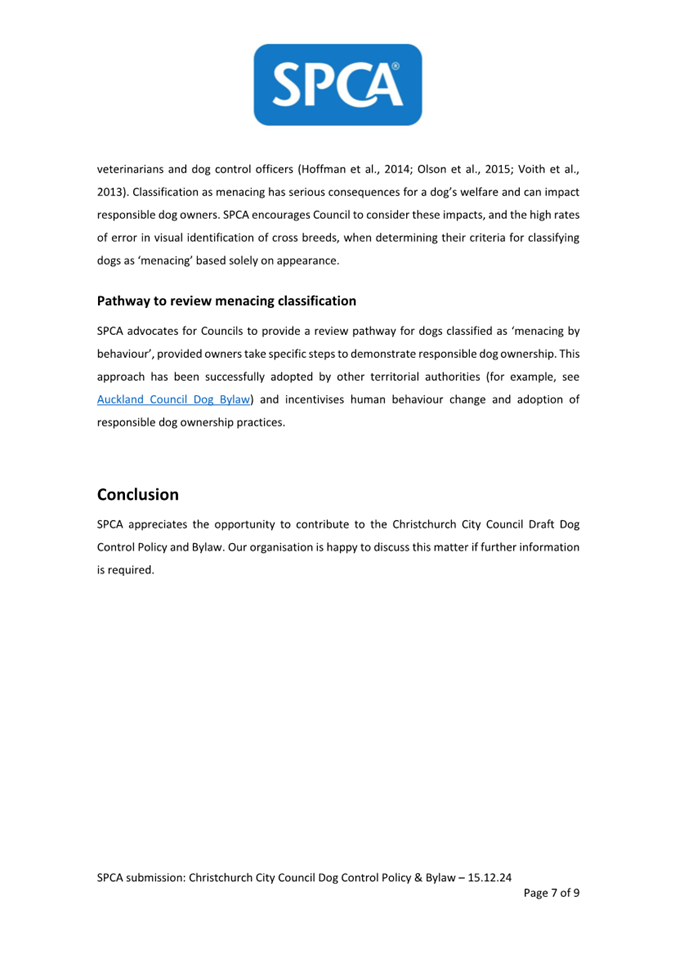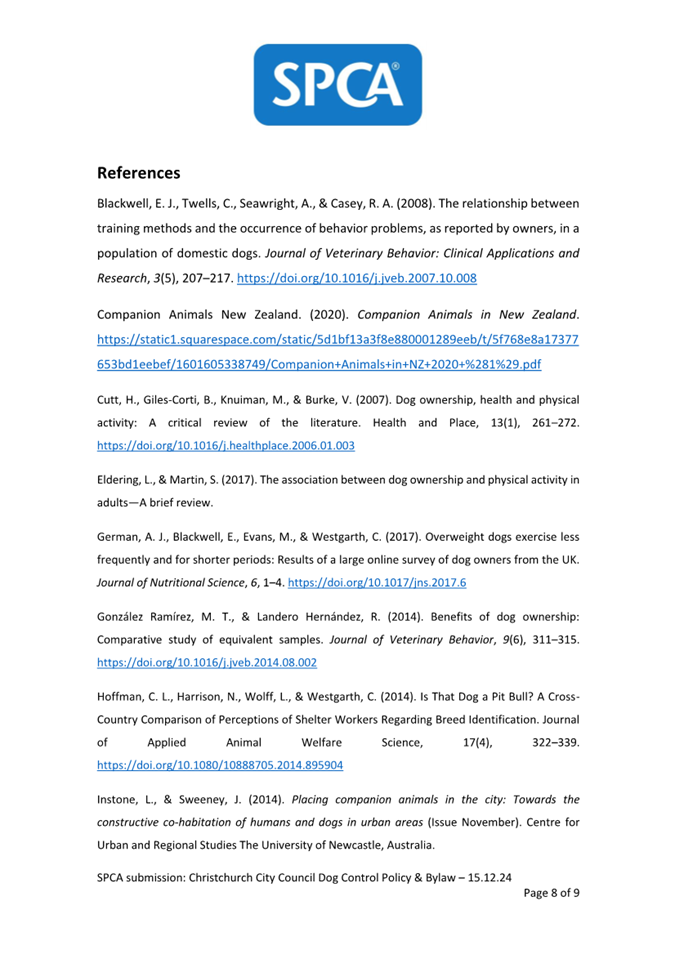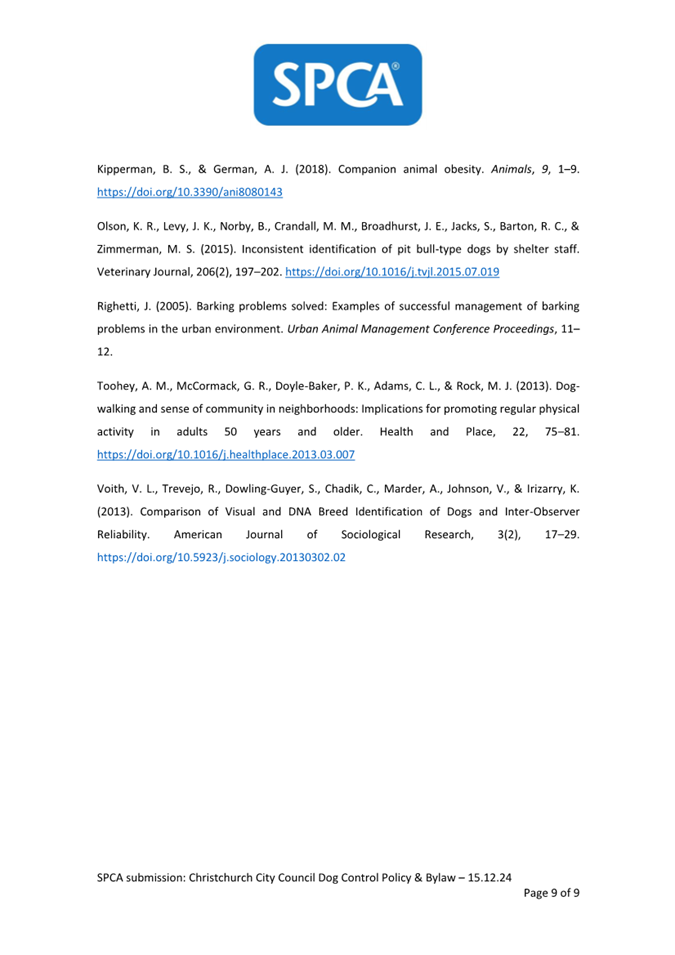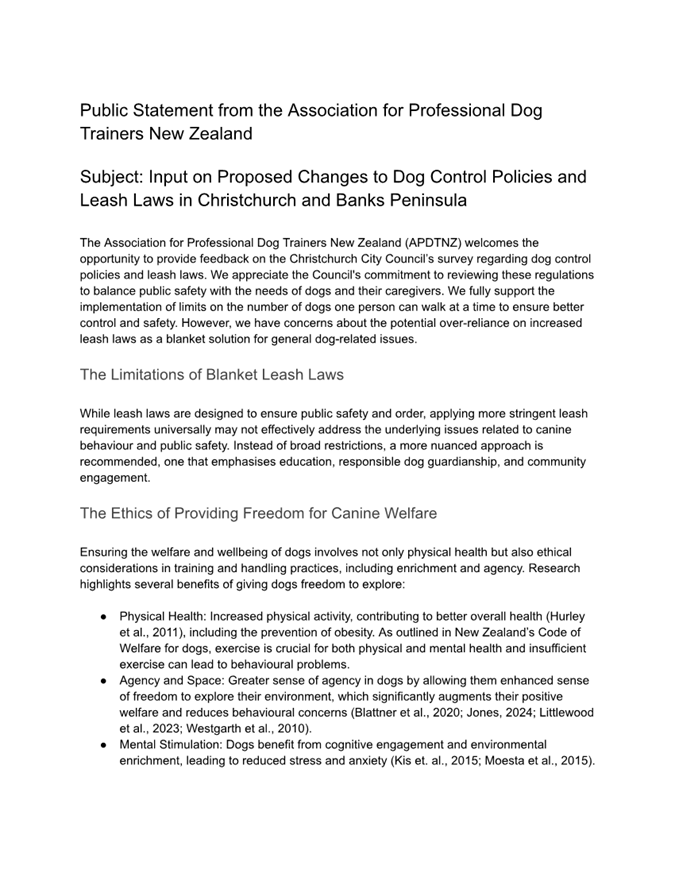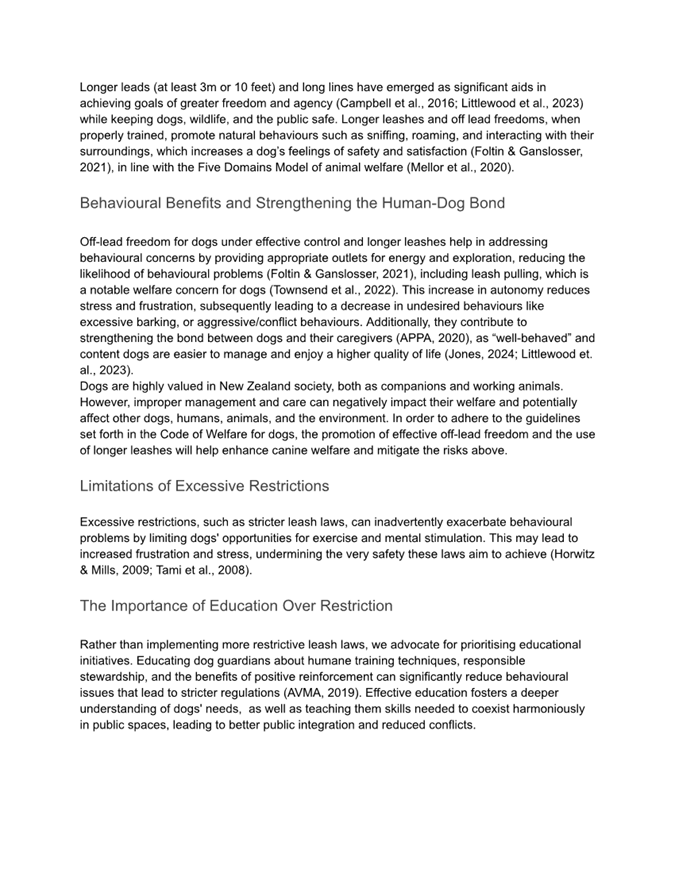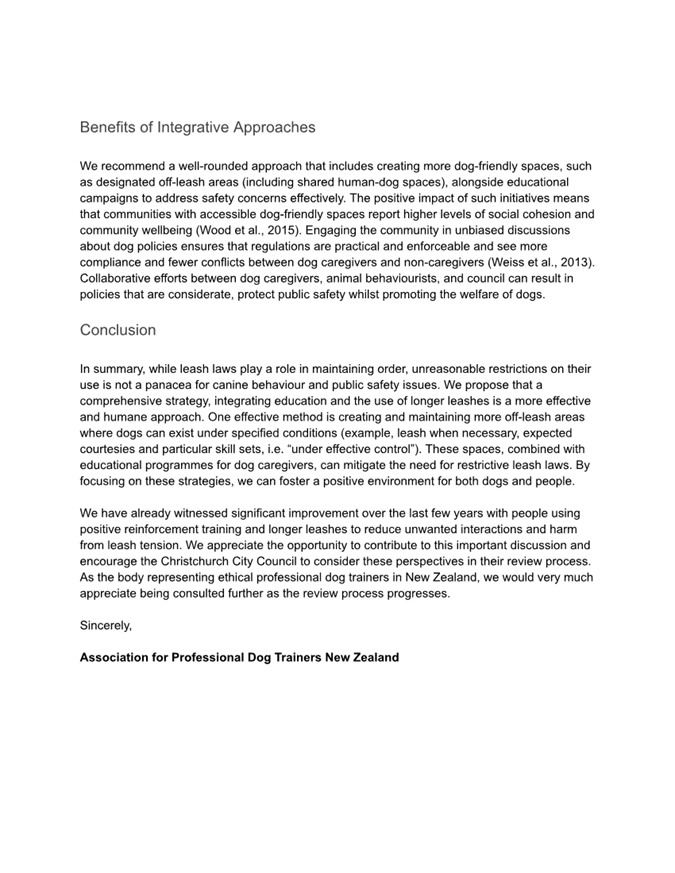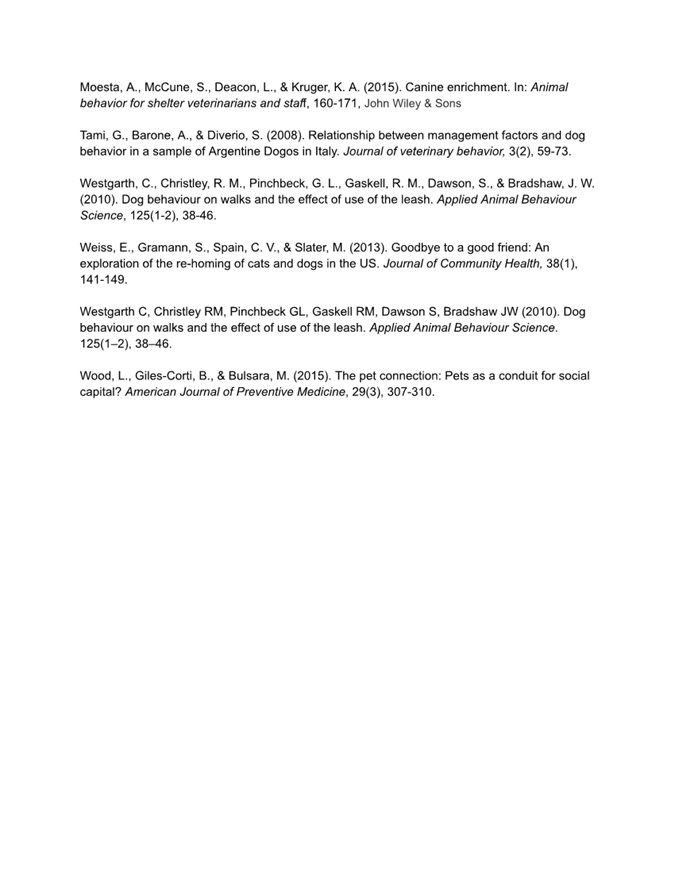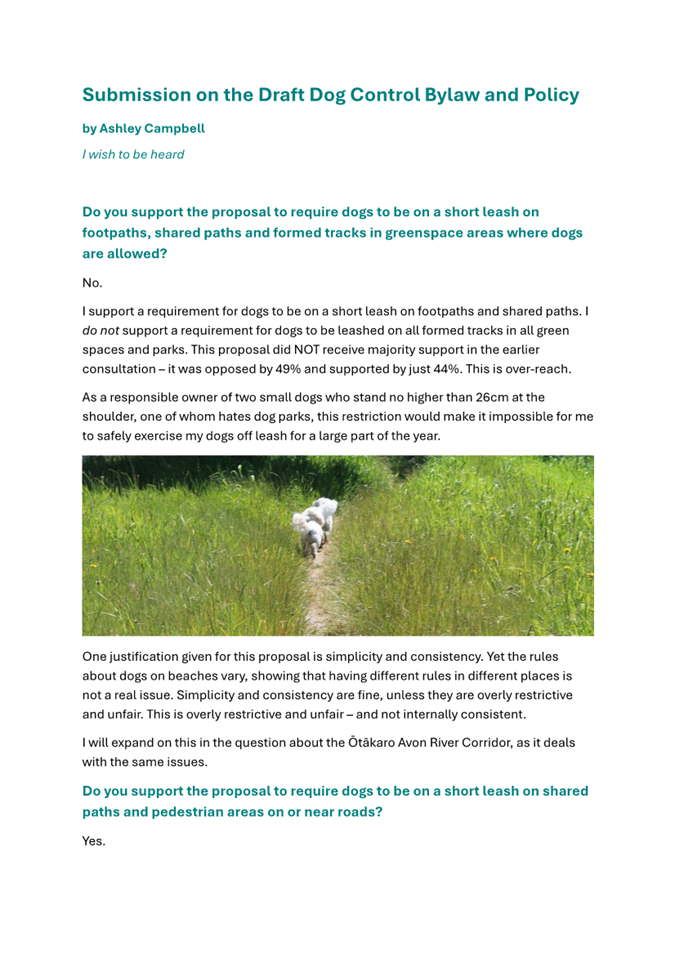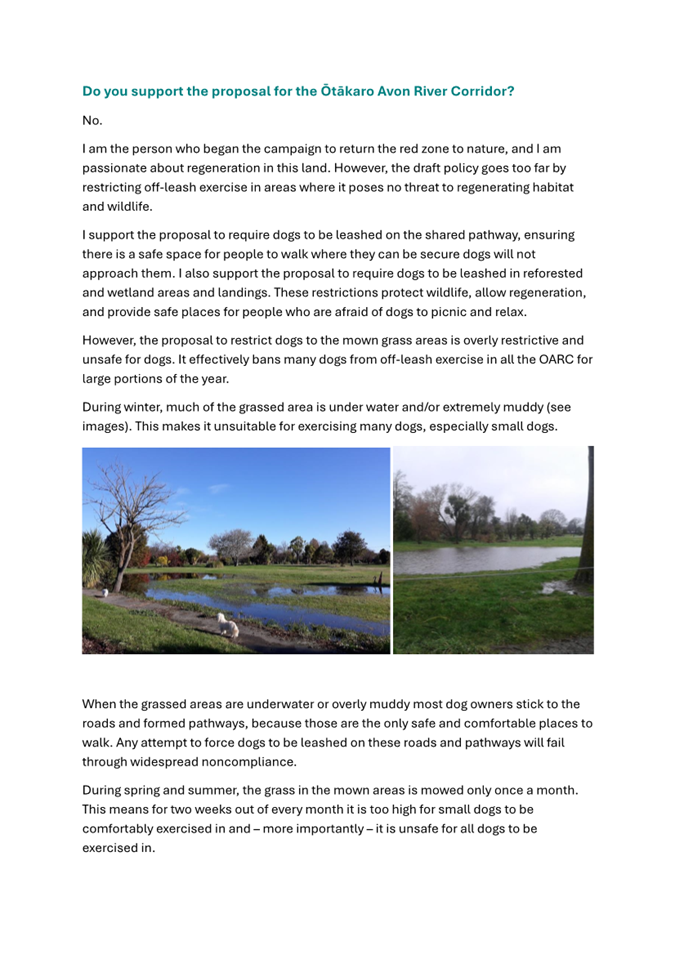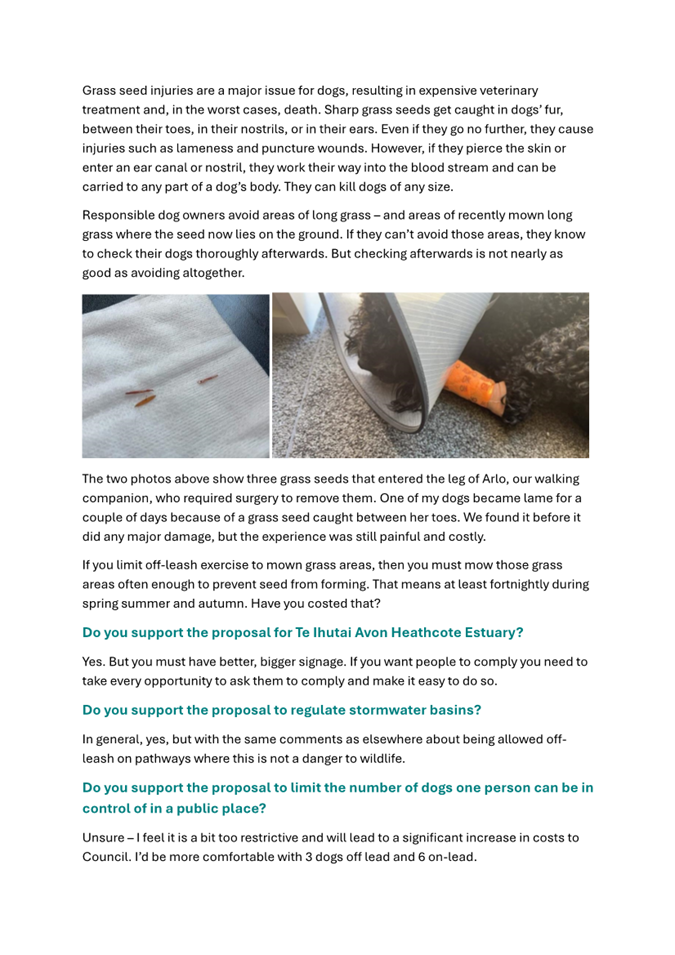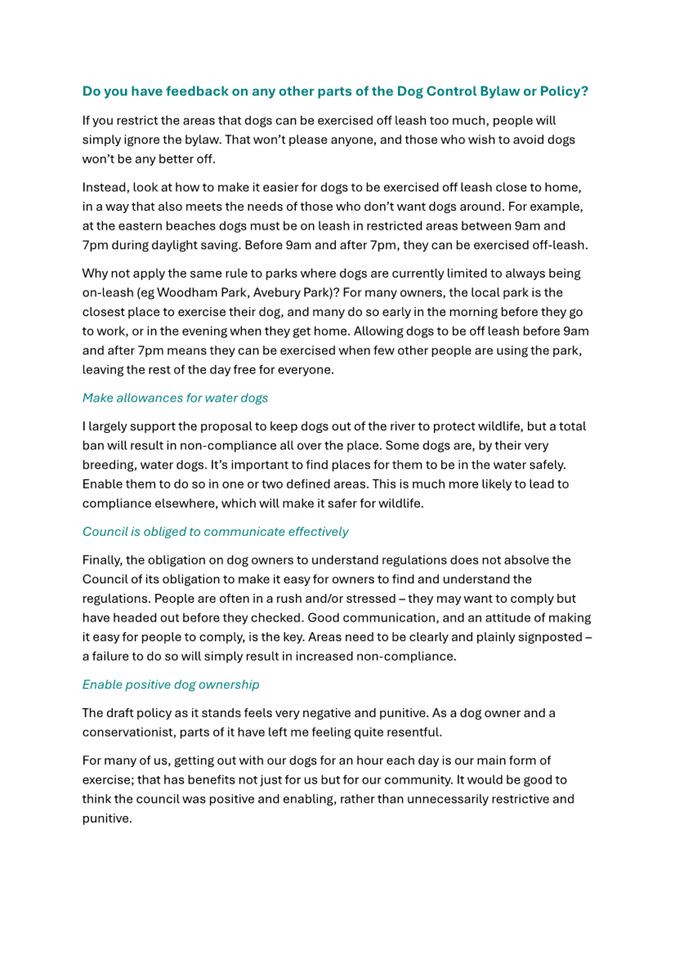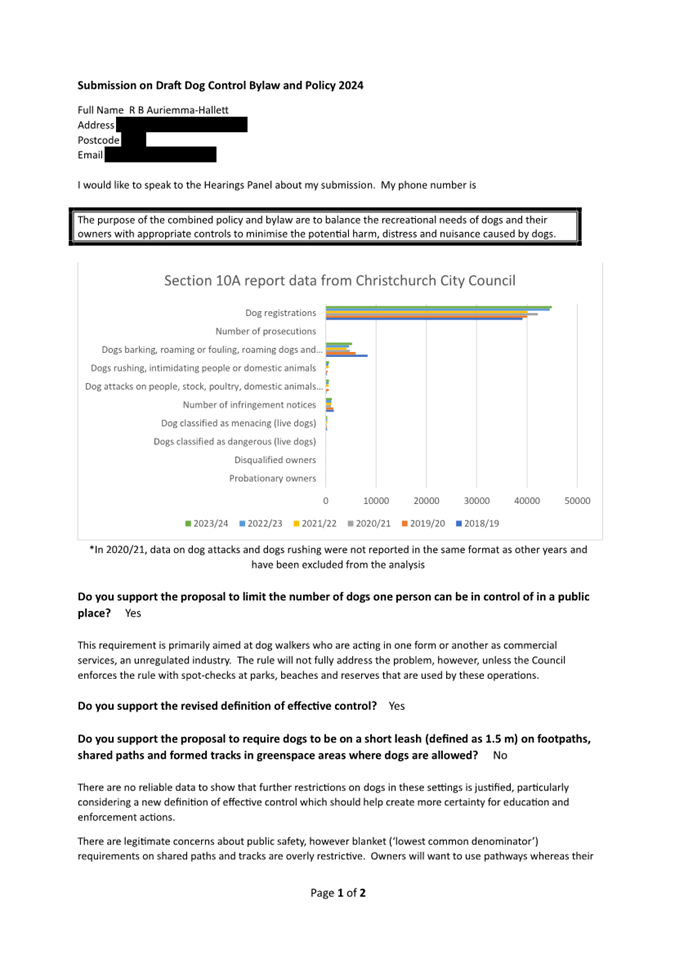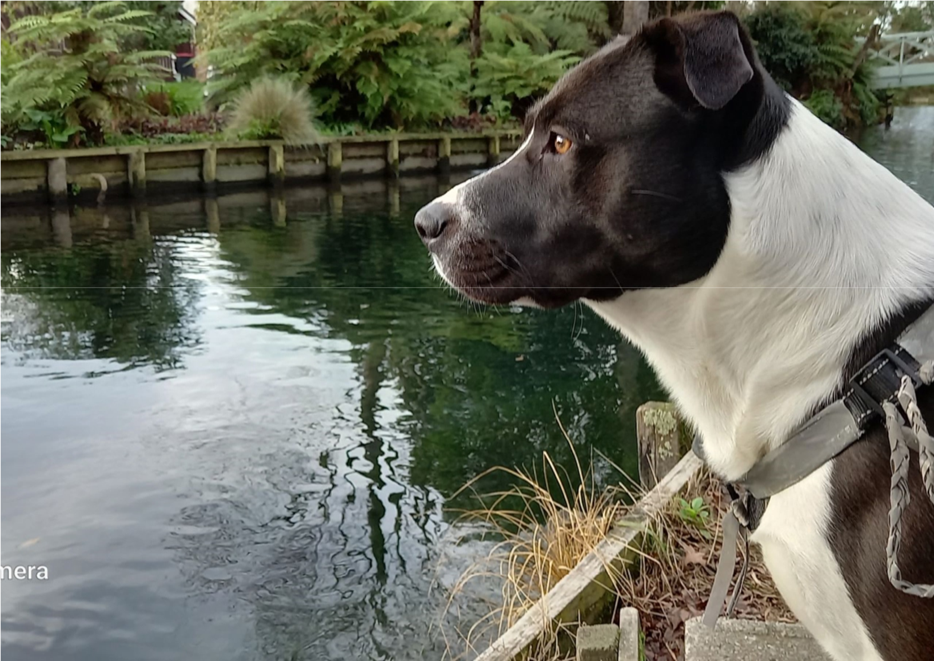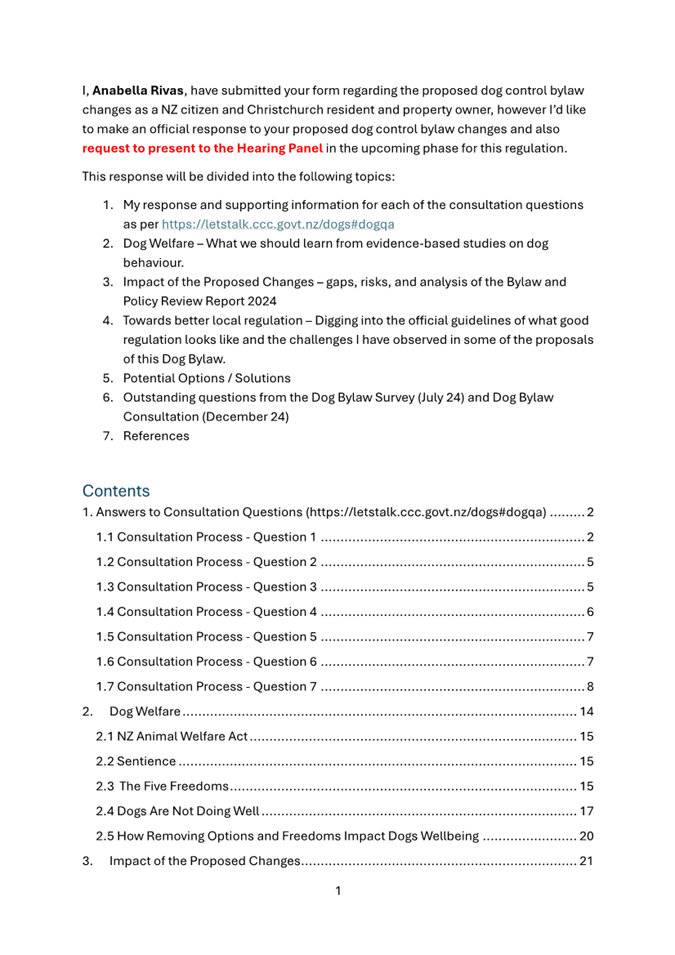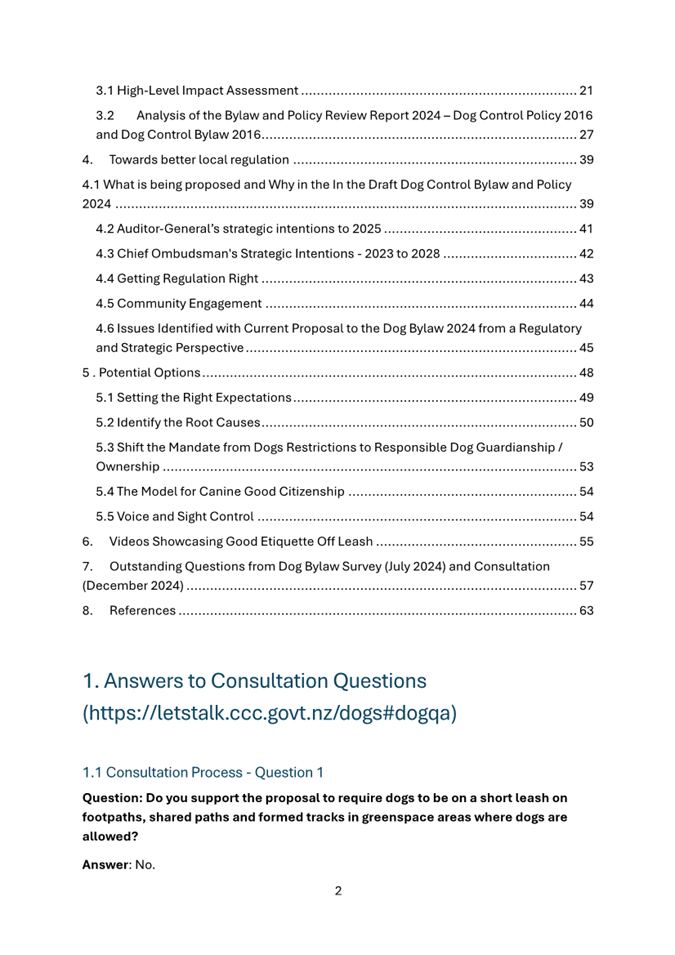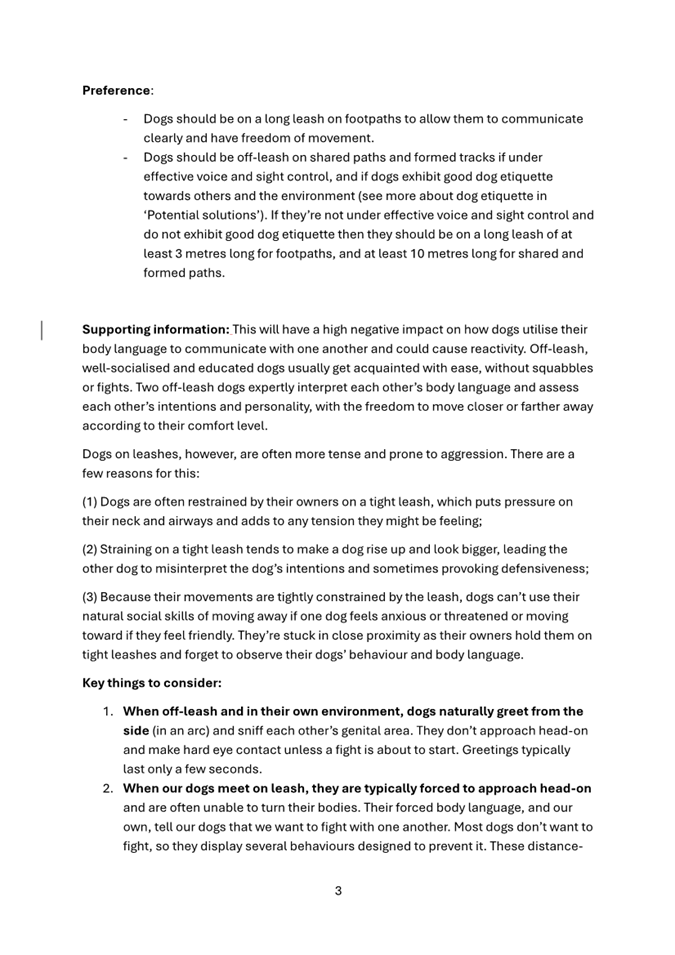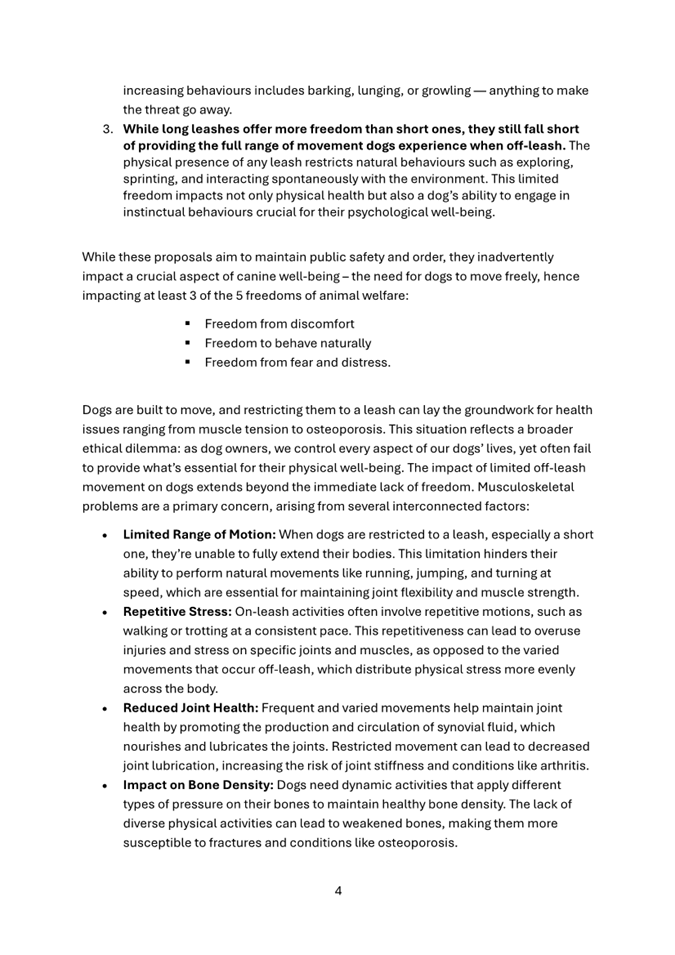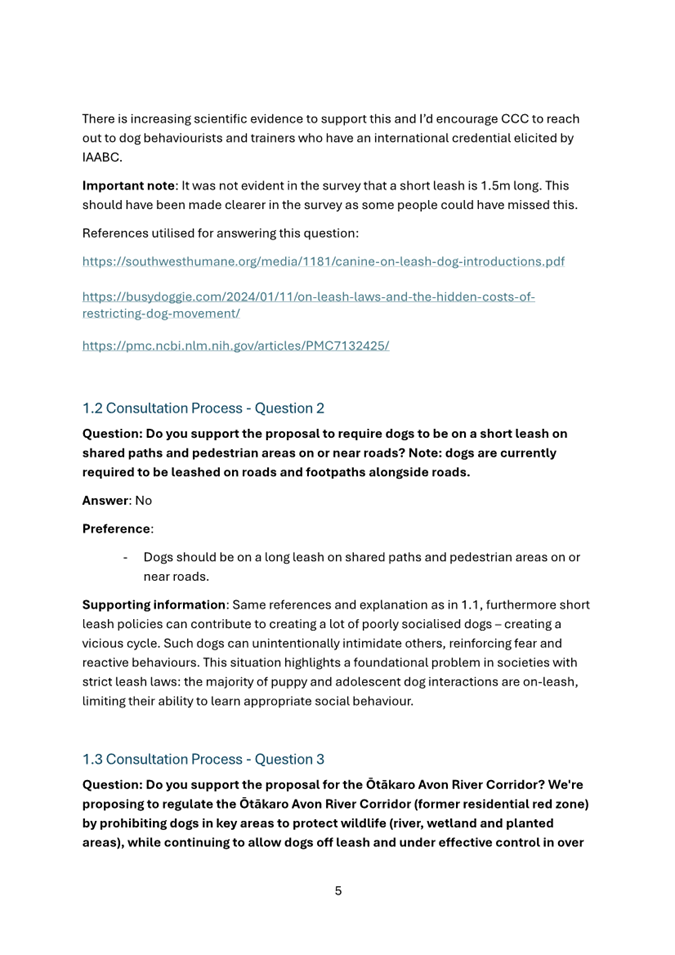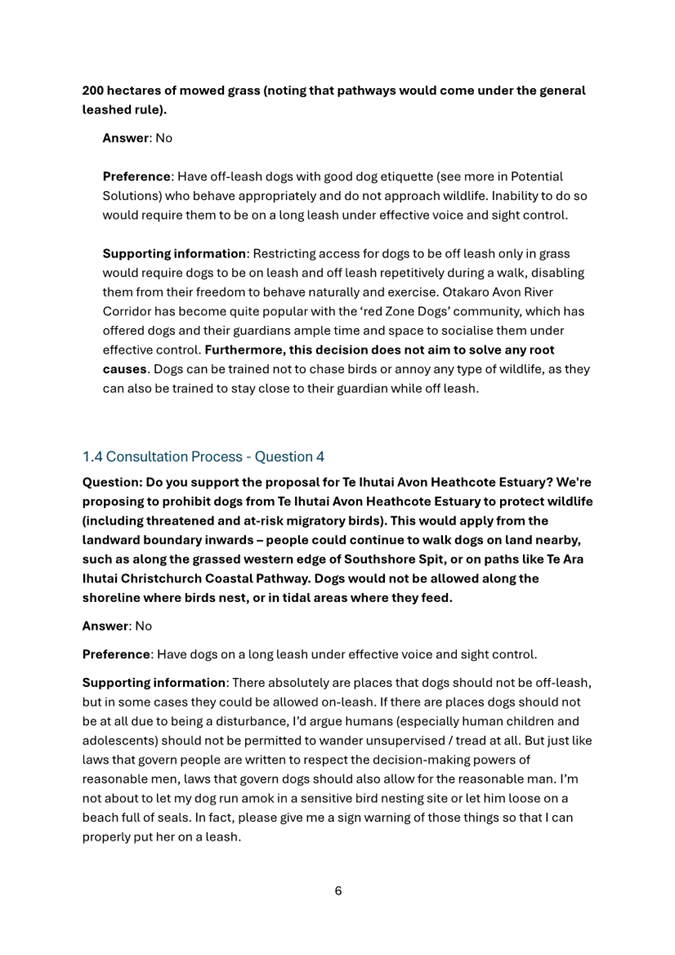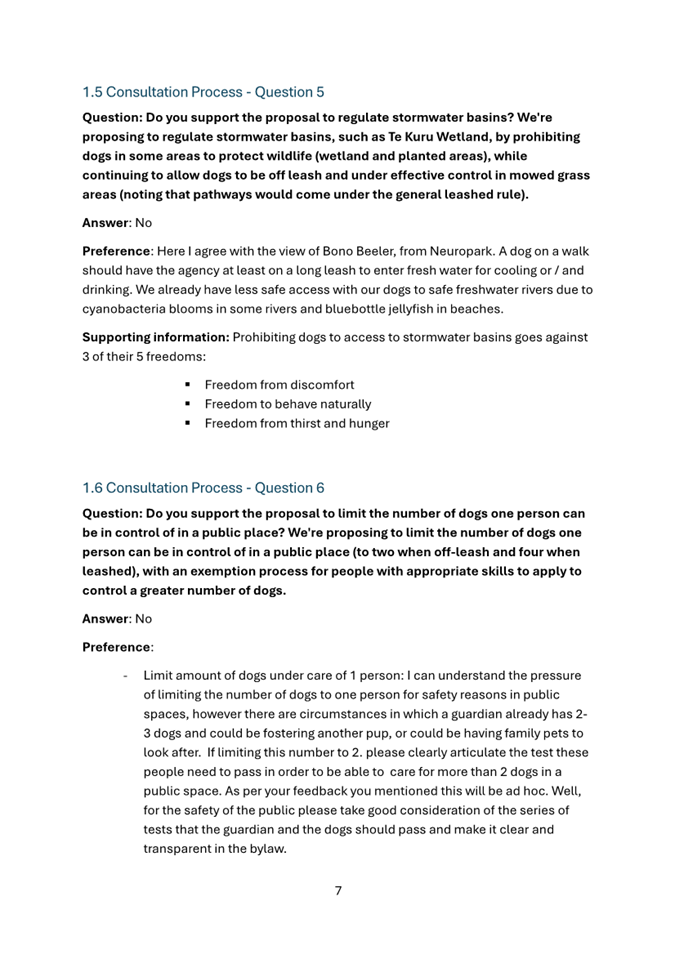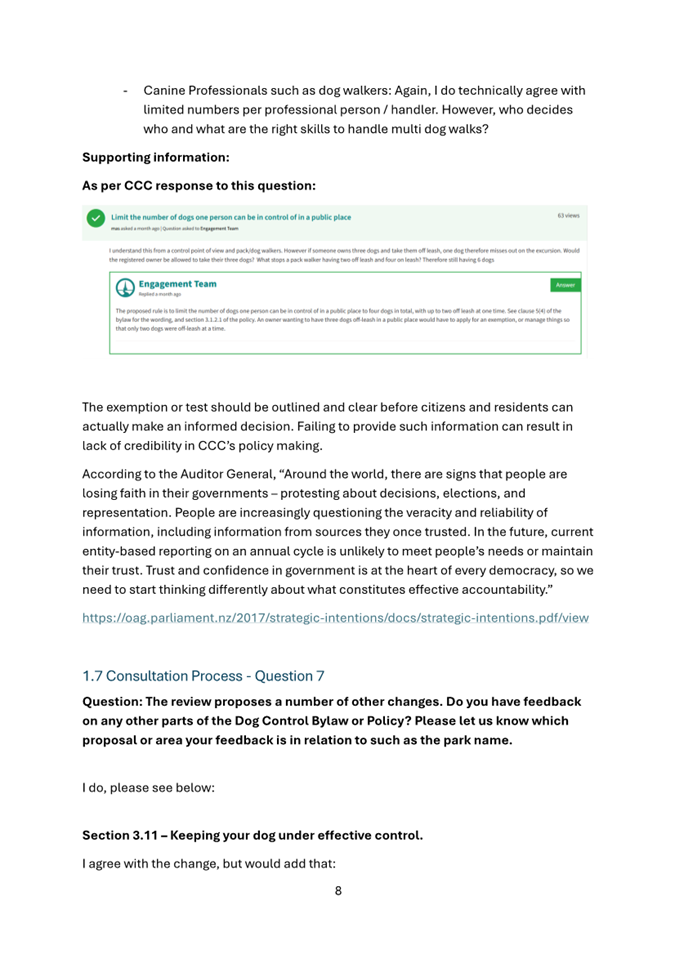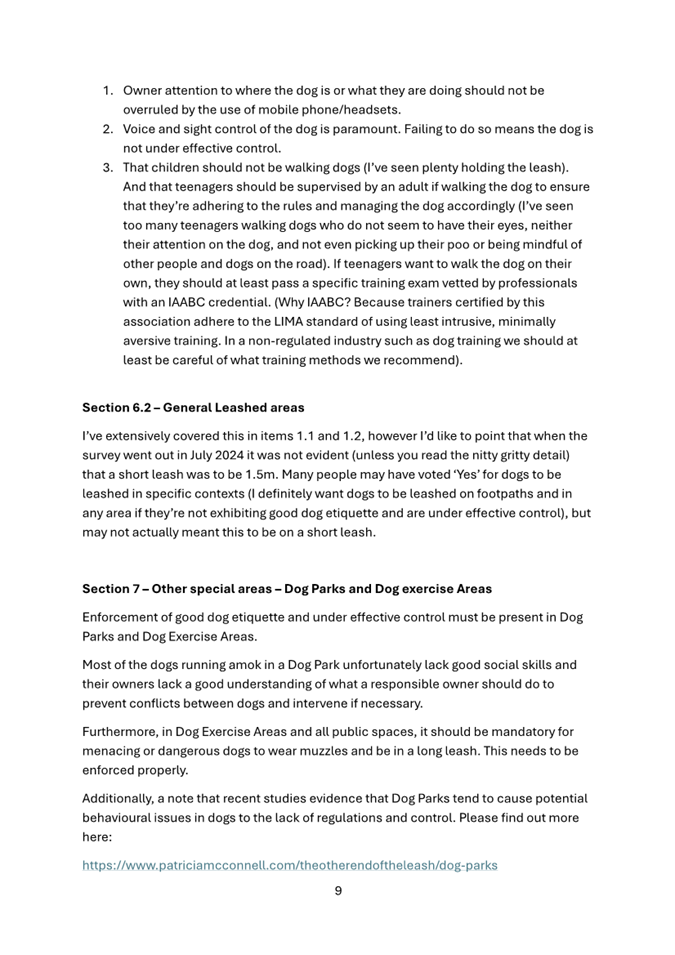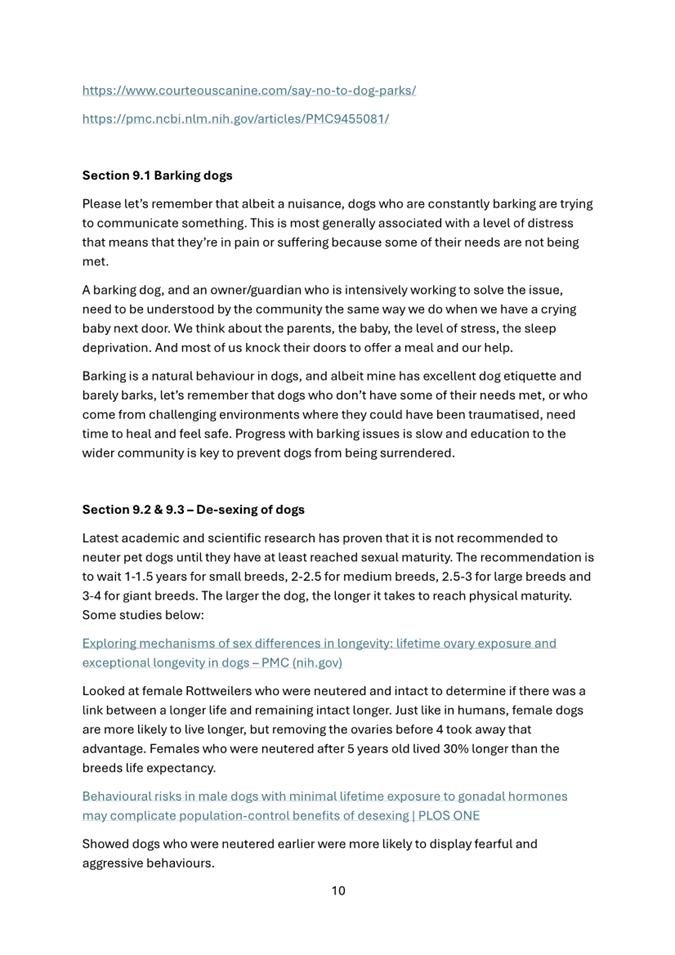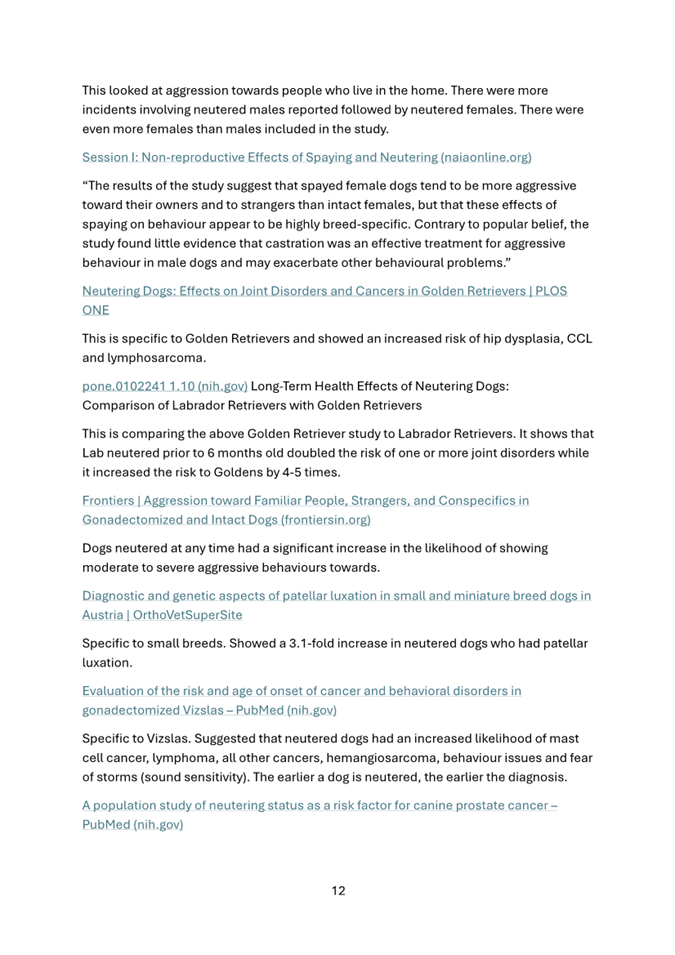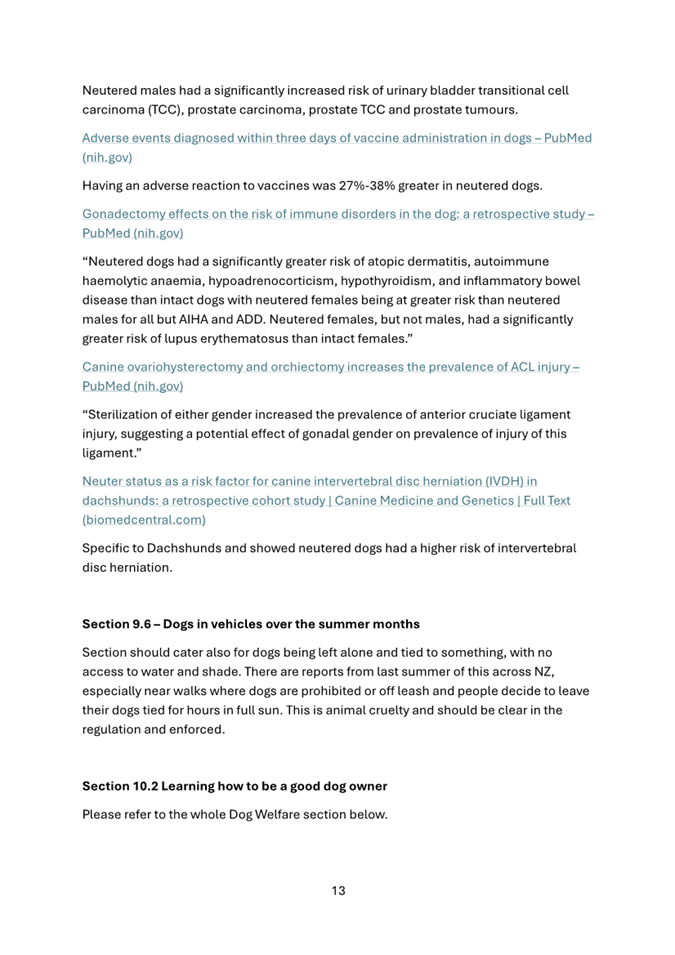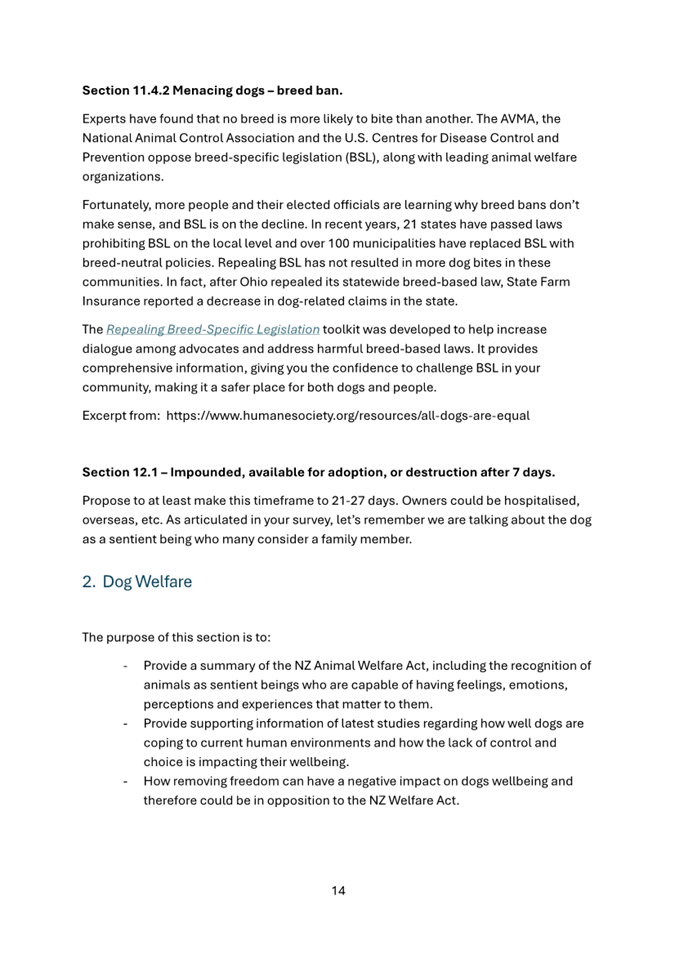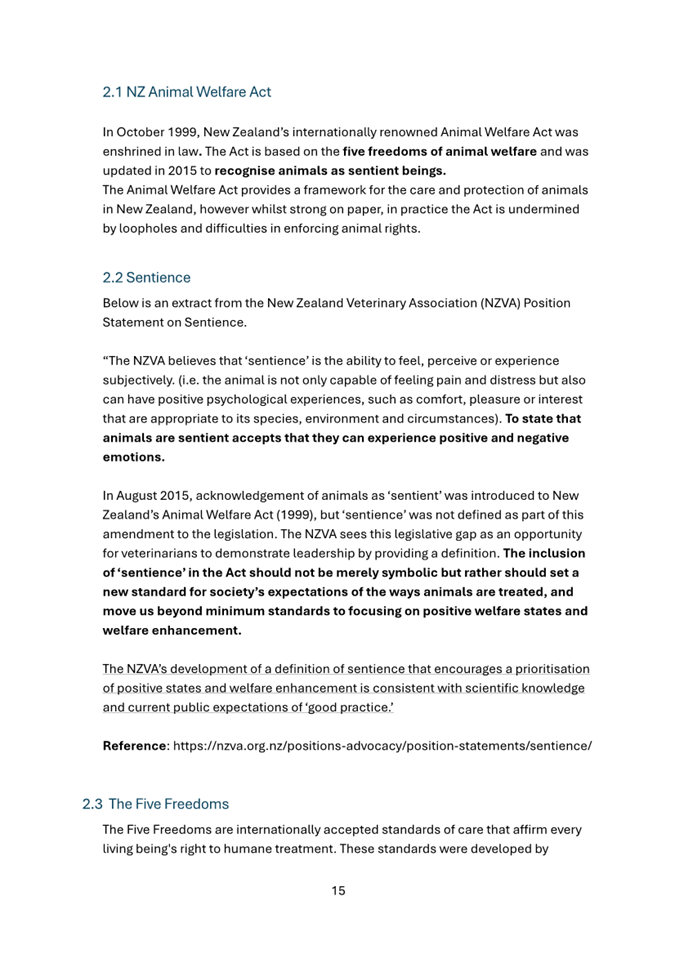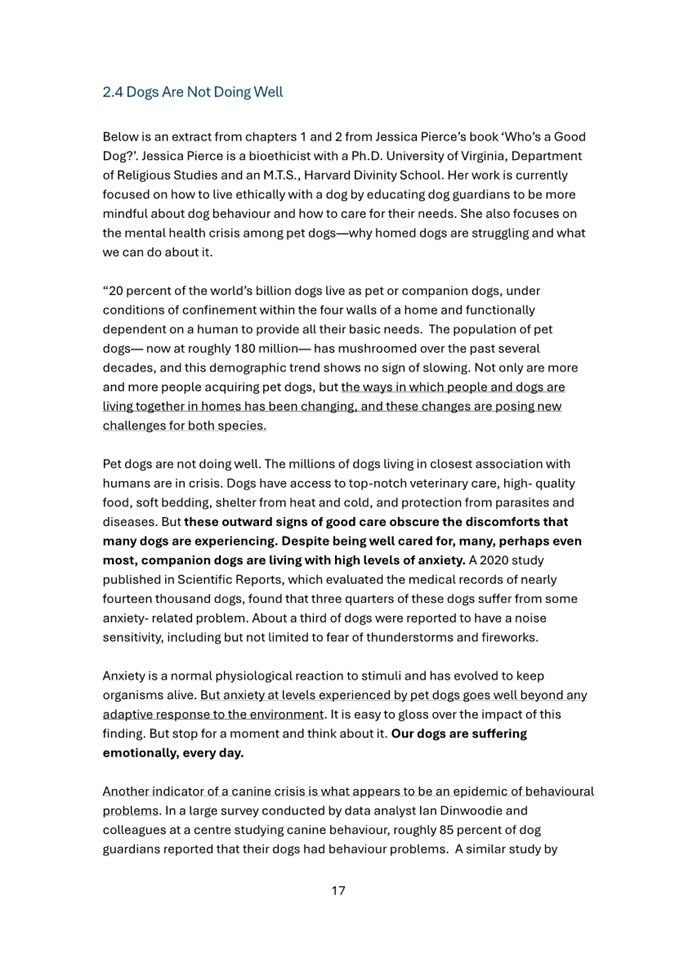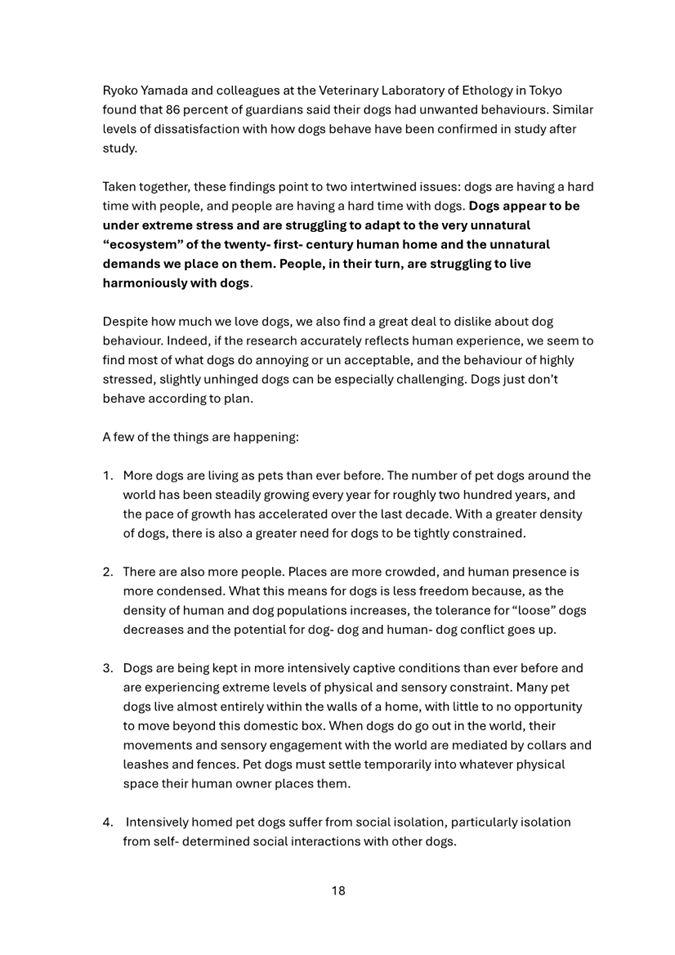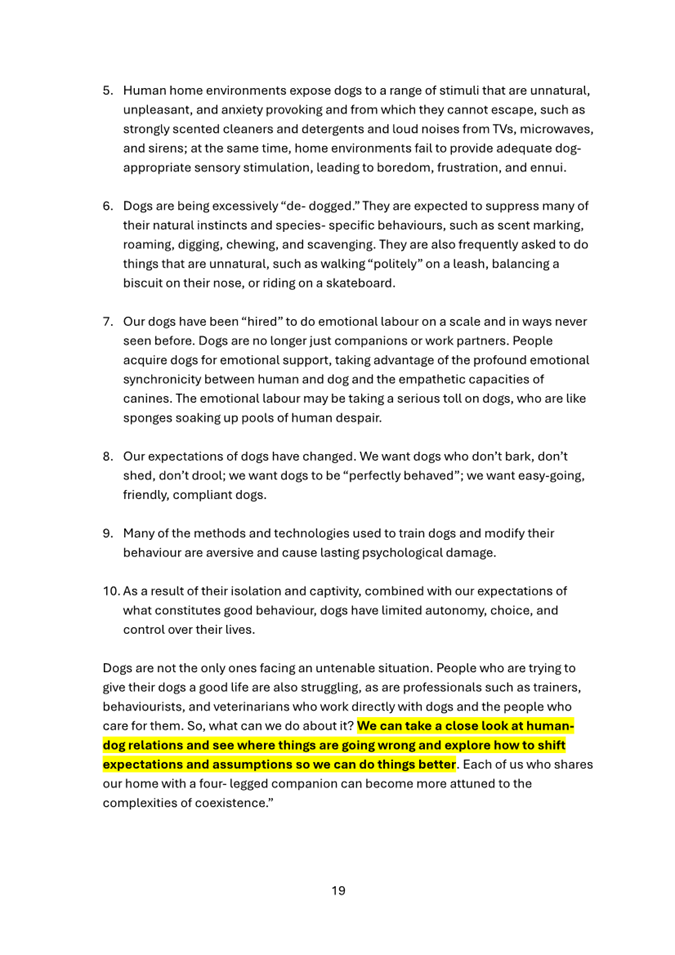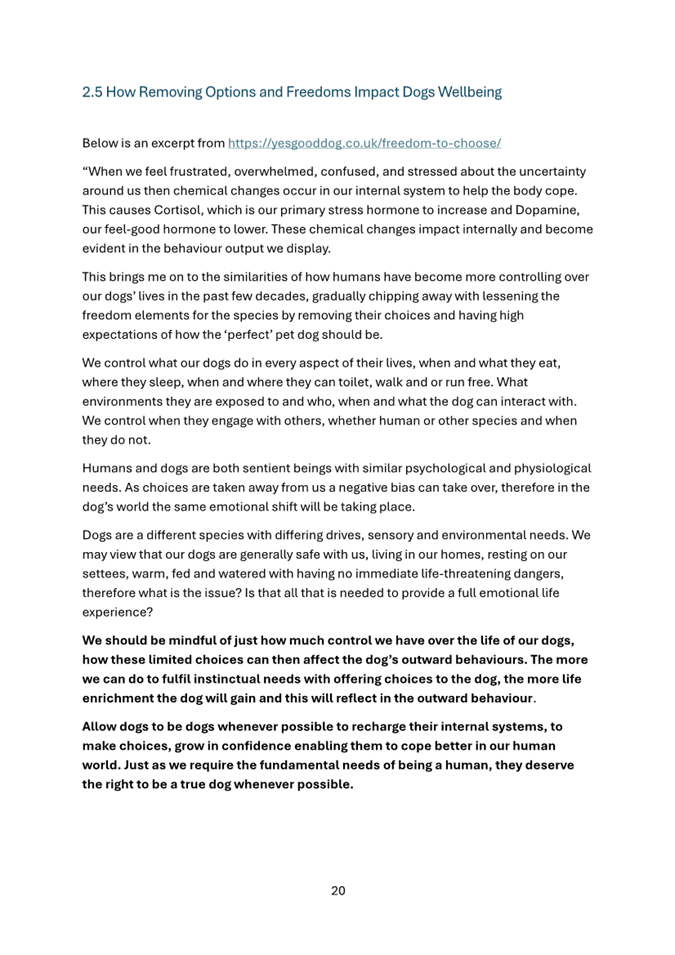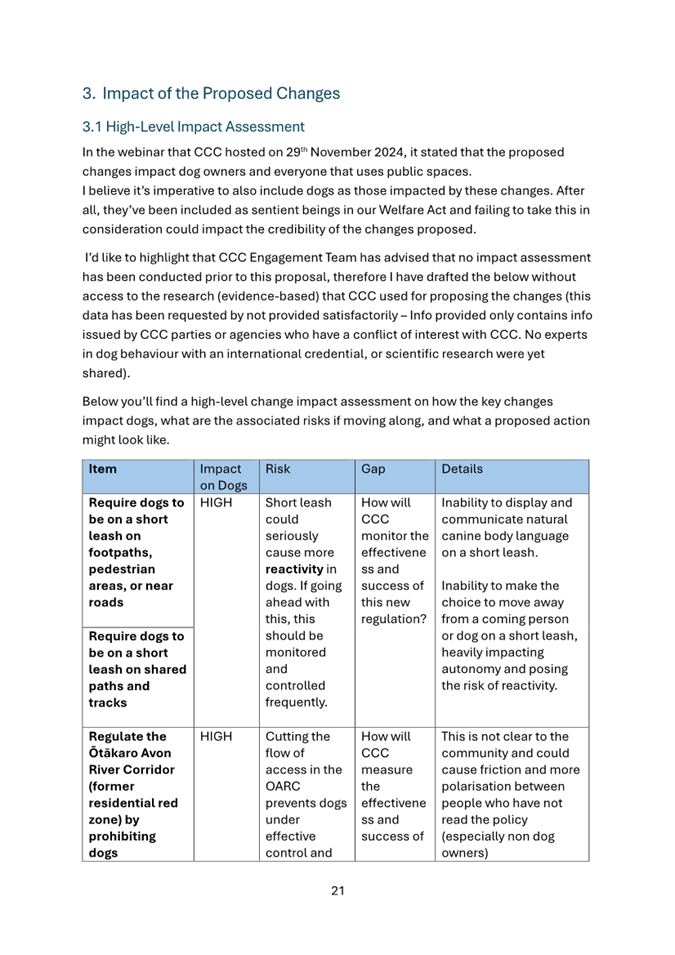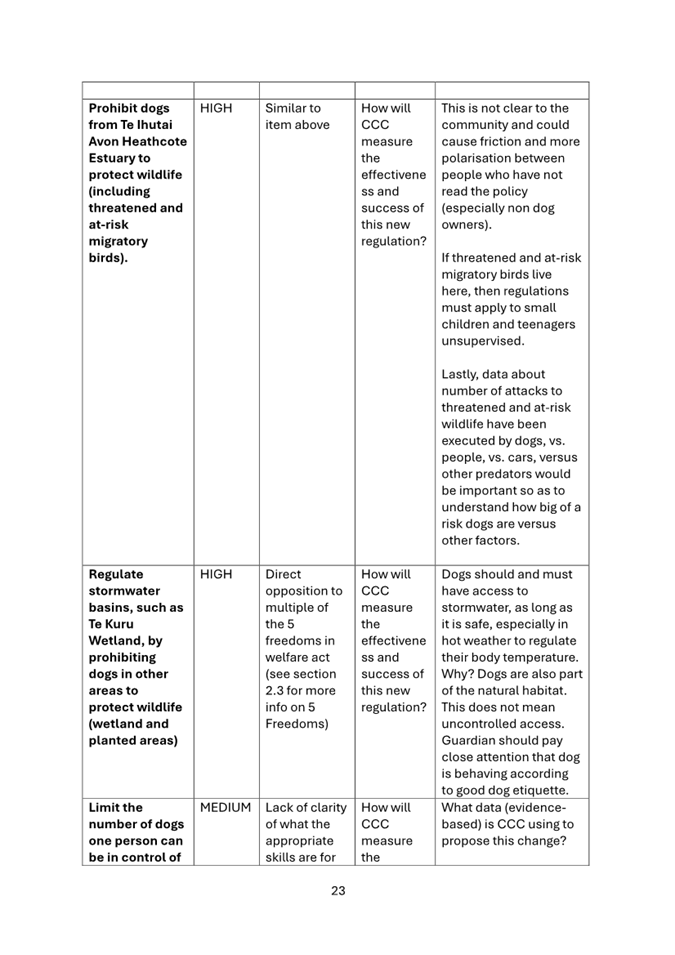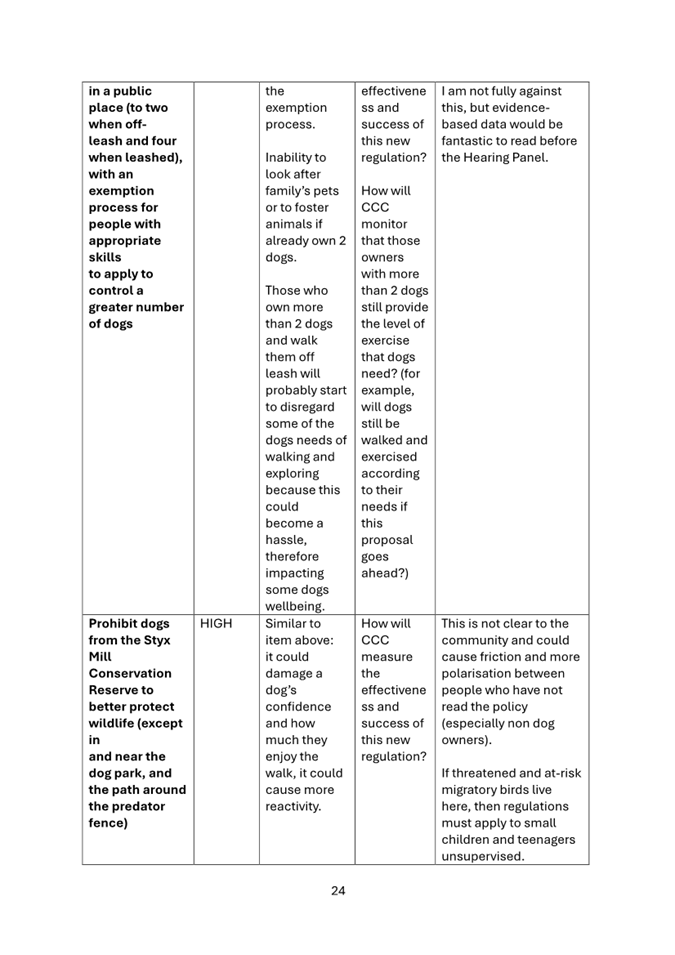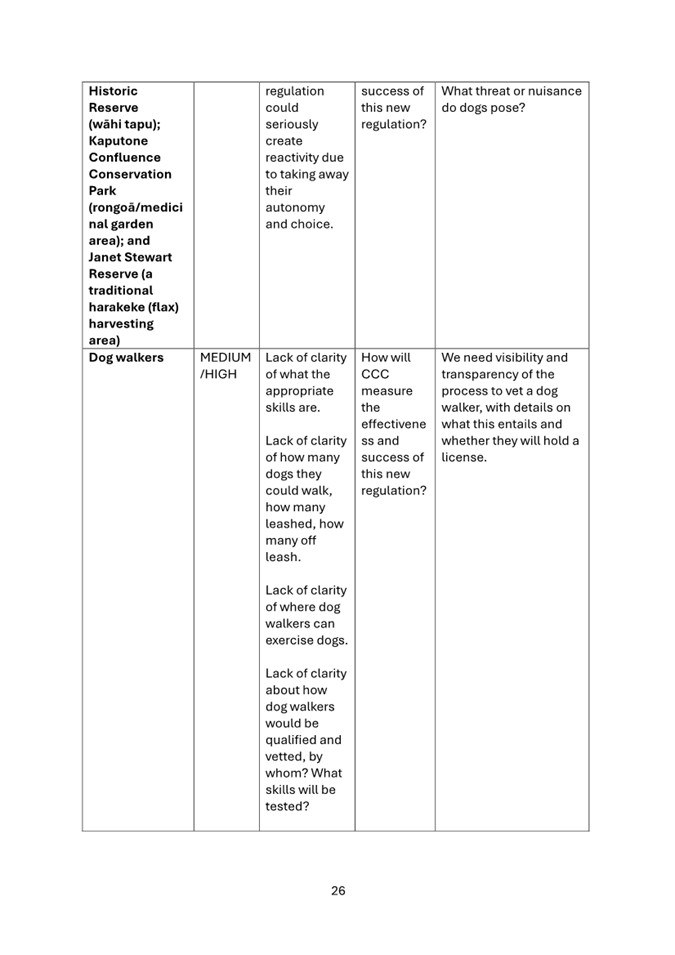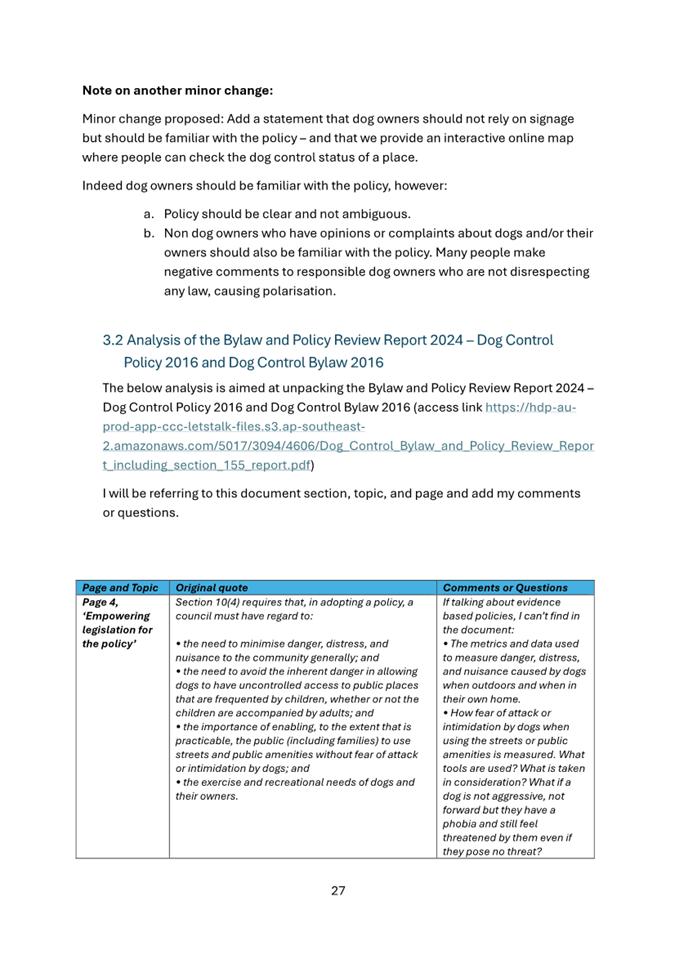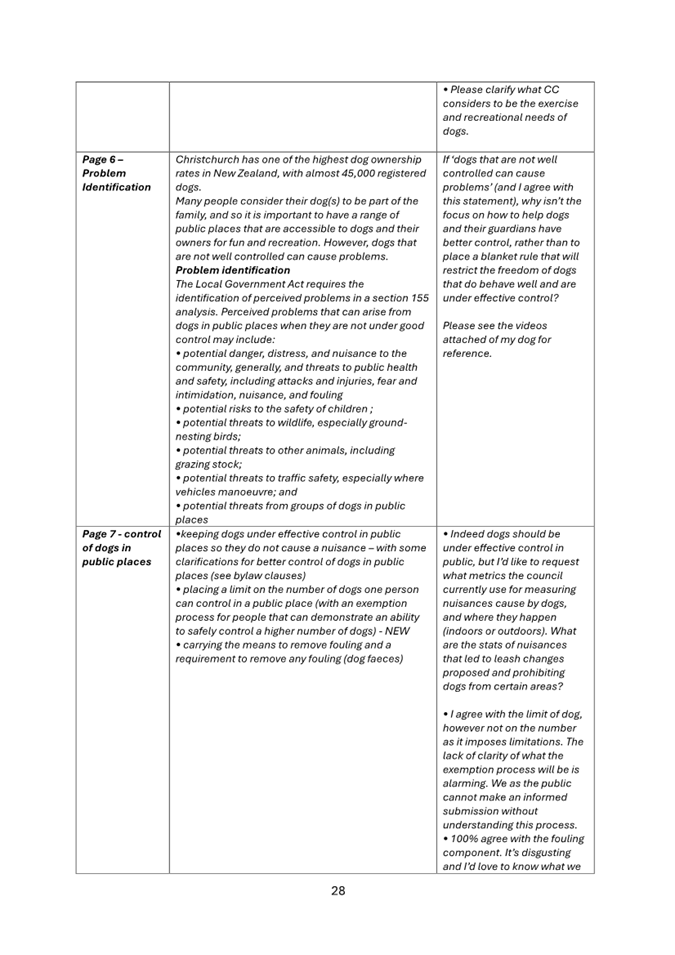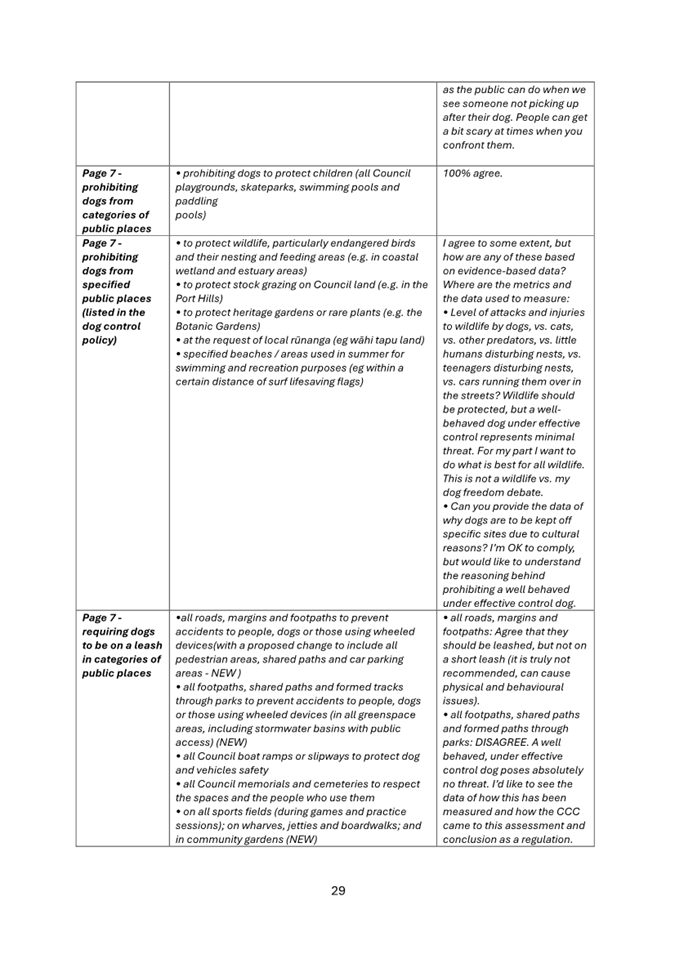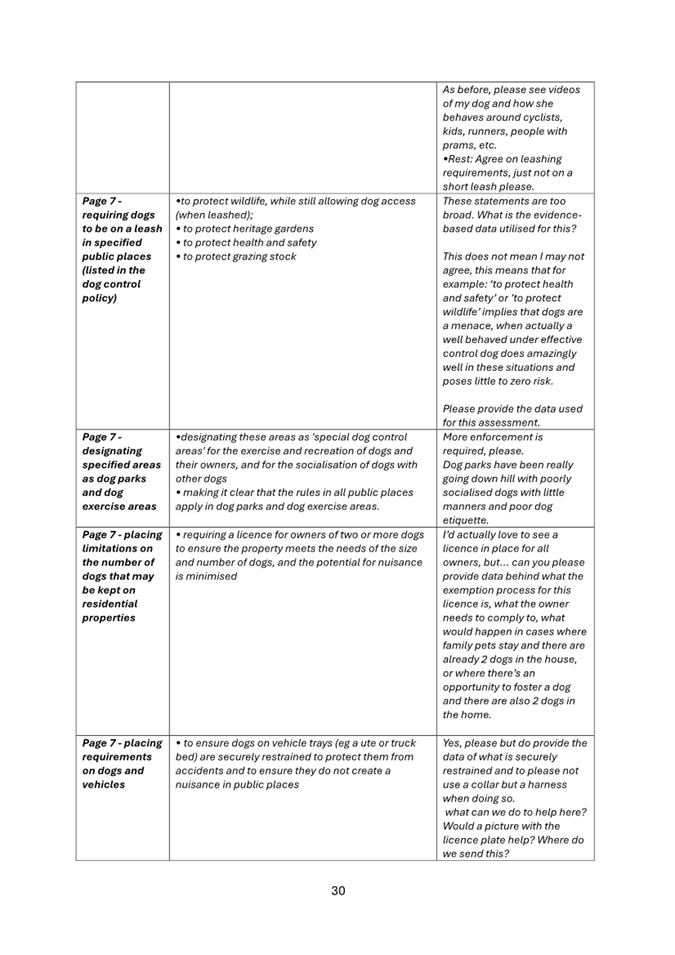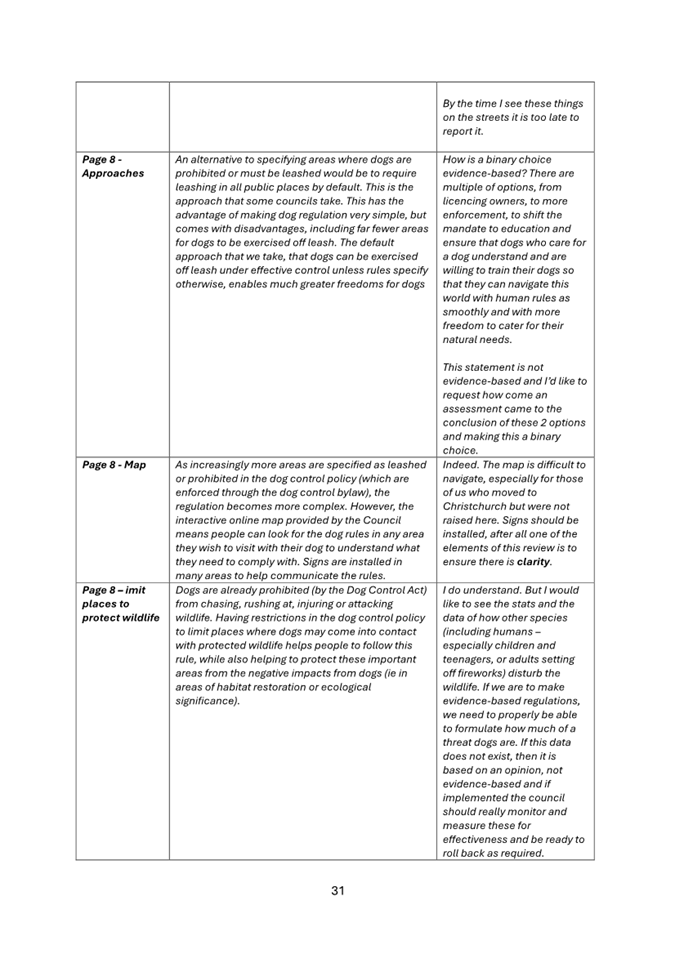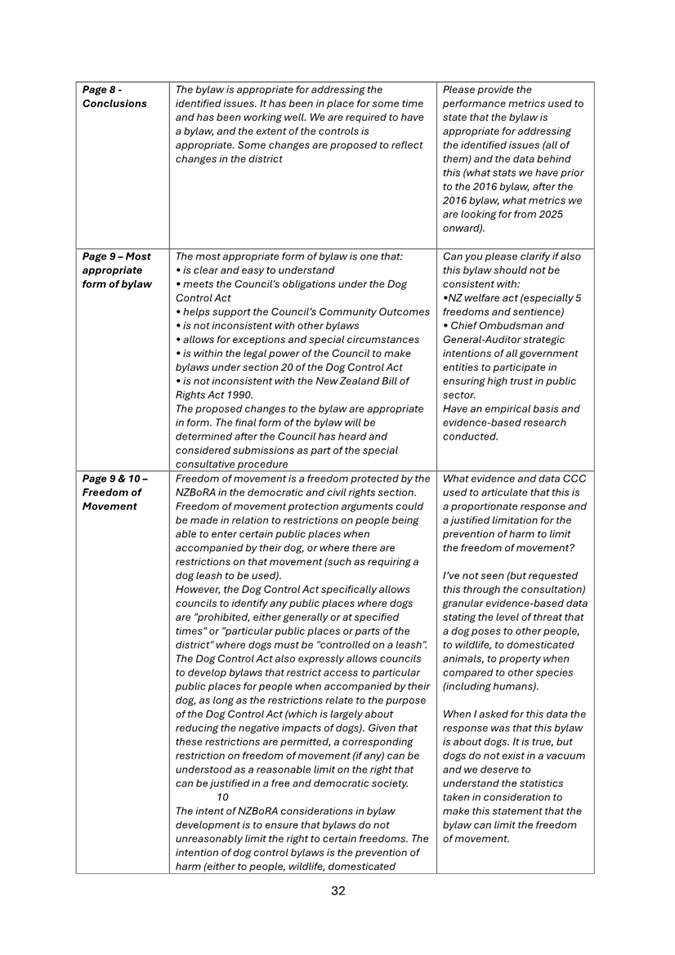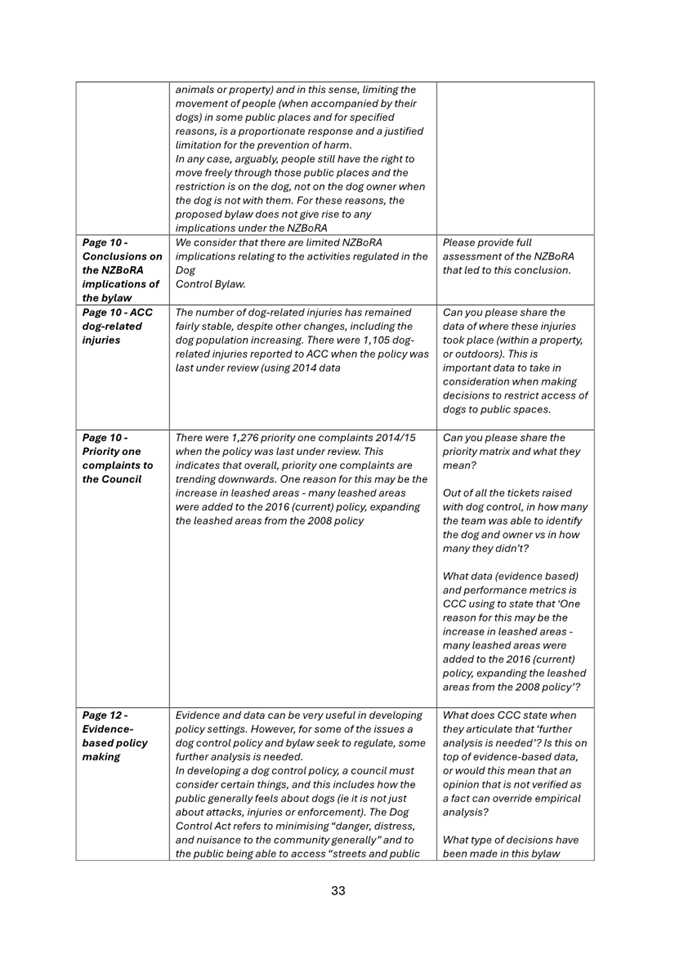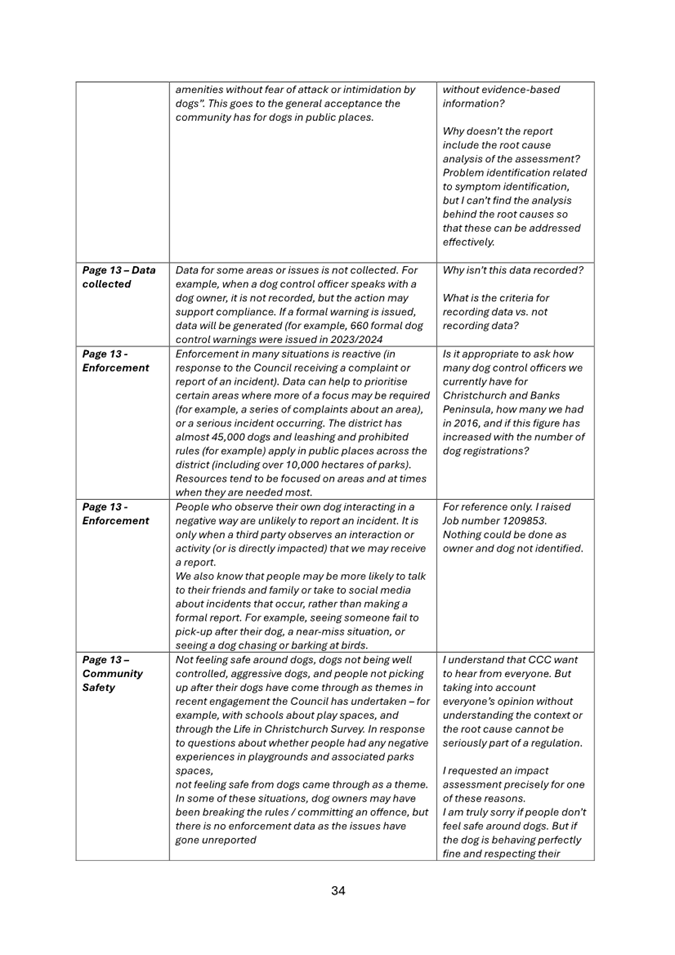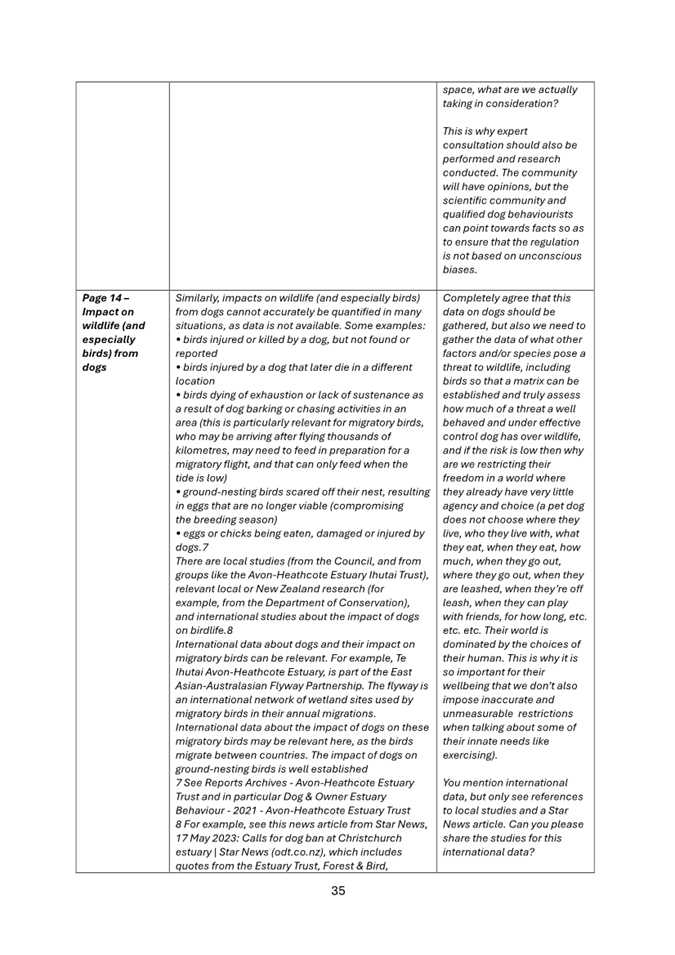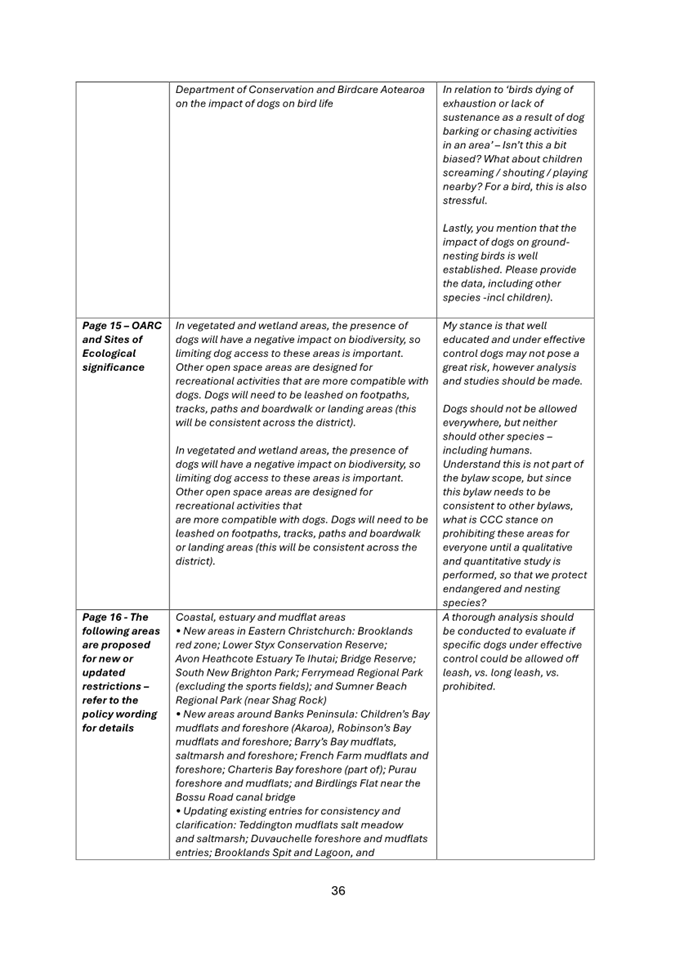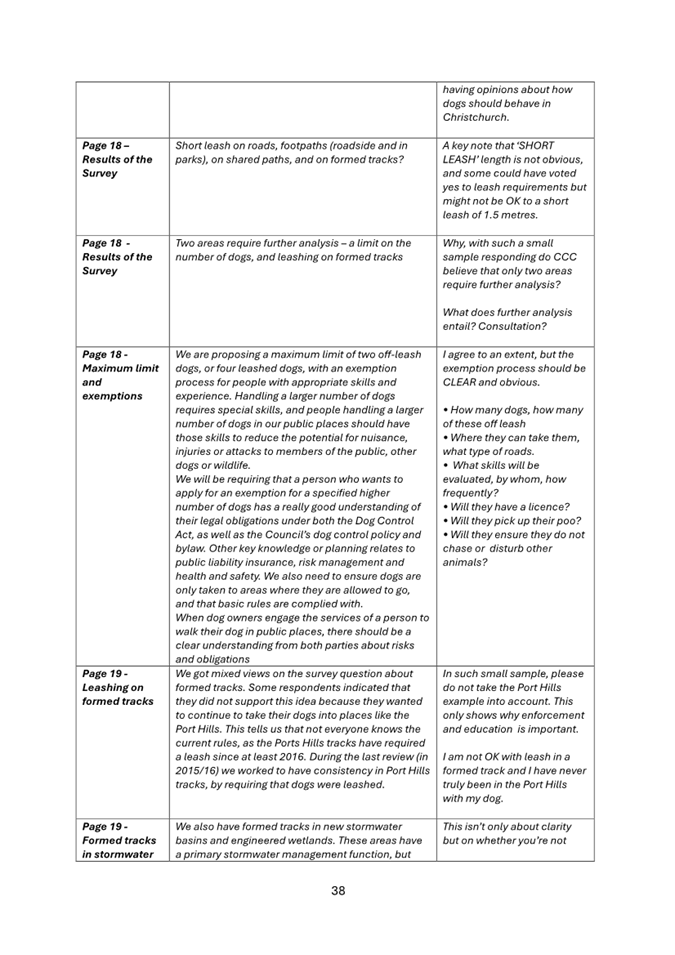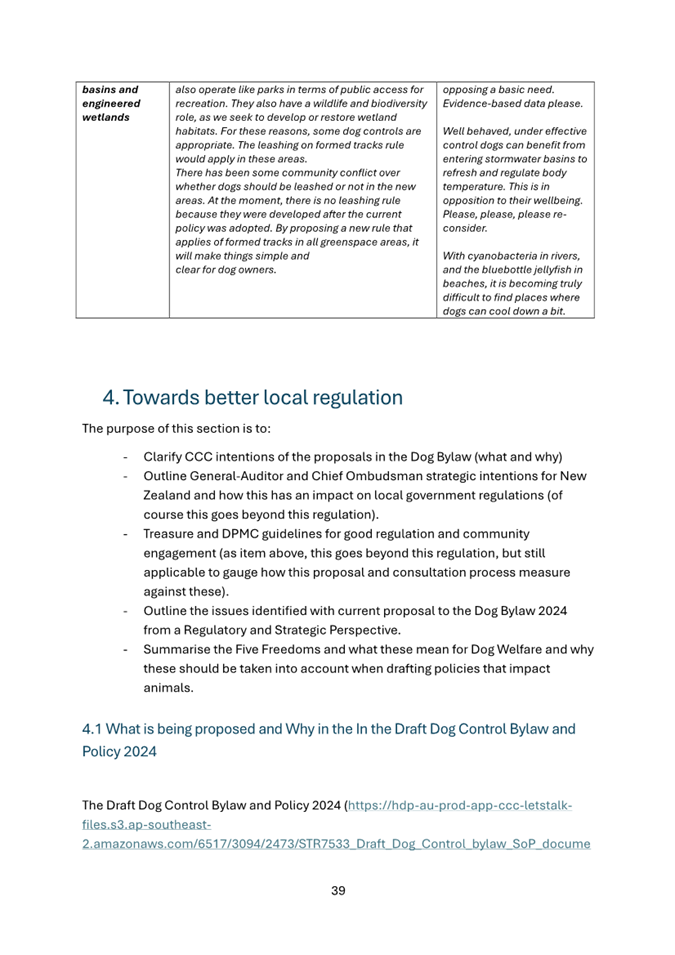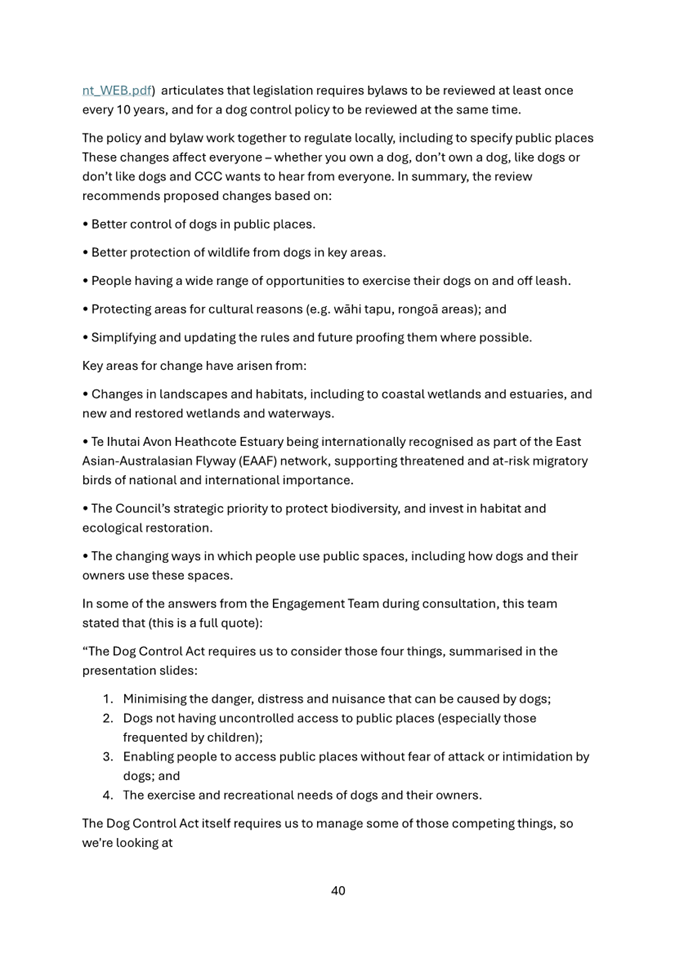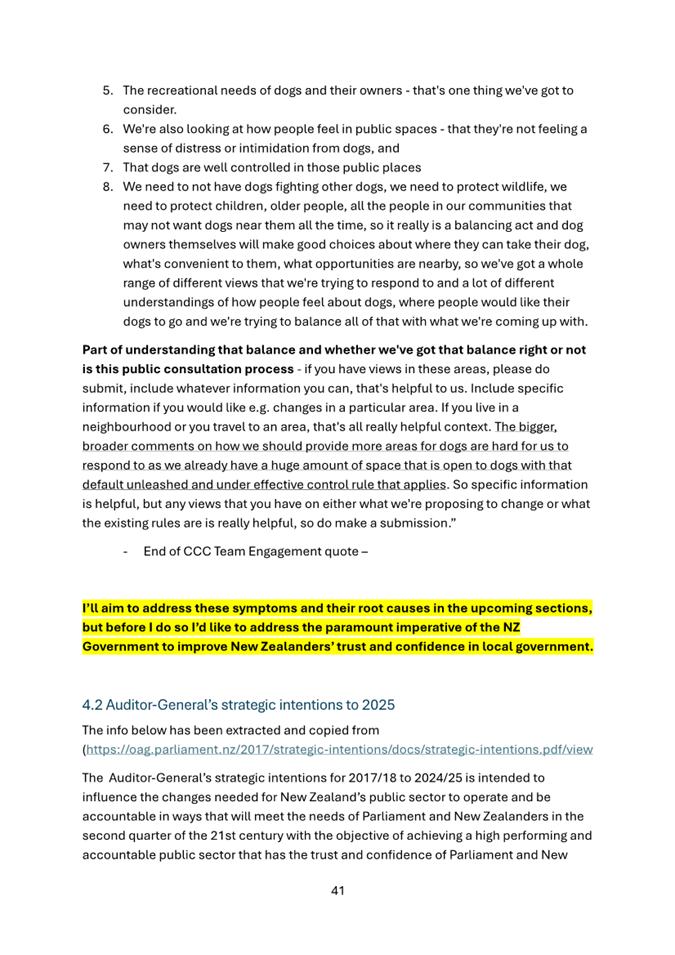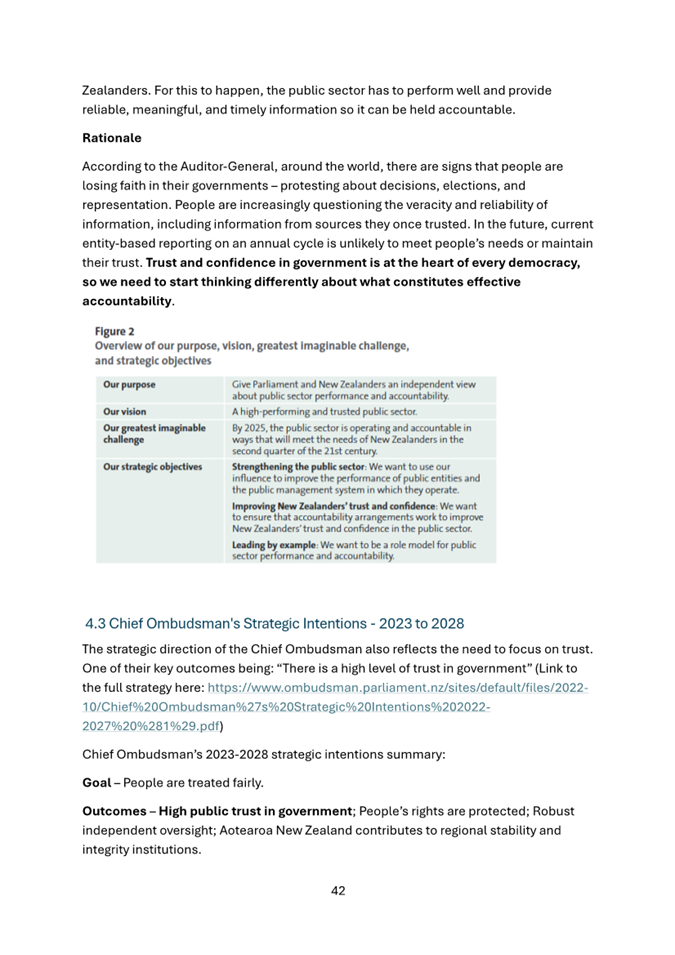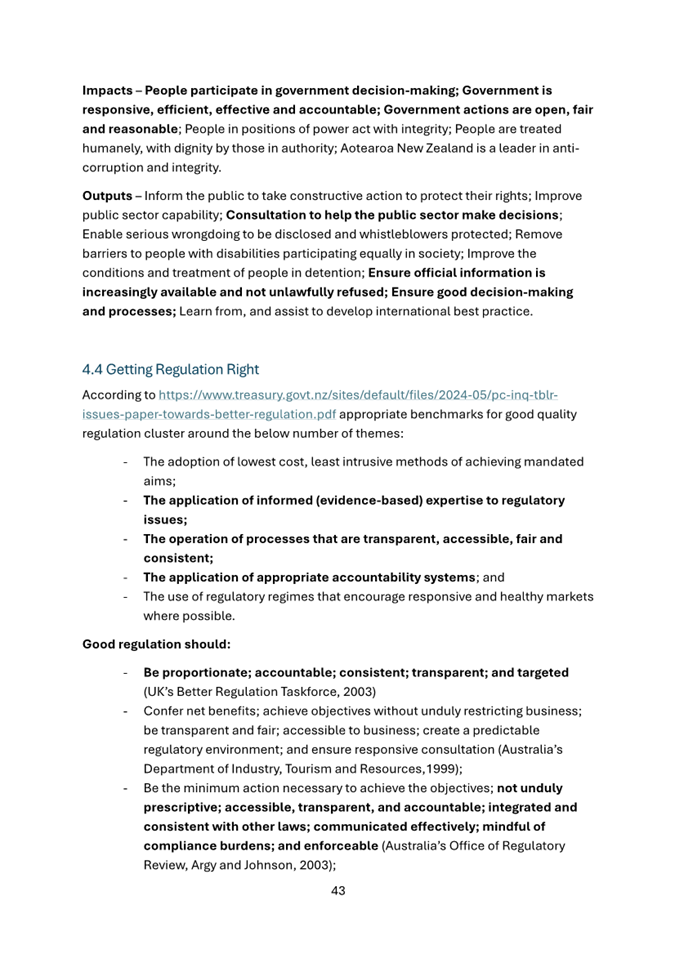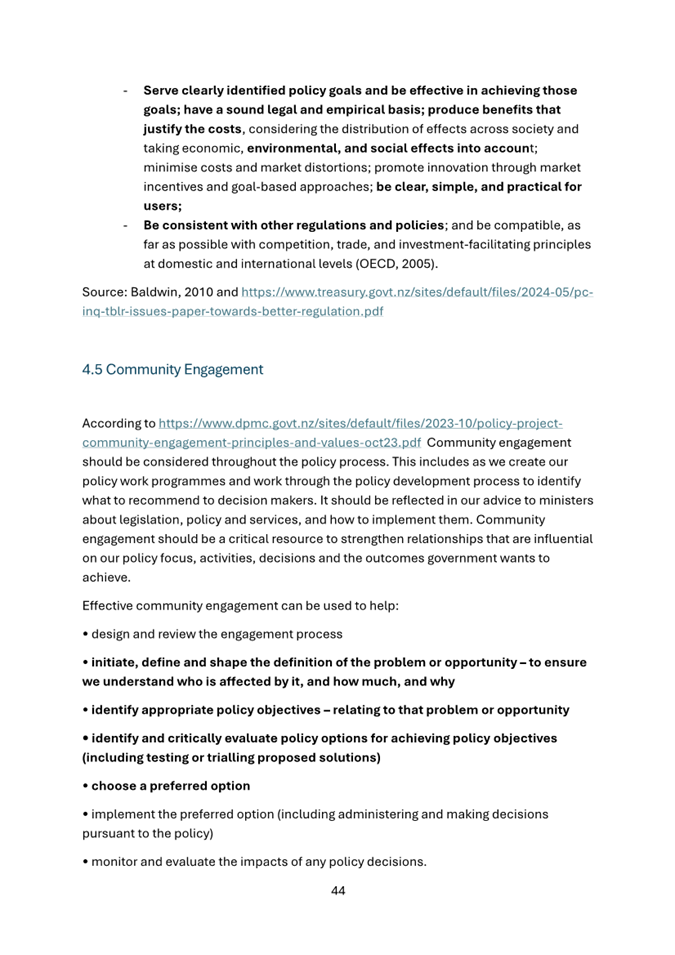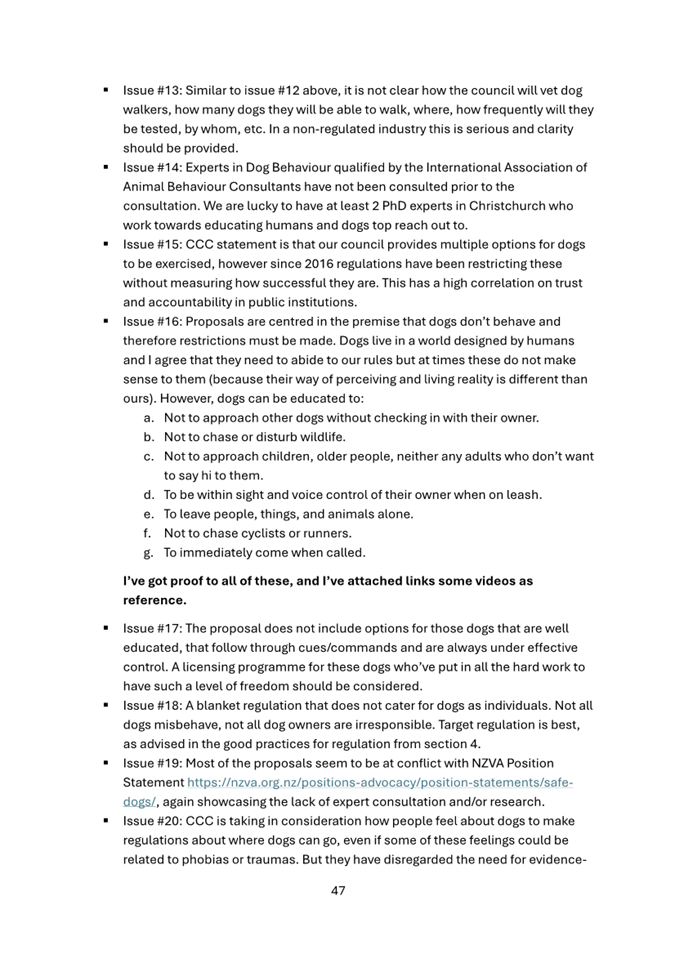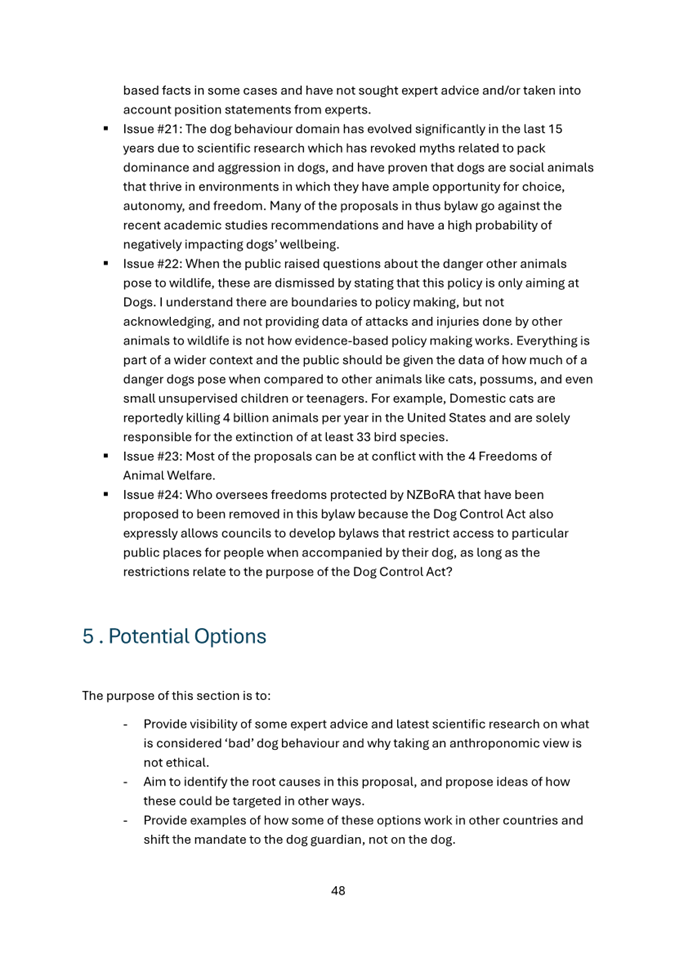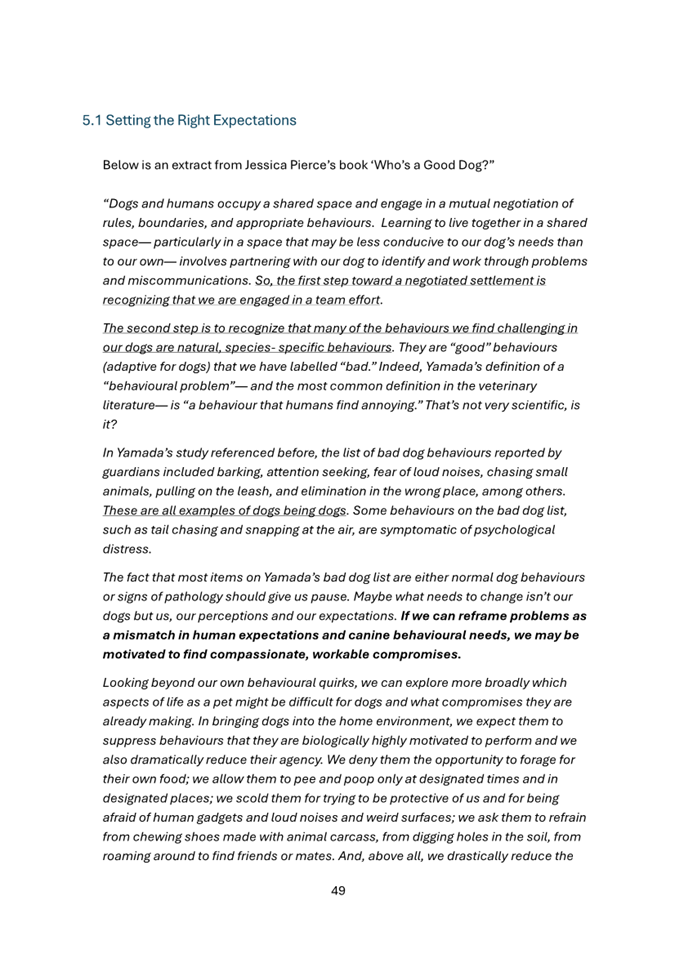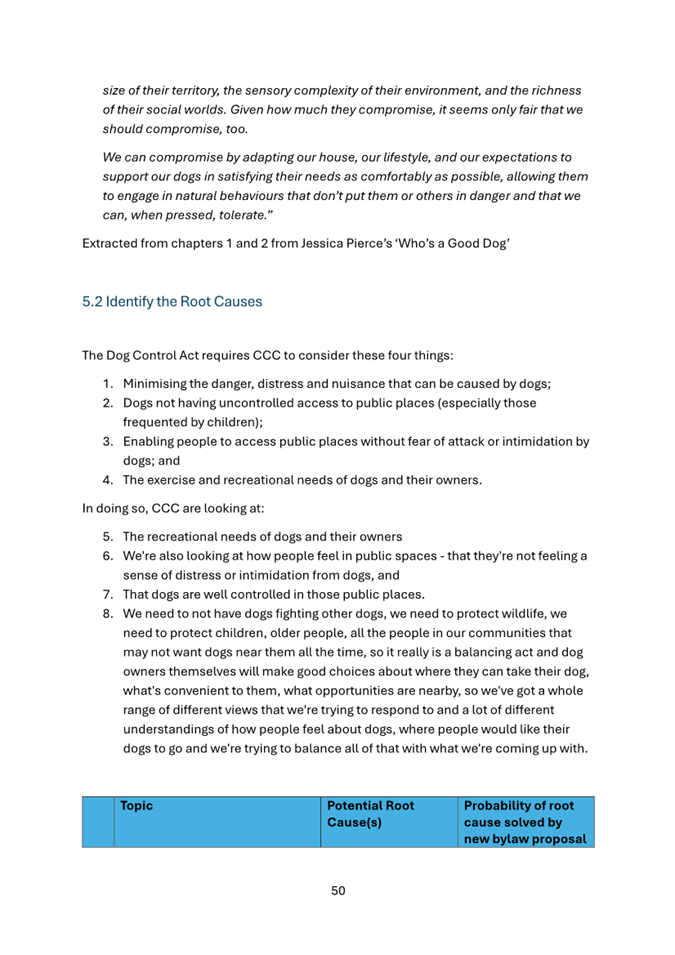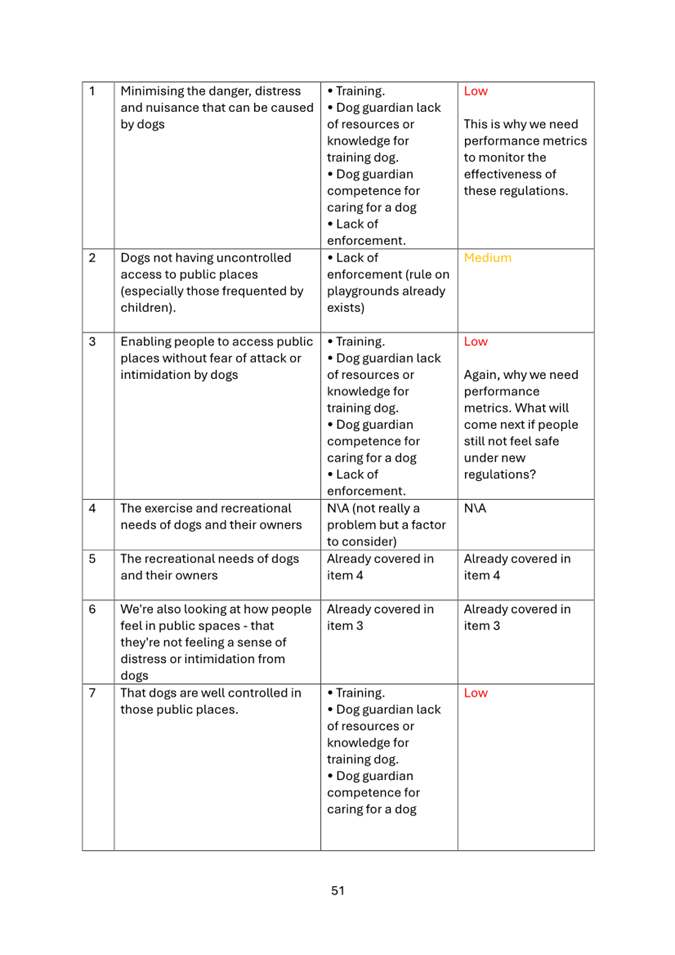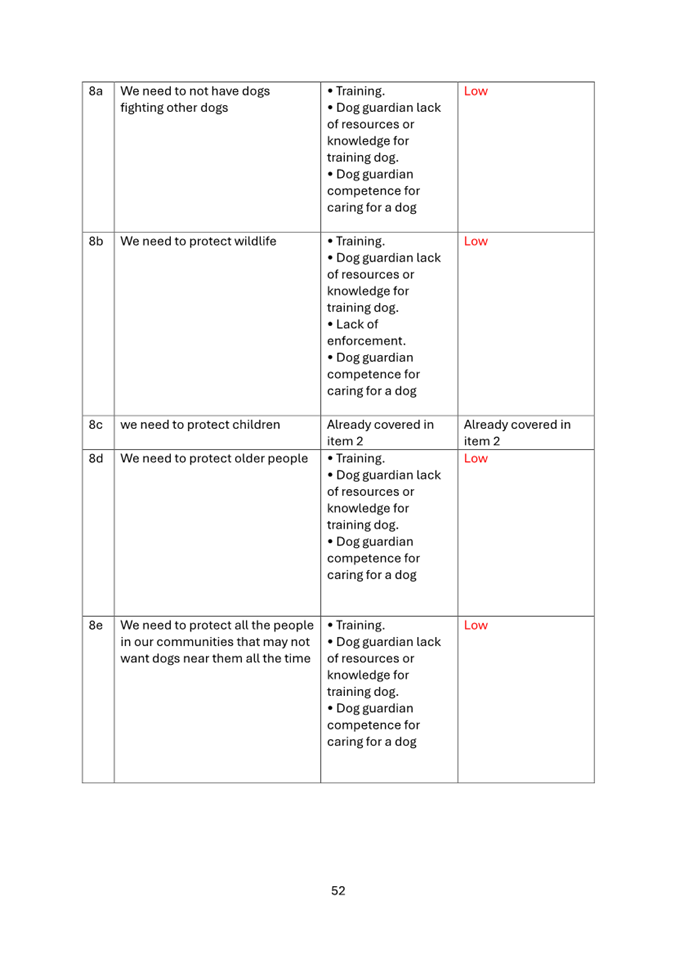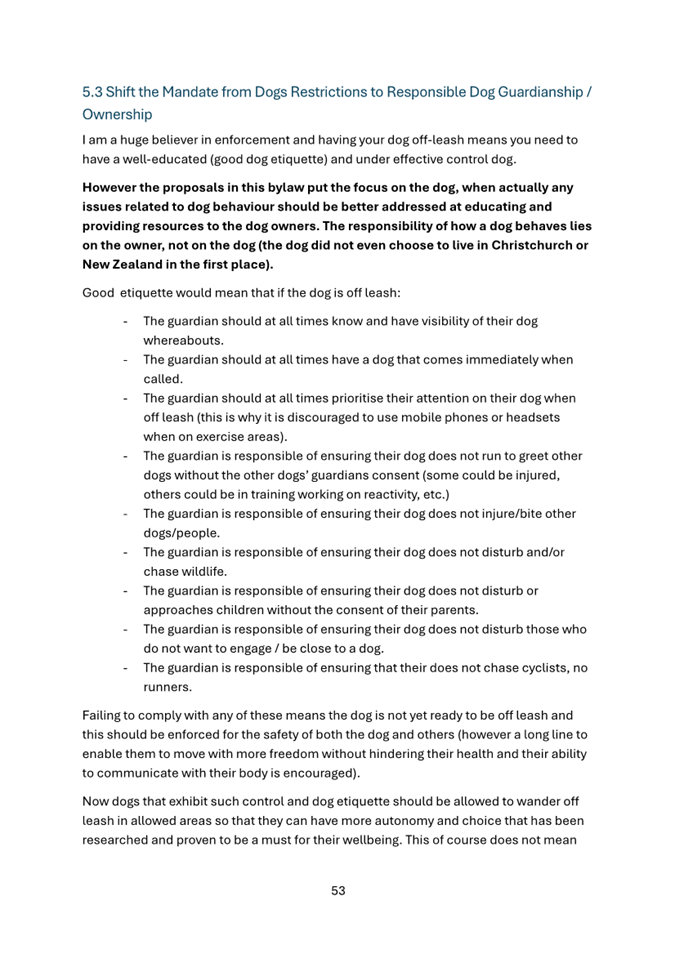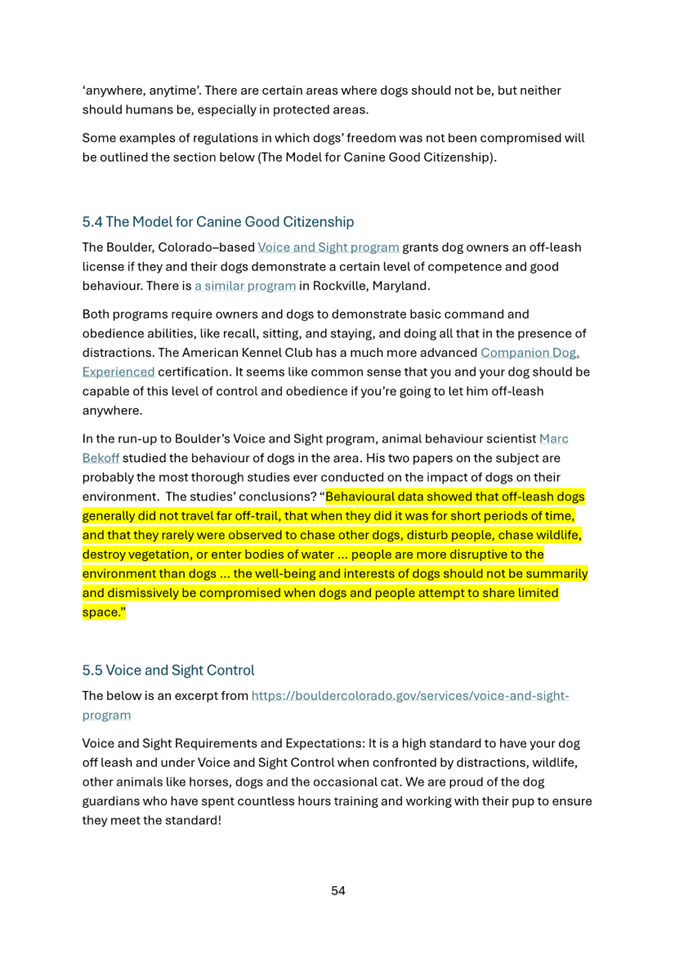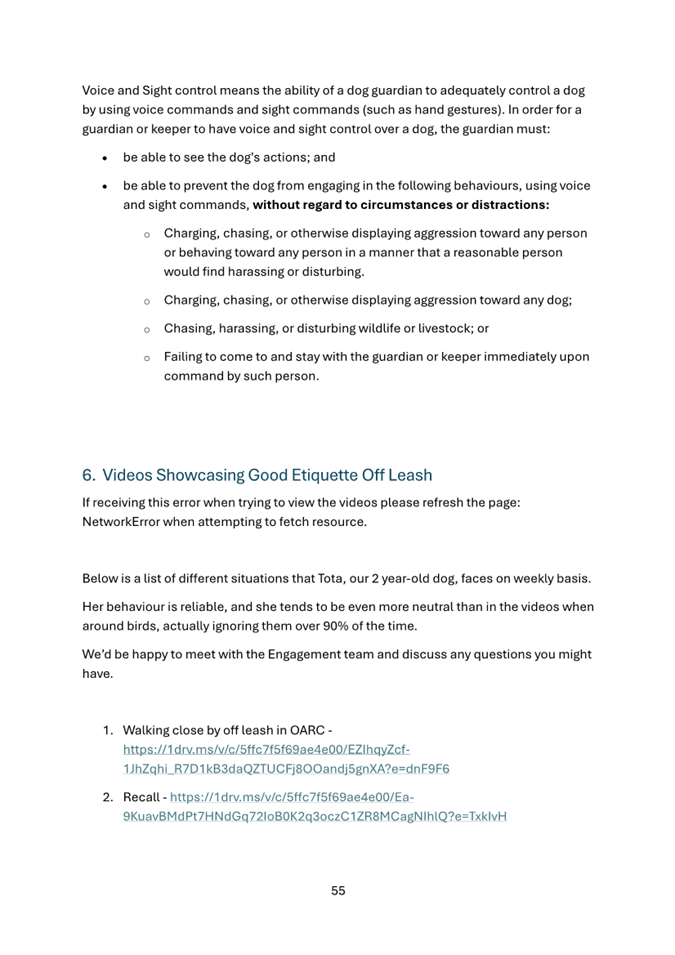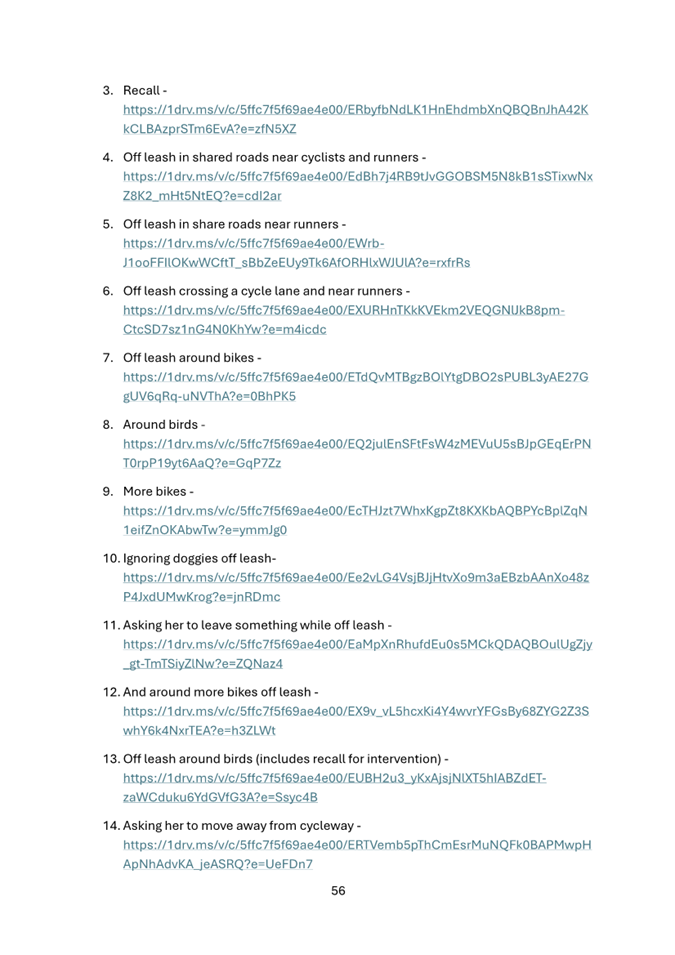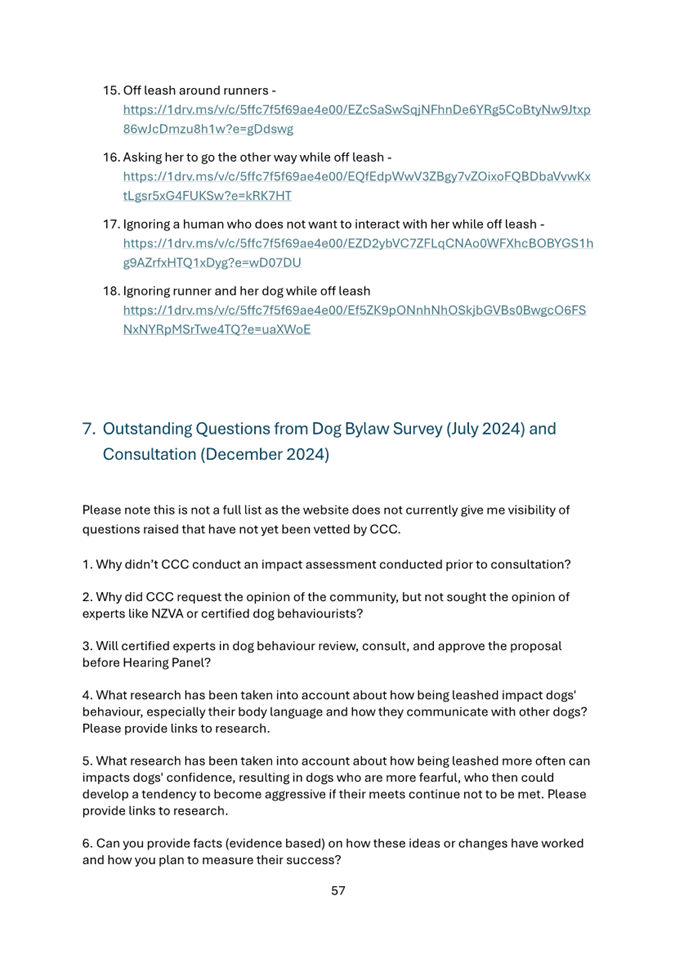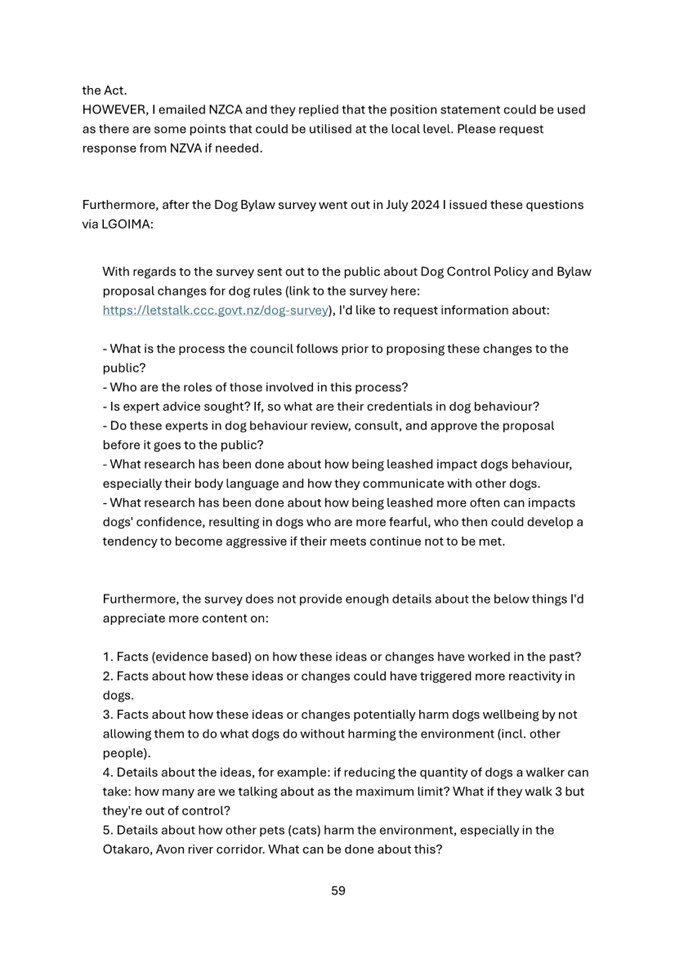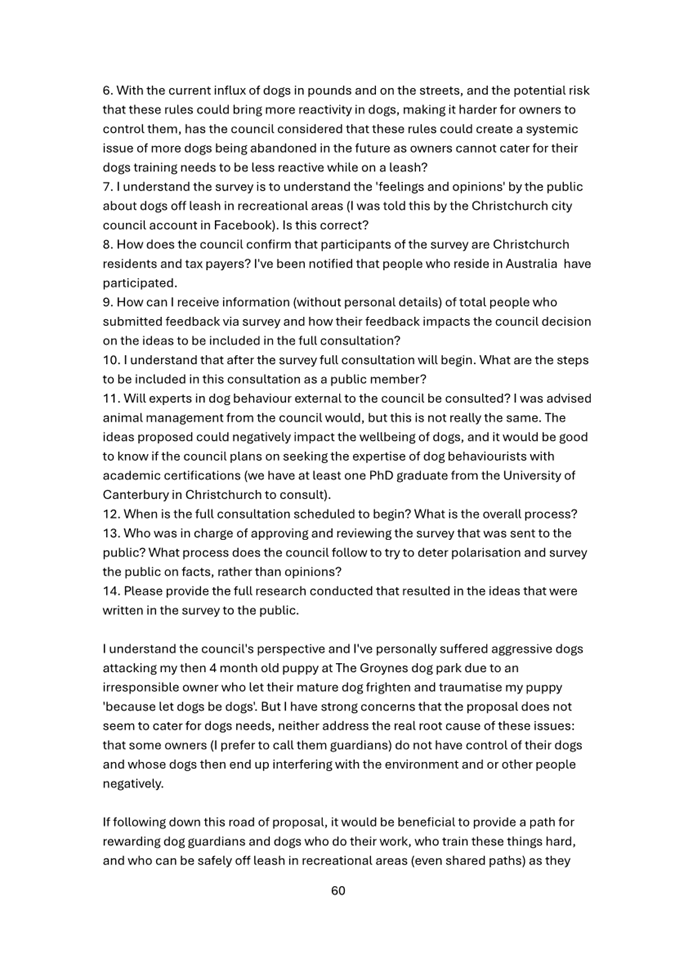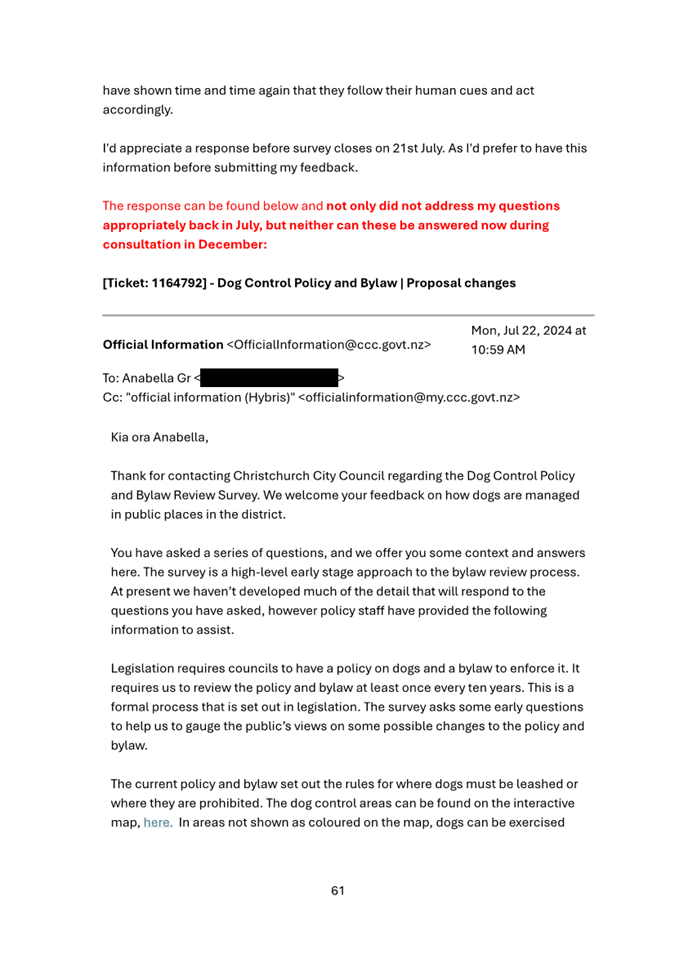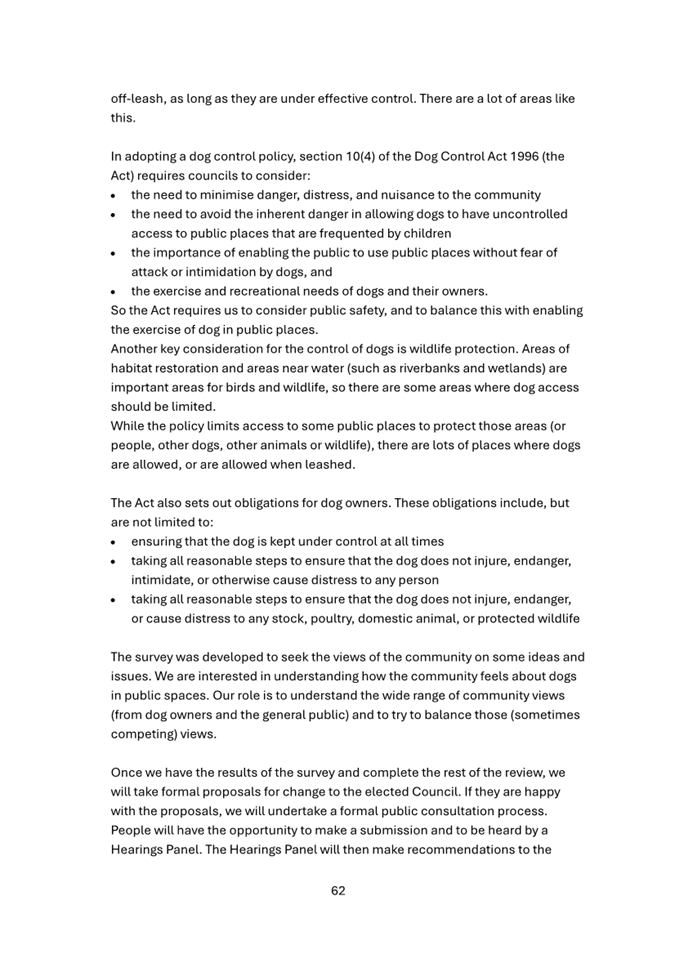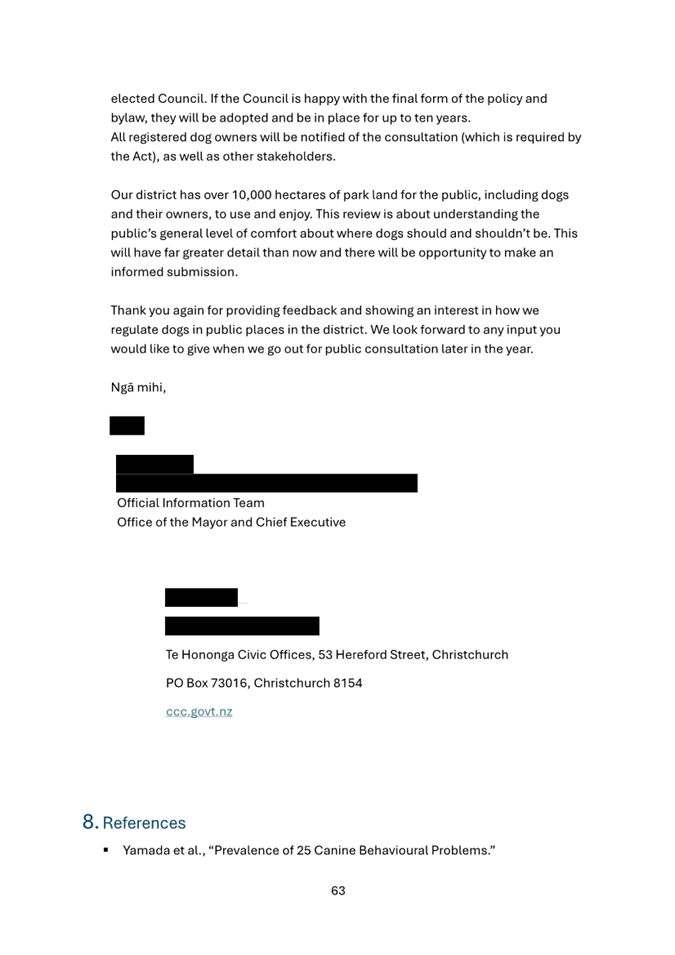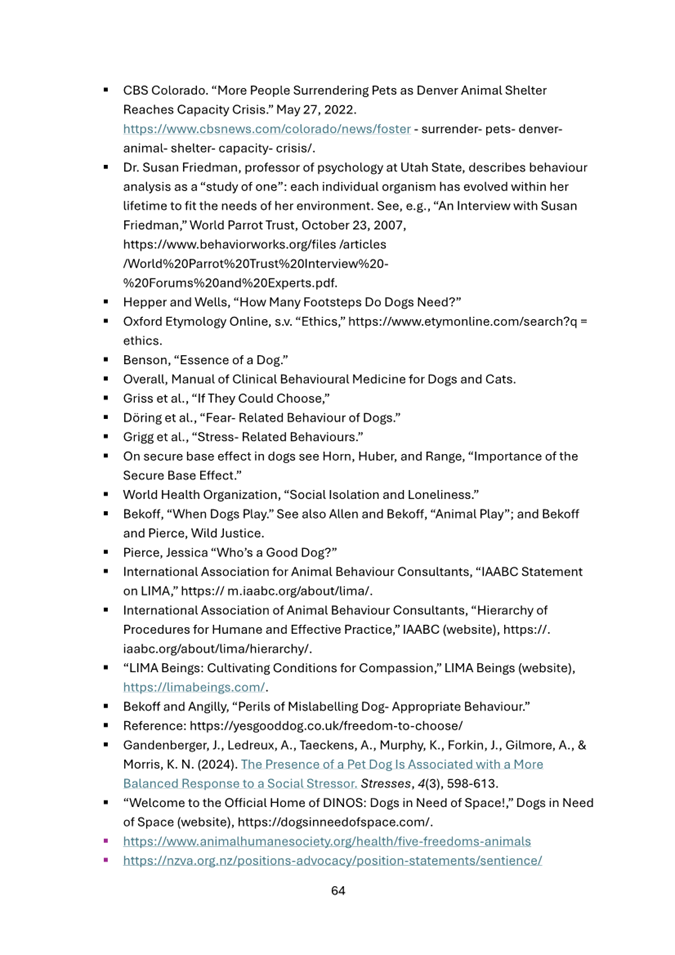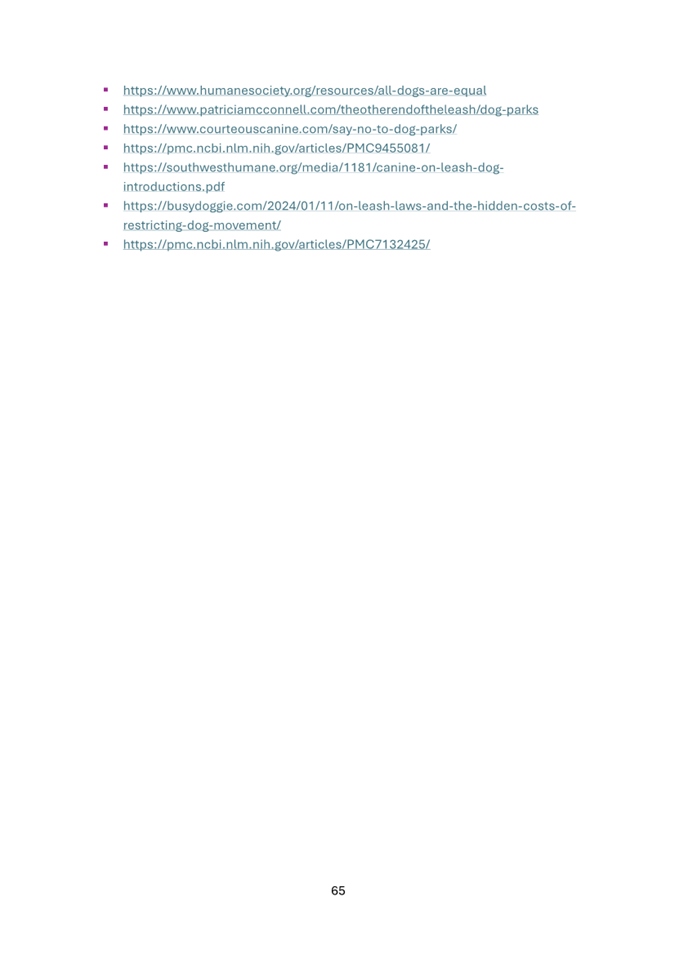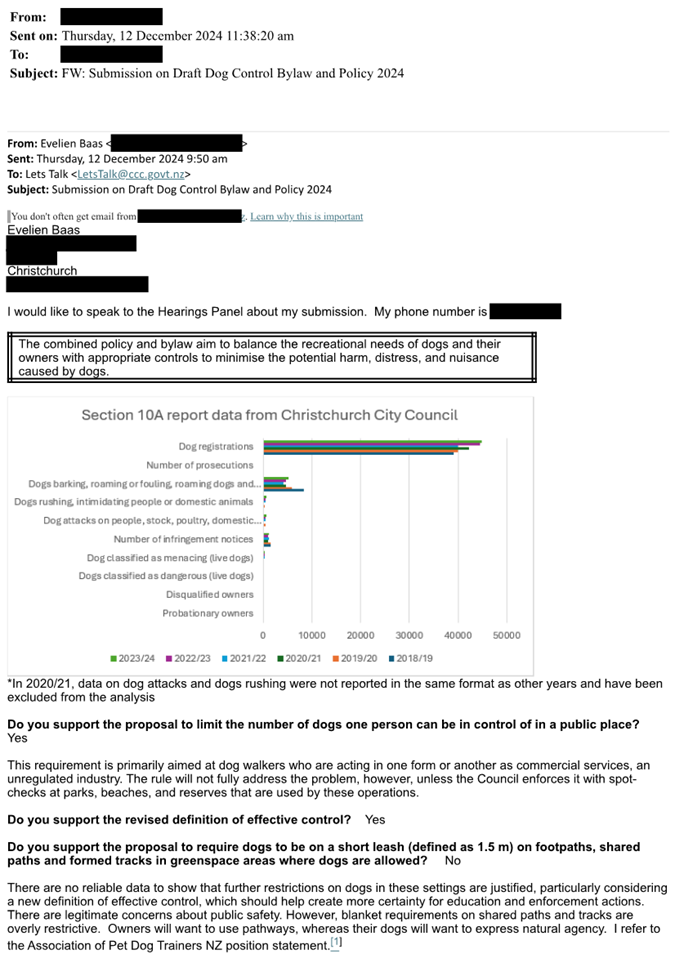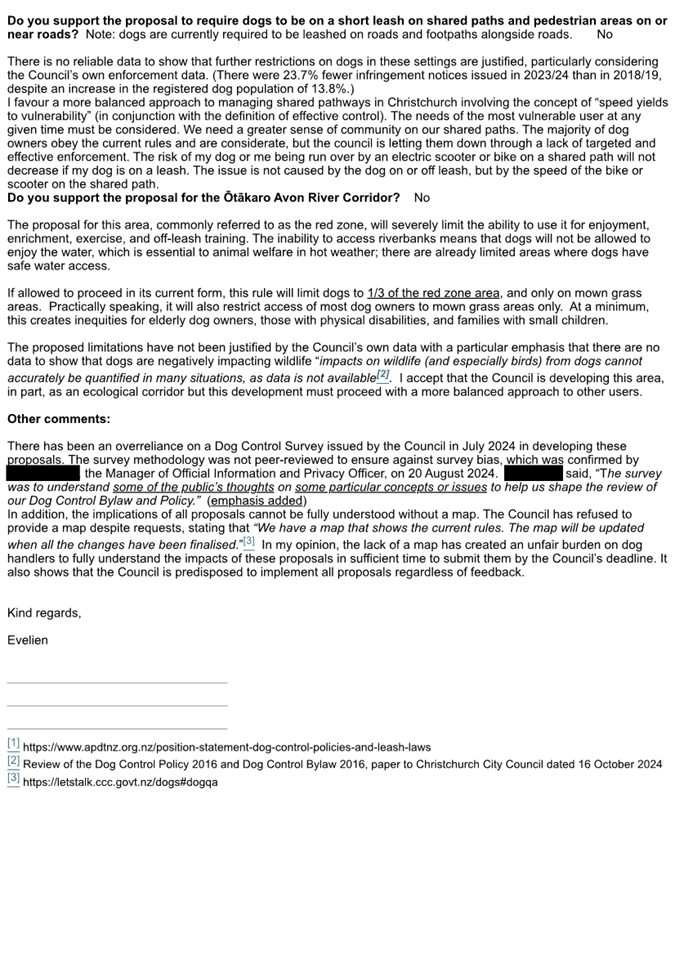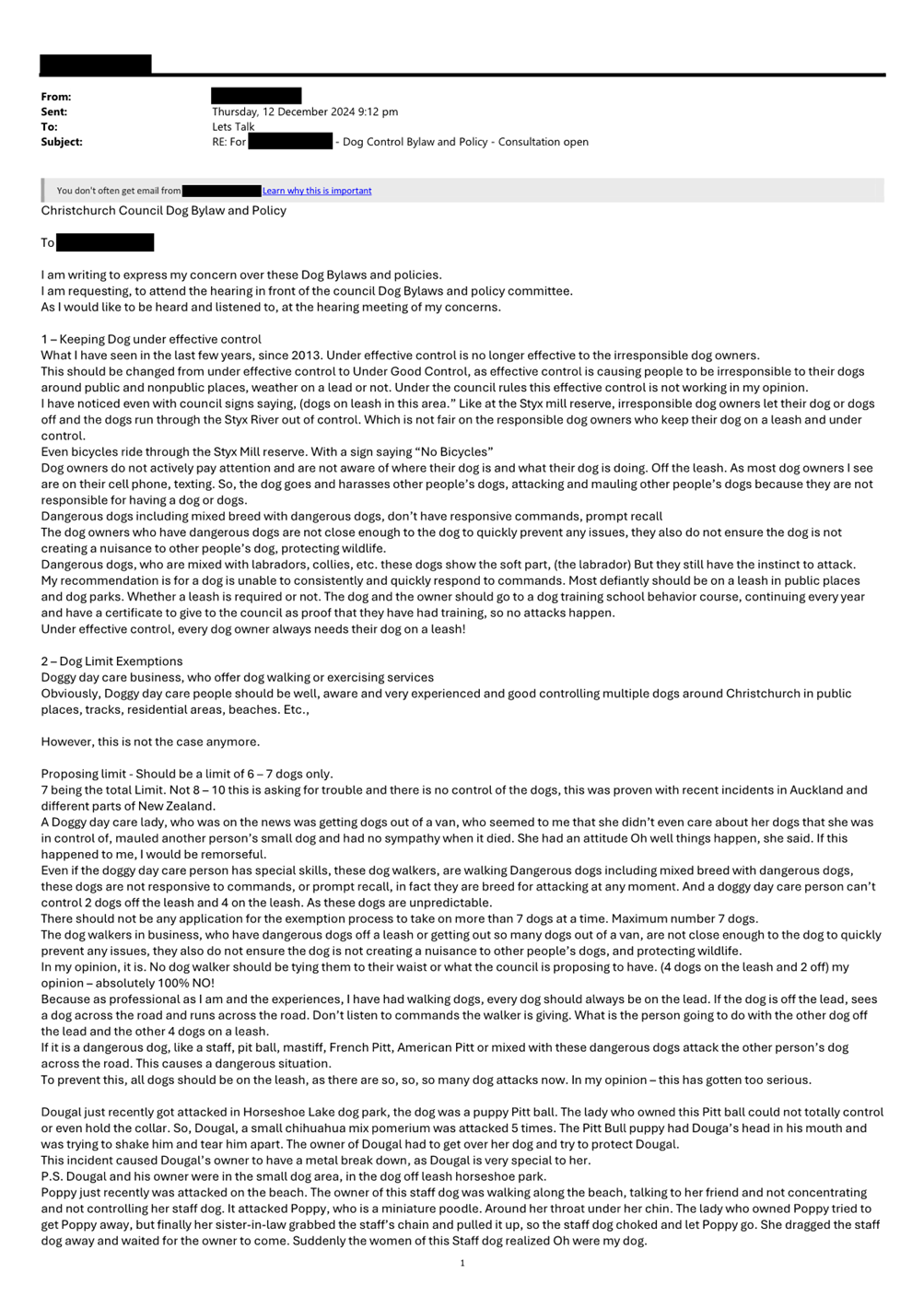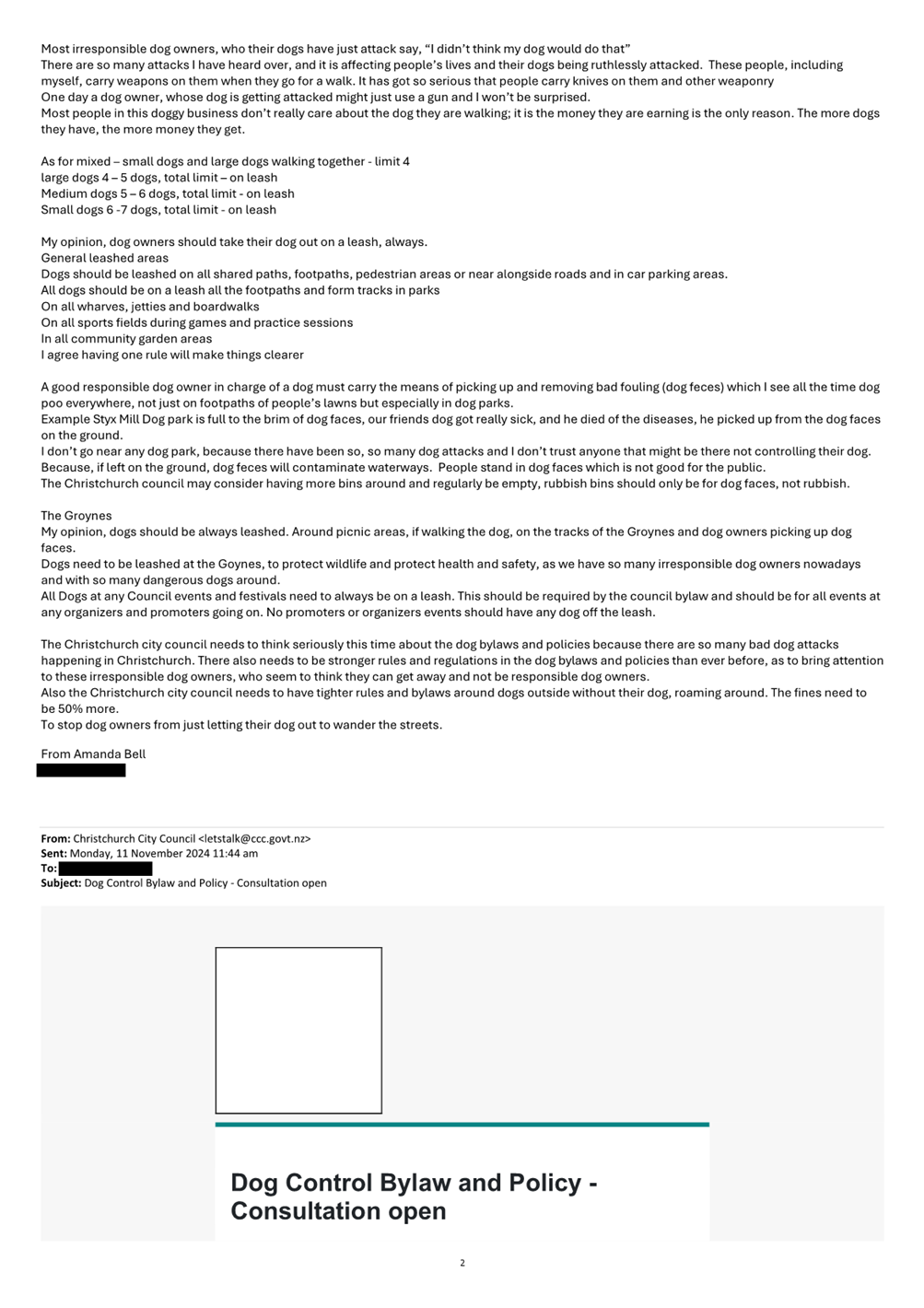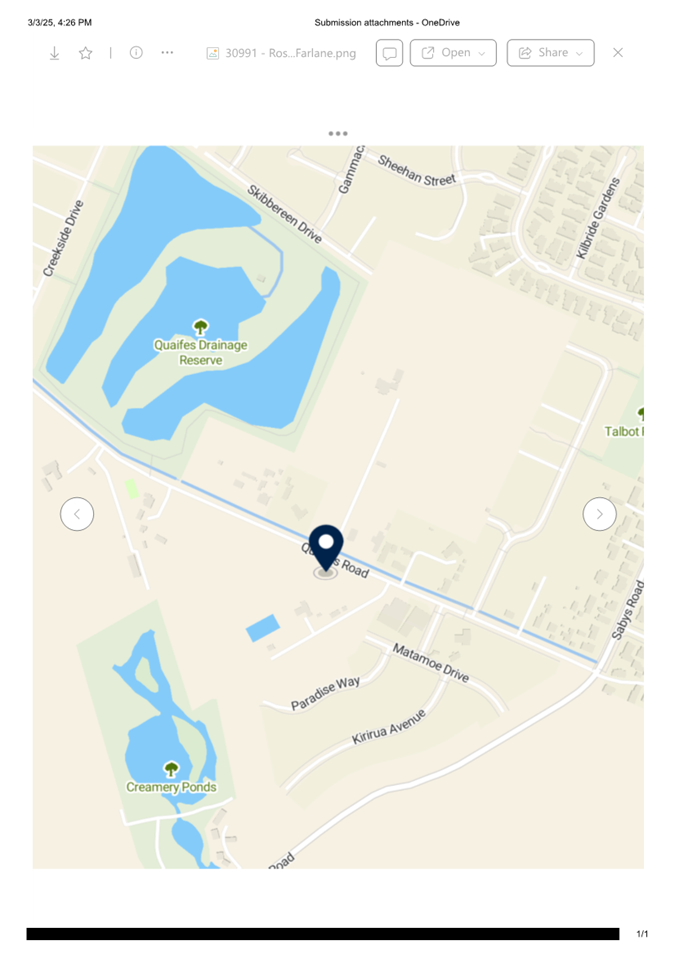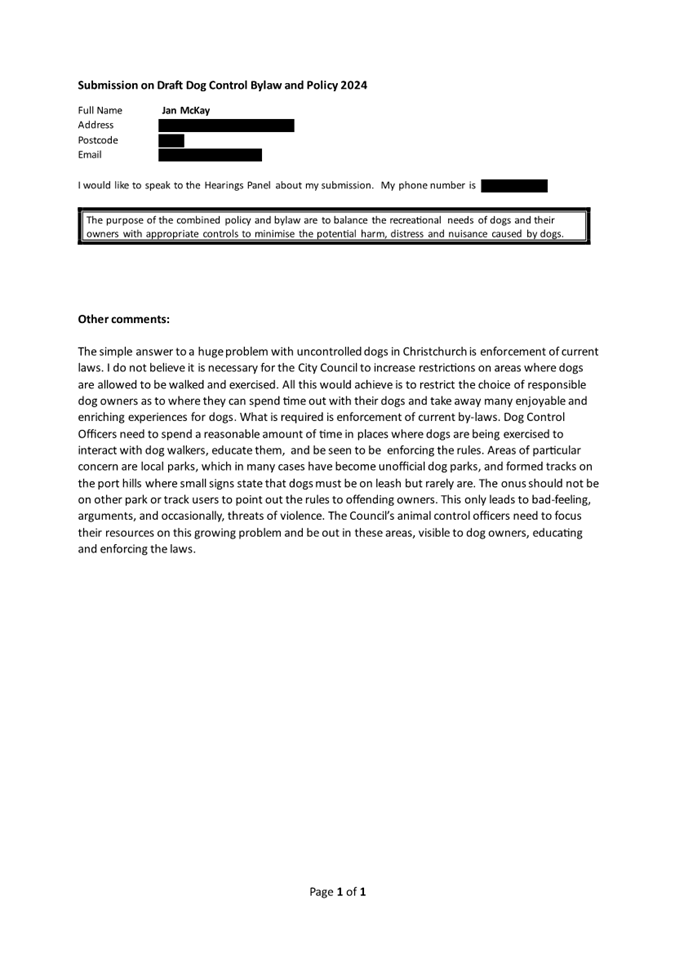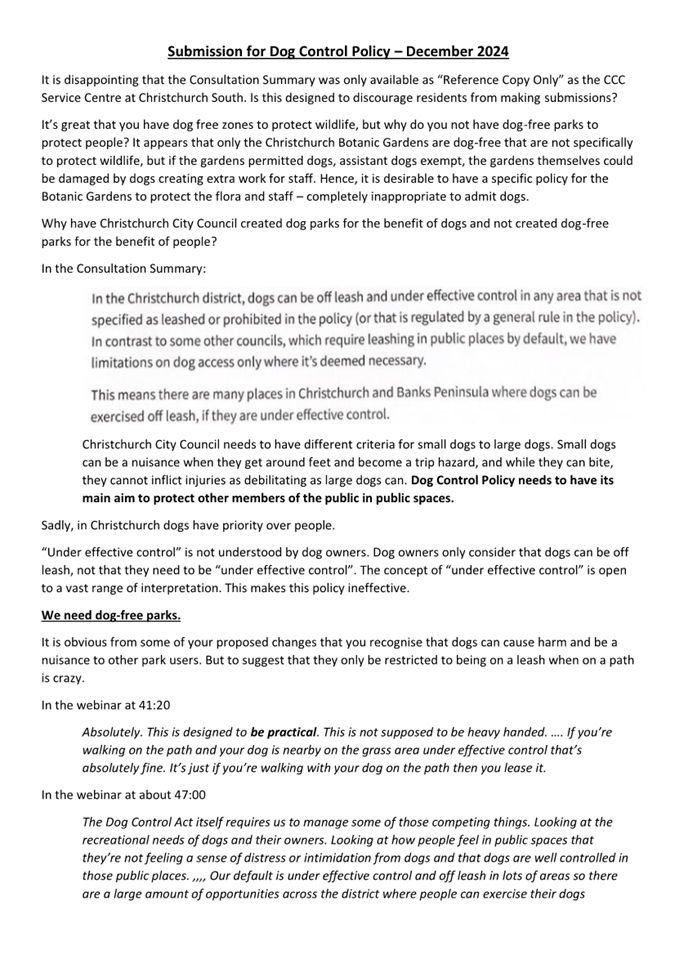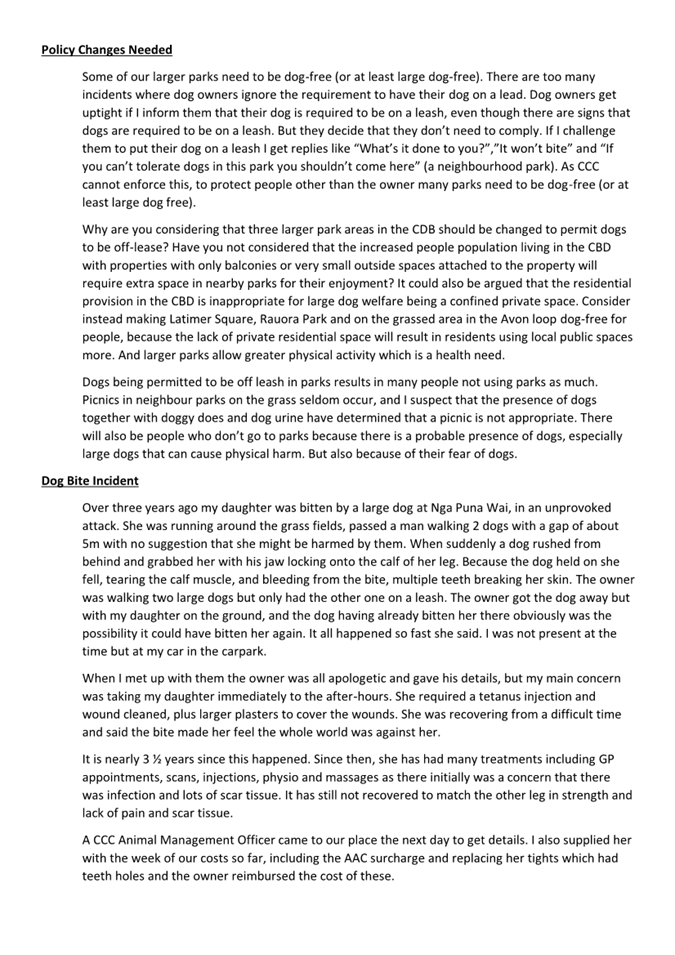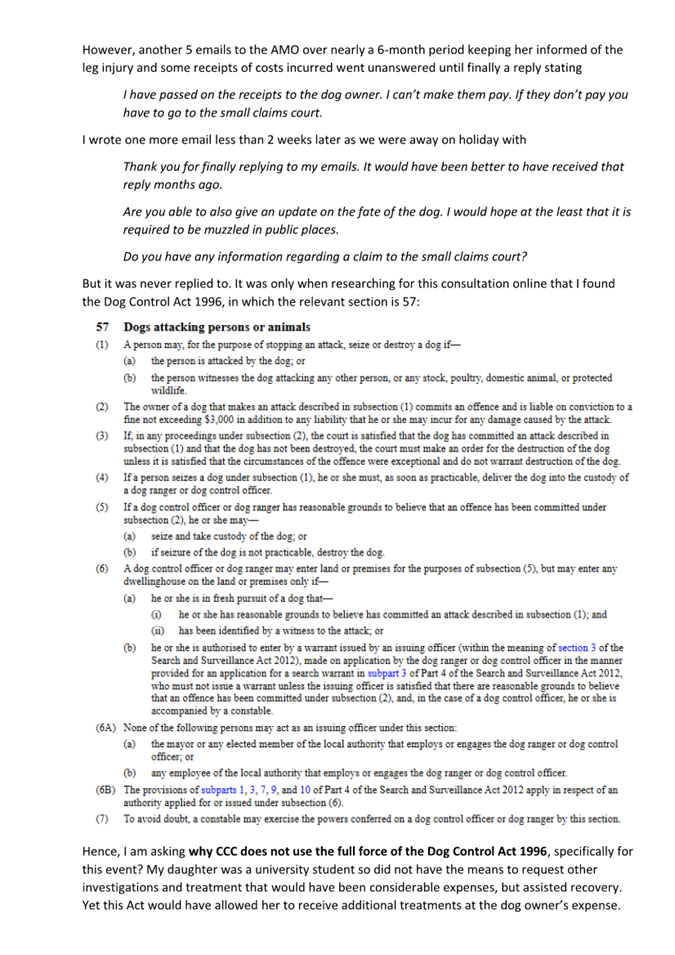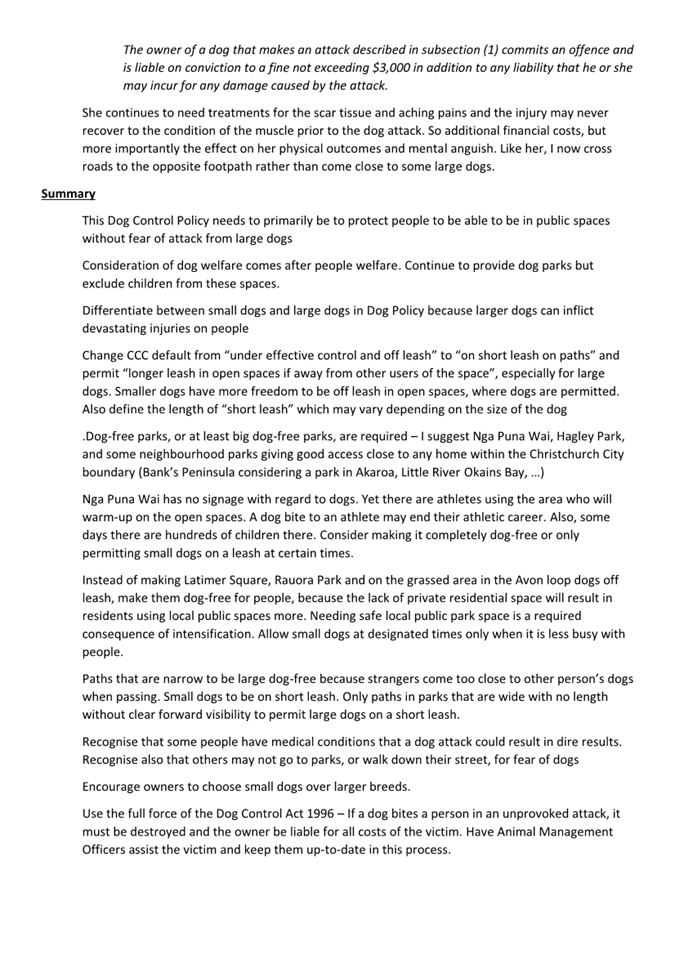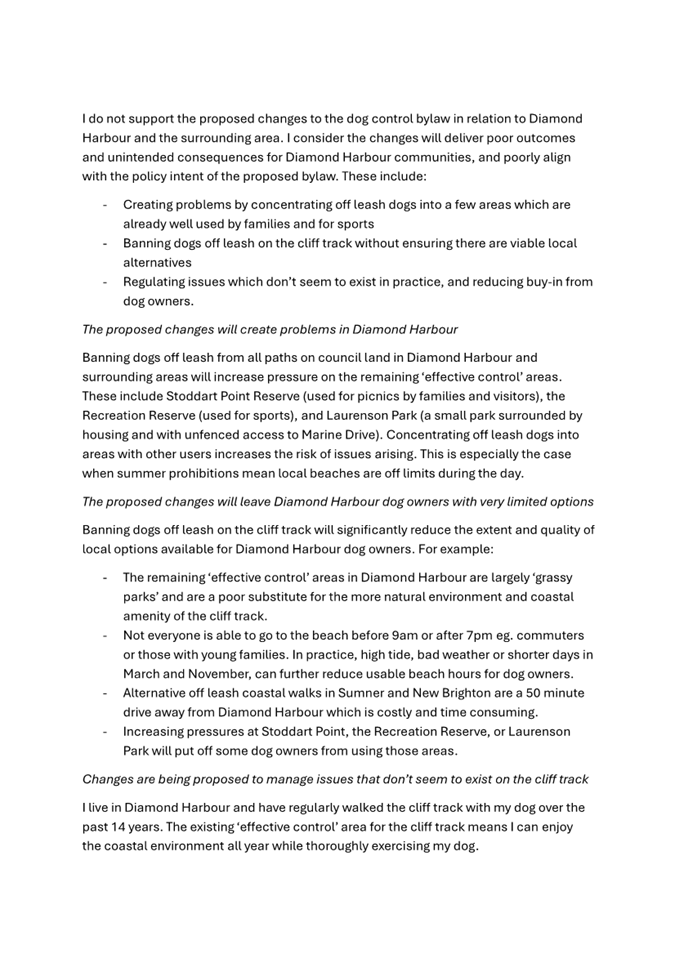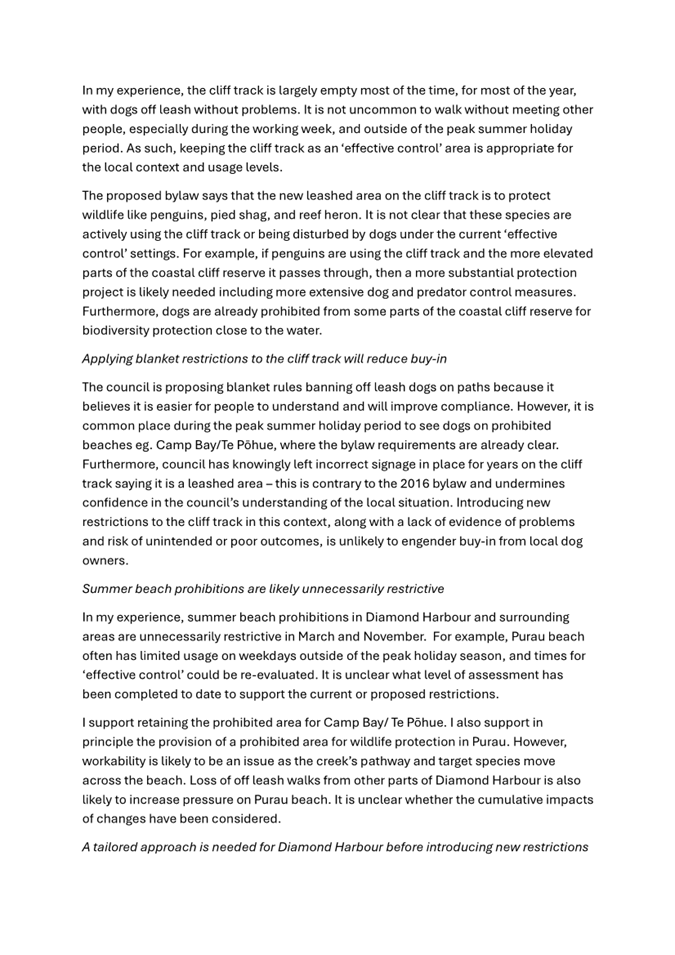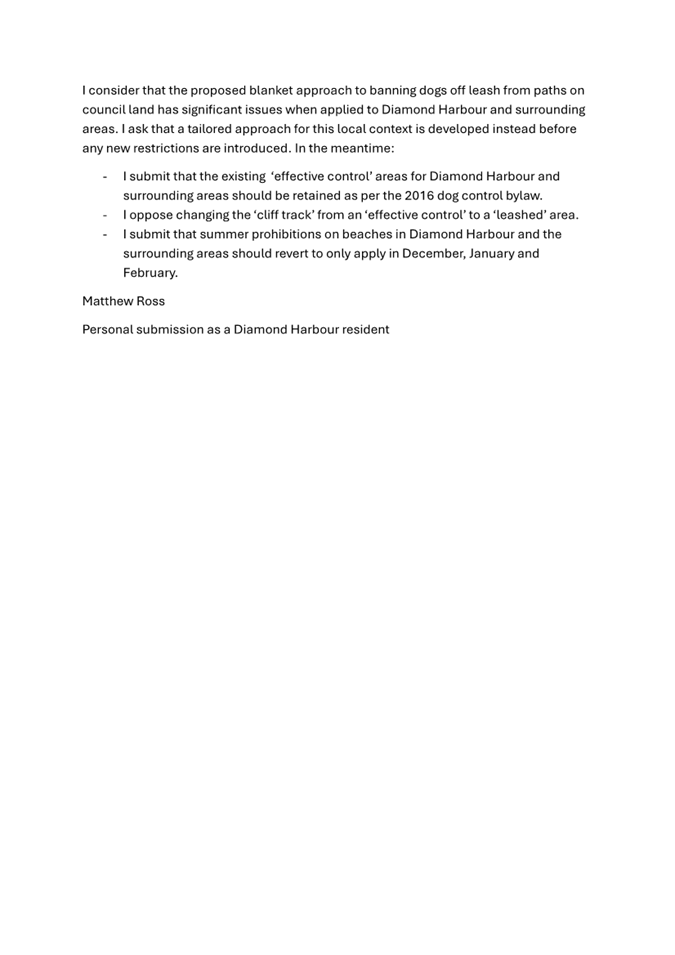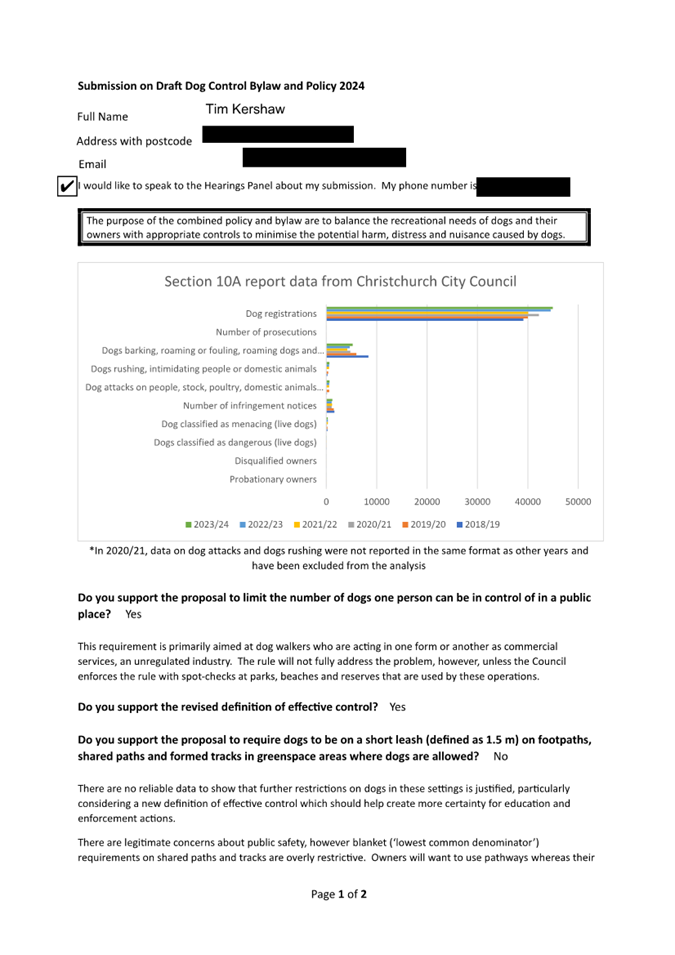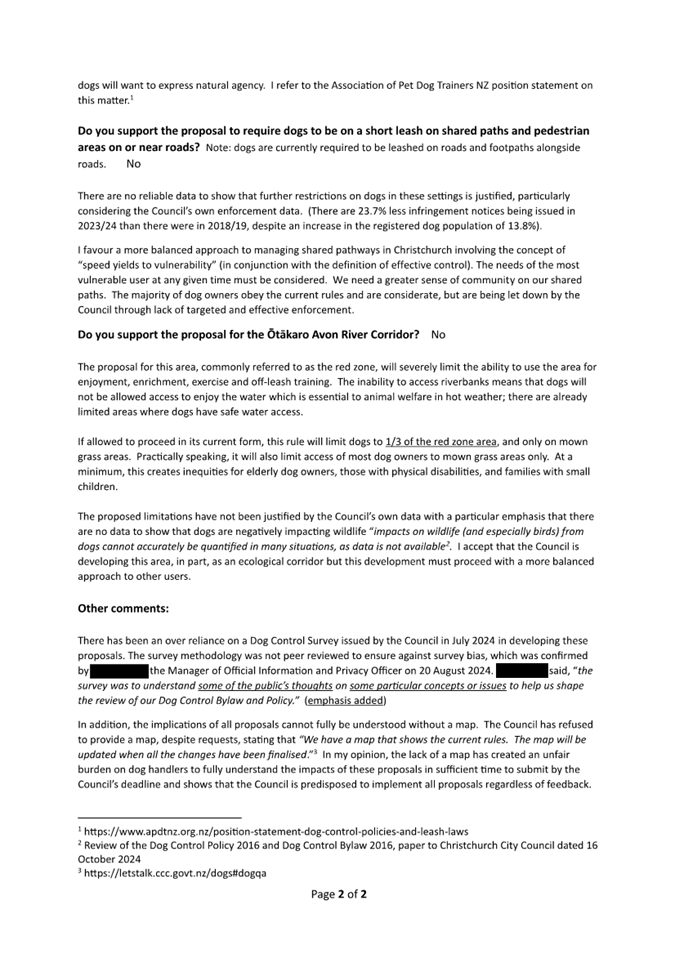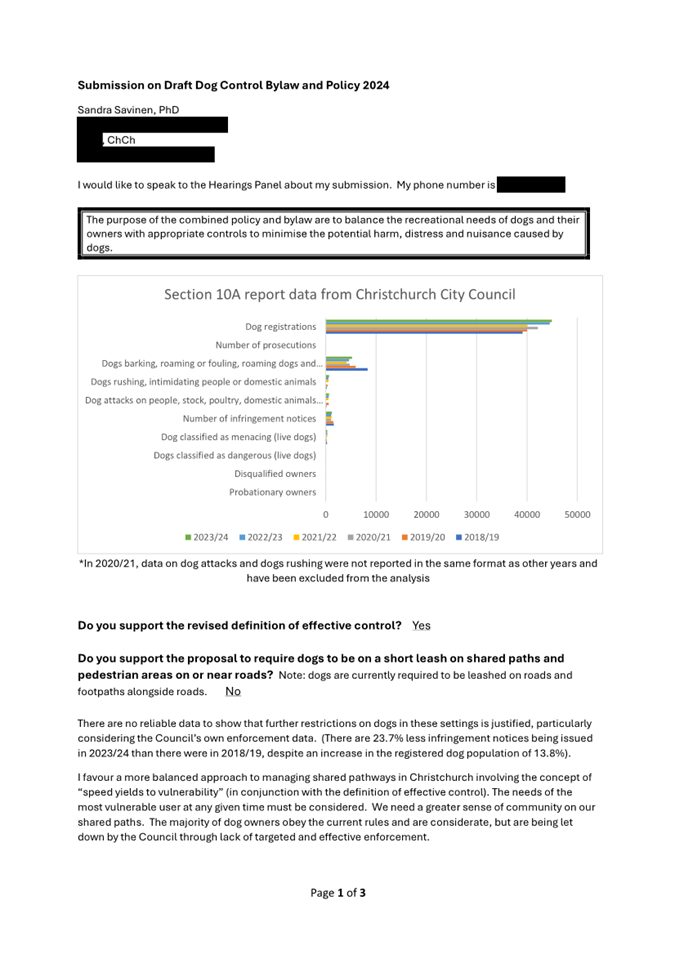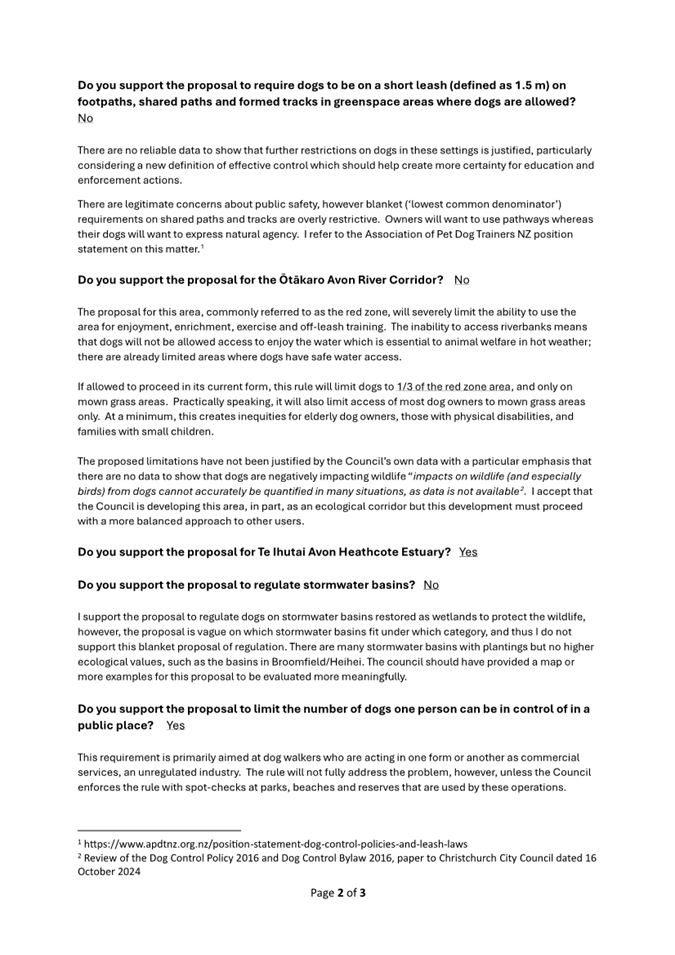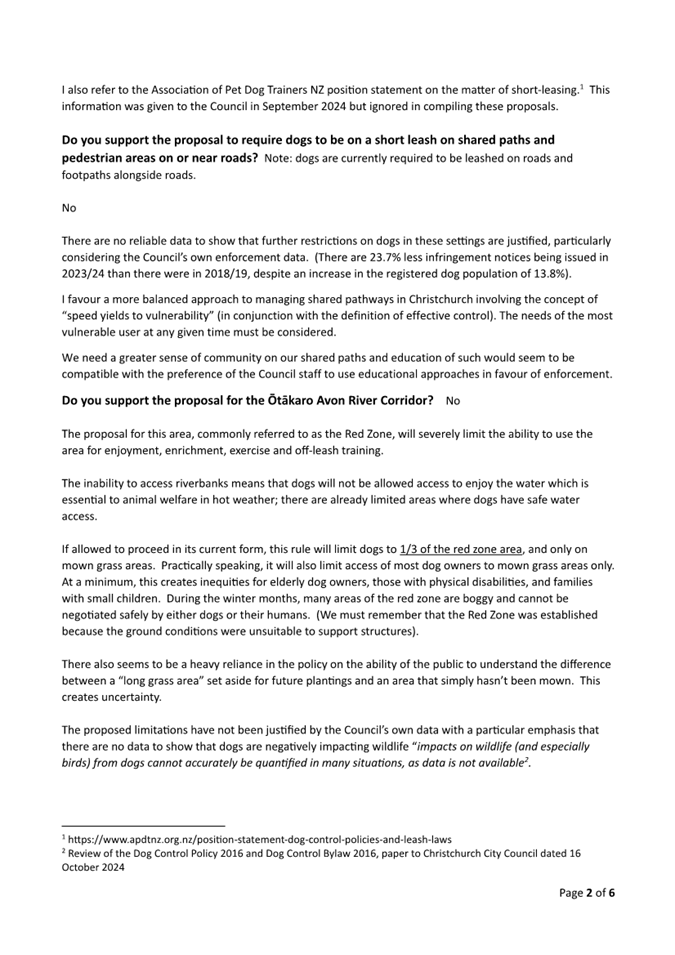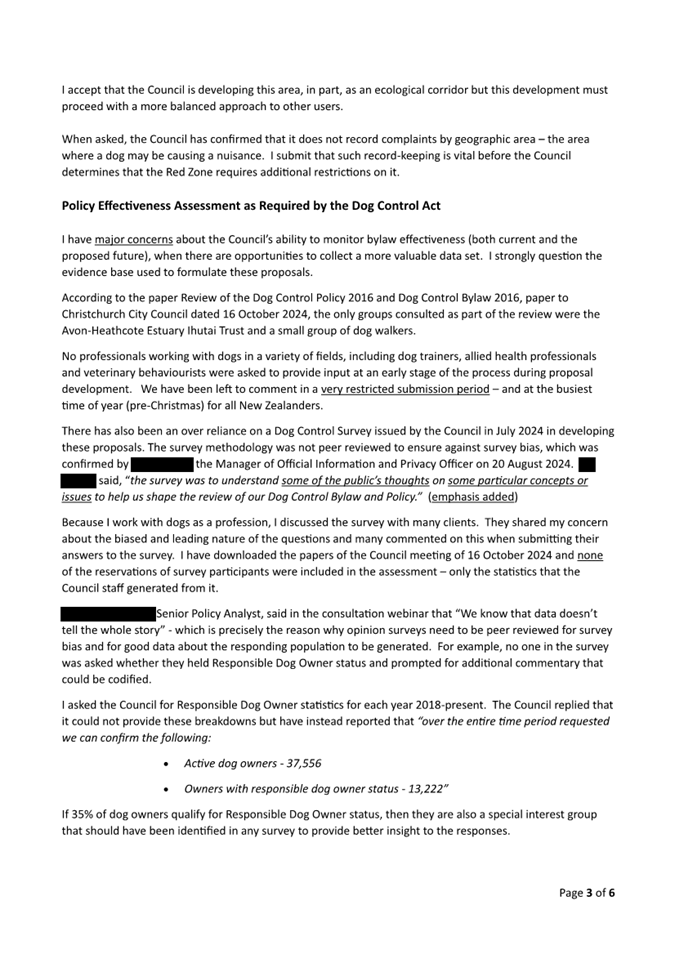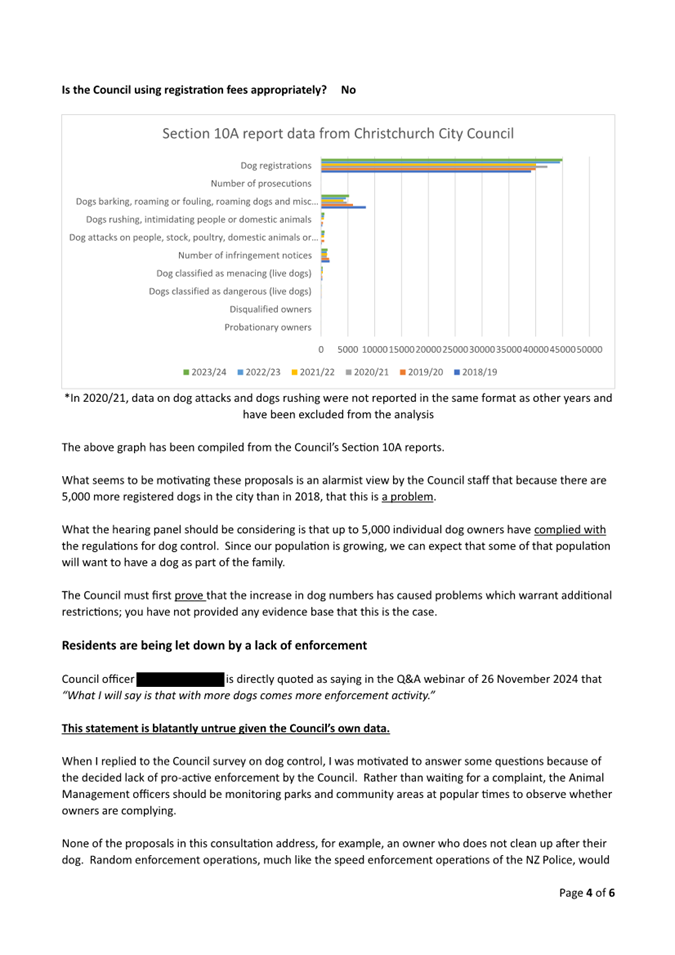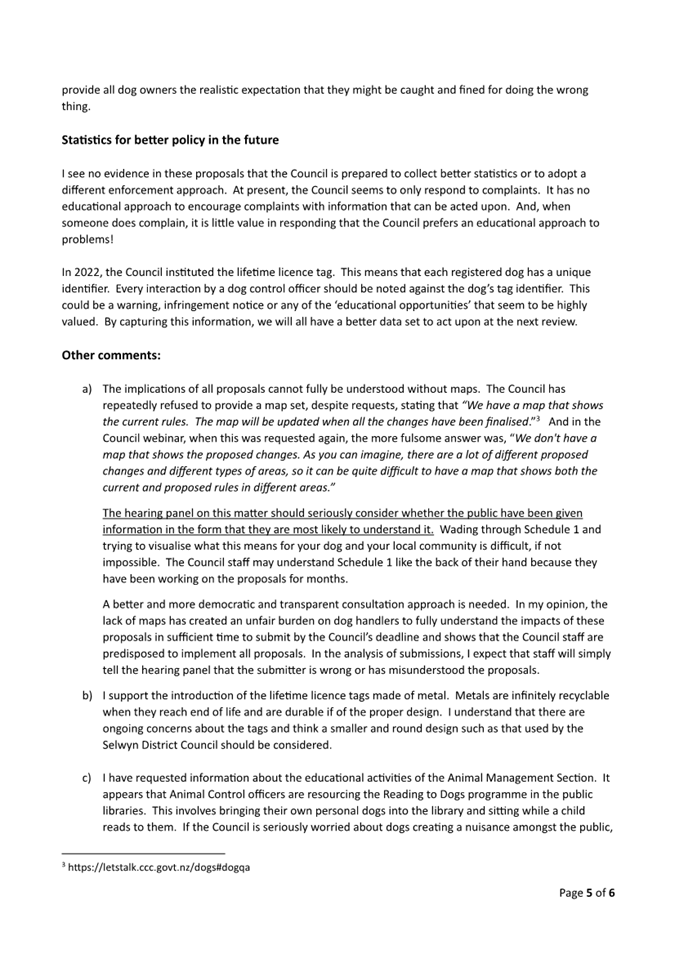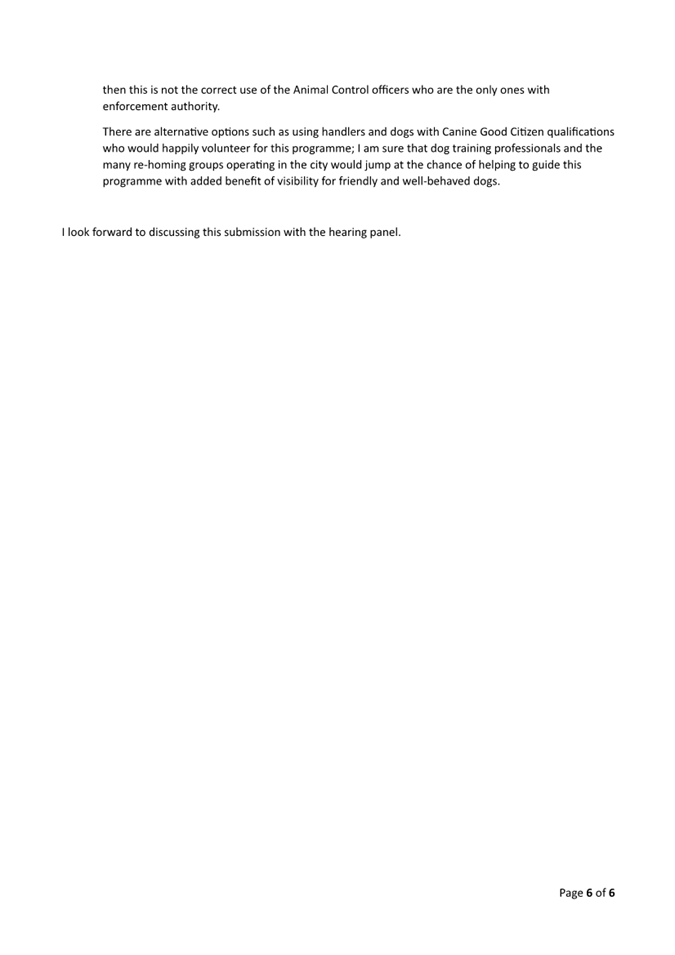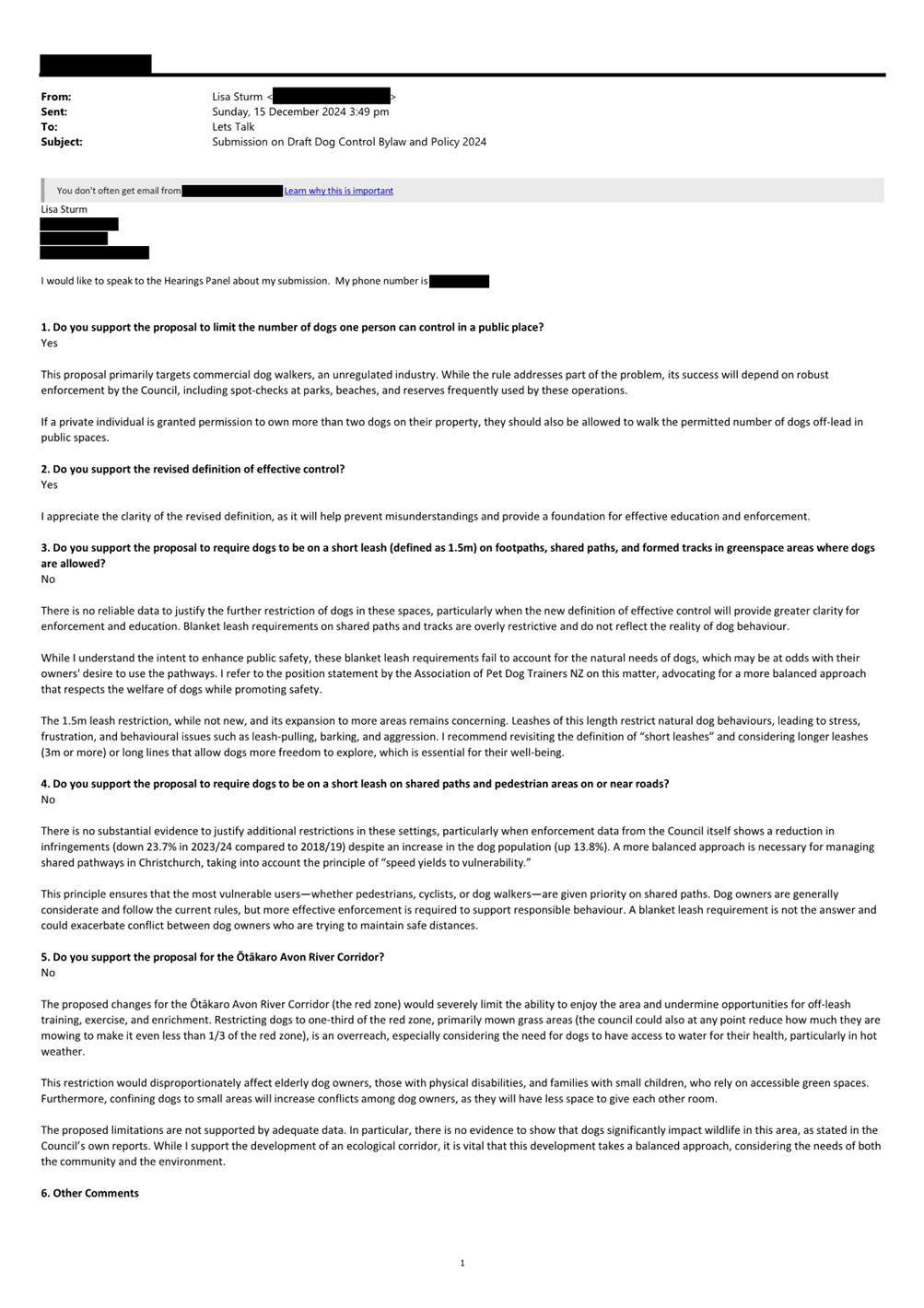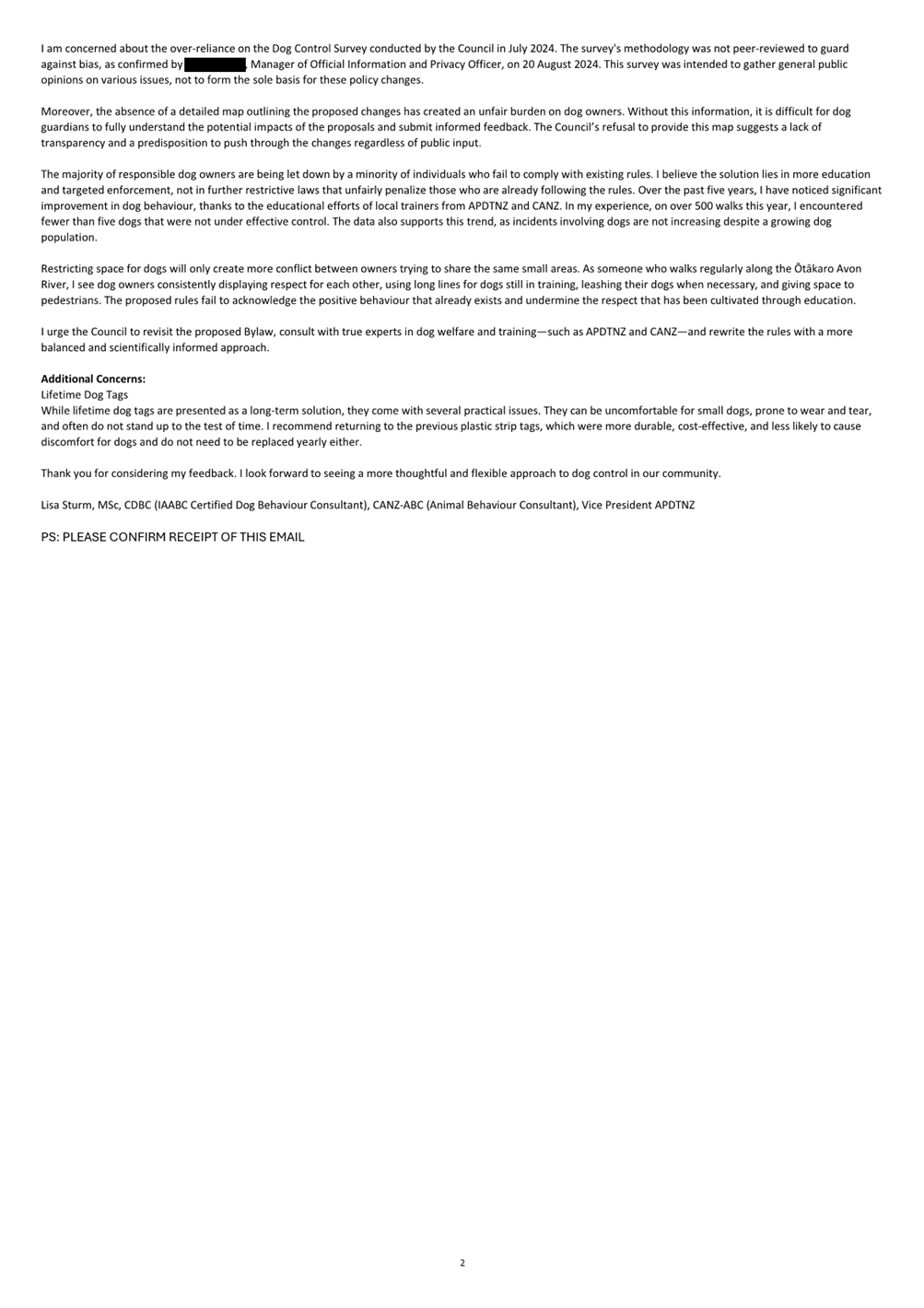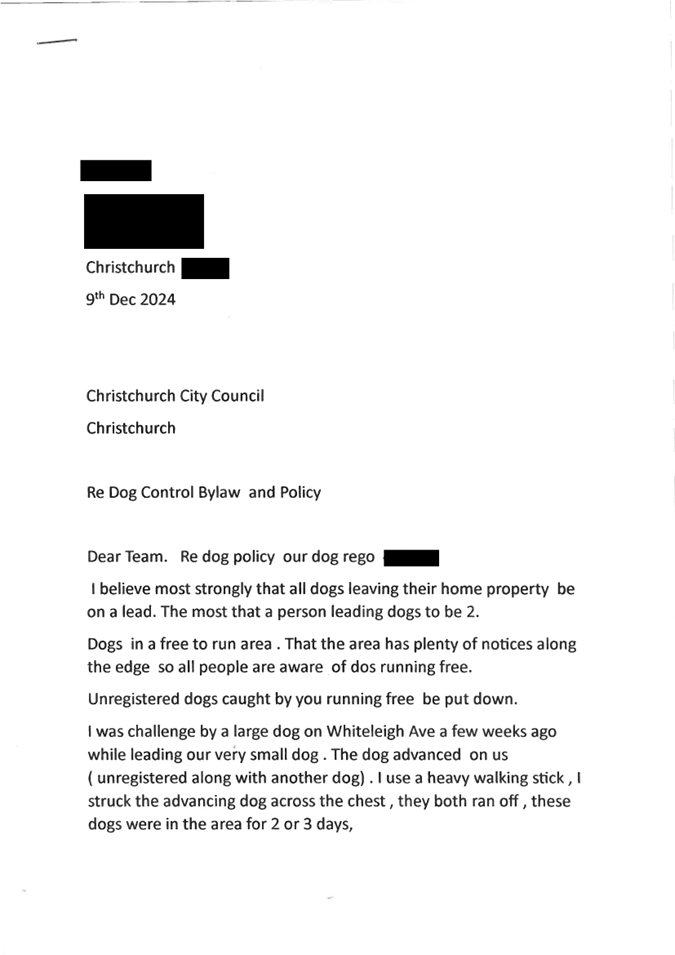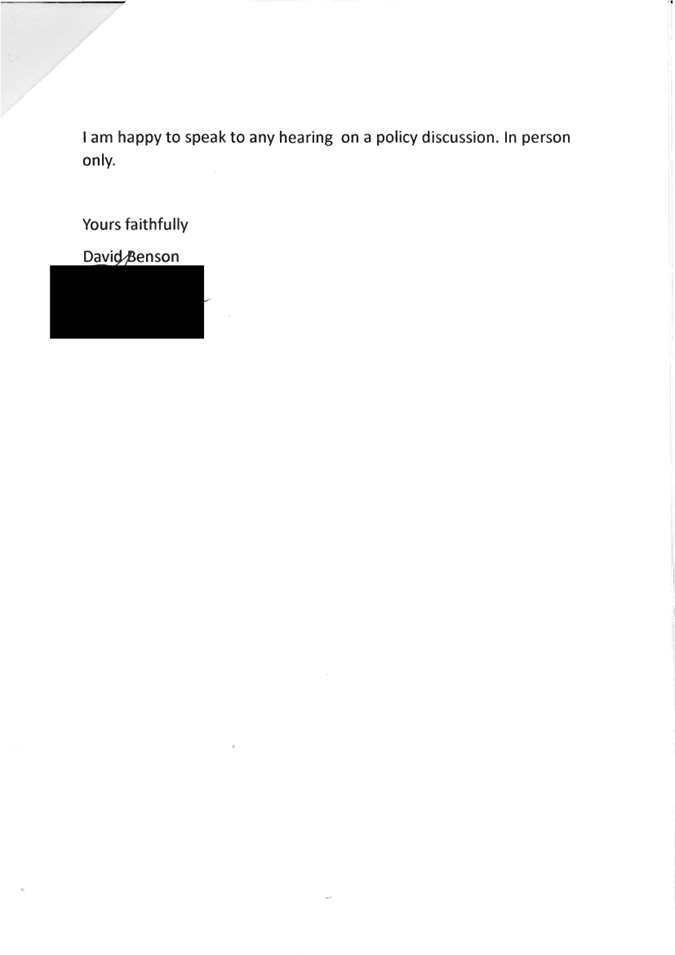|
4. Dog
Control Policy and Bylaw - Summary and analysis of submissions
|
|
Reference Te Tohutoro:
|
25/119303
|
|
Responsible Officer(s) Te Pou Matua:
|
Teena
Crocker, Senior Policy Analyst
Lionel Bridger, Manager Animal Services
|
|
Accountable ELT Member Pouwhakarae:
|
John
Higgins, General Manager Strategy, Planning & Regulatory Services
|
1. Purpose and Origin of the Report Te Pūtake Pūrongo
1.1 The
purpose of this report is to summarise submissions received during consultation
on proposed changes to the Dog Control Policy 2016 and the Dog Control Bylaw
2016 and to support the Hearings Panel in considering these submissions.
1.2 This
report also summarises the legislative context for the policy and bylaw, and
the proposed changes and reasons for them. A subsequent report will contain
advice from staff about the matters raised in submissions to support the
deliberations of the Panel.
1.3 The
Panel’s role is to consider all submissions and to make recommendations
to the Council on the final form of the policy and bylaw.
1.4 Proposals
were considered by the Council on 16 October 2024 and consultation ran from 11
November to 15 December 2024 resulting in 1,560
submissions.
2. Officer
Recommendations Ngā Tūtohu
That the Hearings
Panel:
1. Receives the information in the Dog Control Policy and Bylaw -
Summary and analysis of submissions Report.
3. Background Te Horopaki
3.1 Every
council is required to have a policy on dogs and a bylaw to enforce it. The
current policy and bylaw are:
· the Christchurch
City Council Dog Control Policy 2016 (the policy)
· the Christchurch
City Council Dog Control Bylaw 2016 (the bylaw).
3.2 The
policy and bylaw work together to impose regulatory controls on dogs and their
owners to minimise the danger, distress or nuisance that may be caused by dogs,
and to balance this with enabling appropriate recreational access to public
places in the district for dogs and their owners. This is the approach required
by the Dog Control Act 1996.
3.3 Legislation
requires a review of the policy and bylaw at least once every ten years and
sets out the requirements for a review. As part the review process, proposals
for change were brought to the Council in a report
on 16 October 2024 and adopted for consultation. The proposals are set out
here:
· Statement
of proposal (reasons for the review and proposals for change, including the
full policy and bylaw);
· Proposed
changes to the Dog Control Policy (current policy wording, with marked up
changes and reasons for the changes);
· Proposed
changes to the Dog Control Bylaw (current bylaw wording, with marked up
changes and reasons for the changes); and
· Bylaw
and Policy Review Report (this was an attachment to the 16 October Council
report and sets out the review, the legislative underpinnings, main issues, and
changes being recommended. It includes the section 155 analysis required by the
Local Government Act 2002).[1]
Scope of the proposals, policy and bylaw
3.4 Proposals
for change have focussed on improving the control of dogs in public places in
the district. Key areas for change have arisen from:
· Changes to land and water
management, landscapes and recreational access (including to coastal wetlands
and estuaries, inland wetlands and waterways, on former red zone land, and in
other greenspace areas);
· The Council’s
strategic priority to protect indigenous biodiversity (including investing in
habitat and ecological restoration), and the need to better protect wildlife
from dog disturbance and harm in key areas;
· The changing ways in which
people use public spaces, particularly increases in:
· The
installation of shared paths, designed for pedestrians and those on wheels;
· The
widespread use of wheeled recreational devices, like scooters, e-scooters and
e-bikes, on shared paths, footpaths, pedestrian areas and in other public
spaces;
· Residential
development across the city (including an increase in residents in the central
city), with impacts on recreational activities and needs;
· An
increase in people offering dog exercise services; and
· The increasing
dog population (now almost 45,000 dogs, or one dog for every nine people).
3.5 All
of these changes impact on the ways in which our public spaces are used, which
may impact on community views on dog access.
3.6 The
policy and bylaw must be reviewed at least once every ten years, so the
proposed changes have been designed, as much as possible, to ensure appropriate
coverage over a ten-year timeframe.
3.7 The
Hearings Panel needs to be mindful of the requirements in legislation. Of
particular importance is the requirement in the Dog Control Act 1996 (the Act)
that councils, in considering a policy to regulate dogs in their districts,
have regard to:
· The need to minimise
danger, distress, and nuisance to the community generally;
· The need to avoid the
inherent danger in allowing dogs to have uncontrolled access to public places
that are frequented by children, whether or not the children are accompanied by
adults;
· The importance of
enabling, to the extent that is practicable, the public (including families) to
use streets and public amenities without fear of attack or intimidation by
dogs; and
· The exercise and
recreational needs of dogs and their owners.[2]
3.8 The
Panel should particularly note that much of this focus is on how people feel
about dogs in public places (danger, distress, nuisance, fear of attack or
intimidation), which is why the public consultation feedback is an important
part of the process.
3.9 The
behaviour of dogs in public places can impact on people, wildlife, other dogs,
stock or other domestic animals, and the policy and bylaw aim to minimise
potential negative impacts.
3.10 To
regulate, the Council does not need to wait for something to go wrong, to have
evidence of dog attacks or injuries, or for enforcement data - rather, it can
set rules based on the intention of having well-controlled dogs in public
places, and public places where people feel safe. As well as more specific
regulatory powers, the Act contains a very general bylaw-making power to
regulate for “any other purpose that …is, in the opinion of the
territorial authority, necessary or desirable to further the control of
dogs”.[3]
3.11 The
preamble to the policy sets this out:
Christchurch has one of the highest dog
ownership rates in New Zealand, with almost 45,000 registered dogs. Many people
consider their dog(s) to be part of the family, and so it is important to have
a range of public places that are accessible to dogs and their owners for fun
and recreation. However, we also need to acknowledge the reality that dogs can
cause problems (such as barking), can cause injuries (such as bites, which can
be particularly harmful and traumatic to children) and can even cause death (such
as to protected wildlife or other animals). Many of these scenarios can be
prevented with good dog ownership, but others can happen unprovoked and with
little or no warning, so we need to minimise the potential for such incidents
and accidents by putting reasonable regulatory controls in place. This policy
seeks to balance the recreational needs of dogs and their owners with the need
to minimise the potential for any danger, distress or nuisance that may be
caused by dogs.[4]
3.12 The policy and
bylaw regulate more broadly than specifying leashed and prohibited rules -
however, these are of highest interest to the public and are what most
submissions focused on. To understand the full range of issues, see the policy
and bylaw wording and Attachment B, which summarises some of these wider
comments.
3.13 The
policy and bylaw are supported by an online interactive map: Where
you can take your dog. The map is useful for understanding the current
rules. Note that it does not show the proposed rules but will be updated once
the replacement policy and bylaw are adopted.
4. Community Views and Preferences Ngā
mariu ā-Hāpori
Early community views
4.1 In
June 2024, a survey was
sent out to stakeholders and dog owners and was published on Council channels
for the community to provide some early feedback. This covered topics like
leashing dogs on paths and tracks, protecting wildlife and habitats from dogs,
dog owner/caretaker responsibilities and how we use some community spaces. This
feedback helped to develop the proposed changes to the Dog Control Bylaw and
Policy 2016.
4.2 The
survey was completed by 6,245 people (84% of whom indicated they were dog
owners). Council was briefed on the results of this survey on 3 September 2024
and a report
is available. Some of the information from the survey may assist the Panel in
understanding wider community views, so has been reflected in some of the
attachments.
Consultation on proposed changes
4.3 Consultation
on the Draft Dog Control Bylaw and Policy 2024 opened on 11 November and closed
on 15 December 2024. The Dog Control Act 1996 requires us to undertake a
special consultative procedure[5]
and to notify registered dog owners of changes to a dog control policy. [6]
In summary:
· an email was sent to 39,769 key stakeholders, including registered dog owners.[7] A letter
was sent to any registered dog owners who did not have an email address;
· the Kōrero mai | Let’s Talk
page had 9,722 views throughout the consultation period;
· a Newsline
article was posted to Facebook and reached nearly 5,000 people and
consultation documents were available in all service centres; and
· a webinar was
held on 29 November and attended by approximately 59 people and watched
afterwards by 70 people.
4.4 Consultation
on the proposals resulted in 1,560 submissions. Of these, 26 were from
organisations or businesses and 1,534 were from individuals. An additional 31
submissions were unable to be counted due to incomplete personal/contact
details.
4.5 Submitters
were asked if they were dog owners or not, and 1,248 submitters (or 80% of
submitters) indicated they were a dog owner.
4.6 The
proposals were generally well supported by submitters - however, there were
some areas where submitters disagreed with proposals, some proposals that were
misunderstood, and some areas where suggestions for alternatives or new
proposals were put forth.
4.7 The
following organisations or businesses made submissions:
|
Four dog
businesses or services
|
· Head To Tail
· Christchurch Pet Sitter
· Waggytails on Whitfield
· SpeakingDog K9 Services & Canine
Neuropark
|
|
Two veterinary
or dog training associations
|
· Companion Animal Veterinarians Branch of
the New Zealand Veterinary Association
· Association of Professional Dog Trainers
New Zealand (APDTNZ)
|
|
Two national
animal NGOs
|
· SPCA New Zealand
· Companion Animals New Zealand
|
|
One national
environmental NGO
|
· Forest & Bird Protection Society of
New Zealand
|
|
Six community
Boards
|
· Waihoro Spreydon-Cashmere-Heathcote
Community Board
· Waipuna Halswell-Hornby-Riccarton
Community Board
· Te Pātaka o Rākaihautū
Banks Peninsula Community Board
· Waitai Coastal-Burwood-Linwood Community
Board
· Waipapa Papanui-Innes-Central Community
Board
· Waimāero Fendalton-Waimairi-Harewood
Community Board
|
|
Four residents,
neighbourhood or body corporate groups
|
· Spreydon Neighbourhood Network
· Redcliffs Residents Association
· Worcester Terraces Body Corp
· Belfast Area Residents Association
|
|
One sports club
|
· Whakaraupō Football FC
|
|
Four Land
Management Trusts
|
· The Styx Living Laboratory Trust
· Summit Road Society Inc
· Avon-Heathcote Estuary Ihutai Trust
· Riccarton Bush Trust
|
|
Two community
organisations
|
· Ōpāwaho Heathcote River Network
· Sustainable Ōtautahi Christchurch
|
4.8 The
submissions from these organisations are reflected in the summary of
submissions documents and are individually summarised in Attachment C.
Scope of proposed changes and consultation information
4.9 Consultation
included asking questions about some specific proposals. These key proposals
were summarised on the Council’s consultation page, Kōrero mai | Let’s talk,
along with a summary of other proposed changes, and information on where to
find all proposed changes.
4.10 It
is important to note that:
· The key questions covered
a limited number of the proposed changes (the six likely to be of highest
public interest);
· Some other changes were
summarised and highlighted on the consultation page (a further ten areas for
change, likely to be of reasonable public interest);
· Not all of the proposed
changes could be included in either of these summaries;
· The consultation page
contained links to the statement of proposal (which contains the full policy
and bylaw, with all changes shown in context, along with reasoning), separate
links to the policy, the bylaw, the Bylaw and Policy Review Report, and the Council
report;
· Detail on all the proposed
changes was available in several places on the consultation page;
· Anyone could submit on the
proposals, on the current policy and bylaw, or on any related matters, so the
scope of submissions is broad.
4.11 Submitters
were able to complete the online form, comment on any other matters, make a
submission separate from the online form, and to attach additional information.
4.12 Submitters
may have relied on the summaries to form their views and not accessed the more
detailed information that was available, including the policy and bylaw
wording. Additionally, some submitters are not familiar with the current rules.
This has resulted in some confusion or misunderstandings about the proposals,
which are reflected in the attachments summarising submissions. There are many
examples of this, including:
· The Groynes: Some
submitters have commented that they regularly exercise their dogs off-leash and
are objecting to what they see as a tightening of restrictions. However, much
of the area is currently prohibited to dogs, and the proposal is to lift the prohibited
status and change it to leashed in most of the reserve (excluding the dog park,
which would remain off-leash and under effective control);
· The Coastal Cliff Reserve
in Diamond Harbour: Similarly, some submitters have commented that they
regularly walk their dogs off-leash in this area, but it is currently a
prohibited area. We are proposing to change it to leashed in the reserve and
prohibited on the foreshore; and
· Port Hills reserves and
the proposal to leash on formed tracks: Some submitters are opposed to the
leashing on tracks proposal because they currently exercise their dogs
off-leash in the Port Hills, yet most Port Hills reserves have had leashed
status since at least 2016, with some areas requiring leashing as far back as
the 2008 policy.
4.13 The
Dog Control Act requires that the policy and bylaw work together, and this
results in some necessary duplication across the two documents. [8]
This can be confusing and adds to their length, which can make them less
accessible to the public. Dog control rules tend to be highly localised and
this means a lot of detail on a district-wide level. The proposed introduction
of more general rules is intended to help reduce some of this detail.
Attachments
4.14 This
report contains three attachments to support the Panel in its consideration of
submissions:
· Attachment A: Summary of submissions on key questions (this covers the six key
questions and also includes a brief summary of the July 2024 survey):
· Attachment B: Summary of submissions on all other
matters (this is a substantial document containing a summary and some
analysis of issues raised in submissions); and
· Attachment C: Summary of submissions from organisations and businesses.
Summary of responses to the key questions
4.15 We
asked six questions on key proposals. In summary, the following responses were
received:
|
Key questions
|
Yes
|
No
|
Don’t know
|
|
Do you support the proposal to require
dogs to be on a short leash on footpaths, shared paths and formed tracks in
greenspace areas where dogs are allowed?
|
656 submitters
43%
|
824 submitters
54%
|
61 submitters
4%
|
|
Do you support the proposal to require
dogs to be on a short leash on shared paths and pedestrian areas on or near
roads?
|
1,070
submitters
70%
|
401
submitters
26%
|
67
submitters
4%
|
|
Do you support the proposal for the
Ōtākaro Avon River Corridor?
|
833 submitters
56%
|
480
submitters
31%
|
168
submitters
11%
|
|
Do you support the proposal for Te Ihutai
Avon Heathcote Estuary?
|
1,042
submitters
70%
|
265
submitters
18%
|
185
submitters
12%
|
|
Do you support the proposal to regulate
stormwater basins?
|
907
submitters
61%
|
374
submitters
25%
|
195
submitters
13%
|
|
Do you support the proposal to limit the
number of dogs one person can be in control of in a public place?
|
1,051
submitters
69%
|
329
submitters
22%
|
150
submitters
10%
|
4.16 Each
of these questions had a free-text box, where submitters could comment. These comments
are analysed and summarised in Attachment A.
High-level themes arising in submissions
4.17 It
is clear that a wide range of views on dogs are held in our communities. Many
of these are diametrically opposed, with views everywhere in between. For
example, submitters saying something happens all the time, while other
submitters say they have never seen that thing happen - or something is a big
problem, while others say there is no problem at all. These comments are often
side-by-side in the summary at Attachment B.
4.18 These
views cannot be characterised as dog owners versus non-dog-owners. The majority
of submitters indicated they were dog owners (80% of submitters).
4.19 Some
dog owners want tighter controls, while others would prefer fewer restrictions.
Many dog owners have had friendly and positive experiences with their dogs and
other dogs in public places, while others have felt threatened or concerned
about other dogs (with some experiencing attacks or injuries). Similarly,
non-dog owners hold wide a range of views.
4.20 The issues raised by submitters are summarised in Attachment B. Many
of these were not on specific proposals but give an overall impression of how
dog access to public places and the behaviour of dogs and their owners is
viewed.
4.21 Some general themes in submissions about dogs in public places are:
· Concerns about people not
picking up after their dogs (spread of disease, contamination of waterways,
nuisance);
· Concerns about poorly
controlled dogs and public safety;
· Concerns about owners not
paying attention, not having adequate control, not understanding / following
the rules;
· Concerns that limitations
on where dogs can go or leashing rules will negatively impact on the welfare of
dogs and their natural behaviour and enjoyment;
· Arguments for a more
dog-friendly approach, with dogs as valued family members and companions;
· Concerns about a loss of
recreational access for dog owners;
· Support for protecting
wildlife, habitats and biodiversity from dog disturbance;
· Opposition to wildlife
protections, not believing restrictions are necessary or wanting to leash
rather than prohibit dogs, or have no restrictions;
· Confusion about the
current rules and proposed changes; and
· Concerns about the
complexity of the rules and opposition to general or “blanket”
rules.
Out of scope matters raised in submissions
4.22 Some submitters raised operational issues, which relate to how the
Council will put the policy and bylaw into practice, or how we manage public
places and facilities in relation to dogs.
4.23 Although
some of these matters are relevant and relate to the policy and bylaw, or its
implementation and operationalisation, the process before the Hearings Panel is
to agree on the regulatory coverage of the policy and bylaw and to recommend
them to the Council for adoption.
4.24 Operational
comments included those relating to:
· The provision of rubbish
bins for people to dispose of dog fouling in greenspace areas, on streets and
beaches - this is an operational matter and not part of the regulation of dogs;
· New / more dog parks - the development and network planning for dog parks happens
outside of the policy and bylaw review process and is undertaken by Parks;
· Signage - there are no prescribed signage requirements for dog control in
legislation. Signage to reflect the updated policy and bylaw will be
considered, along with other approaches to communicate the new requirements,
once the policy and bylaw have been adopted; and
· Funding for, or the provision of, more animal management officers - animal
management activities are funded by dog registration. Dog registration fees are
set through the annual plan process. Any additional funding from general rates
revenue for dog control would also be a matter for the annual plan.
4.25 Some of these and other operational matters will be passed on to the
appropriate staff, including specific comments about maintenance, rubbish bins
and signs. Comments are included in the attached summary of submissions.
4.26 Out
of scope submissions include those focused on:
· Cat regulation - there is no provision to regulate cats in the Act;
· Dogs on buses - the bus service is operated by Environment Canterbury;
· Regulation of the speed
of cyclists - this is unrelated to dog regulation;
· Increasing penalties for breaches of the bylaw or for other matters regulated under the
Dog Control Act - the penalty for breaching a dog control bylaw is $300, which
is set in the Act. Other offences and penalties are set out in the Act, and any
changes would be a matter for the responsible Minister or Parliament to
consider; and
· Dog welfare issues - councils, via dog control officers, have a limited role in animal welfare
matters under the Act. The Code of Welfare for Dogs applies to all dog owners,
and enforcement is a matter for the Society for the Prevention of Cruelty to
Animals (SPCA) or the Ministry for Primary Industries.
5. Background/Context Te Horopaki
5.1 The
following sets out where to find key documents and how the review and proposals
for change progressed to public consultation.
The legislative and wider context
5.2 The key part of the Act
setting the legislative context for a dog control policy is the section on what
councils must “have regard to” when adopting a policy. [9] This was covered earlier in the report, and generally relates to
minimising the danger, distress, and nuisance that may be caused by dogs,
considering public safety and how people feel about dogs in public places, and
considering the recreational needs of dogs and their owners.
5.3 A
bylaw must be made to give effect to the policy, and both the policy and bylaw
must be consistent. The requirements for a policy are in section 10 of the Act,
and for a bylaw in section 20 of the Act. For more detail on these legislative
requirements, see the 16 October report to Council (agenda item 9) and
the attachment to that report, the Bylaw and Policy Review Report.
5.4 The review and proposals for change included consideration of
related strategies and plans, including the Biodiversity Strategy 2008-2035 and
the Urban Forest Plan, together with
relevant Long-Term Plan 2024-34 Activity Plans. These relate
to changing land and water management, habitat and biodiversity outcomes, and
recreational access. Relevant activity management plans include:
· Ōtākaro Avon River Corridor (OARC) – the regeneration plan, restoration of the delta
landscape, ongoing ecological and habitat restoration programme, wetland and
aquatic habitats, increasing local biodiversity, recreational activities,
mahinga kai, pest management, stormwater and flood management;
· Parks and Foreshore –
activities and aspirations for community parks, cemeteries, inner city parks,
regional parks, residential red zone, foreshore and marine access;
· Stormwater Drainage and Flood Protection and Control Works –
naturalised waterways and green assets; improving our landscapes and
biodiversity; treatment swales, wetlands and basins; water quality in our
waterways, wetlands and estuaries; greening of our infrastructure; nature-based
design; and water sensitive urban design; and
· Recreation, Sports, Community Arts and Events - active recreation creates happier, healthier people, better
connected communities and a stronger Christchurch.
5.5 The
Council’s Compliance Strategy is also relevant. The Strategic
Compliance Framework has three key elements: monitoring compliance; encouraging
compliance; and dealing with non-compliance. The Council operates with the VADE
model of enforcement - Voluntary, Assisted, Directed and Enforced compliance.
The VADE model recognises that most people are willing to voluntarily comply or
can be encouraged to do so. The latter two parts, directed and enforced
compliance, are where infringements may be utilised. For serious
non-compliance, enforced compliance may involve prosecution.
Context on land that is regulated in the dog control policy
and bylaw
5.6 We
have a substantial network of parks and greenspace, a long coastline, and some important
waterways, wetlands and estuaries. The district has over 10,000 hectares of
parks and reserves (including 797 neighbourhood parks, 62 garden parks, 109
regional parks, 115 sports parks, 34 red zone parks, 23 cemeteries and 171
utility parks).[10]
5.7 The
roading network and footpaths also provide opportunities for recreation,
together with footpaths, shared paths and formed tracks through parks and
reserves, and in stormwater management areas.
5.8 Some
of these areas have specific dog restrictions in place already or are covered
by general rules, and some new areas and changes have been proposed. In all
other areas, the default dog control status applies – dogs are allowed
off-leash and under effective control. Dog restrictions are in place only in
areas where there is good reason, and these reasons are set out in the policy
for each area.
5.9 Land
in some areas changed due to earthquake impacts, including areas that were not
open to the public when the policy and bylaw were last adopted in 2016, such as
the Ōtākaro Avon River Corridor and Te Kuru Wetlands in Hoon Hay.
Other earthquake changes include higher water or lower land levels in some
areas, with new wetland environments and an increase in saltmarsh areas, such
as at the mouth of the Ōtākaro Avon River, Bexley Wetlands and at
Ferrymead Regional Park.
5.10 The
changing ways our public places are being used, changing recreational
activities and locations, and the changing dog population may shift public
attitudes towards dogs, so the review and consultation is timely. There has
also been an increase in the number of dogs in the district (almost 45,000
dogs).
5.11 Te Ihutai Avon
Heathcote Estuary has been recognised as part of the East Australasian Flyway
Network. The flyway is an international network of wetland sites used by
migratory birds in their annual migrations. Protections proposed in this
area are to support threatened and at-risk migratory birds of national and
international importance, and to bring dog protections into line with
equivalent areas of ecological significance in New Zealand.
5.12 Despite
proposing increasing restrictions, the default dog control status for the
district remains: dogs allowed off-leash and under effective control.
5.13 We
do not specify off-leash areas (other than dog parks and dog exercise areas),
because everywhere not otherwise specified as leashed or prohibited, or covered
by a general rule, is off-leash and under effective control. Changes were
proposed to the definition of “under effective control” and these
are set out in the policy and bylaw, with a summary of submissions in
Attachment B.
6. Next Steps Ngā Mahinga ā-muri
6.1 A second report will be
prepared for the Hearings Panel that will contain staff advice to support the
deliberations of the Panel.
6.2 That
report will also contain advice on Risks and Mitigations, Legal Considerations,
Strategy and Policy considerations, etc, so as not to duplicate advice.
Decision Making Authority Te Mana Whakatau
6.3 The
decision-making authority for bylaws sits with the Council and cannot be
delegated to a Committee of Council or other body. The role of the Hearings
Panel is to consider and hear submissions, deliberate on those matters raised,
and make recommendations to the Council on the final form of the policy and
bylaw.
Legal Implications Ngā Hīraunga ā-Ture
6.4 Submissions
made on the proposals should be received by the Hearings Panel with an open
mind and should be given due consideration.
6.5 When
deliberating on submissions, the Hearings Panel should keep in mind the
Council’s regulatory and bylaw-making powers and the scope of the
consultation proposals. Significant changes from original proposals may require
further consultation.
Risks Ngā Tūraru
6.6 With
any bylaw-making process, there is always a risk that members of the public or
organisations may not agree with the proposals finally adopted by the Council
and may seek judicial review proceedings. This risk can be managed by careful
compliance with the provisions of the Act, and common law relating to bylaws.
Next Steps Ngā Mahinga ā-muri
6.7 The
Hearings Panel should consider all written and oral submissions, seek any
further advice from staff, deliberate on the issues raised, and make
recommendations to the Council on the final form of the policy and bylaw.
Attachments Ngā Tāpirihanga
|
No.
|
Title
|
Reference
|
Page
|
|
a ⇩
|
Dog control:
Summary of submissions on key questions
|
25/262189
|
17
|
|
b ⇩
|
Dog control:
Summary of submissions on all other matters
|
25/224520
|
26
|
|
c ⇩
|
Dog Control:
Summary of submissions from organisations and businesses
|
25/267957
|
89
|
In addition to the attached documents, the following background
information is available:
|
Document
Name – Location / File Link
|
|
Not
applicable
|
Signatories Ngā Kaiwaitohu
|
Authors
|
Teena Crocker
- Senior Policy Analyst
Krystle
Anderson - Engagement Advisor
|
|
Approved By
|
Tracey Weston
- Head of Regulatory Compliance
David
Griffiths - Head of Strategic Policy & Resilience
John Higgins -
General Manager Strategy, Planning & Regulatory Services
|
|
5. Dog
Control Policy and Bylaw - Staff advice to support deliberations
|
|
Reference Te Tohutoro:
|
25/320760
|
|
Responsible Officer(s) Te Pou Matua:
|
Teena
Crocker, Senior Policy Analyst
Lionel Bridger, Manager Animal Services
|
|
Accountable ELT Member Pouwhakarae:
|
John
Higgins, General Manager Strategy, Planning & Regulatory Services
|
1. Purpose and Origin of the Report Te Pūtake Pūrongo
1.1 The
purpose of this report is to provide the Hearings Panel with staff advice to
support its deliberations on matters raised in submissions on the proposed
changes to the Dog Control Policy 2016 and Dog Control Bylaw 2016.
1.2 The
report is the second report to the Panel. The first report summarised the
submissions received on the proposed changes, while this report offers staff
advice on the matters raised in submissions.
2. Officer Recommendations Ngā
Tūtohu
That the Hearings
Panel:
1. Receives the information in the Dog Control Policy and Bylaw -
Staff advice to support deliberations Report.
2. Considers the matters raised in submissions
and the advice provided in the attachments to this report and directs staff on
how it wishes to proceed.
3. Executive Summary Te Whakarāpopoto Matua
3.1 This
report complements the previous report to the Hearings Panel that summarises
submissions on proposed changes to the Dog Control Policy 2016 and Dog Control
Bylaw 2016, which arose from a review of the policy and bylaw.
3.2 This
report provides advice on the matters raised in submissions for the Panel to
consider during its deliberations, so that it may make recommendations to
Council on the final form of the policy and bylaw.
3.3 The
attachments to this report include:
· Advice for the hearings
panel (this sets out a brief summary of the issues
raised in submissions, what was proposed, staff advice in response, and
recommendations for the Panel to consider, issue by issue);
· Maps of key areas that may be of assistance to the Hearings Panel; and
· The current dog control
policy, with marked up changes and reasons for the changes (as prepared for
consultation); and
· The current dog control
bylaw, with marked up changes and reasons for the changes (as prepared for
consultation).
3.4 The
Panel may raise additional matters or wish to seek further advice from staff.
Any subsequent advice will be provided, as needed.
3.5 Once
the Panel has deliberated on the issues raised in submissions and indicated to
staff how it wishes to proceed, staff will prepare revised versions of the dog
control policy and bylaw with the changes requested by the Panel.
3.6 These
will then be brought back to the Panel for its consideration. A record of all
changes will be prepared to form a set of recommendations for the Hearings
Panel’s report to Council.
3.7 Advice
from staff incorporates views from Parks (including Regional Parks, Red Zone,
Community Parks and Ecology), Animal Management, Stormwater and Waterways,
Strategic Policy and Legal Services.
3.8 The
Panel’s role is to consider all submissions and to make recommendations
to the Council on the final form of the policy and bylaw.
3.9 In
considering the matters raised in submissions, the Panel should be mindful of
the Council’s regulatory and bylaw-making powers and the scope of the
consultation proposals. Relevant points are set out in the Legal section below.
3.10 Significant
changes from the original proposals may require further consultation.
4. Background/Context Te Horopaki
4.1 Legislation
requires councils to have a policy on dogs and a bylaw to enforce it. This is
one of the few bylaws that are required by legislation, and the only bylaw with
an associated statutory policy.
4.2 For
full information on the review of the policy and bylaw and the proposed
changes, see the report to Council and its attachments: 16 October 2024: Review
of the Dog Control Policy 2016 and Dog Control Bylaw 2016, (Council, agenda item 9).
4.3 Consultation material, including the statement of proposal, can be
found here: Draft Dog Control Bylaw
and Policy 2024 | Kōrero mai | Let’s talk
4.4 The
previous report to the Hearings Panel sets out the more recent background and
context.
Options Considered Ngā Kōwhiringa Whaiwhakaaro
4.5 The
reasonably practicable options raised in submissions have been considered and
analysed in the attached document. Other options analysis was included in the
16 October 2024 report to Council.
5. Financial Implications Ngā Hīraunga Rauemi
Capex/Opex Ngā Utu Whakahaere
5.1 Monitoring
and enforcement of the policy and bylaw, and signage and communication
activities to highlight the rules or changes will be determined based on
existing budgets, once the final form of the policy and bylaw are known.
5.2 Dog
control activities are funded by dog registration fees, while signage is
managed by Parks. Signs will be updated and upgraded as business-as-usual
budgets allow. Signs are a coordinated part of wider Parks signage activities
to support visitor experience.
5.3 Website
and other online updates will be undertaken within existing budgets, including
an update of the online interactive map where you can
take your dog and associated information in the walking track map.
5.4 The
matter before the Panel is the regulatory settings for the policy and bylaw,
rather than a review of operational, enforcement and implementation activities.
6. Considerations Ngā Whai Whakaaro
Risks and Mitigations Ngā Mōrearea me
ngā Whakamātautau
6.1 Some
submitters made their submissions based only on the summaries for the six key
proposals (this is evident in questions and requests for detail that submitters
included). It is clear from submissions that some dog owners are not familiar
with the current rules, and this is something that can be addressed as part of
the implementation of the policy and bylaw.
6.2 There
is a danger that dog owners will not agree with or understand the dog control
rules in the policy and bylaw. The policy is getting increasingly complex.
Alternatives include utilising more general (rather than specific) rules, but
some submitters opposed “blanket” approaches. Specific prohibited
or leashed areas could be reduced, but this would have varying impacts across
the district, depending on the rules and reasons for them, and may not align
with strategic goals of Council, such as protecting and enhancing biodiversity.
6.3 Signs to indicate dog
controls can lose their effectiveness over time, will not be effective for some
people, and can come at a significant cost on a district-wide scale. Updated
signage will be assessed and managed within existing budgets. Online and other
communication approaches will also be utilised.
Legal Considerations Ngā Hīraunga
ā-Ture
6.4 Statutory
and/or delegated authority to undertake proposals in the report:
· The statutory authority to
review, consult and make the Council’s Dog Control Policy and Dog Control
Bylaw comes from both the Dog Control Act 1996 and the Local Government Act
2002.
· The Council is required
under the Dog Control Act to have a policy in respect of dogs in its district.
The Council must make any necessary bylaws to give effect to the policy.
· The regulatory scope and
requirements are set out in section 10 of the Act for dog control policies, and
section 20 for dog control bylaws.
· The Dog Control Act
expressly allows councils to develop bylaws that restrict access to specified
public places for the purposes of dog control.
6.5 Section
10 of the Dog Control Act requires that councils, in adopting a policy dogs,
must have regard to:
· The need to minimise
danger, distress, and nuisance to the community generally; and
· The need to avoid the
inherent danger in allowing dogs to have uncontrolled access to public places
that are frequented by children, whether or not the children are accompanied by
adults; and
· The importance of
enabling, to the extent that is practicable, the public (including families) to
use streets and public amenities without fear of attack or intimidation by
dogs; and
· The exercise and
recreational needs of dogs and their owners.
6.6 Other Legal Implications:
· Advice on specific
bylaw-making requirements was provided in the 16
October 2024 Council report, including the section 155 analysis required
under the Local Government Act 2002.
6.7 The
section 155 determinations will need to be included in the Hearings Panel
report to Council. These confirm that a bylaw is the most appropriate way of
addressing the identified problems, that it is the most appropriate form of
bylaw, and that it does not give rise to any New Zealand Bill of Rights Act
1990 implications. This is required by the Local Government Act 2002.
6.8 More
detail on this was included in an attachment to the 16
October 2024 report to Council, titled: Review report - Dog Control Bylaw
and Policy (including section 155 report), and was also available on the
consultation page: Kōrero
mai | Let’s talk
Strategy
and Policy Considerations Te
Whai Kaupapa here
6.9 Strategic
and policy considerations have been covered in the previous report to the
Hearings Panel and in the 16
October 2024 report to Council. Specific matters are covered in more detail
in the attached documents, where appropriate.
Community
Impacts and Views Ngā Mariu ā-Hāpori
6.10 These
have been covered in the previous report to the Hearings Panel and in the
attached documents.
Impact
on Mana Whenua Ngā
Whai Take Mana Whenua
6.11 This
was covered in the 16
October 2024 report to Council. The matters covered in this report do not
impact on previous analysis of the impacts on mana whenua.
Climate
Change Impact Considerations Ngā Whai Whakaaro mā te Āhuarangi
6.12 This
was covered in the 16
October 2024 report to Council. The matters covered in this report do not
impact on previous analysis of climate change considerations.
7. Next Steps Ngā Mahinga ā-muri
Decision Making Authority Te Mana Whakatau
7.1 The
decision-making authority for bylaws sits with the Council and cannot be
delegated to a Committee of Council or other body. The role of the Hearings
Panel is to consider and hear submissions, deliberate on those matters raised,
and make recommendations to the Council on the final form of the policy and
bylaw.
Legal Implications Ngā Hīraunga ā-Ture
7.2 Submissions
made on the proposals should be received by the Hearings Panel with an open
mind and should be given due consideration.
7.3 When
deliberating on submissions, the Hearings Panel should keep in mind the
Council’s regulatory and bylaw-making powers and the scope of the
consultation proposals. Significant changes from original proposals may require
further consultation.
Risks Ngā Tūraru
7.4 With
any bylaw-making process, there is always a risk that members of the public or
organisations may not agree with the proposals finally adopted by the Council
and may seek judicial review proceedings. This risk can be managed by careful
compliance with the provisions of the relevant Acts, and common law relating to
bylaws.
Next Steps Ngā Mahinga ā-muri
7.5 The
Hearings Panel should consider all written and oral submissions, seek any
further advice from staff, deliberate on the issues raised, and make
recommendations to the Council on the final form of the policy and bylaw.
Attachments Ngā Tāpirihanga
|
No.
|
Title
|
Reference
|
Page
|
|
a ⇩
|
Attachment A -
Advice for deliberations - dog control policy and bylaw 2025
|
24/2002614
|
102
|
|
b ⇩
|
Attachment B -
Indicative maps of key areas to support deliberations
|
25/379089
|
148
|
|
c ⇩
|
Attachment C -
Proposed changes Dog Control Policy (2024) for consultation
|
24/1389798
|
154
|
|
d ⇩
|
Attachment D -
Proposed changes Dog Control Bylaw (2024) for consultation
|
24/1332196
|
197
|
In addition to the attached documents, the following background
information is available:
|
Document
Name – Location / File Link
|
|
Not
applicable
|
Signatories Ngā Kaiwaitohu
|
Author
|
Teena Crocker
- Senior Policy Analyst
|
|
Approved By
|
Tracey Weston
- Head of Regulatory Compliance
David
Griffiths - Head of Strategic Policy & Resilience
John Higgins -
General Manager Strategy, Planning & Regulatory Services
|


















































































































































